Text
Encanto at 35
A review by Adam D. Jaspering
Encanto is the story of Mirabel Madrigal. A young Colombian woman, she lives in an enchanted house, in an enchanted village, with her enchanted family. Unfortunately, Mirabel has the misfortune of being the only Madrigal without a magical gift. Unsure of her role or purpose within her family, she lives life one day at a time. One day, signs and omens appear, indicating something is not right with her family and her home. Her fate is apparent for the first time: Mirabel will be the one to save her family, or else, she'll be the one to destroy it.

“Encanto” is a Spanish word that doesn’t translate directly into English. A close approximation is “enchantingly beloved,” acting as a noun. Both enchanting as beautiful and enchanting as magical. In the context of the film, Encanto both describes the village setting, and serves as the village’s name.
It’s surely no coincidence that the word also ends in “Canto.” Alongside the family name “Madrigal,” the theme's primary focus is apparent. A musical affinity is deliberately interwoven into the film.
Lin-Manuel Miranda returns to helm the music and lyrics. This time, he brings more of his signature flair. With Moana’s soundtrack, Miranda was imitating a classical Disney showtune style. The songs were great, but they were formalist creations. He wrote songs for Disney the way he believed Disney songs were supposed to sound.
The music of Encanto is more representative of Miranda’s style. We hear his trademark wordplay, hip hop influences, boisterous appreciation of showtunes, and a blurring of genre lines.
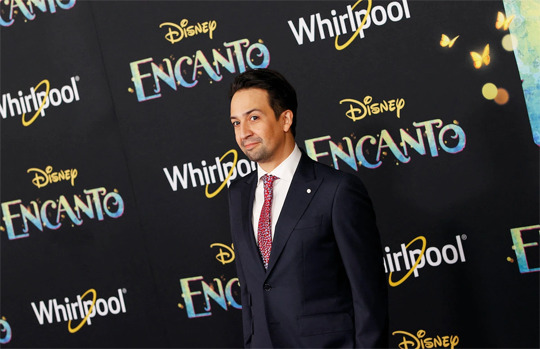
Miranda went above and beyond experimenting with the various Latin music subgenres. The movie’s Colombian setting presents both traditional folk music and modern styles. All of it formed into a theatrical pop construct. To people unfamiliar with Colombia's musical styles, it sounds beautiful, exotic, and inviting. To those who are, it sounds like a cavalcade portrayal of an underrepresented land.
Just like everything else Lin-Manuel Miranda touches, the fan response and commercial success followed. Encanto’s soundtrack was at the top of the Billboard chart for nine weeks. Every song appeared on the Billboard Hot 100 chart, with five songs cracking the Top 50. “Dos Oruguitas” earned Miranda another Academy Award nomination for Best Original Song. The album went platinum in just four months.

But as popular as the soundtrack is, there is a film supporting it that needs to be discussed. Encanto is a movie about a multigenerational family. There are twelve people living under one roof. It’s plot requires a functional understanding of the Madrigal family tree, their history, and the interpersonal relations among them. The movie has an important duty. It needs to make all of its lore known, understood, and remembered before the movie can begin.

In the past, Disney films have had difficulty supporting large casts. It’s difficult to introduce a large number of people, while expecting the audience to remember their names and personalities. It’s also a challenge for the movie to find enough screentime and plot to justify all these characters. Would Mirabel’s large family serve a purpose onscreen? Or would it be like 101 Dalmatians, only important in terms of sheer quantity?
The movie uses two different methods to spit out its exposition. The first, in a prologue, a young Mirabel is told her family history by her grandmother. As a family elder is teaching her family history to an eager young child, we the audience are eavesdropping on the conversation. We learn the origins of the Madrigal family’s gifts, the nature of the magic, and the magic candle at the center of it all. informative and it feels natural. It’s an organic way to present details slowly and purposefully without relying on omniscient narration.

The second method is stranger, but just as effective. In the movie’s opening number, the now adult Mirabel introduces us to her family. In a fast-tempo patter song, not only do we learn the family’s names and relationships, we learn each of their associated magic gifts. “The Family Madrigal” is a silly and unconventional way to learn the character roster, but it’s effective.

Mirabel isn’t breaking the fourth wall by singing directly to us. Throughout the film, a small assortment of kids observe and comment on situations occurring. Much like a Shakespearean chorus, they frame and contextualize important plot points. Ideas that couldn’t otherwise be expressed visually or verbally are directed towards them, even if they’re off camera. They also ask rhetorical questions, keeping the plot threads moving in intended directions. It keeps the story of the Madrigal family from becoming cloistered. It reminds us of the stakes throughout. The movie doesn't concern just a privileged family, but an entire village. Their personal problems have municipal consequences.

For brevity’s sake, we won’t explore every member of the Madrigal family. Suffice to say, each member of the supporting cast has a role and function in the story. Nothing feels extraneous or redundant. Everyone has a unique design and characterization, differentiating them. Everyone contributes in someway, be it to move the plot along, to lighten the mood, or to visually depict changing circumstances. Everyone adds to the film, building on circumstances rather than distracting or overshadowing. Nobody is ever just their one gimmick.
Mirabel’s sisters get two major explorations of the film’s theme. As is tradition in musicals, both Luisa and Isabela reveal their inner secrets and frustrations through song. Long kept hidden from everyone, including themselves, simple words will not suffice.
Luisa’s gift is abnormal superhuman strength. Her song, "Surface Pressure,” is a revelation that her strength has made her incredibly insecure. Due to her gift, she can literally move, lift, or carry anything. Every chore, every duty, every task, she feels obligated to take on the burden. She obediently does so, feeling guilty about ever resting or declining a request. Doing anything less would be a waste of her gift.

Luisa knows full well nobody else can do what she does (or at least not as effortlessly). She also knows these duties must be done for the good of the Encanto. If she doesn't get the work done, she's unfairly placing a burden on others. She's an involuntary workaholic who's placed the world on her own shoulders.

Isabela’s gift is the ability to grow plants and flowers instantly. The beautiful botanical displays implore her to be an epitomized version of femininity. Her song, "What Else Can I Do?,” is a confession that despite her outward perfection, she’s deeply unhappy.
The image Isabela puts forth is one immaculately curated. Her horticultural gift has always been at the forefront of her entire image. She can create a wave of pink flowers instantaneously. So she dresses and behaves like a girl whose persona requires so many pink flowers.

So much so, Isabela has had to suppress any interest or affection that would betray such an image. She has spent so long trying to be a perfect beauty, it’s become effortless and boring. She’s never had the opportunity to pursue any latent interest. Such as a newly discovered thirst for creative expression.
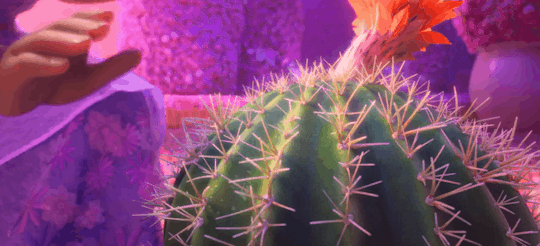
Both of these are in contrast to Mirabel’s character arc. With no magic gift to call her own, Mirabel has always felt like an outsider in her family. She’s felt unimportant and insignificant. She has no immediately obvious and presentable talent in a family of superstars. She’s generic. With no gift, she has no purpose, and therefore no direction. Mirabel can do anything, but can’t do anything with that freedom. Her sisters have great talents, but are stuck doing one thing forever. Neither party is happy, but for opposite reasons.
But despite these suppressed miseries, all three remain loyal and faithful to their family and their Encanto. As unhappy as they are, leaving would be even worse. And they know this as a fact.
Throughout the film, we see the complete Madrigal family tree, but one member is conspicuously absent. Whenever his name is brought up, the topic is swiftly dismissed. We only get a ominous, uniform warning: ‘We don’t talk about Bruno.’

Early on, we have no frame of reference of Bruno’s fate or what he did to earn such a reputation. What heinous act did he perform to be disgrace by his home? What legendary crime has expelled him from his family? What grievous misdeed has made him such a pariah? With all the secrecy and displeasure, one is fully ready to accept Bruno as the film’s villain.

As Mirabel investigates her family’s secrets, all signs point to her long disappeared uncle. She can’t accept his status as an unperson any longer. She needs to know the truth. Again, the truth comes out in song form.
In a film full of hit songs, “We Don’t Talk About Bruno” is the biggest hit of Encanto. For months after the film’s release, the song dominated popular culture. It spent weeks atop the singles chart, and was a viral sensation. It’s difficult to compare mathematically due to the changing states of music consumption, but all indicators imply the same thing: “Circle of Life” was popular. “Let It Go” was big. “We Don’t Talk About Bruno” was a sensation.
The song details the ire, the fear, and the resentment everyone has towards Bruno Madrigal. We hear of Bruno’s many transgressions. We learn both why everyone dislikes him and why they’re glad he’s gone.

But as Mirabel learns, Bruno did nothing wrong. His so-called faults are severely hyperbolized. Everybody’s stories are sour grape justifications for their feelings. Bruno is gone. Rather than miss him or mourn him, everyone convinces themselves they're happy Bruno is gone.
It’s clear something is awry. Even if the rumors and reputation weren’t disingenuous, they don't answer Mirabel's questions. She needs to know why Bruno is gone and why he disappeared when he did. Everyone is making excuses, justifying their feelings towards Bruno’s absence. Whatever Bruno did, Mirabel will never know by asking. Everyone is lying to themselves. They'll of course lie to her.
Bruno’s gift is precognition. He’s an interpretation of the Cassandra myth. In Greek mythology, Cassandra was blessed with the gift of foresight. However, no matter what she saw, she could never convince anyone of the oncoming truth. She was doomed to witness tragic events she could not prevent.
The difference being, when Cassandra spoke the truth, no one would believe her. When Bruno spoke the truth, everyone blamed him. The various prophecies espoused by Bruno are impartial accounts of the future. Whatever happens, happens. Bruno is just the messenger. But he gets the blame all the same.

So what drove Bruno to exile? On the night Mirabel learned she had no magic gift, Bruno tried to discover what had happened. Such an anomaly surely meant something important. His ensuing vision was unlike any he’d seen before: a quantum flux of two possible futures. He saw Mirabel standing in front of the Madrigal home. In one state, the house was healthy, sturdy and strong. In the other, the house was in ruination.


Bruno couldn't blame his niece for the impending fate of his family. Nor could he present such bad news to his family. Rather than disappoint them, scare them, or lie to them, Bruno fled. His family thinks he abandoned them in a time of need. Instead, he's kept a dark secret to himself for years, scared to face the consequences. A self-imposed life of isolation is preferable to traumatizing his loved ones.

Knowing that she's possibly destined to doom the family, the burden is now on Mirabel. How can she avert a tragic fate? How can she prevent the fall of her Encanto? And what's causing the magic to fail in the first place?
The matriarch of the family is Mirabel’s grandmother, Alma. Like Mirabel, Alma has no magical gift herself. Instead, Alma is the one who is responsible for her family’s gifts. Many years ago, it was her who found the candle’s magic. In the 50+ years since, she presides over Encanto, making sure her family’s gifts are being used to the benefit of all. She has no gift herself, but considers herself responsible for the entire community.

In her desire to maintain a pleasant life for all, Alma has mandated perfection from her family. Not harshly, and not maliciously, but mandated all the same. Her words and actions have put forward an attitude of domineering control. As such, the Madrigals have internalized a need for perfection and obedience. Anything else would be sacrilege. But how can one function when the platitude “Respect your elders” determines everything in your life?
Encanto has a unique feeling to it, separating it from other Disney films. Mirabel doesn’t go on a grand adventure to learn something about herself. There’s no villain causing pain and suffering who needs to be toppled. There’s no MacGuffin that will fix every problem once acquired. There’s no quirky animal sidekick. There’s no battle between good and evil or right and wrong. It’s just a family and their long-seated problems which are coming to a head. This family just happens to have magic powers and live in a magic house.

In truth, Encanto feels more like a Pixar film than a Disney film. Pixar’s stories are more introspective and personal. They tend to center on relatable and enthusiastic characters whose comfortable lives are upended. They go on a journey to fix their status. They learn something essential about their lives and their self-worth. They find solace in others, helping solve their problems, too. Problems get solved, not in a way expected, but in a way needed. Disney heroes strive for something good. Pixar heroes find something better in themselves.
Mirabel has been an outsider in her own family. She hasn't realized how unhappy she’s been all these years, subjected to such a life. She hasn’t noticed how stressed and tense and stifled her family has been. She hasn’t realized how domineering and controlling her grandmother has been. It’s always seemed normal to her. She’s only known this as her life. She's never questioned it. But now, faced with her family's destruction, she begins seeing literal cracks in the façade.

Things need to change, but how? Everyone else is comfortable with their lives, convincing themselves they’re comfortable, or afraid of upsetting others. Mirabel's actions seem either inflammatory, disrespectful, or petty. How can she convince her family to talk about their feelings when they have a complex song and dance number about not talking about subjects that upset them?

The crux of the movie is generational trauma. Trauma experienced by a family elder has the ability to affect their children and grandchildren. Sometimes it's physical and abusive. Sometimes it's psychological and manipulative. In the case of the Madrigals, it’s a chronic need for perfection.
The movie never explicitly states when Encanto takes place. There’s a deliberate timeless quality to the picture. It could easily take place in the present, or at any point in the past hundred years. The only piece of technology seen throughout the film is a color film camera.
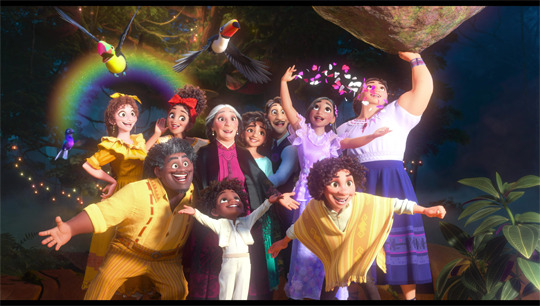
But there are strong indicators, assuming one is versed in South American history. In a flashback, we see Alma and her departed husband as a young married couple. Their happy life is upended when forced to flee their home. Soldiers move in on the city, violently ransacking the town. These enemy soldiers are only seen illuminated from behind. Those in the know would recognize them as soldiers from Colombia’s Thousand Days War.

Even without the historical context, it’s an easily sympathetic backstory. In a short span, she survived a war, became a refugee with newborn triplets, and saw her husband murdered by nationalists. It was a major traumatic experience. So much so, the mystic forces of the world bestowed Alma with a magic candle. It created a secluded valley where she and other refugees could live in peace, isolated from war and bloodshed.
The candle also awarded her family line with magic gifts to serve this new village. Alma was indeed blessed with great fortune, but has never forgotten it came at a dire price. She never wants anyone to live through a fraction of what she’s experienced. Anarchy cannot destroy any more lives. But there’s no point in saving everyone from misery if the process itself is causing misery. Her obsession with perfection is eating away at her family.

Bruno’s vision wasn’t Mirabel either fixing or destroying the family. It was both. She needed to destroy its dysfunctions to save them. Mirabel never received a gift because it was her destiny to fix this. Had she received magic powers, she’d only be another extension of the trouble. This the type of problem that can only be seen by an outsider.
Coincidentally, Pixar has explored the idea of generational trauma twice. The first in the 2017′s Coco, and again in 2022′s Turning Red. Both films center their conflict around fantasy. Both integrate the fantastic and the dramatic. Both agonize over the troubles and problems that have rippled through generations. And both are resolved in a satisfying way.
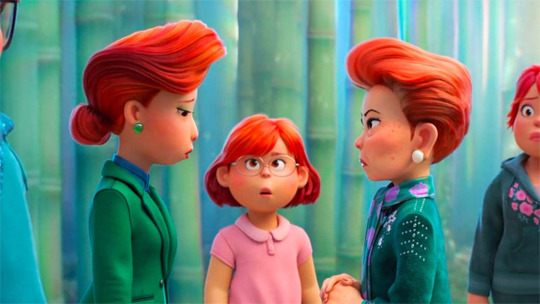

Released between these two pictures, Encanto seems like a natural companion piece. But while both Turning Red and Coco intertwine their protagonists’ personal journeys with their exploration of family troubles, Encanto falls short. Pixar’s offerings focus on the invisible conflict between children and elders throughout. Generational conflicts are explored from the start to the conclusion. Much of Encanto is spent recognizing whether there’s even a problem to begin with.
By the time Mirabel recognizes her family's issues stem from her grandmother's actions, the film is rapidly approaching the finale. The idea is dropped into our laps almost unceremoniously. The movie declares its theme like a mystery detective announcing the culprit.

In fairness, the plot thread isn’t pulled from thin air. The subtext was always there, just shoved into the periphery. The movie wanted us to focus on other things instead. Things like Bruno’s absence and Mirabel’s prophecy. The movie was dangling red herrings, trying to keep its fantasy elements in the forefront. It's as though the writers were ashamed of the conclusion. As though family drama and grief processing were too mundane for their fantasy world.
When Mirabel and her grandmother discuss their issues, the resolution arrives questionably fast. It’s emotional themes are localized to one scene, and that scene is handled in a very mature, low key, expedited way. It’s a sensible discussion between a grandmother and her granddaughter. It’s not a bad representation of an introductory therapy session, but it feels insubstantial for a movie. Its more of a forced resolution than an actual satisfying conclusion.
In both Turning Red and Coco, the cycle of generational trauma is broken with storytelling twists. Actions, revelations and discoveries overwhelmingly change their respective families. Everyone learns something they couldn’t have possibly understood before the adventure at the core of their movie. The trauma is broken because their entire worldview is now different.
But in Encanto’s case, the trauma is broken because the writers want it to be broken. Mirabel reaffirms her love for her family. Alma promises to be patient and understanding. And this solves their problems. It’s an easy, unearned path to resolution hiding behind sentimentality.
It’s also a major stylistic mismatch from the fantasy concepts we’ve seen so far. There’s no discovery of a long-held secret. There’s no radical upheaval in the family dynamic. There’s no sacrifice or loss or change in the family’s magic. Mirabel and Alma have a conversation, apologize, and that’s it.

It’s ironic that such a treatment befalls a film about the struggles of who you want to be conflicting with who you’re expected to be. Disney had an idea of what ending they wanted, and forced it to end in such a way.
It’s even more ironic that this wasn’t the only time such an occurrence befell the film. It happened during the character design phase. Luisa is an ox of a character. She’s able to lift entire buildings without effort. Being such a strong person, Luisa is naturally drawn bulky with muscular limbs and torso.

One would think this would be a fairly straightforward portrayal of a strong character. But the animators had to emphatically fight the producers to keep this character design. From the producers’ perspective, the overly-muscular woman would be off-putting and intimidating. She’d look unappealing on merchandise, and kids would stray away from any product featuring her.
The opposite wound up happening. Girls in the coveted youth demographic absolutely loved Luisa and her design. She was the breakout star of the film. What little merchandise existed featuring Luisa sold out quick.
Meanwhile, Disney gambled on the stereotypically girly Isabela, whose products only sold average. Funny enough, Isabela’s character arc concerned her frustration towards her conventional femininity. She considered her curated, manicured ways confining and unsatisfying. But it was that artifice that was slapped on bedsheets and bookbags. It’s like the merchandising gurus were hoping kids didn’t pay attention to the film.
It’s not until Isabela abandoned this life that she found happiness. Such a departure is visually represented by fluorescent highlights in her hair and a splotched dress. Like Luisa, this design was also sought after, but not as readily available as other merchandise. Both wound up being available in greater quantities, but not until after the Christmas buying bonanza.

Even the casting process squared expectations against reality. Mirabel is voiced by actress Stephanie Beatriz. Except for a supporting role in the film adaptation of In the Heights, Beatriz didn’t have a history in music or musicals.
Beatriz is most famous for her role as Rosa Diaz, a hardened, intimidating police detective on the sitcom Brooklyn Nine-Nine. This is likely why the filmmakers first approached her for the role of Luisa. They assumed Beatriz was identical to her character in real life. In reality, Beatriz is a substantially upbeat, energetic, feminine person. Detective Diaz is almost an opposite of her actual personality. Aside from the family strife, she was uncannily similar to Mirabel. Beatriz was soon offered the film's lead role instead.

In all, Encanto had a problem defining its very definition. It was made in defiance of corporate expectations. Disney assumed they knew what audiences wanted, and what shortcuts would be acceptable. Those assumptions were not only wrong, but often backwards.
During production, Disney CEO Bob Iger stepped down from his position, replaced by Bob Chapek. This change in leadership combined with a misunderstanding of audience expectations is troubling. These are the necessary circumstances to bring about another dark age in Disney Animation. But since this blog’s exploration into Disney’s past has caught up with Disney’s present, we can’t tell for certain. We’ll have to wait and see.
In conclusion, Encanto is a very energetic and colorful film. It has a vibrant soundtrack, memorable characters, and a good sense of humor. But its trenchant themes are left unintegrated, leaving its message contrived and superficial. While the narrative itself is anemic, the film's strengths carry it ably. It’s a well-built house, but it’s on a lousy foundation that needs repairs.
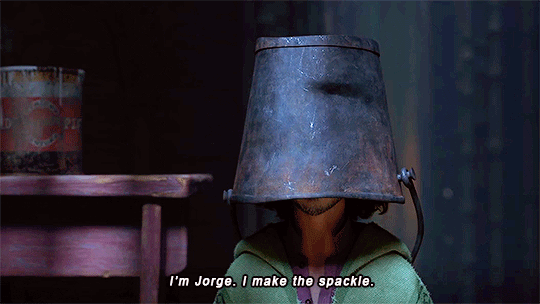
Beauty and the Beast
Fantasia
The Lion King
Frozen
Snow White and the Seven Dwarfs
Cinderella
Alice in Wonderland
Sleeping Beauty
Mulan
Zootopia
Tangled
The Little Mermaid
Aladdin
Lilo & Stitch
The Many Adventures of Winnie the Pooh
Pinocchio
The Jungle Book
Robin Hood
The Sword in the Stone
Bambi
The Emperor’s New Groove
Encanto
The Hunchback of Notre Dame
Moana
The Princess and the Frog
The Great Mouse Detective
Big Hero 6
101 Dalmatians
Bolt
The Three Caballeros
Lady and the Tramp
Frozen II
The Rescuers Down Under
Atlantis: The Lost Empire
Wreck-It Ralph
The Fox and the Hound
Fantasia 2000
Peter Pan
Dumbo
Hercules
Meet the Robinsons
Brother Bear
The Black Cauldron
Raya and the Last Dragon
Melody Time
Oliver & Company
Treasure Planet
Tarzan
The Rescuers
Pocahontas
Saludos Amigos
The Adventures of Ichabod and Mr. Toad
Winnie the Pooh
The Aristocats
Ralph Breaks the Internet
Dinosaur
Fun and Fancy Free
Make Mine Music
Home on the Range
Chicken Little
#Encanto#Disney#walt disney#Walt Disney Animation Studios#disney studios#Disney Canon#movie review#Film Criticism#film analysis
15 notes
·
View notes
Text
Raya and the Last Dragon at 35
A review by Adam D. Jaspering
Imagine you owned a four-screen movie theater. Your four screens are in auditoriums of four different sizes: 400 seats, 300 seats, 200 seats, and 100 seats. You can show two different movies on any number of screens. Movie A is a much anticipated blockbuster from a widely respected studio. Movie B is a less auspicious film that has garnered only mild interest. You can safely assume for every 1000 customers wanting to see Movie A, only 50 will want to see Movie B.
On the surface, it would seem logical to put Movie A on all four screens. 1000 tickets sold is better than 950 tickets sold. But as counterintuitive as it seems, this would not be the best decision for a theater owner. Offering Movie B on the smallest screen, even filled to half capacity, will pay off better in the long run.
From a consumer perspective, you have already demonstrated a commitment to Movie A. Those unable to see Movie A due to sold out showings know there will be another opportunity. They can return at another time or another day. But if Movie B is never shown, you lose those potential customers outright. They won't return because they know they will not be served. By only showing Movie A, you serve 1000 customers. By catering to both markets, you combine both totals, serving 1050 over a longer range.
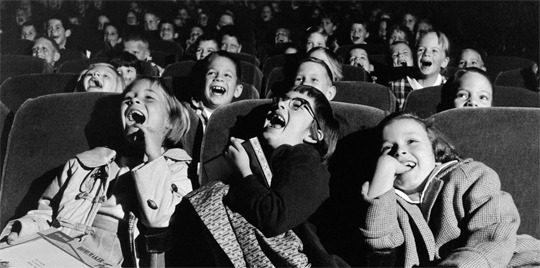
The reason is, it is in a business’s best interest to provide a variety of products or services. Economists routinely find evidence that consumers appreciate options. It allows businesses to reach a wider audience. It increases customer loyalty. It demonstrates growth potential. It improves visibility and credibility in a competitive market. It also provides for crossover demographics. In our hypothetical scenario, there is also an unaccounted for third group who will see both Movie A and Movie B.
This scenario is the basic booking strategy for a movie theater. Their main goal is to accommodate their customers. Variety benefits theaters and patrons. It does not represent the best interest of the movie studio who made Movie A.
As Disney continued along their domination of pop culture in the late 2010s, they began exercising their power on the movie theater industry. Disney Animation, alongside Pixar, Star Wars, and Marvel, were consistently earning hundreds of millions of dollars at the box office. It wasn’t uncommon for their films to cross the one billion dollar threshold. Disney knew they had a viable product, a market presence, and a consumer base. But they needed to control the theaters themselves to maximize returns.

Because of an antitrust law from 1948, movie studios are unable to own their own movie theaters. All cinemas in the United States must be unaffiliated from film studios. Meaning, Disney was legally required to split all their grosses with any theater who played their films.
To put it another way, a movie’s potential is not just the responsibility of the studio. They can make the film, and they can market the film, but it's ultimately theaters who decide when and where you can see the film. Booking agents decide what films to book, what markets to focus on, and how long engagements last. Then individual theaters decide when the movies play, how often, and in how many theaters of what size.
In 2016, 30% of American box office sales were for Disney films. They were the cinematic titans, with the closest runner-up accounting for only 11% of sales. With this leverage, Disney forced theaters into more lopsided deals. Theaters favored variety. Disney pressured them to favor homogeny.
We'll use 2017′s The Last Jedi for an example. Under Disney's new contracts, theaters were required to play the film for four weeks on their largest screen. Released over the busy holiday season, every rival studio was automatically relegated to inferior auditoriums. Competing films would be smaller affairs by default, unable to impact Disney's revenue.

Disney also began taking larger percentages of the box office draw. Typically, studios and theaters split the revenue of a new release 60/40. Disney increased their take to 65%. Breeching any part of the contract authorized Disney to increase their take to 70%. Violators would also be blacklisted from future releases. It was Disney's ultimatum: show our movies the way we want them shown, or else you can’t show them at all.
Disney held all the cards. They were responsible for one third of a typical theater's annual income. Losing that income was a serious threat. These were authoritative demands, but theaters had no recourse. They were forced to accept.
How much longer until Disney forced their films onto every screen for months at a time? How much longer until they took 80% profits? 90%? Would they start demanding a percentage of concession sales as well? How long until Disney pressured congress to roll back antitrust laws, allowing Disney to own their own Disney-brand theaters, making them the only place to see Disney content?
Fortunately, these questions remain eternally hypothetical. Things changed in 2020. As powerful as Disney was as a corporation, they still had to buckle to the power of an international viral pandemic.

When the world entered governmentally mandated shutdowns, the film industry came to a screeching halt. For months, the vast majority of movie theaters were closed. Studios lost their primary revenue source.
Initially, studios attempted to wait out the Coronavirus pandemic. It was speculated the virus would run its course and be controlled after two weeks. When the pandemic reached its third month, studios realized they needed a long-term solution.
In the pandemic’s beginning, streaming sites were still operating on a library-based system. They offered a back catalogue of films. They showcased movies after their premieres and theatrical runs. With the exception of Netflix, which operated in defiance of the conventional studio/theatrical system, debuting films on streaming sites was a rare occurrence. It was usually reserved for documentaries, special interest films, or low-budget affairs.
Antitrust laws prevented Disney from owning their own theaters, but a streaming site is not a theater. Disney was well within their rights to debut films on Disney+, superseding movie theaters altogether. Being the only major studio with their own streaming service, they had an advantage available to no one else.
Perhaps this was always the intent. Perhaps Disney was frustrated by the limitations and boundaries of the theater system. Perhaps a move to online premieres was always an intended path for Disney+. If it was, the quarantine moved the timeline forward.

Debuting a film on streaming meant a staggering decrease in profits. The infrastructure was in place, but the market was not primed. Audiences were either hesitant, uninformed, or unmotivated to purchase new releases online. But Disney was currently earning nothing from new releases, and any number was better than zero.
But how should one price a film in this new market? Theaters had an obvious itemization metric. One body, one seat, one ticket. Was it fair to charge a price for a new release on top of already charging for the site’s membership? Or should they forego one fee for the other?
Disney tried various strategies in real time. Artemis Fowl, Soul, and The One and Only Ivan were released for free to Disney+ subscribers. A live-action adaptation of Mulan was also released on Disney+, but with a $30 surcharge.
Bypassing theaters was a major leap forward instead of a gradual rollout. The strategy wasn't expected to be a success, only a slowing of the financial hemorrhage. Mulan earned $261 million from streaming against a $200 million budget. Compare that to the previous year’s adaptations of Aladdin and The Lion King, which respectively earned $356.6 million and $543.6 million domestically.
The verdict was in: some people would willingly pay $30 for a new release on streaming. A good percent of patrons would not. This would not be a viable strategy for the future.

As the pandemic entered 2021 and society began reopening, a large percent of people were still hesitant to return to public spaces. Disney and other studios were impatient. They wanted their money, and theaters were still the best place to get it. But some people weren't going to theaters, just as some people weren’t buying premier streaming access.
Studios made the decision to offer simultaneous releases for the foreseeable future. Those who wanted to pay for convenience could watch at home. Those who wanted to pay for the experience could go to theaters. Either way was fine, just as long as they paid.
In 2021, many films from various studios were offered both in theaters and as premium video on demand. On Disney’s side, such films included Black Widow, Jungle Cruise, and the subject of today’s article, Raya and the Last Dragon.
Their releases delayed by months, Disney needed to recoup money somewhere. Marketing and merchandising for Raya and the Last Dragon were slashed. It's hard to hype up a soft, delayed, inauspicious premiere when you can't even attach a specific date.
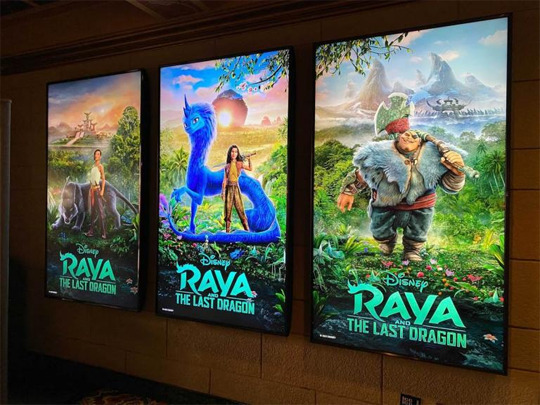
The financial breakdown of the simultaneous release strategy is unknown. Here, Disney and other studios ceased the practice of officially reporting studio earnings and box office results in tandem with streaming numbers. As the saying goes, no news is good news. And the movie industry desperately wanted some good news.
Simultaneous releases were always intended to be a temporary measure. Disney and other studios discontinued the practice by the end of 2021. Disney is still reliant on theaters, for now. They can still arbitrate demands, but are no longer using theaters as their only option.
Most mid-budget films are debuting exclusively on Disney+. Large budget films are still playing in theaters first, but Disney has been more flexible with theatrical releases. Standard booking windows were once 90 days before Disney released on home media, streaming, and digital purchase. That range has been shortened to 45 days. In some cases, it’s even shorter. Their following film, Encanto, was in theaters for only 30 days before being offered on Disney+.
The point is, people and corporations are primarily driven by their own self-interests. But self-interests change in times of emergency. A draconian overlord of the box office one day could be struggling the next. One has to adapt and acclimate to a changing environment to survive. It's true whether you’re a movie studio trying to sell films in a pandemic, or a fantasy heroine trying to defeat the forces of darkness.

Raya and the Last Dragon is a fantasy adventure set in Kumandra, a land overrun by distrust and tribalism. The hostility of its five populations has awaken an ancient curse, The Druun. 500 years ago, The Druun was defeated by an army of dragons, of which none remain. Raya, princess and surviving heir to one of Kumandra's thrones, fights for her world's future. Following a legend, she discovers the world’s one remaining dragon. Together, they must stop Kumandra from being destroyed by The Druun, but also stop Kumandra from destroying itself.
Let’s address the elephant in the room straightaway. The Druun is a smoke monster. It travels through the air. Large swaths of the population perish after being exposed to it. The lucky survivors remain vigilant, taking many precautions to avoid exposure. They live disenfranchised, their lives upturned. The world has been thrown into upheaval because of The Druun. This is either the most unfortunate or ironically appropriate film for Disney to release during the Coronavirus.

Raya and the Last Dragon is Disney’s foray into dystopian fiction. We see the world as chaotic and struggling, but still surviving. The five Kumandran tribes begin the film as temperamental and isolationist. They're houses of cards; functional, but ready to collapse. The Druun is the catalyst.
The Druun, as monstrous and destructive as it is, is only one element of the world's negative state. The people are besieged by political turmoil, environmental disasters, and militaristic omnipresence. It's an essential element of dystopian fiction the film gets right: even if the big problem somehow vanishes, the million little problems still exist.
Kumandra is geographically centered on a large inland sea shaped like a dragon. Each of the five nations takes it name from the anatomical portion of the dragon it borders: Fang, Heart, Spine, Talon and Tail. Five lands, five populations, five biomes, and five cultures.
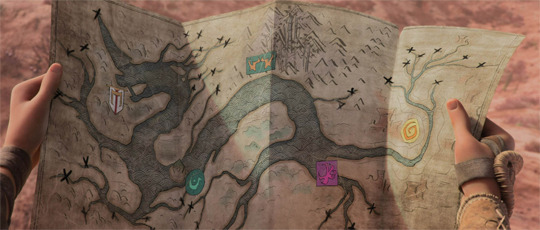
Having five separate lands makes for an interesting challenge. Five designs, five styles, five motifs, five interlocking sprockets of a single complex mechanism. These lands pride themselves on specific attributes and traits. They're all part of one collective whole, but not by choice. They more readily identify themselves by their individual distinctions. These conflicts define the world; a contrast between how each tribe identifies and what how it wishes to differentiate from the others. People from Fang very much wish not to be like people from Heart, for example.
Such a portrayal relies on the filmmakers immaculately constructing all five lands. There must be an emphatic and deliberate representation of these five nations and populations. We must be able to tell instantly, from any still, what land we are in.
Raya and the Last Dragon doesn’t accomplish this. In a film that’s only 100 minutes long, less than 20 minutes can be dedicated to each land. There just isn’t enough time to define a full national aesthetic while also telling a story of characters just passing through.
Early in the film, we’re given a brief montage providing a one-sentence identifier of each land. The issues are present early on, with the five nations being far too similar. The writers abused their thesaurus, finding every synonym for “combatant” to describe them. Maybe a commentary on the futility of their fighting. An indication that despite their insistence on differentiation they’re pretty much the same. Maybe.

When all five nations are represented in a room together, they all look the same and they all act the same. If they weren’t all wearing their specifically-assigned color scheme, there’d be no way of knowing who comes from where. Once the sun goes down and everyone is shrouded in shadows, that’s exactly what happens. Again, maybe a deliberate design choice. Maybe an oversight. It’s hard to say.

When it comes time to visit their lands, the distinctions are clarified marginally. Tail and Spine are completely ravaged by The Druun, leaving next to nothing of their world. What little we knew about them before, we now know even less. Their culture and their populace are left in ruination.

It’s hard to mourn the loss of an empire when we were never introduced to the empire. Tail is presented to us as a giant inhospitable desert, and that’s what it feels like. That anyone ever lived here, much less a thriving empire, we have to accept on rumor.
The same goes with Spine. In certain shots, it looks like a remote village in the woods where maybe a few dozen people lived. But on the scale we’re presented, it could also easily be an abandoned sentry post. Either way, it’s hard to imagine it as an entire empire.

These lands don’t feel like the ruins of newly fallen civilizations. They feel like waypoints for Raya to travel through. They feel like staged ghost towns or amusement park facades. Places bereft of any true identity beyond the first glance. Their only distinguishing features are their climate, used to break up the visual monotony. They don’t register as the lands of Tail and Spine. They’re the desert land and the icy forest land.
Talon gets a fair share of distinctive characterization. It’s floating markets have kept the hydrophobic Druun at bay. A majority of its populace remains alive, relocating to the waterfront. However, the desperate people have descended to a life of crime and con artistry. We see them as innovative, commercialized, treacherous and duplicitous.
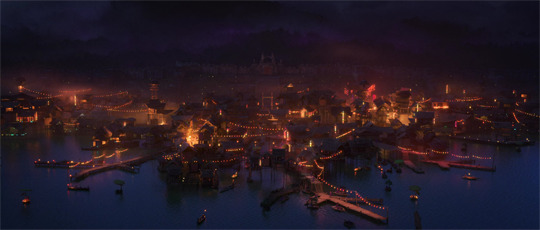
Talon is the only one of the five lands that seems like a real world within this film. Our characters interact with the citizenry. We see their day-to-day life. We have adventures and situations and interactions that could happen only here. This is an empire. Everywhere else feels like a movie set.

Heart and Fang are where a majority of the film takes place, including both the prologue and climax. Ironically, so much of the story takes place in these two locations, we learn very little about them. There's too much story happening in the foreground. Characterization and exposition has to be forced out. There's no time to let us absorb the scenery because things are moving too fast and in such abundance. Details concerning setting are treated as unimportant, and therefore undefined.
We can understand base traits of Heart and Fang based on things like architecture and landscaping. For example, Heart features cobblestones and an integration of grass and plants. They’re reverent of the past and the surrounding natural world. Fang meanwhile features polished marble and golden accents. It’s a very structured and controlled environment. While these designs evoke ideas, we learn nothing about the societies or populace beyond each land's two named characters.
Heart is Raya’s homeland. It’s a peaceful land, steeped in its appreciation for ancient history. Except for the polished azure palace, it’s fully integrated with its surrounding jungle environment. So much so, one is quick to associate Heart as the token jungle land. Except every time Raya is traveling outside one of the five lands, she’s traveling through jungle landscapes. Heart doesn’t represent anything because its the default, standard empire. It's the jungle land in a world full of jungle lands. If not for the temples and palace, it would have nothing distinguishing about it.

Prior to the Druun apocalypse, Heart was home to an artifact known as the Dragon Gem. An ancient relic full of magic, Heart kept the gem protected and safe for centuries. They were rather adept at protecting it. Which is why they trained a 12 year-old Raya to be a guardian, who on her first day of the job, opened the temple to show the gem off to her friend, who immediately tried to steal it. The land of Heart is one based in ancient customs, but not logic or critical thinking.
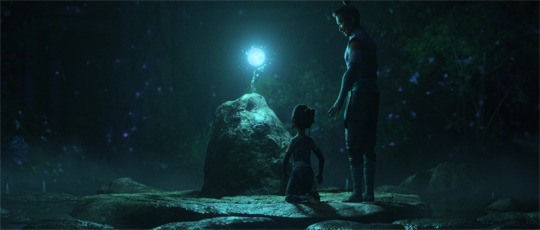
Fang is a stock empire in dystopian fiction, that of a false utopia. It’s a very urban environment (or as urban as one can get in this fantasy world). In a world where peril and uncertainty abound everywhere, Fang can guarantee security. This doesn't happen by chance or accident. The powerful and the influential promise safety in exchange for obedience.

There’s a dark irony of Disney portraying a paradise masking a nefarious secret. The Disney Corporation’s entire schtick is portraying itself as a utopia, trying to suppress its heinous exercises of power. The manicured beauty of Disneyland is maintained by underpaid wage slaves. The company’s colorful cartoons and movies hide the authoritative lawyers who enforce copyrights with an iron fist. Coveted merchandise is assembled and packaged in third-world sweatshops. Their library of intellectual property cheats creative minds and laborers out of residuals. Even the previously mentioned totalitarian standards against theater owners is a demonstration of their merciless drive for control and profit. All these crimes are hidden behind childlike smiles and family-friendly whimsy. The ends justify the means. Disney can’t rightfully depict a dystopia onscreen, as they themselves would never see the perpetrators as the bad guys.
Fang is the only one of the five lands that has not descended into anarchy or ruination. This puts them in a unique position of power and privilege. Fang’s leader knows full well that any return to normality is a dismissal of these entitlements. It's her full intention to possess the Dragon Gem which could otherwise undo her fortune.
If she can prolong the apocalypse, maintaining her position of power, she wins. If she can end the apocalypse herself, positioning Fang as the heroic savior of Kumandra, she wins. Either way, things work in her favor. But she needs the Dragon Gem before she decides. And as such, she needs Raya out of the way.

These orders are carried out by, Namaari, the film’s antagonist. Namaari is the daughter of Fang’s leader, just as Raya is the daughter of Heart’s. Both are versed in the history of their land. Both appreciate the legend of ancient dragons. Both are thoroughly trained in combat. There's a symmetry that makes them a memorable pair. They have very much in common, and in another life would have been strong allies. But one decision set these two on separate paths, turning the two into bitter enemies.
As a child, Namaari was instructed to befriend and betray Raya. All personal feelings aside, Namaari carried out her mission. Maybe Namaari was genuine in her affection towards her new friend, but saw an opening and took advantage. Maybe it was subterfuge all along, stringing Raya along until an exploitable opportunity presented itself. We don't know, and frankly, Namaari presents herself as not knowing either. Six years later, Namaari continues sparring with Raya, their rivalry only worsened with time.
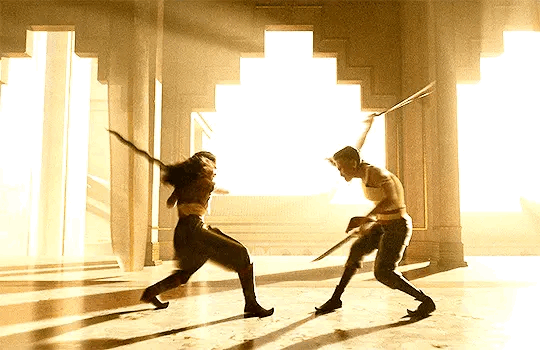
The Dragon Gem is a magic artifact that has kept The Druun at bay for centuries. In a struggle to steal it, the gem shatters into five pieces, each fragment claimed by a different land. Once it shattered, The Druun returned.
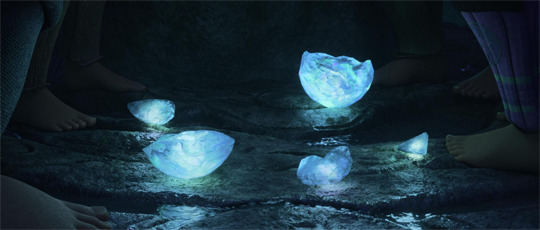
The Dragon Gem is the last remnant of the dragon army who sacrificed themselves 500 years ago. One dragon remained behind, using the Dragon Gem to defeat the Druun before disappearing. If this dragon can be found, they can use the Dragon Gem to stop the Druun once again. With nowhere else to go and no better plan to try, Raya follows an old legend that the last dragon is dormant somewhere. This is Sisu, the Last Dragon of the film’s title.

It only takes a few moments of screen time to understand Sisu's schtick. She's directly influenced by Genie from Aladdin. The eccentric mannerisms. The manic energy. The upbeat and jovial personality. The insistence on telling jokes while everyone else is waiting patiently for her to be quiet so the movie can continue.
Sisu is a very commanding character, in that any scene she's in, she must be the center of attention. I’m sure there are some people out there who appreciate her and her sense of humor. Maybe in a different film, she’d contribute more than she contributes to Raya and the Last Dragon. As it is, Sisu has a bad habit of distracting the audience and ruining the film’s immersion. She doesn’t feel like she belongs in this world. She doesn’t act like she belongs. She doesn’t talk like she belongs. She feels like she got stuck in a wormhole and popped in from a different universe.
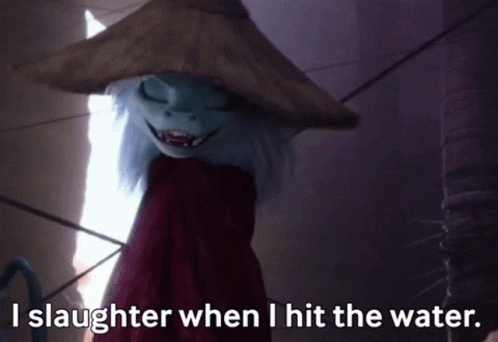
This problem isn’t Sisu’s exclusively. The movie has major tonal consistency problems throughout. It wants to be a serious film, trenched in warfare, with explorations of nobility and honor. It also features bugs that fart and explode. It wants to champion the tenet that in times of tragedy, people should put aside their differences and work together for the good of mankind. Then it features a sassy baby doing parkour. It wants to be an honorable depiction of southeast Asian culture and heritage. Then our hero and villain bond by finding out they are both, and I quote, “Dragon nerds.”
Genie was one of the best parts of Aladdin, and the reason was, despite him being unlike anything else in the film, he still fit into the film. He was a thematically clashing comic relief, but Aladdin was a comical movie. Every character had a humorous disposition or good natured quality to them. Even the stern and sour Jafar had a penchant for dressing up in costumes and verbally mocking the heroes.
When Genie did something that made no sense in the film's world, there was a foundation that supported it. He provided a unique style of comedy in a movie that was already explicitly comedic. Raya and the Last Dragon is not that type of movie. Raya and the Last Dragon feels like it should be an epic period drama crossed with a fantasy adventure. A boisterous comic presence doesn’t benefit it.
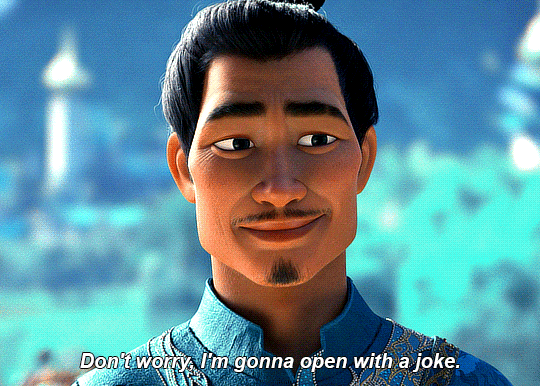

Half of the movie, Raya's half, is trying to be a serious, Wuxia-inspired adventure. Sisu’s half is trying to be a low comedy escape. These two halves are in competition throughout the film, and the comedic portions fail every time. Sisu and Raya don’t make a good pairing. Sisu’s jokes seem like an unwelcome intrusion, and make Raya’s brooding seem unnecessarily misanthropic.
All these critiques would still apply even if Sisu were actually funny. In reality, Sisu is a fairly obnoxious presence. Not only does her humor clash with the tone and setting of the world, they’re just not very good jokes. And because Raya is so concerned with her own affairs, the screenplay forces her to accept Sisu as a helpful ally. There's no time for her to argue or pass judgment. Raya can’t break her stride and tell Sisu she’s irritating. She just ignores Sisu until she’s quiet again. A skill I’m sure most of the audience wishes they possessed.
Sisu’s schtick is delivered in abundance. Sisu has the temperament of a seven year-old child crossed with a barking terrier. She’s in love with the sound of her own voice, and she’s desperate for others to hear her speak. The filmmakers definitely took the quantity over quality approach. She's the worst type of comic relief character: a poor comic and no relief.

Raya’s main character arc concerns her trust issues. Betrayed as a child, she’s grown into an extremely self-reliant but paranoid person. To grow, she needs to give people the benefit of the doubt, accept help when needed, and rely on the promises of others. Especially if she’s going to be a leader.
While this sounds like a noble message in a vacuum, it’s deeply flawed in practice. Even the film itself has trouble making the moral work. Time and again, Raya is told to trust people, mostly by Sisu. Throughout, trusting strangers leads to moments of vulnerability. Raya and Sisu are repeatedly subjected to deception, fraud, theft, or treachery, usually after Sisu insists Raya trust a total stranger. A movie can't espouse the importance of trust one minute only to use treachery to disenfranchise our heroes in the interest of drama. It's one or the other.
The knows what point its trying to make, but absolutely fails at demonstrating it. It wants to offer a perfect ideal of harmony, and not a gray, conditional reality. But trust is not something that can be doled out without consideration or caveats. Raya certainly has trust issues, but Sisu’s blind faith and optimism is just as big a problem. And yet, only Raya’s flaw is addressed as something that needs fixing.
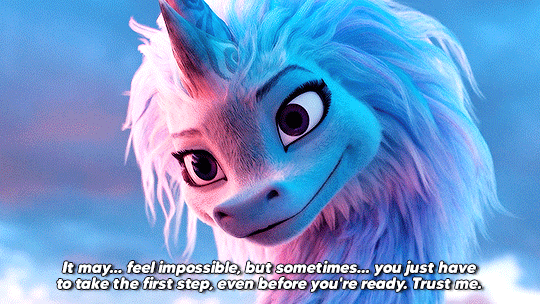
The logical route would be to offer an interplay between the two extremes. Together, our two heroes learn the flaws of their respective viewpoints. Together, they find a happy medium between their polarized extremes.
But caution and forbearance doesn't fit into the Disney mold. “Everyone lived happily ever after” is the traditional ending. You can't achieve that by serving the unflappably happy character a reality check. "Everyone lived with a much more realistic understanding of the duality of human nature" doesn't have the same ring.
There’s a lot of story going on, and the movie wants us to understand it alongside the world, mythos, and people. A lot of exposition happens trying to establish it all. Not only do we get a flashback, we get a prologue within the flashback.

The plot isn’t really all that complicated: there’s a dragon, there’s a monster, and there’s a magic rock broke into five pieces. The dragon can use the rock to stop the monster, but she needs all five pieces.
It’s not an impressive story, but it’s serviceable. The focus is instead on the unique world and the unique characters. While there are plenty of unnecessary distractions, vacant areas, and a lot of painful humor, it’s a detailed and unique world. Despite the film's many flaws, it's at least pleasant to look at.
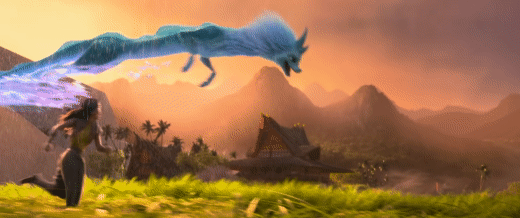
There’s lots of great animation. The Druun cloud effects. The flowing hair of Sisu as she flies and swims. One can practically smell the scent of a riverbed every time a moss-covered stone is shown. The animation detail is plentiful.
The water effects are also good, and I deliberately damn them with faint praise. Canonically, The Druun is repelled by water. As such, the people of Kumandra have adapted to living on or near the giant inland sea as a form of protection. There’s a justified reason in-story for three quarters of this movie to feature water effects. Behind the scenes, it was another opportunity for Disney’s animators to display their proficiency at animating water.

After both Moana and Frozen 2, I have zero doubts that Disney can animate water. Raya and the Last Dragon is the third film that demonstrates their marvelous ability to animate water in CGI. We’ve seen their abilities in great abundance, and we're seeing them again. Either Disney has lost their confidence to try anything new, relying on one skill they know they can do well, or they’re conceited, assuming everyone is pleased with this one specific trick. The water effects are good, but they’re rote and overdone.
What of the characters? There are better heroes in the Disney canon than Raya, and there are better villains than Namaari. But what makes them unique is that they make a great adversarial pair. Normally, Disney films don’t feature the hero actually sparring with the villain until the third act. Until then, they either don’t cross paths, or there’s a tense coexistence until the villain becomes irredeemable.
Raya and Namaari feud throughout the film. There are great choregraphed fights between the two, each skilled in close-quarters combat. It never gets violent or offensive to the young audience, but the thrill is still present. The outlandish stunt choreography keeps the combat rooted in the fantastic. Raya’s sword, which can transform into a whip, is ridiculous but also stunning.

Raya is the film’s main character, and as such, it’s her character arc that serves as the central crux of the story. But it’s not Raya’s growth and development that drives anything. When she was a kid, she trusted someone when she shouldn’t have. Then when she was a teenager, she didn’t trust anyone. Then at the film’s end, she trusts people again. That’s not growth. That’s getting back to normal.
As a kid, Namaari betrayed Raya. She did so based on the beliefs and values forced upon her. She was taught that manipulating others for the sake of her homeland was not a bad thing. Namaari continues to antagonize Raya to present day.
Raya was the one hurt. Raya is the one who’s carrying this baggage. Raya cannot rightfully be expected to be the one to grow and change. It’s Namaari who has to redeem herself and in turn save Raya. The film should instead be focusing on Namaari in terms of character growth and development. This would allow Raya to be static and drive the plot.
Namaari’s redemption arc is a slow burn, realizing she’s become a person she doesn’t want to be. Her patriotism to Fang, her loyalty to her mother, her command of an army... all hollow without her own self-respect. Throughout the film, she realizes how meaningless and destructive all her achievements have been. She's been a pawn in her mother's tyrannical game.
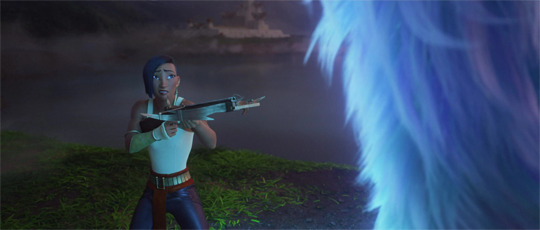
She knows she needs to change. She needs to fix things, many things, but doesn't know how. In the film's climax, The Druun's strength reaches critical mass. It forces her to take the necessary steps to redemption all at once.
The movie gets the roles of Namaari and Raya backwards in the climax. As it plays, Raya is sacrificing herself to save Kumandra. Namaari has to make a giant leap forward and join her, absolving herself and stopping The Druun.
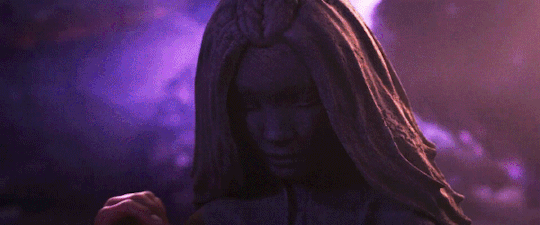
Instead, it should be Namaari sacrificing herself first. Both to atone for her misdeeds against Kumandra, and to apologize for betraying Raya. Raya should be the one forced into a moral dilemma against a ticking clock. She needs to decide whether to stick to her toxic beliefs, or to abandon them and accept Namaari’s apology.
The relationship between Raya and Namaari is an adversarial one. These two are evenly matched in every confrontation. There are very few differences between them, and as such, they understand each other very well. Knowing their enemy is just as easy as knowing themselves. Their fights are tense and personal, whether they be verbal or physical.

Unfortunately, it all feels hollow. What should be a front and center character dynamic is left in the periphery of the film. Not by neglect or ineptitude, but forced out. There are too many superfluous elements crowding the film.
Again, the film’s focus is on the importance of trust. As Raya travels through Kumandra, she encounters strangers whom she needs to rely on to progress. In turn, Raya winds up acquiring a large travel party. With each land she visits, Raya acquires a new tagger-on. The film is called "Raya and the Last Dragon," but such a name is underselling the swollen cast.

At the film’s climax, there’s Raya and the last dragon. There's also Raya’s pet/steed Tuk-Tuk (a combination pillbug, armadillo, dog, bear amalgam), Boun the young restaurateur/boat captain, Noi the infant con artist, Tong the grieving warrior, and three thieving monkeys. Namaari may be the most important secondary character thematically and contextually. But she's forced to fight for screen time with a character eerily similar to The Boss Baby.

Each tagger-on has been negatively affected by The Druun, losing their family, loved ones, homes, and purpose in life. Each of them need both friends and hope, and Raya provides both. Just like Dorothy in The Wizard of Oz, they join her quest, turning a personal journey into a group endeavor.
The cast represents a message of unity and cooperation. Each comes from a different land of Kumandra, but each have the same wants and goals. Narratively, it makes sense. The problem is, since each has basically the same backstory, the same goal, and the same purpose in the story, they don’t have much to distinguish themselves. There’s too many characters and not enough story. It’s easy to forget Noi and Tong even have names. I keep calling them Baby and Eyepatch.

It's the same problem as Meet the Robinsons. The story requires a large cast, but that's an ambition, not a justification. There are too many characters, and the movie doesn’t provide enough for them to do. After everyone is introduced, they sit around, contributing nothing. They become set decoration.
Raya and the Last Dragon is a movie that has good ideas at its core, but buries them under unhelpful nonsense. The final result is an unrewarding slog drowned under superfluous ideas, bad humor, and a misguided moral. The film tries to build a world beyond its ability and the limits of the running time. Everything seems rushed, underdeveloped, synthetic, or redundant. What’s good is emaciated, and what’s left is irritating.
Maybe we should have watched Movie B.
Beauty and the Beast
Fantasia
The Lion King
Frozen
Snow White and the Seven Dwarfs
Cinderella
Alice in Wonderland
Sleeping Beauty
Mulan
Zootopia
Tangled
The Little Mermaid
Aladdin
Lilo & Stitch
The Many Adventures of Winnie the Pooh
Pinocchio
The Jungle Book
Robin Hood
The Sword in the Stone
Bambi
The Emperor’s New Groove
The Hunchback of Notre Dame
Moana
The Princess and the Frog
The Great Mouse Detective
Big Hero 6
101 Dalmatians
Bolt
The Three Caballeros
Lady and the Tramp
Frozen II
The Rescuers Down Under
Atlantis: The Lost Empire
Wreck-It Ralph
The Fox and the Hound
Fantasia 2000
Peter Pan
Dumbo
Hercules
Meet the Robinsons
Brother Bear
The Black Cauldron
Raya and the Last Dragon
Melody Time
Oliver & Company
Treasure Planet
Tarzan
The Rescuers
Pocahontas
Saludos Amigos
The Adventures of Ichabod and Mr. Toad
Winnie the Pooh
The Aristocats
Ralph Breaks the Internet
Dinosaur
Fun and Fancy Free
Make Mine Music
Home on the Range
Chicken Little
#Raya and the Last Dragon#Disney#walt disney#Walt Disney Animation Studios#disney studios#Disney Canon#Film Criticism#film analysis#movie review
4 notes
·
View notes
Text
Frozen II at 35
A review by Adam D. Jaspering
Frozen was meant to be a stand-alone work. Released in an era that prioritized sequels and remakes, Disney Animation valued innovation and new ideas. But Frozen was a special case. Frozen was not just a popular film, it was a phenomenon.
The original Frozen was successful, acclaimed, and popular by every metric. Ironically, it was almost too celebrated to make a sequel. Anything that follows up such a landmark production was sure to be a lesser effort by comparison.
Upon completion of the 2015 theatrical short Frozen Fever, Disney decided it was worth the risk. The characters of Frozen were still beloved. Their world was still engaging. The concepts were still fun. The audience was still eager. Disney wanted to return to the world of Frozen, and a sequel was greenlit.
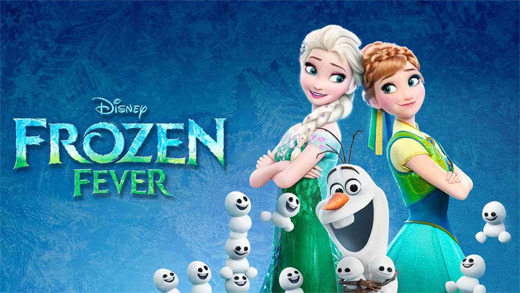
In a show of eagerness, Disney gave themselves a standard four-year production window. Fans and investors alike were expecting Frozen II in theaters by November 2019. Surely, such optimism would in no way backfire.
Chris Buck and Jennifer Lee, writers and directors of the original Frozen, returned to helm Frozen II. The duo branched out, onboarding other official writers. This included storyboard artist and animator Marc Smith. Also joining were Frozen’s soundtrack mavens Robert and Kristen Anderson-Lopez. The award-winning songwriters were no longer consulted just for musical needs. The husband and wife team were contributing story beats as well.
Perhaps five writers were needed to ensure quality. Perhaps it contributed to the increasingly layered and complex plot. Perhaps because the two initial writer/directors were detained with other duties. In 2018, partway through production, Lee was promoted to Chief Creative Officer of Disney Animation.
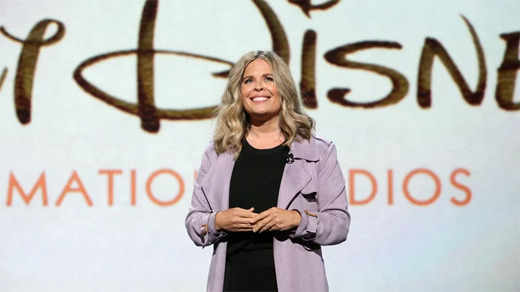
In the past, I’ve lauded the efforts and contributions of former CCO John Lasseter. I chose my words carefully, knowing full well how his tenure with the company ended. Lasseter, despite his achievements, left Disney on very unfortunate terms.
As CCO, Lasseter’s creative and artistic visions lifted Disney Animation out of a dark age. However, it was his personal behavior that resulted in his departure. Lasseter made frequent salacious remarks and unwanted physical advances towards Disney’s female staff. An ongoing problem, this behavior began when he was at Pixar, and continued well throughout his employment with Disney. He used his power, his authority, and his connections to silence any objection. But after many years and many victims, the secrets erupted. As the allegations went public, Disney removed Lasseter from his role.
Jennifer Lee was promoted to fill the void. This opportunity gave her the dual responsibility of overseeing all of Disney Animation while also continuing to finalize the production of Frozen II. A distracted and overworked director, even one of two co-directors, explains much of the final film.
It was decided early on, Frozen II would be centered on a hook. Elsa would hear a strange, ephemeral voice beckoning her. Four notes, sung across the wind, only she can hear. She’d go on an adventure, trying to find who is calling her and what they want.
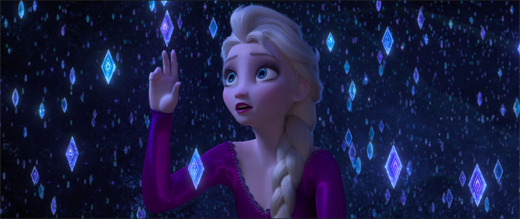
Such a foundation should be great a jumping off point for a screenplay. Except nobody on staff knew at the time who this voice would belong to, or what their relation to Elsa would be. Nor did they decide on these factors in a timely manner. Production continued with the idea left ambiguous and undecided, under the assurance the details would be provided down the line. Without a central plot or direction, development of the story proceeded at an awkward, aimless pace.
Everybody had vague ideas about how the movie should look and how it should feel. Nobody knew what the movie should consist of. All they had were odd story bits and scenery. Songs sung about nothing in particular for no known reason. New characters who had no purpose and no reason for existence. And no central story to tie everything together.
In February 2019, the first teaser trailer was released online. It featured Elsa standing on a beach at night, staring down the crashing tides. She attempts to run across the water, daring to breech the ocean waves that crash on top of her. She’s alone, she’s determined, and she’s fighting nature’s might with all her strength.
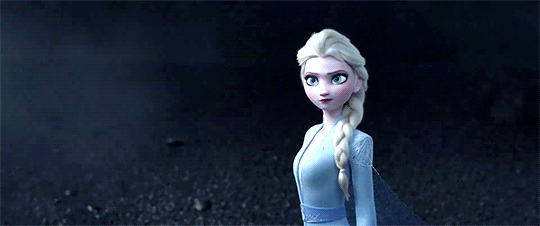

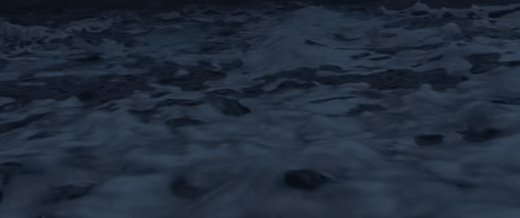
The trailer garnered interest and buzz. Fans all speculated the same things. Why was Elsa alone? Where was she? Where was she trying to get to? Why was she so desperate to combat nature, not taking a boat, or waiting until the waters calmed?
The filmmakers had no answers because they themselves had the same exact questions. After three years of development, this scene, apart from a few isolated test scenes, was the only completed part of the film. The animators had nothing to animate because the story and storyboards were still changing. The filmmakers didn’t know what Elsa was doing, how she got there, or what it all meant. All they knew was that it looked cool. But they used it for the teaser trailer, so they were obligated to fit it in the film somewhere.
Test screenings of the movie were disasters. Child audiences were either bored or confused. The plot was too convoluted, exposition dumps were unhelpful, and scenes went on too long. The film’s tone was too dark and too dry, lacking the childish humor of its predecessor. Much of the film felt hopelessly bleak.

These test screenings forced rewrites all the way to May, 2019. The plot was simplified, humor was added, and the story moved at a more exciting pace. Frozen II was being rewritten six months before the release date.
There is a docuseries on the making of Frozen II available on Disney+. It was likely intended to be a marketing tool, giving audiences even more Frozen content. It unintentionally depicts the desperate path to completion. Disney higher-ups have edited the series to seem like Frozen II was a labor of love, but the stress bleeds through.
It’s clear everyone involved was deeply invested in the project. The problems weren’t an issue of incompetence, arrogance, or limitations. The film just couldn’t coalesce. At a certain point, the motivation was nothing more than “get it done.”
Frozen II is the end result of a marathon session of rewrites, reworks and re-edits. It’s a miracle a film of any regard came from such a Sisyphean effort. If a release date wasn’t already promised, Frozen II would have very likely languished in development hell for years.
Frozen II takes place three years after the events of the previous film. Life has gone on without significant drama or upheaval. Our heroes are happy. Their kingdom is prosperous. Everything seems fine. All until Elsa begins receiving omens. To find answers, she and her colleagues venture to a mythic land up north. There, they must confront their kingdom’s past, discover their family heritage, learn their destinies, and right a wrong generations in the making.

The first thing one notices about the film, setting it apart from its predecessor, is the color scheme. Frozen was set during an unseasonable winter curse. Its hibernal setting prompted landscapes of icy splendor, including snow-draped landscapes and motifs of white and blue.
The sequel is set in autumn. A variety of arboreal colors interact, focused on reds, violets and deep green. The only scenes featuring snow and ice feature Elsa specifically. The name ‘Frozen’ is doing its setting a disservice.

Once again, color theory is employed to great effect. The first film used its color scheme to reflect Elsa specifically. There was a delicate beauty representing Elsa’s fragile mental state, but also a chilling sense of danger, representing her despair and hostility. The autumnal colors of the sequel represents both Elsa and Anna together. Autumn is a time of transition. Before we know the stakes of the plot, we know the the film will be focusing on impermanence and change.
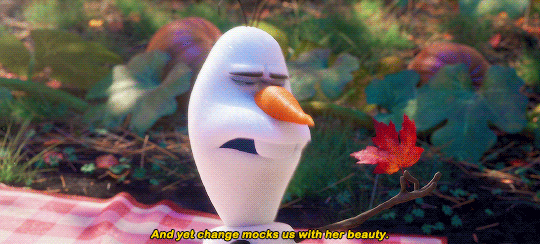
The first change is one of setting. The first movie took place in Arendelle and its surrounding forests and mountains. The sequel removes our heroes from these familiar areas. They move further north to a land called Northuldra.
Arendelle is a rather undefined place. Its unclear whether its a nation, a nation state, or the capital city within a nation. It’s not important. What is important is, Arendelle is set in a fictionalized version of Norway.
A Norwegian setting was chosen purely for aesthetic reasons in the first film. The sequel uses its real-world counterpart for a fuller narrative effect. Northuldra is an area in the taiga biome, sparsely populated, with only hearty flora and fauna surviving. Its sole human residents are foragers, lacking any permanent structures or colonies. The Northuldran people have a relatively small tribe (about 50 people), but a rich culture.
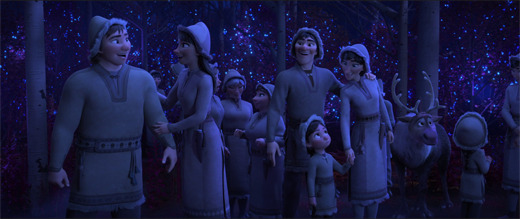
Northuldra is a stand-in for the Sápmi region and the resident Sámi people. Scandinavians and the Sámi live mostly detached lives to each other. Scandinavians prefer the southern portion of the peninsula for its arable farmland. The Sámi prefer the north, where great populations of reindeer live. This passive cohabitation has preserved the Sámi culture and lifestyle.
The plot of Frozen II uses this cultural relationship as fodder for its own plot. The Arendelle citizens represent Norway, while the Northuldrans represent the Sámi.
Acknowledging Disney’s poor history of depicting indigenous cultures onscreen, the Sámi insisted on a cultural ambassador opportunity. The filmmakers accepted, sending several representatives to Sápmi. They absorbed the culture, made diligent notes, and shared preliminary character models and story bits. This ensured what appeared onscreen was both respectable and accurate.
Also part of the contract, Disney would produce an officially dubbed version of Frozen II in the Sámi language. A genuine gesture of goodwill, and also a clever contract rider. An ignored international demographic now had a movie that would be uniquely theirs.
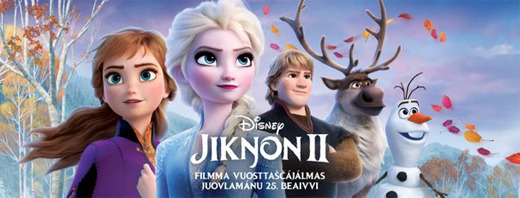
The Northuldran are depicted as an unknown culture to our heroes. They’re simple, but not primitive. They’re interesting, but not a sideshow. They’re seen as rustic and rural rather than uncivilized or savage.
There are many ways to read the differences between the two groups. Their clothing is one of the most interesting. Anna and Elsa wear dyed fabrics, embroidered with intricate designs. These outfits are clearly handmade and personalized for them. Even Kristoff, laden in fur and leather, is far departed from mere hunting and trapping. Rugged and durable, they’re manufactured all the same.
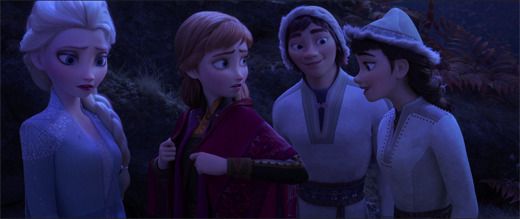
This contrasts against the Northuldran, all of whom wear a uniform, practical outfit. The prime focus of clothing is not of fashion, but functionality and unity. One type of outfit for one tribe with no extraneous details. If it rips, it can be mended. If it’s ruined, it can be replaced. If more are needed, more can be made.
But this uniformity is not depressing or stifling. In the simplicity, there is beauty. The dulled browns and grays emphasizes a tapestry-like focus to needlework. It’s admirable as a craft, not as couture. What’s more, the monotone appearance emboldens the scenery and the world around them. The people look clean, simple, and humble to emphasize instead the resplendent glory of their forest home. Again, the autumn setting working to the film’s advantage.

One of the most beautiful moments of the film isn’t visual, but musical. Upon Anna and Elsa learning their mother was Northuldran, the entire populace welcome their estranged sisters wholly into their ranks. They do so with a choral performance, strongly implied to be an honorable cultural tradition (Olaf steps on this tradition, but only for a second before the film cuts away).

Although Anna and Elsa are unfamiliar with it, we the audience recognize the song. This is the same choral chant that accompanied the title card of the first Frozen and the studio logos of the second.
But this isn’t a lazy bit of recycling. The filmmakers weren’t considering a canonical use when the number was first performed. They just needed something that sounded Norwegian and somewhat mystical to introduce the Frozen title card. They used a traditional folk song, and that was that.
In the sequel, the piece is given a new context, one inside the film world’s universe. This abstract orchestration has been given a definition and a purpose. It’s an amazing bit of retroactive connectivity that makes the world of Frozen and Frozen II seem like a cohesive, defined unit.
While the score and music are both grandiose accompaniments, nothing quite reaches the heights of its predecessor. The major problem is, Frozen II’s soundtrack is treated as a retread, not a continuation. Many of this film’s big numbers seem to mimic the first film, trying to replicate its success. “Some Things Never Change” is the follow-up to “For the First Time in Forever.” “When I am Older” is the partner of “In Summer.” “Reindeer are Better Than People” gets a reprisal before its spun into a much more bombastic original work.

Elsa gets two numbers, both hoping to copy the success of “Let It Go.” “Into the Unknown” and “Show Yourself” both demonstrate the range and power of Idina Menzel’s voice. Both demonstrate Elsa’s magical abilities front and center. Both hit emotional high notes, highlighting Elsa’s psyche and confidence. Both feature grand demonstrations of animation, letting fantasy visuals of snow and ice accompany the music.
“Show Yourself” goes one step beyond emulation. Just like “Let It Go,” Elsa once again constructs a palace out of ice. Once again she lets her hair down and manifests a glamorous gown. Once again the lyrics serve dual purpose, reflecting both Elsa’s current place in the narrative and her subconscious feelings. They may have been eager to replicate the success of “Let It Go”, but this is desperate.

Frozen II establishes its themes early, the same way a musical puts its auditory motifs into an overture. It introduces everything blatantly, even awkwardly, all sequentially in the beginning. It’s not until later, after the story develops and these themes return, do we see their significance. Until then, it just seems as though everyone is speaking in cryptic platitudes.
Anna and Elsa’s mother sings a lullaby whose origins and significance are a secret. Their father tells a bedtime story from his past which he describes in great detail except for the portion regarding himself. Repeated talk about the comfort of familiarity portends a tragic irony. Anna adopts the tenet of doing the next right thing despite the suggestion not being given to her specifically. Olaf insists water has memory completely unprovoked. The apparitions from “Into the Unknown” are literal displays of what’s about to come. There’s foreshadowing, there’s preludes, and there’s whatever’s going on here.
After this prelude to a means, the movie begins in earnest. Arendelle is besieged by strange natural phenomena. Darkness, droughts, strong winds and earthquakes befall the city, forcing an evacuation. Elsa recognizes this as an ultimatum. She’s not only being beckoned to travel north, she’s being forced.
This is our first insistence that Frozen II is departing from its predecessor. The tonal theme shifts wildly. Our fantasy adventure is turning into a tense, atmospheric drama.
Up north, our heroes are tasked with passing through a mist that has isolated Northuldra for years. Not an ordinary fog, this is a magical forcefield. Only Elsa has the ability to pass through, bringing her companions with her.
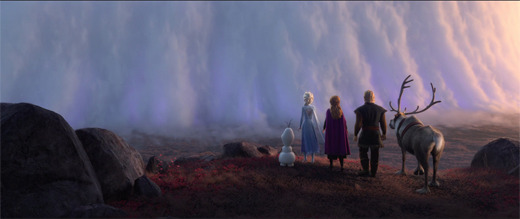
The impenetrable boundaries. The feeling of imprisonment. The unfamiliar environment. The lack of sky. The strange colors. The impossible wind patterns. The rising panic. The threat of separation. The sense that everyone’s being watched… Don’t let the bright colors and animated characters distract you from the situation at hand. For five whole minutes, Frozen II is coded like a horror movie. This is a film with a singing snowman, but it feels like something made by Alex Garland.
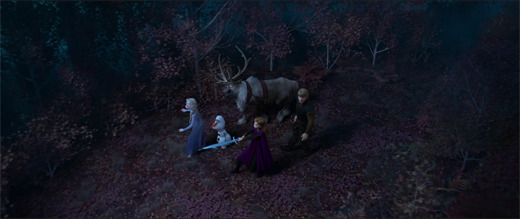
The first film was a personal journey, focusing heavily on Elsa’s character arc. It was an allegorical tale, broaching topics such as mental illness, identity issues, and suppressed trauma. Frozen II keeps its characters mostly static, though the threat of Elsa backsliding into her old ways is on everyone’s mind.
Instead, the focus is on the family history of Arendelle’s royal family. Before, Elsa and Anna’s parents were just parts of a tragic backstory. They were basically stock characters, and didn’t even have names.
Through carefully placed discoveries, revelations and flashbacks, we learn about the life and death of King Agnarr and Queen Iduna. They met the day Northuldra disappeared. They died searching for the same answers Anna and Elsa are now searching for themselves. They don’t know what caused Northuldra to disappear; they don’t understand the magic involved. They suspected the same magic was responsible for Elsa’s powers, and they wanted answers.
But once again, all this was decided after the fact. No one during the production of the original Frozen considered Agnarr and Iduna’s death to have a significant purpose. These new plot details were considered years later, while the old ones were manipulated in order to establish a timeline. As the movie plays out, it’s easy to forget they didn’t die trying to save Northuldra. They were trying to cure Elsa’s magic, still considered a tragic curse at the time of their deaths.
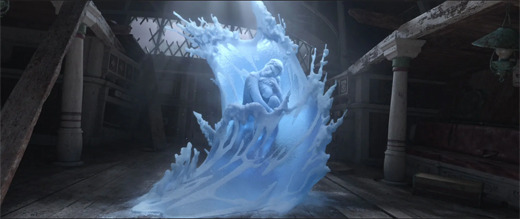
No one in 2013 thought about Elsa’s magical origins or what it meant. Elsa was magic, and that was enough. Frozen II tried to create a story out of nothingness, with nothing to go on. If they had, these facts could have been integrated better, following a better sense of logic.
Why is the Fire spirit an ordinary salamander sometimes when none of the other spirits have animal forms? Why does the Air spirit have no corporeal form at all beyond wind? Why are there several Earth spirits instead of just one? Elsa is the uniting spirit between Earth, Water, Fire and Air, so why does she have ice powers? Ice is a form of water. She should either have the ability to manipulate all four elements, or have a neutral unassociated fifth power.

It’s a Frankenstein sort of filmmaking, joining together different concepts with mismatched results. The film is full of logical inconsistencies and outrageous behavior. Actions don’t necessarily correspond to decisions made. Characters overreact or underreact to plot details.
Why? The troubled screenwriting process. The only concrete elements of the story were markers. The movie needed to hit those markers in a certain order at a certain rate. When the filmmakers couldn’t guide the film naturally to those markers, they forced it. Sometimes effects and causes were decided at two different iterations of the writing process, leaving them mismatched in the final film.
For example, Kristoff heads to a forest glen to ready a romantic proposal for Anna. He’s maybe five minutes away, but Anna considers this departure a form of abandonment and leaves camp without him. Elsa sees lumbering stone giants and turns her gaze towards them as they pass. Anna considers this evidence that Elsa is about ready to impudently storm off. Elsa has a theory that the wind spirits are guiding her to an island. Rather than explain it’s only accessible to her because of her ice magic, she blindsides Anna and Olaf, magically chucking them into the woods, nearly killing them in the process.

The lack of motivations are distracting, but worse is its heavy nature. The first movie was a fairy tale, this one is a tragedy. Many scenes are too stressful or too dramatic for their own good. Elsa and Anna learn about the untimely fate of their parents. They learn their grandfather was an abhorrent monster. They both face numerous threats of abandonment, injury, and death.
To compensate, humor is shoved into awkward places. Focus groups determined the movie was alienating children. Frozen II needed some softer moments. As such, we have many jokes and vignettes clearly added after the fact, not fully integrated with the plot.

Olaf delivers a one-man show, humorously recounting the plot of the first Frozen. Kristoff gets an absurd love ballad that’s straight from the days of hair metal. A Northuldran herder reveals he also uses ventriloquism to make his reindeer talk, just like Sven. Hans is mentioned surprisingly often, each time dismissed with flippant annoyance. Elsa bashfully regrets her affinity for showy drama, twice cringing when reminded of her “Let It Go" performance.
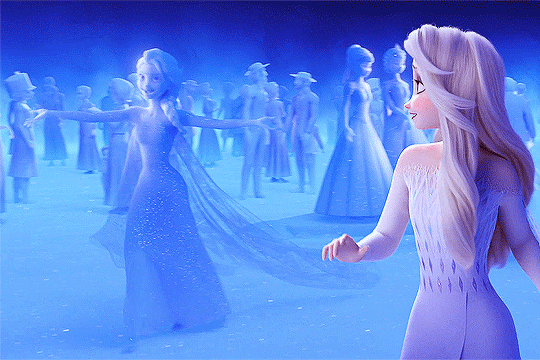
The original Frozen earned acclaim for making Elsa a complicated character. She was a metaphor, prompting a number of valid discussions. Frozen II tries to be bold with its morality as well, but doesn’t fully succeed in either its message or how its delivered.
Elsa and Anna discover that their grandfather, the former king of Arendelle, betrayed the Northuldran people. He built a giant dam for them under the guise of diplomacy. In reality, it weakened their natural resources. This exploitation forced their dependency on Arendelle. When confronted with these accusations, the king assassinated the Northuldran leader, sparking a war between the two civilizations.
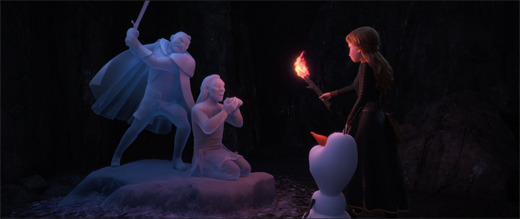
Elsa and Anna, separated during this discovery, each come to terms with a different half of the moral. Elsa’s half focuses on the effects of bigotry. Magic has been empowering for Elsa. It’s coded as a cultural trait, something connecting Elsa to her Northuldran heritage. Her grandfather despised Northuldra for the same reason. Magic is foreign, therefore strange, therefore must be eradicated.
For his intolerance, the king lost everything: his kingdom, his family’s respect, and ultimately his life. Meanwhile, Elsa is actively and emphatically non-racist. She not only excels as a head of state, but she’s powerful, glamorous, popular. Racism is bad, not being racist is good. It’s a very obvious moral, spelled out in no uncertain terms.

Anna’s half of the moral is more subtle, and delivered more effectively. Her portion focuses on racial privilege. Her grandfather’s misdeeds were heinous, but she had no knowledge of them until this point. She has, however, reaped its benefits every day of her life. Her royal title, her wealth, Arendelle’s prosperity, her loving parents, and her magical sister; everything she has comes from Arendelle gaining from Northuldra’s losses.
Anna’s exposure to tragedy, physical exhaustion, psychological trauma, and emotional pain all culminate here. The line of suffering ends with her, and she is taking drastic measures. Anna needs to make things right, even if it seems irrational or insane. She destroys the dam, even if it means flooding Arendelle.
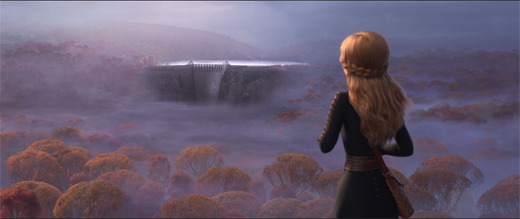
The prophecy called for King Agnarr and Queen Iduna having a child, but they had two. Each needed to prove themselves worthy, independent of the other. Elsa is the one blessed with magical powers, Anna is the one grounded in humanity. Elsa is the one who reunites the magic with Northuldra, while Anna is the one who saves their land. And she does so by destroying the accursed dam.
In the end, she’s justified. Deciding to flood Arendelle was a final test of character. For her actions, the magic forces who have been guiding Elsa intervene, sparing the kingdom, diverting the flood. Not even raising the harbor’s water level. Its unsatisfying knowing that this dramatic sacrifice doesn’t actually involve any sacrifice. The stakes were raised and then lowered without any significance. It’s superficial drama.
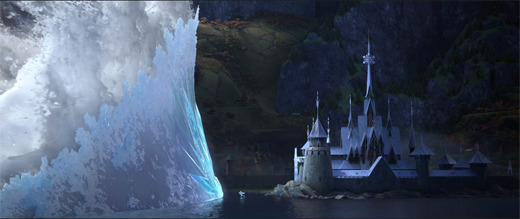
The greatest strength of Frozen II is its quality of animation. While the animation of Frozen was great in its own right, the sequel is in another class. Every single frame is filled with rich detail. The animators focused attention on every small detail. Even things the average viewer would never notice or consider. Wood grain in lumber. Stitching on clothing. Condensation on glass. Skin and hair texture.
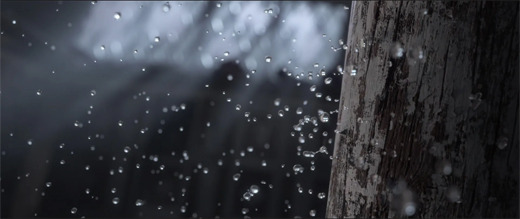
Elsa is still a cartoon character, but she’s a stunningly detailed cartoon character. You can see freckles, musculature, nailbeds, and individual eyebrow hairs. She spends much of the movie in a bodysuit that defies logic; there’s no collar, it just dissipates into nothingness around her collarbone. The fabric turns into adhesive sequins that turn into skin. And yet, all one can do is admire how each of those sequins are rendered with such careful attention.
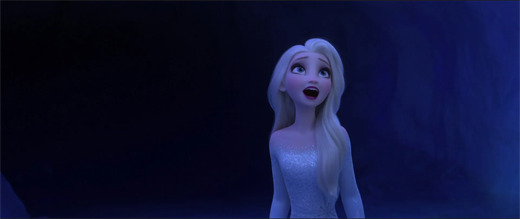
The film looks fantastic. To young audiences, those stellar sights can distract from the story which they’re almost guaranteed not to follow.
This is a film where two young lovers perform an act of love while their respective nations devolve into war. For their purity, they are spared from a mystical curse that secludes the warring participants and the land from the outside world. The progeny of the two innocents will be a legendary fifth element, with the ability to control and manipulate ice and snow. This gift will allow her to one day unite the elements, allowing her to learn the truth, and bring harmony to the warring people. In doing so, she must destroy a dam that’s affected the environment. It was deceptively built as an act of goodwill, but was deliberately detrimental, disenfranchising the populace, making them ripe for colonial exploitation. However, destroying the dam will doom her home empire sitting at the base of the river. All this prompts the moral quandaries of whether children are responsible for the transgressions of their forefathers, and whether an empire built on the oppression of others deserves its modern glory.

This is the only film in the Disney Canon that needs its own page on Sparknotes. And remember, this is after a series of rewrites from test screenings calling the film too complex. This is the simplified version.
The end result of Frozen II is a massive film whose failure is its ambition. It’s a complicated plot with too much fantasy lore among a huge familial backstory. Instead of characters defined by their adventure, the characters are already defined. So they’re further defined to excess, explaining every how, who, and why, forgetting the appeal of fantasy is that things don’t always need an answer. As satisfying as it is to learn the origins and purpose of Elsa’s ice powers, it also robs the character of her mystery.
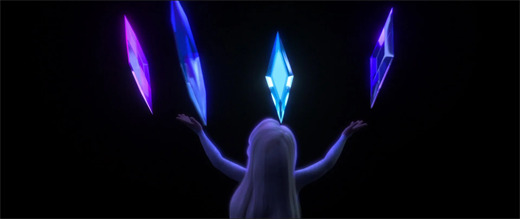
And that in essence was the major failings of Disney’s sequels in 2018 and 2019. They were making follow-ups to stories that didn’t need or anticipate follow ups. There was no story left to tell, so writers forced a story, and it feels forced. We get to revisit old characters we know and love, but what’s new is superficial and clashing. The experience is unrewarding.
While Frozen II did outgross Frozen on an equivalent budget (supplanting it as Disney Animation’s highest grossing film of all time), it killed the studio’s ambition for further sequels. Production was an ordeal, and the film was an overcomplicated mess held together with duct tape and wishes. Had this been a follow-up to any film besides Frozen, things could have been a disaster of Black Cauldron proportions.
To this end, Disney changed its approach to animated sequels. It didn’t matter what the beloved characters were doing, just as long as audiences got to revisit them. If the stakes were that low, there was no point creating a full-length screenplay. Short form content for Disney+ would suffice just the same. After all, Frozen II was made in the first place because the short Frozen Fever was a success.

Frozen II has its strengths, but it’s a confusing and overwhelming experience. Especially considering most of its audience was expecting something simple, or at least comfortable. The movie is overstuffed with ideas, most of which are underdeveloped or disjointed. By making a sequel to their most popular and profitable film, Disney was hoping lightning would strike twice. But in a franchise themed around snow, they should have been more concerned about avalanches.
Beauty and the Beast
Fantasia
The Lion King
Frozen
Snow White and the Seven Dwarfs
Cinderella
Alice in Wonderland
Sleeping Beauty
Mulan
Zootopia
Tangled
The Little Mermaid
Aladdin
Lilo & Stitch
The Many Adventures of Winnie the Pooh
Pinocchio
The Jungle Book
Robin Hood
The Sword in the Stone
Bambi
The Emperor’s New Groove
The Hunchback of Notre Dame
Moana
The Princess and the Frog
The Great Mouse Detective
Big Hero 6
101 Dalmatians
Bolt
The Three Caballeros
Lady and the Tramp
Frozen II
The Rescuers Down Under
Atlantis: The Lost Empire
Wreck-It Ralph
The Fox and the Hound
Fantasia 2000
Peter Pan
Dumbo
Hercules
Meet the Robinsons
Brother Bear
The Black Cauldron
Melody Time
Oliver & Company
Treasure Planet
Tarzan
The Rescuers
Pocahontas
Saludos Amigos
The Adventures of Ichabod and Mr. Toad
Winnie the Pooh
The Aristocats
Ralph Breaks the Internet
Dinosaur
Fun and Fancy Free
Make Mine Music
Home on the Range
Chicken Little
#Frozen ii#Frozen 2#Disney#walt disney#Walt Disney Animation Studios#disney studios#Disney Canon#film analysis#movie review#Film Criticism
61 notes
·
View notes
Text
Ralph Breaks the Internet at 35
A review by Adam D. Jaspering
With the launch of Disney+ in 2019, the streaming wars began. Disney+ was the first significant streaming service launched by a media corporation. No longer third-party services, streaming sites were now another arm of entertainment conglomerates. Intellectual property became exclusive, restricted to singular services, aligned by corporate interests. Companies wanted consumers to choose their allegiances.

Technology is a mold that shapes entertainment. On the internet, the idea of movies and television being two discrete, independent formats was ending. They were no longer separate markets. Nor were there miniseries, short films, specials, or limited engagements. All were indistinguishable from new media creations like web series, vlogs, and streams. There is now only the vague identity known as content.
“Content” is the catch-all term for visual media tossed into a bucket and churned into an indistinguishable, easily-digestible slurry. Content doesn’t require attention or affection. It only cares about the clicks. The clicks mean engagement. Engagement means ad revenue. Ad revenue means money. Money means more content.
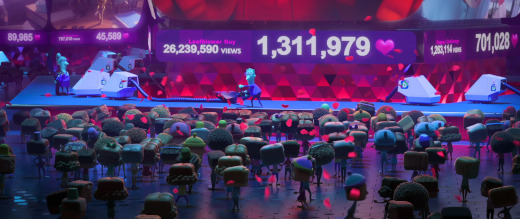
With so little time and so much to consume, the media landscape of the 2010s devolved into a series of reboots, rehashes and sequels. Why risk ruining your day with a movie you may not like? By watching something you’re familiar with, your odds of enjoyment increase dramatically.
While many people bemoan the intellectual and creative wasteland such a myopic, bankrupt, incurious approach has created, the numbers speak for themselves. People want what they’ve seen. People are scared by new ideas. People like their content recognizable and accessible.
Even entertainment titans like Disney Animation knew and respected this state of affairs. Which is why they produced two sequels in 2018 and 2019: Ralph Breaks the Internet, and Frozen 2.
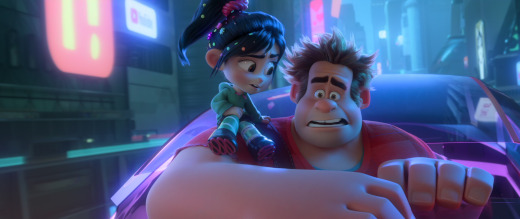
The decision to make a sequel to Frozen should be obvious. It was Disney’s most lucrative film ever, both in terms of box office gross and merchandising. But of all films, why make a sequel to Wreck-It Ralph? Disney had made only a handful of CGI animated films in the 2010s, but all were popular and successful. Any of them could support a conceivable follow-up.
My prevailing assumption? Frozen 2 was a film largely targeting a female audience. Disney wanted a counterpart for the boys. This eliminated Tangled and Moana. Zootopia was still too fresh to revisit, and Big Hero 6 was already being adapted for an animated series on Disney Channel. That left Wreck-It Ralph the last remaining choice. Disney didn’t want to make a sequel to Wreck-It Ralph, they were stuck making a sequel to Wreck-It Ralph. A foreboding sign of things to come.
Ralph Breaks the Internet takes place six years after its predecessor. When the steering wheel to Vanellope’s arcade cabinet breaks, she and Ralph must find a replacement. They venture forth to an unknown realm: The internet. This strange new world prompts wildly different reactions from Ralph and Vanellope. What was supposed to be a simple fetch quest may change their lives forever.

Despite my less than enthusiastic opinion of Wreck-It Ralph, the idea of a sequel had merit. My biggest critique of the first film was the lack of exploration and the abundance of missed opportunities. The filmmakers built a giant world, and they focused on a comically small portion.
In a sequel, Disney could rectify this. Characters, relations and settings have been established. There’s no need for exposition; we can start immediately on the plot. The entire arcade is now at Ralph’s disposal. He’s free to visit new video games, having new observations on the evolution of gaming culture and technology.
Ralph Breaks the Internet doesn’t do that. The film doesn’t explore the world of video games further. It has very little to do with video games. It outright abandons its established motifs and locations. It has no use for its predecessor’s motifs and themes. It has no use for its established locations. It can’t even find use for all its characters. Felix and Calhoun are reduced to glorified cameos.

With order maintained in the arcade, Ralph Breaks the Internet needs a brand new conflict. In order for that to happen, it needs its characters to be in strife. Ralph is still fulfilled with his newfound happiness. Vanellope is not. She once wanted nothing more than to be a go-kart racer. She achieved that, becoming the central character in her game. But that pleasure is gone. What used to be her greatest desire has become her daily grind. What was once a dream was now a monotonous, unchallenging routine.
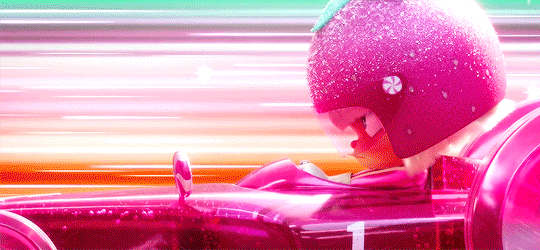
Worse still, her cabinet has fallen on hard times. Sugar Rush was once one of the most popular games in the arcade. Since the previous film, it has been downgraded from a two-player game to single player. By Mr Litwack’s own admission, it doesn’t even earn $200 a year. An unfulfilling life is bad enough, but an unappreciated life is even worse.
Why move two video game characters to the world wide web? It may have originally been intended to comment on the changing state of video games. Online gaming has been a forefront of the medium since World of Warcraft became a million dollar franchise in 2004.
Since then, split screen and arcade gaming have greatly diminished. With the rise of the internet and the depressing state of Litwak’s Family Fun Center, we have the makings of a stellar concept. Two characters are staring down their impending obsolescence. It’s not just one game in peril, but their entire universe.
Online gaming is depicted, although only one example, mostly drowned by the rest of the film. There’s almost no real revelatory commentary. Instead, the movie focuses on digital trends, tech corporations, and e-commerce. Disney presents the internet as a universe of knowledge, exploration, and convenience. And all these opportunities are courtesy of billionaire sponsors.
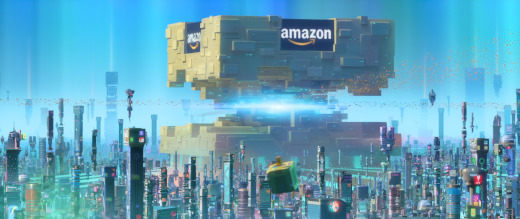
The internet in Ralph Breaks the Internet is presented as an urban landscape. Every website is a skyscraper or complex. The bigger the website, the larger the building. And more pertinent, the bigger the building, the larger and more prominent the company logo.
Ralph Breaks the Internet isn’t just a film, it’s a 99 minute assault of brands. The movie is crammed full of advertisements, product placement, and marketing synergy. It’s omnipresent. Wreck-It Ralph had its share of Nintendo and Atari iconography, but wasn’t actively selling video games or platforms. Here, prominent logos and trademarks fill the background and foreground alike.
The maddening part is, all this free publicity is granted with no rhyme or reason. Allegedly, Disney received no money for any of this product placement. Disney wasn’t influenced by or restricted by any company. These ads were a voluntary inclusion. They wanted their audience to see every single one. And without a touch of self-awareness, the movie also features a character who demonstrates that a barrage of advertisements are annoying.

Why would Disney go full throttle on such an ignoble feature? Were they being thorough, showing the full scope of the internet’s offerings? Or perhaps it was a demonstration of Disney’s neutrality toward the tech industry. Disney didn’t need alliances with tech gurus. They were unaffiliated, and regarded them all with equal indifference.
That said, notice the deliberate absence of all streaming sites and Disney’s failed Go Network.
Still, there was no sense in making enemies. With the exception of eBay, all licensed brand names are kept in the background. They’re advertisements, but set decoration. When it comes time to impact the plot, the movie uses generic equivalents.
There’s a giant skyscraper with the Google logo, but all search queries are given to the invented “Mr. Knowsmore.” YouTube exists in this universe, but the movie focuses on the strikingly similar “BuzzzTube.” The movie tries to demonstrate the length and breadth of the internet, but doesn’t want to use any of it. It’s all there, but always out of reach. Which reinvigorates the question of why bother in the first place?
We have our established setting, a fictionalized interpretation of a real-world concept. We also have our established characters, leftover from a previous movie. It’s a mix of two pre-existing entities. The movie needs to justify why these characters are in this place. And the reason needs to be more than just sightseeing.

When the steering wheel of Sugar Rush breaks, Ralph and Vanellope follow a rumor that a replacement part is being sold on eBay. A rare replacement, as the company who produces Sugar Rush is out of business. There’s only one on offer, implying its presence is a rarity and not likely to resurface in the immediate future. The plot of the movie is not finding a steering wheel, it’s acquiring this specific steering wheel.
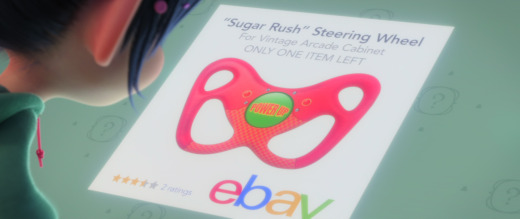
In the dwindling moments of the auction, Ralph and Vanellope absolutely must buy it now. Such a feature is provided by eBay, literally named “Buy It Now.” This feature is ignored, otherwise the movie won’t have a point.
The movie also ignores that eBay doesn’t allow bids from patrons that don’t have a registered account. Otherwise, parties could inflate prices at auction without any intent to buy. Which is exactly what Ralph and Vanellope unknowingly do. Otherwise the movie won’t have a point.
Ralph and Vanellope aren’t exactly scholars, but their actions here are pretty questionable. Unfamiliar with the concept of an auction, they assume it’s a game of whoever can name the highest number. Which begs the question of how their thought processes work, but also why they stop at 27,001 of all numbers.

The steering wheel, already considered unobtainably expensive at $200, now costs $27001. What does this achieve (aside from blowing the mind of a fortuitous seller of reclaimed arcade cabinet hardware with a whopping 13400% profit)? The movie has finally found a justification for its existence by pulling a plot out of nowhere.
It’s not that the plot is one born through the characters’ stupidity. There is an unfortunate (and somewhat contrived) moment where stakes are raised through idiocy. But that’s fine for a comedy. The issue is, the movie shuffles along aimlessly, searching for its plot. They needed a reason for the characters to go to the internet. Once there, there needed to be a reason to remain within the internet for the film’s duration.
The film had its intentions first, but not any organic way to achieve it. So the characters and story move in a clunky procession. Our characters get shoved incrementally towards the desired goal. There’s a minor problem, then another minor problem, then another minor problem. Then at the half hour mark we finally have recognizable stakes: How are Vanellope and Ralph supposed to find 27 grand? It’s ironic a plot concerning a fast way to raise money exists within a movie brimming with complimentary product placement.

Our heroes eventually stumble upon the world of viral videos. A video surfaces of Ralph saying his catchphrase while an air compressor blows in his face. The video becomes a shareable gem, and Ralph becomes a memetic sensation. Halfway because of the video’s absurdity, halfway because of the nostalgic appeal of an 80s video game character.
Not YouTube, Ralph becomes a star on the similar BuzzzTube. The way BuzzzTube works, visitors can leave “Hearts” on videos they enjoy. More than standard likes and favorites, these hearts equate to real-world currency. It’s not explained how this makes any sort of financial sense. Nor is it explained how Wreck-It Ralph, a sentient video game character, can earn money. It’s also not explained why the real-world copyright holders don’t issue a copyright strike for use of the Wreck-It Ralph trademarks. We’re assured this makes sense in the world of the film.
Realizing the potential, Ralph sets out to exploit his nostalgic appeal. He makes a series of videos. Wreck-It Ralph in a cooking tutorial. Wreck-It Ralph in an unboxing video. Wreck-It Ralph dancing. Wreck-It Ralph reaction vids. And so on.

In less than eight hours, this Ralphposting onslaught allows our hero to fully afford the coveted steering wheel. Even to those who have never attempted to earn an income from online platforms, this should seem ludicrous. The movie insists it’s possible for content creators to earn $30,000 in a single day. An astronomical achievement, especially from low-effort productions such as make-up tutorials and hot pepper challenges.
For a movie that’s trying to celebrate the internet, it’s massively misrepresenting the user experience. Even within the ill-defined rules of BuzzzTube, it doesn’t make sense. The initial air compressor video earned only $43 before being assured it would produce no further dividends. If every video performed equally well, Ralph would have had to make 700 videos in 8 hours. That’s one video every fifteen seconds.

Just as Disney had to create an entirely stupid scenario for a plot to form, it relies on an equally stupid scenario for the plot to proceed. There’s no effort and no logic. Ralph needed money. Ralph gets money. Ralph is inherently good at driving engagement. He becomes the most successful viral video star of all time, just because.
While Ralph is busy pursuing finances, Vanellope sets out to advertise the videos. She’s sent to a place where her youthful exuberance, her childish appearance, and her royal title will be seen as assets. She’s sent to a Disney fansite.
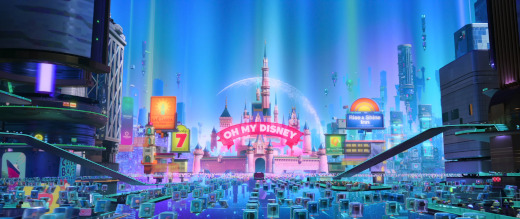
While the movie has had its fair share of problems thus far, Ralph Breaks the Internet reaches a new level of audacity. The movie pauses its narrative to laud its parent company’s accomplishments. Vanellope meets fans of Disney. She’s sees glorious displays of Disney. She sees reverential depictions of Disney. The Oh My Disney fansite isn’t a mere amusement park, it’s a pilgrimage site.

This goes way beyond a 4th wall joke. There is no joke. Disney is making a film about how wonderful Disney is. Not just boasting, but broadcasting these boasts directly to an audience that was already actively consuming their product. The film is either incurably conceited or lacks any sense of self-awareness. I am Ozyman-Disney. King of Content. Look upon my intellectual property, and despair.
This leads us to the most famous scene in the film. The scene that was featured prominently in all trailers and marketing. After a whirlwind introduction to Oh My Disney, Vanellope finds herself backstage. She accidentally stumbles upon a large dressing room, housing the Disney princesses. Or more accurately, the 14 most profitable princesses. Maybe there’s a cramped broom closet nearby housing Eilonwy, Kida and Marian.

The Disney Princess product line is a piece of iconography for Disney Animation. While some media has been produced featuring these characters as a group, it’s insubstantial. It exists purely to push toys and accessories. Here, they fully interact as actual characters, part of the same universe, for better or for worse.
Let’s begin with the good points. First, it’s fun seeing Disney flex on their own bad habits. There’s a gauntlet of dialogue delivered with a cocked eyebrow. About how princess stories default to archetypical characterization. How childish fairy tales seem morbid when circumstances are taken out of context. How, despite varying characters, environments and purposes, these stories retread a lot of ground.
Second, it’s also fun to see characters who are sold on their polite demeanors and elegant appearance acting counter to that. They’re no longer dead-eyed mannequins shoved into ballgowns. They seem more approachable, flawed, and human. They literally get to let their hair down.
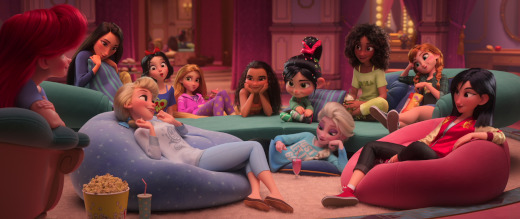
But Disney took the idea and ran way too far with it. The princesses are practically unrecognizable beyond their physical appearance. They look like their canon counterparts, but act like parody versions. They’re too coy. They’re too self-referential. There’s none of the nuance or personality that made these figures popular in the first place.

With 14 characters fighting for screen time, a lot of dialogue gets bandied around. Most of it superfluous or redundant. Every character needs to say something, and no one can say more than the others. Vanellope starts talking to Jasmine, turns to listen to Tiana, and ends up talking with Rapunzel.
This parity-focused style of speaking ruins the jokes. Some bits are overexplained, while some are just phrased poorly. Punchlines get split up and shared, ruining the comedic timing. In all, there’s a reason princess films have separate comic relief characters to handle the humor.
Worse still, the subtle variations in art styles have all been homogenized into one uniform look. They all appear with larger heads and big eyes. They were always animated, but the Wreck-It Ralph art style makes them look more cartoony than their original dignified designs. That was likely the point. It’s all about making them look like dolls from the same toy line, because that was the end goal all along.

Merida, the lone Pixar character, receives the worst treatment. Yes, Disney Animation Studios and Pixar Studios are both owned by The Walt Disney Corporation. But just because the same company owns two animated film divisions, using similar technology to produce similar products, there’s not necessarily a confluence in design. Pixar’s exaggerated art style doesn’t fully adapt in the hand of Disney animators. Merida’s round head and lack of a distinct jawline leaves her looking particularly alien.
For a four minute scene (with a 90 second callback at the film’s end), there’s lots to unpack. How did such an idea even come around? If I had to guess, Disney was using Ralph Breaks the Internet as a sort of backdoor pilot.
These 14 princesses have earned Disney a generous profit. So much so, Disney was definitely eager to invest more money. They wanted to turn the merchandising line into its own legitimate franchise. There were only two hurdles preventing them. Would audiences be receptive to the idea, and would a film starring these characters work?
If Ralph Breaks the Internet was a test run, it was a success. Audiences were wildly receptive to the idea. Even critics of the film as a whole seemed to enjoy this specific portion. The proof was conclusive, but nothing’s come of it. Disney has greenlit many projects in the years since Ralph Breaks the Internet’s release, none of them set in the Princessverse.

Maybe that’s for the best. The princess scene is a gauntlet of surface-level jokes and half-hearted satire. It doesn’t have anything insightful to say on the genre or the characters. It does advance the story of Ralph Breaks the Internet, but in a very roundabout way. It’s real purpose is fanservice and brand recognition. It delivers its immodest congratulations with such a rapid-fire pace, it barely remembers what its trying to do or why. There’s a stinger chord and scene transition parodying the 1960s Batman series. Among the panoply of intellectual properties Disney just finished bragging about, they reference an unconnected TV show they don’t even own.
We spend six minutes dedicated to movies before Ralph Breaks the Internet, the movie about video game characters, resumes its focus on the internet. Since coming online, Vanellope has developed an obsession with a game called Slaughter Race. The movie does a bad job explaining what exactly Slaughter Race is. It’s part racing, part MMORPG, and part sandbox. The game’s premise is kept nebulous and open-ended. It’s whatever the writers need it to be to accommodate the story.

The concept of violent video games was already explored in Wreck-It Ralph. Not much more is added to the discussion here. The same beats are hit: cartoon characters from all-ages entertainment are thrust into a world of violence and mayhem. It’s supposed to be a stark juxtaposition. And just like last time, the juxtaposition doesn’t really work because Disney can’t actually depict violence and mayhem.
It’s an unintended joke watching Disney trying to depict an M-Rated shoot-em-up and its associated culture. Whatever is shown onscreen, it amounts to nothing. The carnage depicted is mostly cars driving recklessly. The violence is nonsensical and cartoony. The only weapon present is a flamethrower, and the only time its fired onscreen is for pyrotechnic spectacle. Among the graphic content is sharks popping out of manholes and clowns talking in a menacing timbre. It’s all too silly to be representative.

Even the players themselves are literal children. The two real-world players we see are no older than 14 years old, talking trash and acting tough behind their grown-up avatars. A staggeringly on-the-nose depiction of the genre’s key demographic.
But still, being Disney, all the rage and vitriol and unbridled hatred of these players never culminates to more than the epithet “Gosh dang it.” The best joke isn’t anything they’re saying but the enfeebled way they’re saying it.
The movie uses a song to emphasize their intended point, but it fails in the same manner. “A Place Called Slaughter Race” is supposed to be an ironic contrast between upbeat and spritely music of Alan Menken against the seedy, deplorable subject matter. But Slaughter Race is already a ridiculous land. It’s decrepit and grotesque, but its severity is undercut well before the music ever starts. It’s the same joke as “I’ve Got a Dream” from Tangled, but done worse.
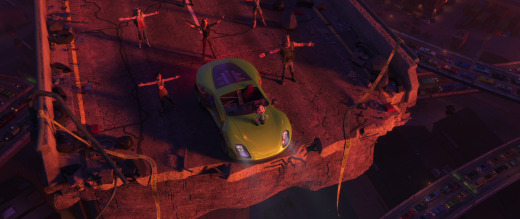
The clash between accuracy and appropriateness is further demonstrated when Ralph finds the BuzzzTube comments section. There, he finds a series of trollish insults, criticizing him and his videos. They’re deliberate insults, but the softest, most gentle insults possible. They’re still treated as devastating. There’s no point in doing a satire when you can’t even approach the subject matter.

Even worse is the film’s exploration of the Dark Web. Why Disney decided to feature such a horribly infamous element of modern life into their children’s film is anybody’s guess. If anything, they introduced more children to its existence rather than caution against it. I can rightfully imagine naïve Google searches for “Darknet” spiked as a result of the film.
Choosing to acknowledge the Dark Web was bad. Choosing to comment on it so irresponsibly was even worse. This is a network supported by criminals operating beyond the eyes of ISP and internet watchdogs. The Dark Web is where things like drug sales and human trafficking occur. Disney treats it as a place where you can get mods to grief other players in video games.

There is a plot to this movie, not truly explored until the last half hour. It’s so far been buried underneath the fanservice, conspicuous consumption, and botched morals. Vanellope has been overwhelmed with ennui and futility. Her life has become unfulfilling and monotonous. Her one outlet is Ralph, but he’s been unreceptive. He’s had his happily ever after, and is indifferent to Vanellope’s needs to the point of neglect. Vanellope’s time on the internet has awoken something inside her. She’s ready to move on to new opportunities, but Ralph wants her to stay.
This could be a powerful message, despite the slapdash delivery. Friendships require growth and maintenance, lest they atrophy into codependency. When those problems emerge, honest communication turns into resentment and recrimination.
Ralph and Vanellope want to remain friends, but their incompatible goals have driven a wedge into their relationship. It’s made even worse that neither are mature enough to work towards a solution. This would be the perfect framework for a powerful character arc. Especially in a sequel. In the first movie, we see the development of a friendship. In the second, we see the degradation.

But this franchise is a terrible choice to feature such a moral. Wreck-It Ralph very explicitly laid out the rules of its arcade world. Abandoning your game and inserting yourself somewhere else was a monumental transgression. It was so recognized, they even had a name for it: “Going Turbo.” But Vanellope is celebrated for doing exactly that.
Disney coded their themes into their worldbuilding. Such a strategy only works if you remain consistent on that theme. Wreck-It Ralph preached the moral of being happy where you are. Ralph Breaks the Internet inverts it, claiming one should pursue happiness wherever it may be. This shift makes the world seem arbitrary and nonfunctional.

Even if it wasn’t breaking with canon, the moral is delivered poorly. Vanellope falls in love with the very first game she sees outside of the arcade. After one visit, she resolves to spend the remainder of her days there. It makes her seem impulsive rather than passionate.
One of the most common critiques of Disney heroines is their lack of agency. They have one goal, one desire, and one destiny. Typically, it’s a princess becoming enamored with a prince. Vanellope falls for a new video game. She is a princess, after all.
Ralph Breaks the Internet is a sloppy film. Plot, character, themes and purpose are all struggling to reach coherency. But even the small details show the lack of care from the filmmakers.
For example, Mr. Litwak’s first name has been arbitrarily changed from ‘Stan’ to ‘Del’ between films. It’s mentioned that a Space Invaders cabinet was unplugged in the arcade some time ago. Then in a later scene, it’s shown that Space Invaders is still present in the arcade. Ralph comments how strange it is there are no sunsets while he’s on the internet. He says this after a twenty minute sequence that took place after dark.
But the main problem of the film is how fundamentally unnecessary it is. A movie in the year 2018 is trying to sell “The Internet” as a concept. Nobody needed the internet sold to them. Children in 2018 have never known a world without the internet. People had devices in their pockets which could access the internet at any moment. Its very likely people were on the internet while watching the film in theaters (much to the dismay of theater ushers).

The film feels like a feature-length adaptation of an outdated presentation from Epcot. As though it was originally an 18-minute video from 1994 about communication technology. The kind of exhibit where the film isn’t the main draw, but the opportunity to sit down in an air conditioned room.
And in that regard, we see the nervous undercurrent plaguing the film. Film and other mass media are part of an old wave, being threatened by a brand new realm of entertainment. Disney was concerned their massive and lucrative media empire was being threatened. No longer the gold standard of entertainment, they were just another form of content.
Hundreds of potential startups and millions of content creators were threatening the Disney empire. There were fewer than 10 major American film studios in 2018. Disney could compete with that. In 2018, 576,000 hours of video were uploaded to YouTube every day, all of which could be viewed for free. Disney had no idea how to compete with that.

Disney’s only advantages were their back catalog, their licenses, and their quality-over-quantity approach to filmmaking (apply whatever asterisk you wish). Ralph Breaks the Internet was a deliberate depiction of the toxic, disposable, plastic nature of the internet. Memes and trends will be outdated in hours. But films will last forever.
Instead, Ralph Breaks the Internet is destined to age poorly. It has very little to say, says it poorly, and hides the futility underneath gimmicks and cameos. It may not be the worst movie in the Disney catalogue, but it’s the most pointless. It’s a petulant potshot at a changing world. It’s a fearful confession that all entertainment giants, even ones as big as Disney, had little control of their audiences. Ralph broke the internet, but the internet was breaking Disney.
Beauty and the Beast
Fantasia
The Lion King
Frozen
Snow White and the Seven Dwarfs
Cinderella
Alice in Wonderland
Sleeping Beauty
Mulan
Zootopia
Tangled
The Little Mermaid
Aladdin
Lilo & Stitch
The Many Adventures of Winnie the Pooh
Pinocchio
The Jungle Book
Robin Hood
The Sword in the Stone
Bambi
The Emperor’s New Groove
The Hunchback of Notre Dame
Moana
The Princess and the Frog
The Great Mouse Detective
Big Hero 6
101 Dalmatians
Bolt
The Three Caballeros
Lady and the Tramp
The Rescuers Down Under
Atlantis: The Lost Empire
Wreck-It Ralph
The Fox and the Hound
Fantasia 2000
Peter Pan
Dumbo
Hercules
Meet the Robinsons
Brother Bear
The Black Cauldron
Melody Time
Oliver & Company
Treasure Planet
Tarzan
The Rescuers
Pocahontas
Saludos Amigos
The Adventures of Ichabod and Mr. Toad
Winnie the Pooh
The Aristocats
Ralph Breaks the Internet
Dinosaur
Fun and Fancy Free
Make Mine Music
Home on the Range
Chicken Little
#Ralph Breaks the Internet#Disney#walt disney#Walt Disney Animation Studios#disney studios#Disney Canon#movie review#Film Criticism#film analysis
1 note
·
View note
Text
Moana at 35
A review by Adam D. Jaspering
On August 6, 2015, Hamilton debuted on Broadway. The musical is a dramatized biography of American founding father, Alexander Hamilton. While the subject matter and presentation was unorthodox, the play was a massive success.
The show is still performing on Broadway, and has an additional performance in New York’s West End. There are also several touring companies performing the show across America, plus multiple international presentations. A filmed performance of the original Broadway cast debuted on Disney+ in 2020.

Hamilton won 11 Tony Awards. Its soundtrack was the 2nd highest selling album of 2015. This album also won a Grammy. Hamilton currently holds the record for the highest single-week gross of a Broadway production ($3.3 million for eight shows). It is inarguably one of the most successful productions in Broadway history. The reason for its success is the star, writer and composer, Lin-Manuel Miranda.
In the spring of 2015, while Hamilton was being workshopped, Disney contacted Miranda. They hired the up-and-coming songwriter to help compose and perform music for their upcoming animated musical, Moana.

When Moana was released in November, 2016, Hamilton was at its peak of cultural dominance. Miranda's involvement was an incredible act of perfect timing and good luck. Nothing would better represent the film than the involvement of Lin-Manuel Miranda.
Moana is a musical adventure steeped in Polynesian myth and folklore. It centers around the titular heroine, Moana, heir to the throne of her island nation. Once a society of nomadic explorers, her people have become settled and content. Their legends and heritage have been reduced to incredulous myths. But when famine and ruination plague Moana’s home, the ancient stories of angered gods and vengeful spirits become fact once again. To save her people, Moana must rediscover her people’s lost history, brave the vast ocean, and make things right.
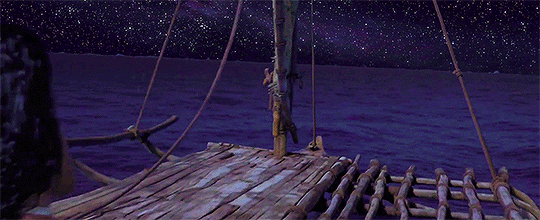
The music of Miranda is prevalent through the film. Miranda contributed seven songs to the film, adding a thundering musical passion. They range from the whimsical “You’re Welcome” to the delicate “Know Who You Are” to the aspirational “How Far I’ll Go.” The latter of which earned Miranda an Oscar Nomination.
The downside is, Miranda’s experience on Broadway causes a few road bumps as he transitions to film. His theatrical songwriting technique has a very recognizable style. Every song has a specific pacing, building up to thundering crescendos, then stopping. As if there’s supposed to be a moment of pause upon completion for the audience to applaud.

There are also moments where the line between dialogue and vocalization is very thin. In a stage musical, characters are in a constant state of performance, often switching between speaking and singing. Songs can pause, resume, and reprise at any moment. A character can add a tonal inflection to spoken dialogue as a buildup to a musical performance. Likewise, arrhythmic speech mid-song punctuates the significance of the words.
Certain films can copy this style, adopting an operatic approach to its music. But Moana, despite being a musical, focuses its attention on spoken dialogue first. The gentle invocation method in "Song of the Ancestors" and "Know Who You Are" doesn't mesh with the rest of the film or soundtrack. Instead of being an interplay of music and speech, these two feel like musical numbers that have difficulty starting. Like a sputtering engine that needs to be primed.

These are small, subjective detractions. There's only one major fault of Miranda’s involvement: his fame. The film wasn't sold as a Lin-Manuel Miranda film, but he received a dominating amount of attention for his contributions. His involvement overshadows the film’s composer, Mark Mancina, and Tuvaluan musicians, Olivia and Opetaia Foa’i.

When attention is given elsewhere, it goes to Moana's voice actress, Auli'i Cravalho. The 15 year-old actress made her professional debut in Moana. She was lauded for her effortless talent and tremendous vocal ability. Still, Lin-Manuel Miranda was the primary focus through the press cycle.
The issue is not whether Miranda deserves applause for his work. The issue is whether he organically deserved the full total of his acclaim. Did the soundtrack succeed because he was an excellent songwriter, or was it because he was already a popular celebrity? Either way, it became Miranda’s soundtrack, for better or worse.
As impressive as the music to Moana is, there’s loads more to the film that requires analysis. The most impressive of which, in terms of spectacle and abundance, are the water effects.
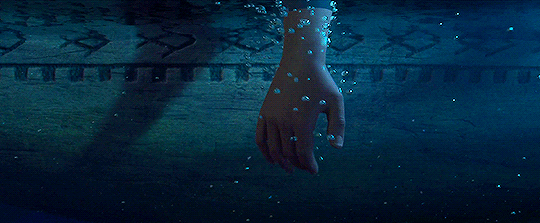
Disney has animated water before, even in CGI. The animation staff knew the process. Water has certain characteristics and behaves a certain way when still and when in motion. Animators knew these dynamics, and used imaging software to replicate them.
Until now, animators only had to animate water in moderate quantities. Moana's extensive use of water effects maxed out their hardware capabilities. So much so, Disney was forced to develop their own in-house simulation engine.
"Splash" was designed and developed exclusively to animate water. The effort was well worth it. The waves, wakes, ripples, crests, bubbles, splashes, tides and breakers of Moana look absolutely beautiful. The color looks perfect. The transparency looks perfect. Most importantly, the physics look perfect. After all, when you're animating water, you want it to look fluid.
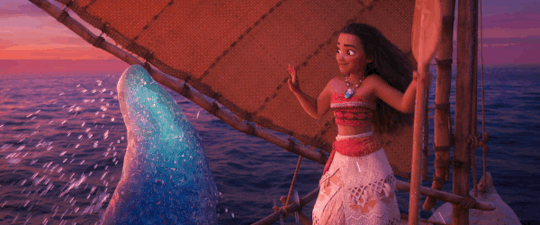
Moana is a seafaring adventure. It would be very easy to make the film feel monotonous and repetitive. The landscape doesn't change. The ocean stretches for miles in every direction.
For large swaths of the movie, backgrounds simply don't exist. There’s ocean and sky in every direction. We have only our characters, their canoe, and the sea. It's the interplay between the foreground elements that distracts us from the void. The repetitive sameness exists throughout the film, but it never feels like it. It’s there, constantly. It's the greatest curse of animation: If something looks wrong, everyone can tell immediately. If something looks right, the audience won't notice at all.

This does undercut the epicness of our epic. Without any frame of reference, it’s hard to understand the scale of Moana. There are no landmarks to punctuate the journey. There’s no sense of a changing landscape or environment. There’s no change in weather or climate to demonstrate time spent traveling or distance traversed. The ocean from the beginning of the film looks like the ocean from the end of the film. Moana could be fifty miles or five-thousand miles from home.
The magic MacGuffin in this movie is ‘The Heart of Te Fiti.’ Te Fiti was a god of creation whose power is contained within a stone. A thousand years ago, this stone was stolen and swiftly lost by the trickster demigod, Maui. The stone itself has no apparent or demonstrative magical abilities. It simply provides stasis. A thousand years later, its absence has doomed Moana's world.

Moana is a trademarked Disney Princess. Her father is a chief, she’s heir to the throne, and she has monarchical power over the lands and people of Motunui. Her title may not officially be princess, and she may resent the association, but she is a Disney Princess. The movie recognizes this dissonance with a clever metatextual commentary. According to Maui, "if you wear a dress and have an animal sidekick, you are a princess."

With this offhand joke, the Disney Princess brand has officially reached postmodern status. Things get worst in the next Disney film, but we'll explore that in the following article.
What sets Moana apart from her fellow Disney Princess kin is her call to action. In the film’s prologue, we get the standard fare of Moana dreaming of a life beyond her home. She thirsts for adventure, mostly out of curiosity’s sake.
The typical “I Want” song is there. It alerts the audience that our heroine wants to break from her stasis. She is broadcasting her desires. Moana wants to see what’s beyond her island home. Unlike other heroines, the issue isn’t that she can’t, but Moana won’t. Moana electively decides to remain at home. She's kept behind by accountability.

Moana respects and acknowledges her royal obligations. Her people and her island need a leader. Her father is that leader today, she will be that leader tomorrow. She’s good at decision making and delegation. She’s respected for her capabilities and wisdom. She takes the job with pride.
Her desires to sail across the ocean never disappear entirely. This isn't the point. Her desires stay, she acknowledges them, but she views them as a burdensome fantasy leftover from childhood. Her exact words concerning them are, “What is wrong with me?” Moana suppresses these desires for the good of Motunui. She’s either happy enough on her island home, or she’s convinced herself she’s happy enough.
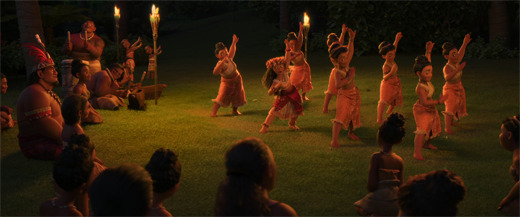
The first two steps of the classic Hero's Journey are the call to action, and a refusal to the call. The hero must be presented with an opportunity for adventure. That hero must also have a fear, a sense of inadequacy, or an excuse to initially forego the opportunity.
In Moana’s case, the order is reversed. With the exception of some strong foreshadowing, there has been no call to action for Moana to refuse. She’s not given any chance or incentive to leave the island beforehand. She personally rejects her desire to leave the island without given a reason. Once she’s given a reason, she begins pursuing the desire. This inversion doesn’t break the story, but it does make for an interesting baseline.
Compare Moana with The Little Mermaid (and not just because both films coincidentally center around the ocean). The two films' heroines have strong parallels in their journeys.
In The Little Mermaid, Ariel has an obsession with living life on land among the humans. This obsession earns her the scorn of her father. The two descend into an unresolvable, argumentative state. Ariel disobeys her father’s wishes and lives on land anyways.
In Moana, Moana has an obsession with sailing beyond her island’s reef. This obsession earns her the stern disapproval of her father. But with a guiding hand, he explains to Moana why it’s necessary she stays. There’s no force or conflict. Moana arrives at her own conclusion, agreeing with her father.

It’s not a permanent state, however. Otherwise Moana would be a short, boring film. Moana’s call to action is a literal do-or-die situation. Without her heart, Te Fiti’s dark magic is causing a blight on Motunui. With no apparent solution, Moana does exactly what she's been raised to do: lead her people. To to lead them, she must save their lives. To do that, ironically, she has to leave the island.
Through the guidance of her grandmother, Moana learns her people's history. The people of Motunui were once voyagers, capable of sailing large populations great distances. Moana’s suppressed childhood obsession with the ocean was a long-forgotten element of her cultural heritage. Maybe a coincidence. Maybe a latent spiritual connection to her ancestors. Whichever, wayfinding is the only thing that will save her people.
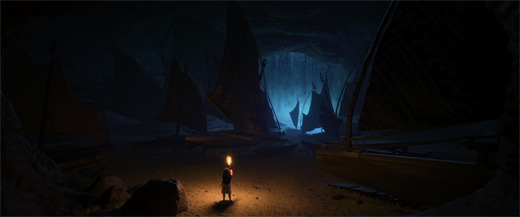
This is where the movie begins tripping over its themes. In The Little Mermaid, the dynamic between father and daughter was a lose/lose situation. Both Ariel and her father had strong and weak points in their respective arguments. Neither was wholly right or wrong. Had they not been so stubborn and proud, they’d have realized this.
But in Moana, we are shown with absolute certainty that Moana is correct. We know for a fact the island is dying. We know for a fact that continued residence on Motunui is impossible. We know for a fact the island possesses the resources to relocate the population elsewhere. Since Moana is on such simpatico terms with her father, sharing this viewpoint should be easy.

Moana's father doesn't see things this way. He goes through a radical reset of his already limited character. He suddenly forgets Moana’s capability and dedication to the island. He sees her only as a naïve child. Her point of view no longer matters to him. Disney shoehorns him into the role of stern, forbidding authority figure when he's never had reason or purpose to take such a role.
With no other recourse, Moana disobeys her father’s orders, readies a boat and sets out to explore the ocean solo. She has no plan, other than to return the legendary Heart of Te Fiti.

Both Ariel and Moana wind up on the same path. Both defy their fathers. Both leave home. Both venture into the unknown following their heart’s calling. Moana has built up its heroine as a rational, level-headed girl who shares her father’s values. The movie then thrusts her into a position where she has to impulsively dissent from her father’s values. What was the point if its all undone?
We’re treated to a flashback scene where Moana’s father, in his impetuous youth, tried sailing past the island’s reef with a friend. A great wave swells, capsizing their boat, drowning this unfortunate friend. This has traumatized Moana’s father, making him greatly distrustful of the ocean. He’s never told Moana this, and he doesn’t realize it’s been influencing his decisions. This justifies his actions in the text, but doesn’t contribute to the betterment of the film.
He doesn't decry Moana's ocean-going spirit as too risky or too dangerous. He doesn't view Moana's desperate solution as giving up on the island. He just hates sailing and distrusts his daughter. He is a man shown to be so open with his feelings that he sings and dances about how much he loves coconuts. Why can he not tell his daughter about his one weakness?

It would be the ultimate torch-passing moment. He’s already priming Moana to take over as leader. Why not trust her with the one task he’s fully unequipped to handle himself? The task that just so happens to be the most important task of either’s reign.
If Moana’s father were portrayed sympathetically and not obstinate, it would put Moana more on par with Mulan than Ariel. Mulan left home to join the army because her father couldn’t. Moana would leave home to sail the ocean because her father couldn’t. Both abandoned a comfortable life for the betterment of others. Both adopted a new life, learning new skills, finding an identity. Moana’s journey would be one of loving sacrifice instead of defiance.
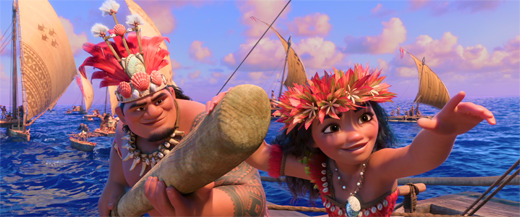
By the film’s end, the spiderweb of morals creates confusion. Moana leads the island's inhabitants to a new life, elsewhere. An ancestral tradition, but one they've personally never known. Is the film championing adherence to tradition, or embracing new ideas?
Moana has to reject her father’s island-borne values to save her people. But she does that by embracing even older ideals. Are these ancient ideals forgotten enough to be considered new ideals again? Or are the new ideals tried by Moana’s father considered a failure, leaving Moana to reject them for a return to conventional practices?
If the final moral was that modernity and tradition requires a delicate balance, that would be wonderful. That principles and values of one generation don’t necessarily benefit all generations. Being satisfied where you are is a fine moral if all your needs are being met. In times of trouble and peril, the greatest tools for survival, happiness, and fulfillment are flexibility and adaptability.

But Moana doesn’t want to offer such a complex moral. It wants something short, pithy and marketable to slap on tee shirts and posters. It offers the platitudes "know your purpose" and "follow your destiny."
It's hard for a film to champion fatalism, especially a fantasy film. Moana has a very specific circumstances. Moana has a sentient ocean wave and luminescent manta ray spirits to guide her. It’s easy to know one’s destiny when supernatural forces spell it out. That's great for her, but the movie doesn’t quite cement what anyone else should do. "Listen to your heart" sounds like a nice truism, but it makes a lot of assumptions.
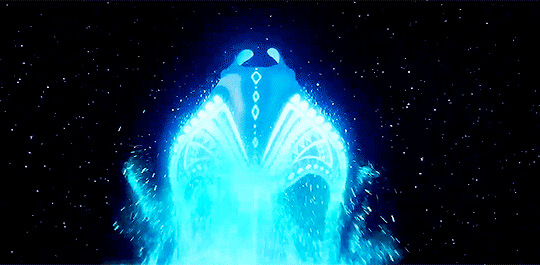
Moana is not alone on her journey. Joining her is the demigod Maui, based on the Polynesian mythological figure. Maui is the one who stole the Heart of Te Fiti, a thousand years ago. During the heist, Maui was separated from his magic fishhook. With no magic except immortality, he’s spent the millennium stranded on a desert island. With nothing to do but wait, Maui has become conceited, retelling his own stories, believing the myth he created for himself.

This makes Maui a comic foil to Moana. Moana is royalty, she’s hardworking, and she’s on a quest to save the world. She sees Maui as impudent, lazy, and the source of all her troubles. Maui, despite being separated from his godlike powers, still considers himself almighty and universally revered. He sees Moana as just another insignificant mortal.
Both see themselves as worthy of power and respect, especially compared to the other. Neither has power nor respect. Both expect the other to be humble. Neither are. They act like siblings sharing the backseat on a car trip.

Also joining Moana is a rooster named Hei-Hei. Unlike most Disney animal sidekicks that are cute, clever, loveable, and friendly, Hei-Hei is not. Hei-Hei is completely braindead. He has no higher functioning abilities and no personified traits. He barely even functions as a chicken. He eats rocks, cannot focus his eyes, and seems blithely unaware of his surroundings at all times. He contributes nothing to Moana’s journey other than his presence.

Hei-Hei is the result of a bait and switch. At home on Motunui, Moana has a pet piglet named Pua. It’s implied Pua will be Moana’s animal sidekick via his presence in the film's first act. He’s seen throughout the introductory scenes, being lovable, quirky, and endearing. But Moana sets off on her journey without him, without even a goodbye. Pua is just abandoned, not seen again until the film’s concluding moments. Instead, it’s Hei-Hei, absentmindedly stowing away on Moana’s raft, who joins her.

There’s actually a funny reason for this switch. Hei-Hei’s original personality was more inline with real-world roosters: assertive, aggressive, and ready to peck. He was intended to be a judgmental observer to Moana’s actions; a stand-in for her disapproving father. But directors Ron Clement and John Musker knew Hei-Hei’s presence was upsetting the film. Something about him had to change.
The crew gave themselves 48 hours to come up with a solution. Doing so, they revisited one of the most visually-engaging and energetic scenes in the movie: The Kakamora invasion.

In the film, the the Kakamora are a floating battalion of monsters shaped like coconuts. Despite their comical appearance, they are a force to be reckoned with. They have great numbers, advanced sailing techniques, masterfully crafted ships, and powerful weaponry. They know Moana has the Heart of Te Fiti, and are taking it by force. The entire scene was deliberately influenced by the 2015 action film Mad Max: Fury Road.

Creating a slew of new storyboards, the staff concocted different ways Hei-hei could be incorporated into this scene. The general consensus was to play up a comical counterpart to the action onscreen. Instead of contributing, Hei-Hei would be doing wildly irrational things. He would reinforce Maui and Moana’s competence by further complicating the situation.
This eventually led to Hei-Hei’s perception and intellect being staggeringly reduced. According to Clements, Hei-Hei “might be the stupidest character in the history of Disney Animation.”

With all these complications, we get a real understanding of who Moana is as a character. She’s even-keeled and patient when ruling her tropical island paradise. But how is she when she’s removed from comfort and familiarity?
Moana had a big fight with her father. Her grandmother just passed away. Her home is being threatened. She’s embarking on a journey into a strange, dangerous world. She’s inexperienced and unprepared. She has only the most basic knowledge of sailing, and no knowledge of navigation. Neither matter much, because she doesn’t know where she’s going anyway. Her companions are an unapologetic jerk and an unhelpful, burdensome rooster. Everything is stacked against Moana. And this drives her up the wall.

Moana is a teenage archetype not depicted in a Disney heroine before, that of a squabbling, irritable, moody teenage girl. She’s frustrated when her father rejects her ideas. She’s testy when she learns sailing is more difficult than she assumed. She’s peeved when Maui is confrontational and arrogant. She’s bitter when obstacles block her path. Moana is pushed to the threshold of her patience, and is kept there throughout most of the movie.


It’s actually refreshing seeing a heroine in such a position. So often, Disney's female leads have to make a grand statement. They're not allowed to just be women. They must be ideal, unflawed woman. And this transparent display of feminism comes off as shallow or distracting. They’re so idealized, it ruins the immersion.
Moana isn’t perfect, nor does she have to be. She doesn’t have to be supremely capable or demonstrably strong in all areas. Unlike other princesses, Moana isn't saddled with being smart, kind, benevolent, beautiful, graceful, optimistic, tenacious, and collected. Moana is allowed to be imperfect, unprepared, and flawed.

This isn’t to say Moana is poorly written, oblivious, or static. When there’s reasons to be happy, she’s happy. When there are reasons to be sad, she grieves. But the more her journey goes on, the more she defaults to anger and frustration as her neutral emotion.
Her temperament is justified based on the various issues surrounding her. Maui knows this, and exploits it for his own amusement. When Moana has to put on a silly costume and act as live bait, it’s instantly recognized as funny. We laugh at the poor girl and her ignoble situation.

It's also used to drive the drama of the film. With so many problems piled atop each other, there are dramatic moments where Moana questions her worth, her purpose, and her fate. Can she be a strong leader, or is she a celebratory figurehead? Can she honor the legacy of her ancestors, or is she just an immature child? Can she revive the lost history of her people, or are the secrets lost to time? She tries her best, but her best isn't providing the answers she wants.
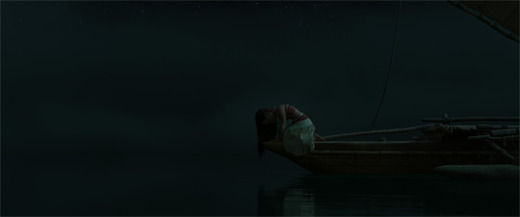
Many Disney features display humorous moments alongside the dramatic moments. Each carries the other, making the story multifaceted and memorable. Moana has a strange sensibility where it can’t quite get the balance right. There’s not enough space between the two.
For example, after a long period of ribbing and sniping, Maui decides to finally open up to Moana. For the first time, he’s humble, he’s apologetic, and he’s grateful for Moana’s help. It's a pivotal scene for his character arc. He delivers this impassioned speech after a transformation accident. He's unknowingly taken the form of a shark from the waist up.

After the Kakamora invasion, Maui and Moana seemingly come to an accord. They’re partners in this oceanbound endeavor, and they need to accept that. Maui then immediately chucks Moana off the boat mid-handshake, only for Moana to petulantly crawl back on board. “Worth a shot” he mutters, as though he didn’t just betray his new ally.

Before entering a mystical, deep-sea cavern to retrieve his lost fishhook, Maui sets the scene. They are about to enter a world of frightening peril and intense danger. He then cannonballs into the lair, commenting on the ridiculously comical height mid-freefall.
The spirit of the ocean frequently intervenes on Moana’s journey, creating a arm-like appendage out of water. This creates a running gag whenever someone falls overboard, they’re unceremoniously tossed back onto the boat. Maui is accompanied by a living tattoo avatar on his chest that comments on the events of the film in a sardonic pantomime. The Kakamora, while dangerous, are also supremely silly in appearance. Moana's Grandmother is an emotional core to the film, but delivers her lines with a smirk. There's a running gag where Maui wants to eat Hei-Hei. There are two pee jokes in the film. Maui makes a horrifically groan-worthy joke about using birds to communicate.
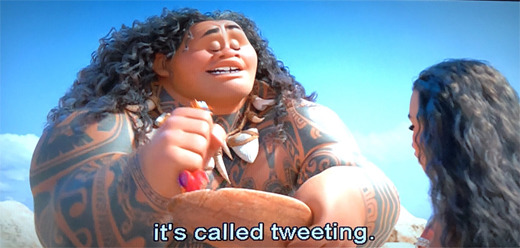
Moana is concerned with drama only when it affects Moana as a character. These scenes are treated with respect. Anywhere else in the picture, the idea of genuine emotion and austerity is met with shirking shame. The film feels it has to undo any seriousness with some sort of quip or snark, as though feeling things is stupid.
This happens so much, it's hard to properly classify the movie. Is this a road trip movie that’s dressed as a fantasy adventure? Or is this a nautical epic that, in lieu of traditional heroes, stars an opinionated teenager, a puckish demigod, and a mentally deficient chicken?
This isn’t the fault of Moana exclusively. Through the 2010s, Disney blurred the line between the serious and the silly. Movies don't want to take themselves seriously beyond their climax. Heroes no longer just have comic relief sidekicks, they themselves must also be comical. Disney's slate in this era features comedy on top of comedy. Which is fine if you're making a comedy, but Moana is not supposed to be a comedy.
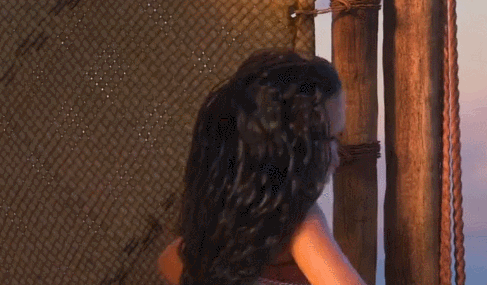
Comedy is supposed to carry a film. When its done right, its a seamless addition. When done wrong, it weighs down the entire production, burdening the story its supposed to benefit. Moana is trying so hard to be a comedy, especially in places where it doesn’t need to be. The movie would be so much better if it was allowed to simply be itself instead of hiding under a humoresque security blanket.
Tamatoa is the greatest example of this. Tamatoa is a giant crab with a pension for hoarding things. A thousand years ago, he found Maui’s magic fishhook, and has claimed it as part of his vast treasure. He and Maui have had a falling out, leaving them bitter ever since.

Tamatoa is voiced by comedian Jemaine Clement, doing a variant of his oft-used David Bowie impression. It culminates in a comical villain song, done in a glam rock style. It’s funny, albeit pointless.

Tamatoa’s scene is an episodic outlier in the film. He’s alluded to several times prior to his introduction, but not influentially. After his scene concludes, he’s never mentioned again (except for a post-credits gag that’s just a fourth-wall joke). He lives exclusively in his one scene.
Tonally, he doesn’t fit in with the rest of the film, acting more like a 70s nightclub owner than an otherworldly sea monster. Musically, his song is in stark contrast to the rest of the soundtrack. Logically, he doesn’t make sense in with Moana's human world or in Maui's spiritual world. Storywise, he has no real bearing on the plot other than being a temporary roadblock. He interrupts the heroes’ progress, they overcome him, and they return to their previously established path. His scene could slip right out of the movie with no real effect.
Even if Tamatoa wasn’t inconsistent with the rest of Moana, even if he weren't played so comically camp, I’m not sure his presence would be fully welcome. Break down his entire character and see if anything seems familiar. Tamatoa is a feared monster. He lives in a cavern. He’s extremely territorial. He hoards large amounts of gold, jewels, and treasure. He towers over our heroes with his gargantuan size and claws. He is defeated when the heroes exploit his penchant for flattery. Tamatoa is uncannily similar to Smaug from The Hobbit.
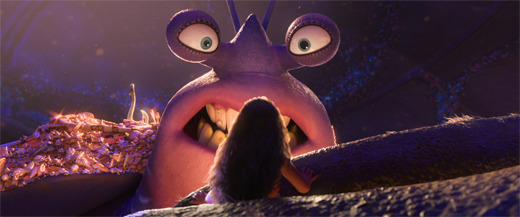
When Moana wants to be a serious, poignant movie it absolutely can. The final showdown between the heroes and the angry lava god, Te Ka, is testament to great animation, great pacing, and great filmmaking. As is the final resolution of Moana returning the Heart of Te Fiti. Although, having Maui experience a crisis of confidence, abandoning Moana partway through the climax, only to change his mind five minutes later to return and save the day feels like a cheap way to raise the stakes.

Moana feels like a film that should be more than what it actually is. We have an epic story, epic characters, and an epic mythology. We have a unique seafaring setting, gorgeous animation, a top-tier cast, and experienced filmmakers.
Instead, Moana plays things very safe. It retreads old ground in storytelling and character arcs without making enough forays into new realms. It begs comparison to other Disney films and characters. What should have easily been a top-tier Disney film is self-conscious, using humor to mask its insecurities.
Moana has four or five key scenes of drama it wants us to focus upon. We can recognize these scenes because they feature the dramatic, non-comedic musical numbers. It’s not hard to see that the music was a significant, if not the primary focus through the filmmaking process. Moana was never supposed to be a Lin-Manuel Miranda film. But it became one.
Moana uses the emotional power of music and lyrics to broadcast the film’s true power and passion; an element absent from other moments. The remainder is filler, meant to occupy the audience between major scenes. Much like Polynesia, we have a series of lush islands in a big empty sea.
Beauty and the Beast
Fantasia
The Lion King
Frozen
Snow White and the Seven Dwarfs
Cinderella
Alice in Wonderland
Sleeping Beauty
Mulan
Zootopia
Tangled
The Little Mermaid
Aladdin
Lilo & Stitch
The Many Adventures of Winnie the Pooh
Pinocchio
The Jungle Book
Robin Hood
The Sword in the Stone
Bambi
The Emperor’s New Groove
The Hunchback of Notre Dame
Moana
The Princess and the Frog
The Great Mouse Detective
Big Hero 6
101 Dalmatians
Bolt
The Three Caballeros
Lady and the Tramp
The Rescuers Down Under
Atlantis: The Lost Empire
Wreck-It Ralph
The Fox and the Hound
Fantasia 2000
Peter Pan
Dumbo
Hercules
Meet the Robinsons
Brother Bear
The Black Cauldron
Melody Time
Oliver & Company
Treasure Planet
Tarzan
The Rescuers
Pocahontas
Saludos Amigos
The Adventures of Ichabod and Mr. Toad
Winnie the Pooh
The Aristocats
Dinosaur
Fun and Fancy Free
Make Mine Music
Home on the Range
Chicken Little
#Moana#Disney#walt disney#Walt Disney Animation Studios#disney studios#Disney Canon#movie review#Film Criticism#film analysis
1 note
·
View note
Text
Zootopia at 35
A review by Adam D. Jaspering
There’s a joke about Zootopia I like. An animator goes into the Disney board of directors’ office. They say, “I’ve got a great idea for our next film. It’s a buddy cop movie.”
The CEO looks at him and says, “Did you say a bunny cop movie?”
The filmmaker pauses for a moment, smiles, nods, and replies. “Yes.”

Zootopia is the story of a city populated by anthropomorphic animals. At the center is Judy Hopps, a rural girl overcoming her meager upbringing by becoming a police officer in the big city. However, her inexperience, lack of street smarts, and small stature undercut her efforts. As her shortcomings compound, she relies on the assistance of Nick Wilde, a slick conman, to help save the day. But all is not well in Zootopia. A dark conspiracy is lurking beneath the city’s surface. One that could corrupt the entire population from the inside out.
Zootopia is a kids movie. It was written for kids, it was designed for kids, and it was marketed to kids. Appealing to children was a top priority at all stages of production. Just like every other offering from Disney Animation.

With that established, Zootopia is possibly the heaviest picture to come from Disney Animation. Not only is the plot more complex than the standard Disney film, it deals with heavy themes. There are movies for adults that don’t approach such weighty subject matter. This bold initiative dominates any discussion of the film.
In true Aesop tradition, Zootopia is a fable. Animal characters channel thoughts and narratives into an easily understandable metaphor. A simple children's tale stands in for a more complicated aspect of humanity. In this case, the ideas of bigotry and prejudice. In our world, these lines are commonly drawn between races. In Zootopia, the distinction is the divide between herbivores and carnivores.

This is represented by our two main characters, Judy Hopps and Nick Wilde. Judy is a rabbit. She’s a police officer. She actively wants to be a force for good, and her ambitions end there. She’s never considered what "good" entails. She assumes that by being a police officer, she’s helping. She never considers she's participating in a system that enforces order at the expense of the populace’s well-being.
Nick is a fox. He’s a predator and a career con artist. Nick has no affiliation towards anyone besides himself. His only concern is his own well-being, excepting an open contempt towards the police. Nick has a great disdain for power structures and authority, mostly stemming from past incidents of harassment.
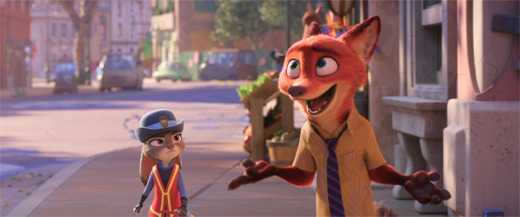
The dichotomy of prey and predators is a major element of the film. Predators have the ability to physically harm prey. Prey have the ability to systemically harm predators. As kids, Judy was assaulted by school bullies. Nick meanwhile was verbally attacked by his peers before being demeaned and humiliated.
But prejudice isn't always an overt moment of life-changing action. Zootopia illustrates smaller moments of intolerance that are just as painful. When anti-predator sentiment sweeps the city, Judy’s cheetah friend is reassigned to a job where he won’t be seen by the public. A mother and daughter on the train sit next to a tiger minding his own business. The mother deftly skootches her daughter away from the stranger. Judy spends a majority of the movie carrying a brand of pepper spray that is explicitly labeled for protection against foxes. She never considers how absurd it is such a product is commercially available.

Judy was raised in a small town, believing in concepts of racial harmony and the melting pot. She considers prejudice to be an outmoded concept. The only remaining adherents are backwards or imbecilic; outlier statistics in the population. She doesn't consider anybody actually benefiting society to be capable of such primitive thinking. This especially includes herself.
However, Judy neglects to consider that she has benefited from prejudiced policies currently in place. Such policies have enabled her upbringing. Her family are successful farmers in a town with a significant monocultural ethnicity. Her parents have an ingrained distrust of predators, especially foxes. She brushes off such comments as if they were just folksy aphorisms. She doesn't realize how much of her parents' values she's inherited and normalized.
When stressed, Judy finds that she doesn't know what she believes. She's never had her values tested before. She doesn’t want to carry these prejudices, even denying they exist. She wants to believe the myth of harmony, but society and people are complicated. Judy has a serious gap in understanding, stemming from inexperience. Denying her faults has done her no good. She needs to accept her shortcomings, and work on improving them.
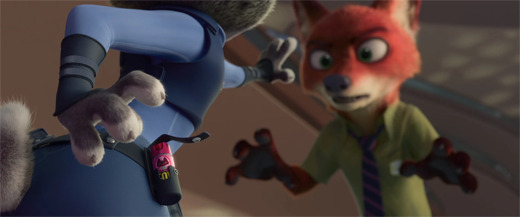
Being progressive isn't something you are, it's something you do. She can believe that predators and prey are equal under the law, but words are cheap. She’s taking a very passive stance in recognizing the inherent bias in the system by refusing to acknowledge it even existing. Despite Judy’s attitude and beliefs, she’s still living in a prejudiced society and benefiting from the oppression of others. She's declared herself not racist, and washed her hands of any further responsibility. It’s doubly worse because she’s a police officer, actually in a position of power to influence change.
As a result, Judy commits a number of microaggressions in an attempt to broadcast her desired beliefs. Rather than actually being an ally, she overcorrects. She pities, demeans, or dehumanizes others in an attempt to make herself look worldly and mature. When she first encounters Nick, she unwittingly participates in his latest scam. She abuses her police power and gives a few strange foxes money from her own pocket just to demonstrate how tolerant she can be.

Later in the film, in a slip of the tongue, Judy accidentally declares that predators are inherently dangerous. Not as a result of society or upbringing, but because its hardwired in their DNA. It's unclear whether Judy subconsciously believes this or was momentarily confused on how to voice her actual beliefs. The important part is, she perpetuated a myth that society presented to her. A Disney cartoon is actually commenting on the dangers of eugenic beliefs.
When Judy accidentally states these beliefs, she does so after a life-changing adventure with Nick. In two days, the pair had gone from adversaries to mutuals to friends. Now, as Nick hears Judy’s hurtful words, it’s devastating. Judy earnestly believes she’s a more evolved form of life than other species. If a trusted friend can feel that way, what chance does Nick have against total strangers?

Nick’s entire persona is defined by being disillusioned with the system. For one shining moment, he found a friend and was willing to cast off his cynical nature. He let his guard down, and almost immediately, society hurt him again. His own friend sold out him and the entire predator populace.
Judy claims to be forward-thinking. She wants to help, and wants to be seen as helpful. She sees a disenfranchised predator trying to buy a popsicle, and offers to pay. But minorities don’t need people to buy them ice cream. They need people to disavow rhetoric that society should be structured around genetics.
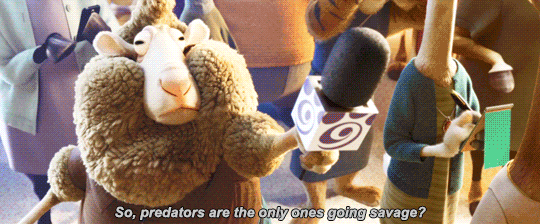
Using animals to demonstrate its themes, Zootopia has to perform a delicate dance. The movie has to precisely demonstrate what it’s trying to say and why it’s trying to say it. If they don’t boldly and deliberately state their points, it seems disingenuous. It makes Disney seem as if they’re not actually interested in discussing race, using the themes for exploitive purpose. Likewise, If they took the metaphor too far, they’d accidentally make the case they’re trying to disprove. That certain human demographics are very similar to ferocious jungle animals and conniving con artists.
Speaking in metaphors always has implications. Zootopia dodges the controversy gracefully. Zootopia's predator class are demonstrated as harmless. We the audience don’t see a talking cheetah as anymore dangerous than a talking musk ox. There are no demonstrated behavioral traits or mannerisms which differentiate predators from the prey. There are only a few instances when a predator onscreen is actually depicted as violent. In those instances, it’s explicitly stated as an irrational behavior exacerbated by outside circumstances. To the viewer, an animal is an animal.
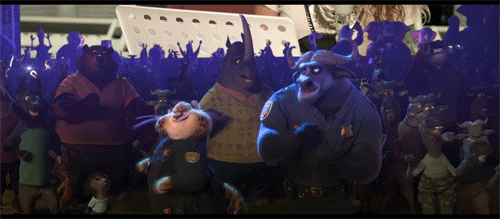
A major plot point of the film reveals that it’s possible for animals to go “savage.” This condition is uncommon. It's treated as a medical mystery; something out of a horror film. But it’s an accepted affliction. For reasons unknown at the time, a citizen can unwillingly forego their humanity (or the animal equivalent) and be reduced to an oblivious beast. For predators, this means becoming territorial and aggressive.

It’s later revealed that this feral state is a biological reaction to poison. Individuals are drugged into a state of stupor. A chemical blocks their higher-functioning mental capabilities, leaving them a savage. It’s not their fault, and it’s not an indicator of their true self or their predator ancestry.
But more importantly, this drug and its effect does not affect just predators. It’s equally effective against prey. This ability to go savage is present in the entire population, but unfairly attributed to predators exclusively. A visual demonstration rather than secondhand testimony would have helped enforce this point, but the effort is there.

The purpose of discussing racism is not to simply wave one’s finger at the ignorant because racism is bad. The purpose is to enlighten others. To demonstrate how racism is rooted in corruption and why it’s destructive to a functioning society. Bigotry isn't always hate crimes and violence. It can be very easy to passively support bigotry. Discussions prompt reflection and critical examinations.
Zootopia does the proper thing by inciting the discussion, but not leading it. It doesn’t try to answer questions. It encourages the audience to ask their own questions. Knowledge comes from understanding. Zootopia wants its audiences to recognize problems. It wants them to acknowledge good people and good societies have faults. It wants them to understand why manners and civility don't make problems disappear.
As Judy demonstrates, prejudice can manifest in unintended and unconscious ways. Everyone is capable of making a bad judgment based on gender, sexuality, nationality, ethnicity, religion, class, age, etc.
Fortunately, for her sake, the movie also preaches the virtue of forgiveness. A bad opinion is not necessarily indicative of a person’s true nature. Judy wants to be upright and moral. Her heart is in the right place, she just doesn't know the proper procedures for getting there.

Prejudices and bigotry are an unfortunate but constant presence in society. As long as there are people, there will be differences. As long as there are differences, there will be othering and scorn. Forcing change on a societal scale is impossible. But as the saying goes, think globally, act locally. If you want to make the world a better place you begin by bettering yourself. And by example, you don't force but inspire others to change.
After their falling out, Nick is angry at Judy. Not just her, but the whole system. He had every right to tell her off and reject her, even when she tries to apologize and make things right. He knows she’s sorry, he knows it was a mistake, and he knows Judy wants to be better. Nick wants his friend back, but it's not a matter of forgiveness. The world scorns him constantly. He's survived by closing himself off. But for the first time in a long time, he let his guard down and opened up to someone. And in doing so, he was hurt. Just like when he was a child. Nick isn't angry, he's betrayed. He can’t forgive Judy until he knows he can trust her.

Nick is a very clever individual. He’s smart, he’s cunning, he’s perceptive, but he has no outlets for such skills. Society has scorned him. Society has convinced him he’s worthless with nothing to contribute. So he operates outside of the system, benefiting nobody, ultimately boring himself.
When he’s presented with an opportunity to use his skills to the benefit of society, he jumps at the chance. In short, if you treat someone like a criminal, how can you be surprised when they act like a criminal? But if you give them encouragement and opportunities, they can develop their true potential.
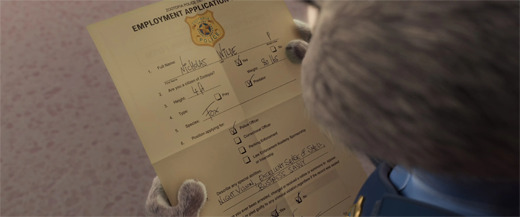
While the film is a deliberate metaphor, such a commitment to fantasy concepts creates a hole in the world’s logic. Throughout the film, we see herbivores eating fruits and vegetables. But except for a few scenes with junk food, we never see carnivores eating anything. The entire film’s conceit centers on predators being predators, but there is no predation.
What besides their ancient ancestors make them predators? There are no avian, piscine, or arthropodin creatures; just mammals. Non-mammal animals do not exist in this world. Neither do non-sentient creatures. How can there be meat consumption in the world of Zootopia? There simply cannot be.
Ironically, answering this immaterial nitpick emboldens the film's themes. Somewhere on the evolutionary timeline, predators stopped attacking prey. Civilization is a process. It didn’t happen by accident, and it’s not maintained by chance. These animals evolved to speak and walk on two legs. They also evolved a society around them. It requires effort, involvement, and trust between citizens. The prey have to trust the predators aren’t going to attack them. The predators have to trust the prey will allow them to coexist as equals.

The strange part of Zootopia is, even though the predator class are larger and more intimidating, they are at the mercy of the prey. The film canonically states that herbivores outnumber predators 10 to 1. It's not hard to imagine, maybe predators didn't voluntarily give up their dietary habits. Maybe their privilege at the top of the food chain was wrestled away in an uprising.
Somewhere in history, prey were attacked and predators were disenfranchised. How many have died? Who has received reparations for their respective inconveniences? What further rights could be taken away? There is a lot of distrust amongst the populace. So much, Zootopia has a system of beliefs and prejudices woven into its framework.

For example, the mayor of Zootopia is a lion. He’s seen as powerful, strong, and intimidating. It’s stated in the film the only way he won the election is because he chose a sheep as his running mate. This implies that predators are rarely ever in positions of power, and that Mayor Lionheart may very well be the first ever Zootopian predator mayor. Is he a hero? Is he a trailblazer? Is he a dishonest manipulator?

We don’t know for certain, and the movie won’t tell us. The movie selectively chooses what it wants to present, when to present it, and everything else is hand-waved away. Some of these societal elements definitely need further exploration. Perhaps these heavy details were omitted to make the film more lighthearted. Perhaps they were omitted because it distracts from Judy and Nick’s story. Despite the missing details, we’re assured it all makes sense.
Inconsistency is the main flaw of the film, and it’s at its worst in the first act. While we’re still acclimating to Zootopia as a concept, we’re willing to overlook or forget the flaws. On repeat viewings, we see the cracks in the foundation.
Judy has had lifelong aspirations of being a cop. She wants to both stand up for the downtrodden and to compensate for her shortcomings. Which shouldn't be a problem in this movie, but is for some reason.
There are three main body types on display in Zootopia. Large animals, such as panthers, bears, and elephants. Medium-sized animals, such as rabbits, foxes and sheep. Small animals, such as mice, hamsters, and other rodents.

The third group is mostly used for visual puns, so it’s the first two groups that influence’s Judy’s acceptance in society. Judy’s birthplace is the very on-the-nose named Bunny Burrow. It’s populated almost entirely by rabbits. Here, for the entirety of her youth, she has a specific view of what normality is.
Judy gets her position on the Zootopia police force through a government program. She was selected not on merit, but to diversify the police force. The rest of the officers are all lumbering giants compared to Judy’s leporine frame. It's this difference that defines her presence on the force.

This would not be a terrible thing in a different movie. In training, Judy uses her agility and speed to compensate for her diminished strength. Theoretically, she's capable in any circumstance. In practice, she’s still five feet shorter and several hundred pounds lighter than her fellow officers.
The other cops accept her only as the token hire she is. They begrudgingly tolerate her to the minimum amounts required. They delegate to her the most unrewarding grunt work: Parking detail.

The issue isn’t that Judy is an herbivore; there are many herbivores on the force. The chief himself is a water buffalo. Nor is the issue that Judy is a woman. Many of her fellow officers are women. The discrimination that Judy faces is one of height and physical stature. A discriminatory element never seen elsewhere in the film. An element which runs counter to the main focus of the film being the division between predator and prey.
Judy is small. That's the takeaway from the film's first act. In this world of incredibly varying size differentials, there’s apparently no need for public servants of different sizes. She’s the department's only mid-sized police officer, and she’s underutilized. Likewise, there are zero rodent-sized cops. Which might explain the presence of a rodent-led mafia.

Zootopia tries to introduce its prejudice themes before circumstances support them. Judy won’t meet Nick until the end of the first act. Without a major predator character, Judy has to carry the themes herself. This puts Judy in the unfortunate role of somehow being both the oppressed and the oppressor.
Judy is coded as a minority along the police force. She’s seen as an outsider, she’s treated as an outsider, and she’s forced to endure unwelcome sentiments. Early on, she takes offense to being called “Cute.” Supposedly, it’s an okay thing for rabbits to say to each other, but egregious for other species to say to a bunny. This is the most painfully blunt racial parallel in the film, and its almost cringeworthy to hear.
Judy’s journey of self-worth is never in doubt. The film is never about whether she’ll succeed or fail as a police officer. We know she’s capable. That’s what the opening montage of her at police academy demonstrates. Her journey is learning the faults of prejudice to better herself and her community.

Which is why, when Nick is finally introduced, Judy’s oppression arc is forgotten. The thematic responsibilities are tossed to Nick like a game of Hot Potato. All further judgement and ostracism Judy receives is not because of her size. but instead because of her arrogance and inexperience. These two character flaws have been present throughout the first act and should have been the focus all along.
The Zootopia police force is overworked with several missing persons cases (or whatever missing persons are called in a world without humans). The senior officers have struggled to make any progress. Desperate to establish herself as competent, Judy defies the orders of her captain, and resolves to solve one of the cases herself.
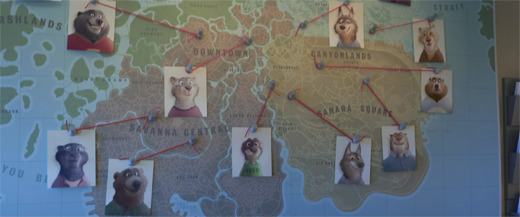
With the plot established, the movie takes a number of interesting turns. It begins as a character piece, exploring Judy exclusively. Her life, her ambitions, her goals, her struggles. It feels and plays like a personal journey. We see her grow and develop, balancing the person she wants to be with the person she needs to be.
The movie then pivots into a mystery story. Judy’s one and only shot at success requires solving a case that tenured professionals can’t. Only through tenacity, deduction, and Nick’s assistance can she succeed.

Then when the mystery wraps up, the plot pivots once again, focusing on the societal allegory. The movie becomes a discussion on race relations and societal pressures. Zootopia is doing so much.
Zootopia plants the elements for each of its three focuses early. Each of the three plot threads is resolved with requisite story beats. This isn’t three small movies. All three of these aspects support each other, support the film, and create for a unified experience.
This type of film structure is used to its fullest advantage. The mystery element begins well before we’re introduced to it, and reaches critical mass when we’re not expecting it. We’ve been so involved with the drama concerning Nick and Judy, we forgot certain details were never clarified.
Yes, the mayor, a team of scientists, and a security detail were arrested for conspiracy. They kept citizens isolated and interred because they somehow went savage. But the mayor and his cohorts weren’t behind the incident, just trying to cover it up. Someone else was the real criminal.

Zootopia pulls off the big twist villain, succeeding where other Disney films stumbled. Frozen’s big villain reveal didn’t work because the movie didn’t need a villain. The reveal seemed like a last-minute addition to clean up lingering plot threads. It wasn’t poorly done, it just seemed like a twist for the sake of a twist. Big Hero 6′s big villain reveal didn’t work because they broadcasted the twist too heavily. The surprise was ruined because the film insisted there would be a surprise. The mystery villain was a foregone conclusion, revealed premature through process of elimination.
Zootopia keeps the villainous twist a surprise in all aspects. The film behaves like a shell game. There are so many characters, scenes and story elements presented to us. The audience is distracted with all the information. We don’t realize we’ve seen a series of important clues among the tumult. Once the villain's been revealed, everything clicks. Only one character had the resources, motivation and influence to carry out such a nefarious plot.

Even beyond its ambitious themes, Zootopia is a wonderful film. The movie is full of great scenery. It’s an urban cityscape, but with enough animal iconography to be unique. This can be as simple as pun names of shops and companies. There are obvious allusions, such as zebra crossings represented by actual zebra stripes. Sometimes, the theming is more subtle. For example, the architecture having a deliberate parallel to animal environments. Skyscrapers look like they're carved from rock. Train stations look like a rainforest. Spires resembling horns and antlers abound. These aren’t animals in a human world. This is their own, unique world of animals.

And that design is essential for Zootopia. The city of Zootopia features different biomes existing in ridiculously close-quarters. Such a layout accommodates animals from across the world. A sandy desert literally abuts a frozen tundra, separated only by a concrete retaining wall. It’s never explained how or why two such contrasting environments are next to each other. But it displays that despite the urban setting, this is an incredible fantasy world.
With such boundless opportunities, anything can happen in Zootopia. That said, it’s strange that the writers made one ridiculous plot thread that’s tonally and comedically incompatible with the film. Halfway through the film, Judy and Nick run afoul of a rodent mafia don who’s tangentially related to their case. This mafioso is stylized in both appearance and voice after Vito Corleone from the 1972 film The Godfather.

As narratively integrated as the shrew mobster is, it is a questionable inclusion. For starters, The Godfather film was already over 40 years old by Zootopia's release. It's not exactly topical material for a parody.
Second, for as beloved as film as The Godfather is, it’s presence in a kids’ movie is perplexing. Kids may recognize what The Godfather is, but they won’t be fans of the movie or appreciate the reference. There are no throngs of kids excited to see a Marlon Brando impersonation.
Third, The Godfather is a piece of cultural iconography, but its already been parodied and referenced elsewhere. It's hardly an original idea. Any new interpretation seems trite and uninspired. It’s a reference for the sake of a reference. There are no other movie parodies in the film. This scene is just a distraction.
There’s plenty of worthwhile humor in the film, though. Nick’s sarcastic and wry attitude. Judy’s overconfidence and arrogance. Plenty of zoological visual gags. A scene of sloths working at the DMV seems a little obvious at first glance, but is executed with perfect comedic timing.

All this frivolity is essential. A kids’ film dealing with such heavy themes needs humor. It’s the sugar that helps the medicine goes down.
Zootopia is a fascinating display of style and substance. It takes a common concept like talking animals, injecting enough style to make the idea fresh. There’s an entire world on display, taking full advantage of the interaction between sentient animal species. It's almost a shame we're stuck focusing on our two leads, as it deprives us of seeing more of the city.
The story is one of the boldest and most daring ever tackled by Disney Studios. It prompts discussions on very important issues. It forces the audience to question their own beliefs and become better people as a result. It’s so good, it ironically almost ruins the picture. Zootopia is far more serious than the traditional escapism Disney markets itself on.
Not that ambition or social commentary are detractions, but it makes for a strange experiment. Disney was interested in taking a deep dive, but only once. They have never again approached such relevant political commentary in their animated films. In a way, it makes the company seem cocky and arrogant. Disney could have always been this transient and progressive. They are actively choosing not to be. They want the escapism.

Whether you're maintaining a friendship, bettering yourself, or building a society after evolving into intelligent life, it takes constant maintenance. It's folly to think that just because some progress was made, the work is over. Problems need to be recognized early and subsequently fixed. With Zootopia, Disney is here to remind you, do good and be better. Even if corrupt politicians stand in your way.
Beauty and the Beast
Fantasia
The Lion King
Frozen
Snow White and the Seven Dwarfs
Cinderella
Alice in Wonderland
Sleeping Beauty
Mulan
Zootopia
Tangled
The Little Mermaid
Aladdin
Lilo & Stitch
The Many Adventures of Winnie the Pooh
Pinocchio
The Jungle Book
Robin Hood
The Sword in the Stone
Bambi
The Emperor’s New Groove
The Hunchback of Notre Dame
The Princess and the Frog
The Great Mouse Detective
Big Hero 6
101 Dalmatians
Bolt
The Three Caballeros
Lady and the Tramp
The Rescuers Down Under
Atlantis: The Lost Empire
Wreck-It Ralph
The Fox and the Hound
Fantasia 2000
Peter Pan
Dumbo
Hercules
Meet the Robinsons
Brother Bear
The Black Cauldron
Melody Time
Oliver & Company
Treasure Planet
Tarzan
The Rescuers
Pocahontas
Saludos Amigos
The Adventures of Ichabod and Mr. Toad
Winnie the Pooh
The Aristocats
Dinosaur
Fun and Fancy Free
Make Mine Music
Home on the Range
Chicken Little
#Zootopia#Zootropolis#Disney#walt disney#Walt Disney Animation Studios#disney studios#Disney Canon#movie review#Film Criticism#film analysis
11 notes
·
View notes
Text
Big Hero 6 at 35
A review by Adam D. Jaspering
Big Hero 6 is the story of Hiro Hamada. Hiro is a 13 year-old prodigy with a particular aptitude for engineering, design, and computer programming. When he uncovers a nefarious plot happening in his own city, he takes it upon himself to stop it. He recruits several colleagues to assist, using their skills, discoveries and inventions to create a team of superheroes. Together, they set out to save lives and uncover the truth.

One of the key focal points of the movie occurs early on. Hiro invents a series of microbots, capable of moving, organizing, and creating mechanisms and mobile structures. The invention is so well-received, he earns the attention of two individuals. The first, Robert Callaghan, a professor at the local university. The second, Alistair Krei, CEO of a major tech industry.
Krei promises Hiro a fortune for his invention, setting him on a pathway to prosperity. Unburdened from financial obligations, he’s free to pursue science as he desires. Callaghan promises Hiro a pathway to enlightenment and fulfillment, through education. He insists pursuing science as a virtue, one that shouldn’t be compromised through corporate interests.

This decision of Hiro’s is only a minor plot point of the film. It introduces two authority figures who influence his actions later. But the ethical dilemmas of who owns scientific discoveries and innovations (and who profits) are never again alluded to. Which is ironic, as it’s a near perfect reflection on how Big Hero 6 came to fruition.
Bob Iger became CEO of Disney in 2005. This was an era when media markets were becoming more competitive and overcrowded. Advancements in technology made accessing and creating entertainment simple. The entertainment industry had more content than ever before. Audience attention was being divided, and advertisers were being choosy. The entertainment industry already had a finite source of income. It was now being divided into smaller and smaller slices.

As a result, companies were conglomerating. Strategic buy-outs could create an umbrella that served many organizations. Larger corporations had the wealth and resources to distribute and market content. Smaller creators and mid-tier companies had copyrighted works and creators. For a price, these mid-tier companies could survive in an inhospitable environment.
However, this also meant creators had to serve the whims of their corporate overlords. Artistic visions were sacrificed or censored for marketability. Worse still, it wasn’t uncommon for the buyouts to result in creators outright losing ownership of their creations. But lets focus on the platonic ideal of such a business model, not the capitalist nightmare it typically is.
Iger oversaw many acquisitions during his tenure as CEO. In 2006, he finalized the purchase of Pixar. In 2012, he purchased Lucasfilm, giving Disney the rights to Star Wars. In 2018, Disney acquired rival studio 20th Century Fox. They owned the company name, studios, and back catalog. The purchase of Fox also gave Disney Fox's stock portfolio. Disney now owned a majority stake in both National Geographic Global Networks and the streaming service Hulu.
Arguably, the most influential acquisition of Iger’s tenure was Marvel Entertainment in 2011. Founded in 1939, Marvel (then known as Timely Publications) has been one of America’s largest comic book publishers. Their characters and stories helped define the modern superhero archetype. Their influence on American culture has been indisputable.

Prior to Disney’s purchase, Marvel’s explorations into film had been hit-and-miss. Marvel was very protective of their trademarks, and offered little creative freedom to studios. Characters and stories were oversimplified to tell rudimentary interpretations of legacy characters. In addition, CGI technology was underdeveloped, but still expensive. Budgets were enormous, and often not worth the price tag.
Making a superhero movie in the late 20th and early 21st century was still a gamble. It was impossible to tell which movies would be successes, and which would fall apart during development. As such, Marvel hedged their bets and worked with many different studios. 20th Century Fox, Sony, Paramount, Columbia, Artisan Entertainment, and New Line Cinema all produced Marvel films. Ironically, Marvel never worked with Disney in this era.
It was 2008′s Iron Man that made Marvel a dominant force in film. Iron Man was the first Marvel film to be produced by Marvel Studios themselves. The paltry sums they earned from licensing their characters were now irrelevant. They could make millions from their own studio. The question was, for how long? Superhero films were still risky ventures. A few financial gambits would risk the entire company.
In 2007, Marvel’s total assets were roughly $700 million. In 2009, the Walt Disney Corporation offered to acquire Marvel Entertainment for $4 billion. The deal was too good to pass up.

This is in stark contrast to the original point. Whereas Hiro passed on Krei’s offer of fortune and glory, Marvel readily took the hefty payday. Big Hero 6 treats ownership of ideas as invaluable. Something more important than money. It’s a virtue that defines Hiro’s character as a good guy. Behind the scenes, the exact opposite was happening. Disney was championing one viewpoint in their films, but hawking an incompatible alternative on the corporate level.
To date, Disney has earned over $18 billion from Marvel properties. Nearly every branch of the Disney empire has utilized the Marvel library. Disney Animation was no exemption.
Choosing Big Hero 6 was the end-result of a one-way road. Disney Animation had to select a property that was family-friendly. It had to be visually stylish and suited to animation. It had to feature upstanding characters. It had work as a standalone feature. It had to be a property Disney wouldn’t want for the Marvel Cinematic Universe.

They chose Big Hero 6, an obscure Marvel property that ran for only eight issues; the first three in 1998, the final five in 2008. The Big Hero 6 comic was a spin-off of the X-Men series, set in Tokyo. The team consisted of shapeshifting robots, ex-convicts, and a giant kaiju. Their villains were literal monsters. One of these villains was a ghost, comprised of the souls who died in the 1945 nuclear attacks on Hiroshima and Nagasaki. It was a very strange comic, and has not been especially well-remembered.
Like any Disney adaptation, there were massive rewrites, overhauls, and bowdlerization. The movie was almost completely stripped of any connection to its source material. The characters were rewritten, keeping only their names and original superpowers. If not their original versions exactly, a closely resembling variant.
The movie begins with a sweeping panorama of the city. No longer set in Tokyo, Big Hero 6 offers an interesting compromise. The film is set in a mash-up version of both Tokyo and San Francisco. “San Fransokyo” features the hilly cityscape of San Francisco, as well as the city’s iconic bay, cable cars, and Painted Lady houses. But its designed with a Japanese flair. Around the city are pagodas, the advertisements and intersections of Shibuya, Japanese lanterns, and Kanji signage all around. The most iconic element of the merger is the Golden Gate Bridge, now comprised of Shinto arches.

It’s a very interesting, unique and engaging setting. The movie takes lots of opportunities to show off its setting. Long montages, establishing shots, many chase scenes set outdoors. The filmmakers went to great effort to create San Fransokyo, and they wanted their audience to see every facet. It doesn’t completely ruin the film’s pacing, but it becomes obvious it’s a primary focus. At what point does a film’s immersive setting swallow a film whole?
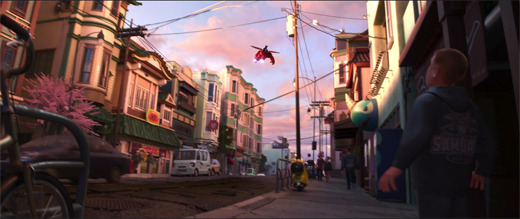
Hiro begins the film rather aimless and restless. A genius by all accounts, he graduated high school before turning 13. With nothing to do and nowhere to go, he’s resorted to building fighting robots, hustling underground robot war tournaments. Partially for a quick payday, partially for a sense of achievement.
It’s the gentle guidance of his brother Tadashi that leads Hiro to enrolling at the San Fransokyo Institute of Technology. The question is, if Hiro was fast-tracked to graduation, why did he never consider higher education until today? Wouldn’t everyone in his immediate sphere be working with Hiro to form a plan?
Nobody would allow a child to graduate five years early arbitrarily. They would have to have a definite purpose and ambition. A goal that they are demonstrably ready to pursue, which redundant schooling would impede. Instead, Hiro gets to sit around the house, bored and detached. The movie deliberately created its own plot hole so it could immediately solve its own plot hole. Hiro needs to be not enrolled in college so the movie can show him enrolling in college.

This opening plot thread has a purpose of intent. A rather noble one, actually. Disney uses Big Hero 6 as a deliberate recruiting device, encouraging its audience to consider a STEM-focused education. STEM (Science, Technology, Engineering, Mathematics) is shown as productive and beneficial to society. It’s depicted as fun and fulfilling. It’s shown to be accessible to all people of all backgrounds.
Tadashi is classmates with three of the six members of the upcoming Big Hero 6 superhero team. Hiro is introduced to them, their works, and their methods. In the original Big Hero 6 comics, these characters were all Japanese. On film, they receive a makeover to represent a wider demographic. This is by intention, furthering the film’s emphasis that STEM education should be available to all.
Advanced education has the unfortunate tendency to favor specific demographics over others. Certain children and teenagers may be discouraged from pursuing a college career path because of numerous factors, institutionalized or personal. If not outright discourage, they’re nudged into disciplines which they may not have a passion or desire for.
Big Hero 6 does its best to undo some of this damage. Tadashi’s classmates represent three different races, but also three different personalities one doesn’t normally associate with the word “scientist.”
Honey Lemon specializes in chemicals and their reactions. She’s a girl with long blonde hair, constantly dressed in skirts and platform heels. She has a strong affinity for the color pink. She’s excitable, chipper, and never apologizes for it. Honey Lemon demonstrates you can be a scientist while still being a girly-girl.

Go Go is developing practical applications for electromagnets. She’s a tough-as-nails punk, commanding respect with her attitude and appearance. She wears a leather jacket, and has a purple streak in her hair. She doesn’t suffer fools gladly, she’s fiercely independent, and always says what’s on her mind. Go Go proves you can be a scientist and a cool badass at the same time.

Wasabi is developing a laser induced plasma fields. He’s a protocol-obsessed neat freak who values order and organization. He’s also built like a linebacker. He’s got pectoral muscles that make him the size of a car. He proves scientists aren’t all pale, scrawny weenies. In all, these three characters show there’s no right way for a scientist to look or act. Anyone can be a scientist.

Or rather, that’s what Disney wanted to say. They took Wasabi’s character one step too far. He looks every bit the jock, but doesn’t act like it. Either in an attempt to soften his edges or flesh out his personality, Wasabi is a gentle giant. It’s not that his body type is misleading; he does possess a physical might, aptly demonstrated during the film’s fight scenes. It’s simply not an accurate reflection of his character. This has the unfortunate implication of stating that the college environment requires a certain level of decorum and obedience. You can be strong and muscular and be a scientist, but you have to toe the line and hide those personality flaws.
Joining these three is Fred. Fred is not enrolled at the university, but a campus employee. He performs as the college mascot. Fred likes to spend his free time at the lab, watching the various developments and experiments. He thinks they’re interesting, and he’s made friends with the students there. He also has an affinity for comic books, eternally nudging the characters into the film’s superhero genre mold.
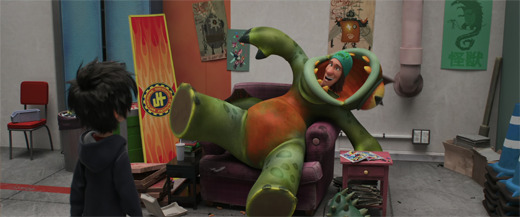
Because Fred has an abundance of free time and an interest in science, one has to wonder why he himself isn’t enrolled. He comes from an upper-class upbringing, so tuition’s not an issue. Perhaps he failed his entrance exam, or his high school grades were too poor. Fred has a childish immaturity about him, but nothing that truly depicts him as an incapable idiot, unworthy of an education. He has every single attribute of being a science major except actually being a science major.
Hiro immediately takes a liking to these four, but the film glosses over the necessary follow-through. These are Tadashi’s friends; he’s spent time with them, developing their friendship over the years. Hiro adopts them as his own by association. They appear in montages and such, but the development apparently happens all off camera. For a film based on the premise of a team, the film fast-forwards through all the necessary teambuilding. They meet Hiro, and they’re all instantly friends.
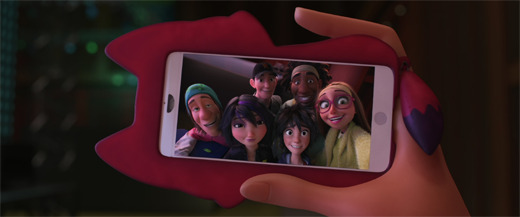
Which is why Hiro organizing them into a superhero team seems strange and off-putting. After Tadashi’s death, Hiro becomes sullen and withdrawn. Tadashi’s old friends do their best to support Hiro in his troubles, but can’t seem to reach him. Instead, he sneaks around in privacy, trespassing in warehouses and investigating the wharfs at night.
Then its revealed that someone is actively trying to kill, or at the very least terrorize Hiro. They’ve stolen Hiro’s microbots, sending a legion of the machines after him. They’re trying to ram him off the road. They’re dropping shipping crates on him. They’re hurling chunks of concrete at his head.

Hiro not only gets his acquaintances involved in this chaos, he asks them to stay involved. He asks them to give up their safety and security to indulge the madness of a kid they barely know. He asks them to put on silly costumes and repurpose their academic life’s work into dangerous weaponry. At a certain point, one expects them to politely but firmly remind Hiro that they like him, but they were really only friends with his brother.
The sixth and final member of Big Hero 6 is Baymax. Baymax is a robot designed by Tadashi prior to his death. The purpose of Baymax was to be an all-in-one medical tool. He can diagnose, treat, and comfort any number of medical conditions, from injuries to illness.

Baymax isn’t the first robot designed by Disney Animation, but he is the best. The struggle of creating an artificial lifeform onscreen is to make them look obviously robotic, but not intimidating or awkward. This means keeping the character deliberately mechanical and metal. This typically results in them looking very stereotypically robotic; uninspired and forgettable.
As the boundaries of the script indicate, Baymax needs to be both a nurturing healthcare provider and a capable crime fighter adept in combat. Two drastically different contrasting points.
Disney succeeds by creating a unique robot. Yes, Baymax has the internal gears, pistons and shafts of any automaton. No, you cannot see them. Nor does he have the classic metallic housing one associates with robots. Instead, Baymax is equally robotic and artificial, but less overtly mechanical. Baymax sports a polyvinyl exterior, inflated like a balloon. This gives Baymax a definite mechanical presence, but also makes him approachable and, for lack of a better word, huggable.
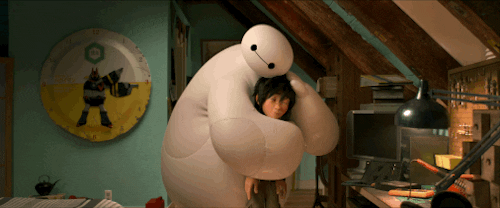
But how does Baymax fight crime? As the movie displays early on, Baymax is essentially a walking blimp. He’s big, he’s awkward, he’s slow, and he’s prone to springing leaks. Not the most adept fighting physique.

The answer has been present for the whole movie: Innovation and application make the world a better place. Honey Lemon fits a portable chemical distillery inside a computerized purse. She can conjure up any number of chemicals in ball form, causing powerful explosions and other inhibiting reactions. Go Go adapts her electromagnetic wheel and axle design into a roller suit. This gives her great foot speed and agility. She can also fire the wheels as projectiles. Wasabi affixes his plasma lasers to a pair of gauntlets. He has powerful punches that can slice through steel and stone. Fred emulates his favorite monster movies. He gets a full-body costume that sports a giant flamethrower.

And Hiro... Well, Hiro is there too. He has a costume, he's present for every fight, but he has no skills. The filmmakers gave him no unique ability or weapon. The closest he has are magnetic couplings he uses to ride on the back of Baymax while flying. He’s the leader of the group, so his superpower is being the generic everyman.
As for Baymax, he gets body armor, a close-quarter combat software upgrade, rocket fists, and a jetpack. This puts him on even grounds with the rest of the team. He doesn’t want to fight, but he does want to protect the rest of his team.

Baymax's autonomy is questionable. At times, he feels like a fully-sentient being. He can think, converse, and make decisions for himself. Other times, he seems full-on automaton. He has a program, he follows the program, and the only way he changes is if his program changes.
Of course, his programming is open to interpretation. Baymax is designed to diagnose and treat medical ailments. When he incorporates psychological care to his roster, his concept of "therapy" is broad. Baymax goes on a long string of errands under the logic that doing so will improve Hiro’s mental health. One thing leads to another, and the medical marshmallow is soon learning Muay Thai techniques. Baymax is either designed very well to learn such a wide range of skills, or designed very poorly to have such exploitable loopholes.
Baymax is one film's strongest elements. He has a unique style and a refreshing presence seldom seen in animation. He has a very laconic approach to everything. He’s calm, unflappable, and unemotive. He states his opinions and observations very matter-of-factly. He is a robot, after all.
But this isn't the only asset Baymax brings to the film. There's an extended sequence where Baymax's batteries wind down. With his processors impeded, he has the mentality and mobility of a drunk. Watching someone stumble around is funny. Watching a stoic individual turn loose and stumble around is hilarious.

There are also balloon noises. In an extended gag, Baymax receives a few puncture wounds, leaving holes in his skin for air to escape. Why does a polyvinyl robot make the same noises as an ordinary rubber balloon? Who knows. It’s a gag. A long, extended gag. A gag that, if handled improperly, could be an annoying exercise in tedium. But that's exactly the point. The gag goes on so long, it goes from funny, to not funny, all the way back to funny again. It's a risky maneuver, but the movie pulls it off with precision.
Every Marvel movie since Disney's acquisition has used humor and action in tandem. Its one of the strongest contributing factors to the MCU's success. It’s also an essential skill to maintain for a movie like Big Hero 6.
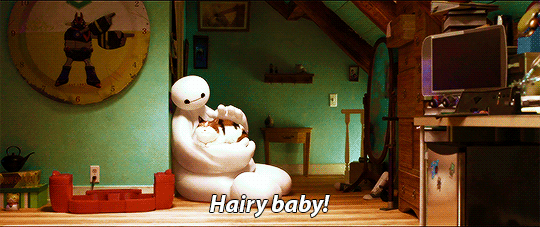
Consider the thematic elements presented in the film: Personal trauma, depression and withdrawal, intense action scenes, killer robots, moments of peril and doom, and adults attacking children. Superhero media has been popular with children since its inception. So much so, it’s easy to forget how violent and mature the genre can be. Big Hero 6 is a kids' movie, but definitely for the older kids, 8 and up. For younger audiences, the kind Disney usually courts, the movie is rather inaccessible.
This limited demographic window hurts the plot structure. In the beginning, every story beat serves the same purpose: get Hiro to organize a superhero team. Tadashi convinces Hiro to attend university because there he will find the resources to become a superhero. Hiro meets his future teammates and sees their skills so they can become superheroes. Hiro reprograms Baymax so Baymax can become a superhero.
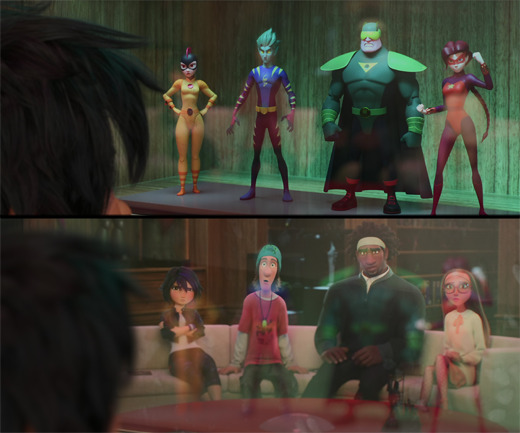
After this, the film prioritizes creating a reasonable villain. After all, superheroes can’t exist if there’s no evil to fight. But a villain can’t just declare their intentions and jump into the world. They’d be arrested. So the villain is a mystery, identified only by his Kabuki mask. His name is a mystery, his face is a mystery, his plans are a mystery, and his reasons are a mystery. They're hidden from the public, hidden from the heroes, and hidden from the viewers.
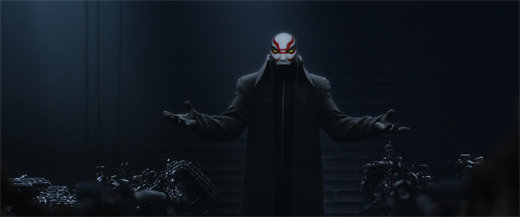
The problem is, hiding the villain’s identity doesn't have the desired narrative effect. The film sets up Krei as a potential villain. He’s mildly adversarial and suspicious. If he was the villain, he would simply be the villain. It would be obvious, and there’d be no point hiding his identity. We all would have reached that conclusion upon his introduction.
Instead, the big reveal is treated as a twist. Our villain is actually Callaghan, the kindhearted, paternal figure. He has a secret traumatic backstory and a thirst for revenge. Callaghan, the character who the movie insisted was important, but lacked any real goals or influence. The character who was nice to the heroes, but quite bitter and hostile towards others. The character who's been suspiciously absent since the first act.
There are only ten characters in this movie, and six are constantly fighting the masked man. Unless Hiro’s Aunt Cass is somehow the villain, there’s only one logical conclusion who the villain is. This mystery element doesn’t serve the film nearly as well as the filmmakers assume it does. It’s the same sort of plot you’d find in any episode of Scooby-Doo, complete with the identity-revealing mask-pull.

Krei’s reckless and cavalier attitude once sabotaged Callaghan's experiments. Callaghan has never recovered from the failure. Hiro’s microbots gave Callaghan the long-awaited opportunity for revenge. This mirrors Hiro’s storyline. Tadashi died in a fire, a horrifying death which Hiro himself has not fully processed. Both Hiro and Callaghan blame others, both want justice, and both succumb to their own rage.
Since we're on the subject, let’s consider Tadashi's death. Him dying may be a required plot element, but Disney chose an incredibly stupid means of death. Tadashi goes out in a literal blaze of glory. The supposed genius runs into a burning building with the intention of saving Callaghan, trapped inside. He does so despite not knowing where Callaghan is, or having any way to protect them both from the inferno. We’re supposed to applaud his bravery instead of his brashness. If we don’t, the movie can’t use his noble death as a motivator. It's an overly-pious suicide mission to emphasize his selflessness. Tadashi deserved a better death scene.

Big Hero 6 is the second Disney film in a row to use depression and grief as a major theme. Hiro's trauma from the death of his brother is an essential element of the film. Disney doesn't sugarcoat the grief. Hiro doesn't get over it or move on. It devastates him until he finds an outlet to process it. He blames Callaghan for Tadashi’s death. He nearly kills Callaghan in an act of blind rage.
While everyone helps Hiro back to reality, it’s Baymax who really reaches him. The entire reason he’s enabled Hiro in this superhero ambition is because he assumed it would help him. But Hiro hasn’t grown or healed at all. He’s only turned his grief into blame into wrath.
Hiro realizes his mistakes. No amount of violence will fix his problems, and it won’t provide any catharsis. The only way to get over Tadashi's death is to honor his legacy. For Hiro to live his best possible life. To honor the values they shared. He later uses this revelation against Callaghan. It's a last-ditch attempt to keep his brother’s mentor from becoming irredeemable.

A noble theme for the movie to embrace, but maybe not from Hiro’s lips. He himself was ready to kill Callaghan in the previous scene. Hiro clearly learned the error of his ways, but the short distance between these two moments is not long enough to demonstrate his growth. He literally learned this lesson eight minutes ago. He sounds like a hypocrite, projecting his own faults.
The final act of healing is closure. Hiro needs to accept Tadashi is gone, but his own life needs to continue. He cannot cling to the past. A harsh lesson that gets reinforced in a bad way.
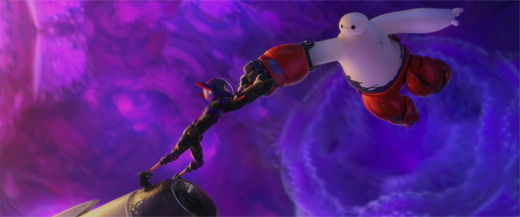
When circumstances are dire, Baymax realizes the only way Hiro can live is if Baymax sacrifices himself. Not just a good friend in his own right, Baymax is the last link Hiro has to his brother. Losing him would be like losing Tadashi for a second time.
And Hiro accepts that. Life is full of ups and downs. People will come and go. Their lives may be short, but their legacies will endure. All we can do is live the best possible life to honor their memory.

Baymax’s death is as genuine and heartfelt as any Disney death, but it’s a fake-out. We forget that Baymax is a robot. He’s a mechanical body with a computer chip brain. Baymax gets a death scene, but can’t actually die. Hiro literally rebuilds him in the film’s epilogue. It speaks volumes to the film’s immersion that any drama or emotion can be mined from this scene.

So often in Disney’s history, the studio has revisited plot points and trends from previous movies. Usually, it's an attempt to replicate success while minimizing efforts. This results in sloppy craftsmanship and second-rate imitations. Big Hero 6 does the inverse, revisiting failed experiments.
Hercules was Disney’s first attempt at a superhero film. The studio didn't fully understand the structure or significance of the genre. Big Hero 6 improves on it, showing a depth and awareness beyond ‘Punch the bad guys until your problems go away.’
Meet the Robinsons tried to demonstrate the importance of innovation and progress. But the movie had nothing more to say beyond showing how great it would be to live in a funhouse. Big Hero 6 demonstrates the methodology of invention and discovery. They’re facets of life. Science and progress are a blank canvas. Powerful if used properly, and exploitable if mistreated.
Brother Bear tried to display the futility of revenge, prompted by a brother’s death. Big Hero 6 goes beyond, showing us that healing involves closure and acceptance. You don’t have to upend or restructure your life to cope with loss. You just have to keep living.
Big Hero 6 even integrates a rock song into a montage, something Treasure Planet tried with awkward results.

As a result, Big Hero 6 is as a well-made piece of superhero fiction despite faltering in elements beyond its genre. It fudges a lot of storytelling beats, getting characters where they need to be and justifying how they act when they get there. Anything is acceptable as long as it leads to superhero stuff.
And that was always the point. Disney Animation wanted to make a superhero movie. They wanted to make a Marvel superhero movie. That’s exactly what they made, even integrating a Stan Lee cameo. They wanted nothing more and nothing less.

There was no need to fix the problems seen in other Marvel movies, or even acknowledge them. Marvel was a popular brand, and massively successful. Big Hero 6 is a movie about science. But Disney's ironic conclusion was, there’s no point in experimenting if something already works.
Beauty and the Beast
Fantasia
The Lion King
Frozen
Snow White and the Seven Dwarfs
Cinderella
Alice in Wonderland
Sleeping Beauty
Mulan
Tangled
The Little Mermaid
Aladdin
Lilo & Stitch
The Many Adventures of Winnie the Pooh
Pinocchio
The Jungle Book
Robin Hood
The Sword in the Stone
Bambi
The Emperor’s New Groove
The Hunchback of Notre Dame
The Princess and the Frog
The Great Mouse Detective
Big Hero 6
101 Dalmatians
Bolt
The Three Caballeros
Lady and the Tramp
The Rescuers Down Under
Atlantis: The Lost Empire
Wreck-It Ralph
The Fox and the Hound
Fantasia 2000
Peter Pan
Dumbo
Hercules
Meet the Robinsons
Brother Bear
The Black Cauldron
Melody Time
Oliver & Company
Treasure Planet
Tarzan
The Rescuers
Pocahontas
Saludos Amigos
The Adventures of Ichabod and Mr. Toad
Winnie the Pooh
The Aristocats
Dinosaur
Fun and Fancy Free
Make Mine Music
Home on the Range
Chicken Little
#Big Hero 6#Big Hero Six#walt disney#Disney#Walt Disney Animation Studios#disney studios#Disney Canon#marvel#Film Criticism#film analysis#movie review
4 notes
·
View notes
Text
Frozen at 35
A review by Adam D. Jaspering
Hans Christian Andersen is one of the most adapted authors by Disney. The Little Mermaid was released in 1989. The Steadfast Tin Soldier was one of the featurettes from Fantasia 2000. The Little Match Girl was released as a standalone short in 2006.
This admiration for Andersen reaches back to the studio's early days. In the 1940s, MGM was making a biopic of Andersen's life. They contacted Walt Disney, asking him to produce animated shorts for the movie. The movie would blend live-action history with animated fantasy.
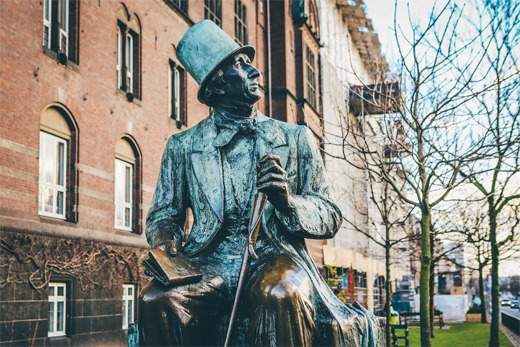
Unfortunately, Disney's severe financial burdens in the 1940s forced them to bow out. Before Disney abandoned the production, five of Andersen's works were selected for animation. These were selected from a shortlist of eleven fables. Why Disney specifically chose those five stories and rejected five others is unknown. But the eleventh, The Snow Queen, was a specific case.
The Snow Queen was deemed unapproachable and unadaptable. Disney and his staff worked, but an adaptation was deemed impossible. The story was specifically locked to a specific place and era. It was impossible to relate the characters, story, morals, and environment to modern audiences without betraying Andersen's work. Five stories were rejected because they were difficult to adapt. The Snow Queen was rejected because it was impossible.
Disney’s adaptation of The Snow Queen was left unfinished and forgotten for decades. It wasn’t until the success of Tangled that Disney changed their approach to fairy tales. Disney has never been known for their faithful adaptations, always bowdlerizing more graphic content. But the base story usually remained consistent. Tangled proved the story was immaterial; only the core components of the original story were required.
Following Tangled's example, Disney could completely rewrite The Snow Queen into any story they desired. As long as the core elements remained, it could still serve as an unrepresentative, yet faithful adaptation. To quote producer Peter Del Vecho, "There is snow and there is ice and there is a queen, but other than that, we depart from it quite a bit."

Frozen is the story of two sisters, Anna and Elsa. The girls are orphans, and heirs to the throne of Arendelle, a northern European kingdom. On Elsa's coronation day, it's revealed to the world she possesses strong magic. She can conjure and manipulate ice and snow, but lacks the ability to control it. In a panic, Elsa flees, leaving the kingdom in a permanent winter. Anna sets out to find her sister and end the spell. Unfortunately, it's more than just the temperatures that have turned cold.
Frozen isn't the first animated Disney film set in a fictional European kingdom. These empires are generically European and historic, and that’s enough. But Frozen openly embraces a specific nation. Arendelle can’t be found on a map, but Frozen enthusiastically imbues it with deliberate Norwegian influences. Onscreen, there is detailed and evocative architecture, landscapes and clothing. Aurally, there's semi-diegetic choral music that accompanies the studio credits and title cards. Frozen is decidedly of a specific location while still being a fantastical world of its own.

With a Nordic chant, we’re spirited away to a world heavily characterized by both ice and color. This dynamism is the key focal point of the film. Ice and snow are frequently avoided in animated films. In inexperienced or uninspired hands, snow is a white blanket. Landscapes look either bleached, bland, or unfinished.
This isn't the first time Disney animated a wintertime sequence. Consider the second act of Bambi, or the “Once Upon a Wintertime” segment from Melody Time. Both used a winter wonderland to varying effects. The landscape didn’t look terrible, but static and monochromatic. The intention was to put focus on the foreground.
But Frozen finds the color and textures of winter days and nights. Ice is crystalline, and crystals refract light. The film is awash is purples and blues that accentuate the frigid, white environment. It looks cold and harsh, but also beautiful. Frozen does many things well, but its greatest achievement is not just embracing the challenge of making winter colorful, but executing the idea perfectly.

Contrast is the watchword. Every part of Frozen has a counterpart that accents, highlights, or emphasizes another point. Be it a narrative element, a character trait, or a design choice.
The elder sister, Elsa, harbors a secret. For reasons unknown to all, she possesses cryomancy powers. Unfortunately, she lacks the ability to control these powers. When she was a child, Elsa struck Anna in the head with an icy blast, rendering her unconscious. Elsa has never been able to live down the shame. She internalizes her guilt until it manifests as self-loathing. She cannot trust herself, and believes nobody can trust her. She closes herself off from the rest of the world, terrified of losing control and hurting others. It happened once before, she knows it can happen again.

The younger sister is Anna. Anna is by all accounts an ordinary girl. She has no memories of her accident, and cannot remember Elsa ever having magic powers. From her own perspective, her sister is also an ordinary girl. An ordinary girl who refuses to leave her room and is inexplicably withdrawn. One day, they were best friends. The next, they barely talk.
Despite the barriers, Anna possesses an unyielding love for her older sister. But while Elsa is willing to live a life of solitude, Anna is energetic, outgoing, and personable. She strongly desires to interact with others, and she wants Elsa there beside her. Years after Elsa's self-imposed isolation began, Anna still encourages Elsa to rejoin the world. Anna the unstoppable force versus Elsa the immovable object.
On the night of Elsa's coronation, Anna finally gets her wish. Elsa has come of age and is about to be crowned Queen of Arendelle. Bound by diplomatic obligation, Elsa reluctantly agrees to be social for a single night.
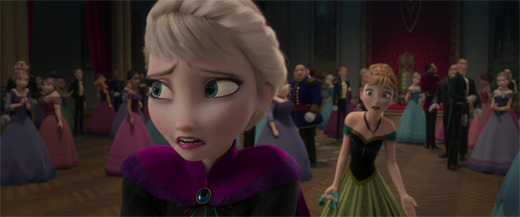
In doing so, Anna unleashes a decade of pent-up social extroversion on the kingdom. She's so blinded by the festivities, Anna accepts a marriage proposal within hours. Elsa, practical to a fault, immediately recognizes the irrationality of her little sister. Another contrast. Anna, the childlike idealist versus Elsa, the hardened realist.
The opposing nature of these girls is represented in their appearance. Elsa has platinum blonde hair and milky skin. It signifies her allegiance to all things winter. This is in contrast to Anna, who dresses in a series of bright, radiant colors and verdant greens. Partnered with her red hair and freckled skin, she appears warm and friendly like a spring day.

This color theory is greatly exemplified in the coronation scene. Anna's coronation gown, is green and black. Green, representing the previously mentioned warmth, and black, the inverse of Elsa's pallor.
Throughout the film, Elsa wears a variety of white and blue clothing. Since the coronation forces Elsa far outside her comfort zone, her clothing matches her discomfort. She's forced into a position more suited for Anna's demeanor. As such, she's dressed more like Anna. Elsa's coronation gown is black and teal. Black, a color she never normally wears, only adopting it as her life turns more sullen and painful. Teal, trying to mimic Anna's spirit, but not quite succeeding. She's stuck halfway between an intended green and her preferred blue.

The only clothing revealing Elsa’s true nature are her blue gloves. A constant reminder of her true self and the magic hands she's desperate to hide. Elsa feels so vulnerable, she hides everything. Elsa wears a winter dress; heavy fabrics, no exposed skin below the chin, and a heavy cloak. A deep purple cloak, representing her royal status; a position she's unsure she can handle, almost as though it’s smothering her. This is in stark contrast to Anna’s spring dress; light fabric, exposed soldiers, and bare arms.
Anna and Elsa are only really together for a few isolated points in the movie. Disregarding the film’s prologue and conclusion, they confront each other three times. The first, at the coronation ball, where Elsa and Anna argue. The second, after Anna finds Elsa’s secluded hideaway in the mountains, where they argue again. The third, the film’s climax, where things are so bad, they can't argue because both are on the verge of death.
The sisters don’t want to admit it, but their years apart have weakened their relationship to a state of atrophy. Their fondness for each other is based on decade-old memories. When they get a rare chance to interact, they realize how staunchly different they are. Those differences ferment into resentment at how much the other doesn’t understand them.
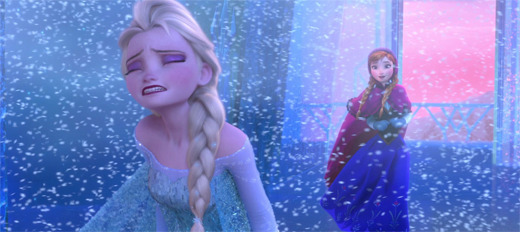
Elsa has been in a hermitic state, desperate to keep her secrets hidden and not hurt anyone. She’s developed a personality of extreme caution and practicality. Elsa wants no one around her, and will not explain why. Anna only perceives her sister as irrational, hostile, and judgmental.
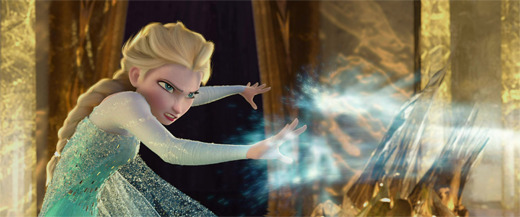
Anna has sacrificed a life of experiences and engagements in deference of her sister’s needs. In gratitude, Elsa has kept Anna at arm’s reach and explained nothing. Anna is obtuse to Elsa’s suffering and psychological inhibitions. Elsa only sees her sister as a child, unburdened and clueless.
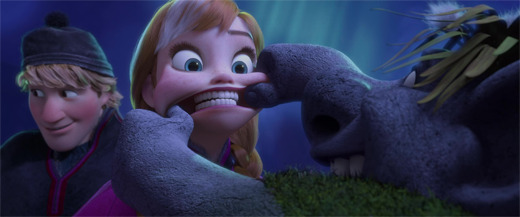
This rift between these sisters is vast. These two barely know each other anymore. They don’t know how to fix things, and at times, question whether its even worth fixing. And yet, while it would be easier for both to part ways, it would be far more painful and unfulfilling.
There is some element deep inside. Despite the resentment, despite the separation, despite the differences, both know this relationship is worth saving. After running away, one of the very first things Elsa does is recreate a snowman she and Anna made as children. A fond memory of a happier time. She wants desperately to return, but fully believes it to be impossible. And yet, the snowman remains. Elsa tells herself Anna can’t be a part of her life, but her actions betray her words.
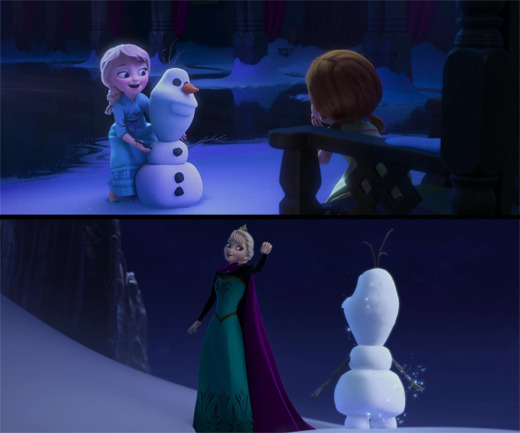
Contrasts are important an important motif. Everything in this movie supports something else. This keeps the pace lively, the stakes high, and the story intimate. Which is why it’s such a confounding thing that the movie subjects us to a family of trolls.
It’s not explained why Elsa has magic powers, it’s just a given. It's the central crux of the story. Our suspension of disbelief allows it. But the presence of trolls is a weird stain on an otherwise polished movie. The trolls attempt to explain and justify Elsa's magic, which needs neither an explanation or justification. These troll are largely inconsequential to the plot, popping in twice to move the story forwards. They feel like a leftover from an earlier draft of the film.

The one trait the trolls have is exposition. They provide bridges to keep the narrative flowing, making the film seem like it's taking a desperate shortcut. They are the ones who understand Elsa’s magic. They’re the one’s that imply her powers are dangerous. They suggest Elsa remain isolated and hidden from a young age. They recognize that Anna is cursed by Elsa's magic. They reveal how to break the curse.
Imagine if Tangled featured a scene where Rapunzel was lost in the woods, and an inexplicable glen of fairies guided her home. And then, nobody ever mentioned the fairies again. The trolls provide a lot of necessary plot information, but there had to be a more natural and cohesive way to integrate it.
There’s no denying Frozen was a popular film. A less regarded fact is, the soundtrack nearly rivals the film’s popularity. Frozen's soundtrack spent 13 weeks at the top of the Billboard Charts. It was the top-selling album of 2014 and was in position 30 for 2015. Three singles went gold, two went platinum, while “Let It Go” went quintuple platinum. The soundtrack won the Grammy award for best compilation soundtrack, while “Let It Go” won the Academy Award for best original song. While The Lion King has sold more individual albums, by nearly every other metric, Frozen is the most successful soundtrack in the Disney animated canon.
A film this ambitious requires capable vocal talents to carry the burden. Elsa and Anna are voiced respectively by Idina Menzel and Kristen Bell. Both actresses have significant experience and backgrounds in musical theater.
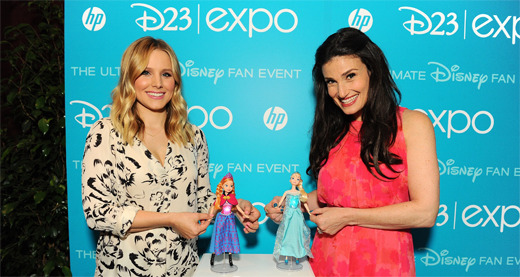
Menzel appeared in Broadway productions of Rent and Wicked. The latter of which earned her a Tony Award for Best Lead Actress. Bell’s theatrical career is less acclaimed than her co-star’s, but it’s just as extensive. Both actresses are extremely capable at singing and acting in tandem, and to different effects.
Menzel is tasked with handling Elsa's dramatic pathos. Much like her role in Wicked, she plays a woman torn between worlds. She goes on a journey of self-discovery, finding strength in what she once considered shame. Bell, better known for her comedic roles in television and film, gives Anna a comical slant. She keeps the film light and energetic. Elsa handles the drama, Anna provides the comedy. Contrasts again.
Frozen proudly displays itself as a musical. It uses an extensive amount of songs, themes, and theatrical patter. More than any other Disney film of this era. By 2013, Disney had adapted six of its animated films into stage productions. The company was growing quite adept at this new market. With Frozen, it’s clear they were anticipating another theatrical adaptation. By laying the musical groundwork early, it would save time later. Sure enough, Frozen debuted on Broadway in 2018.
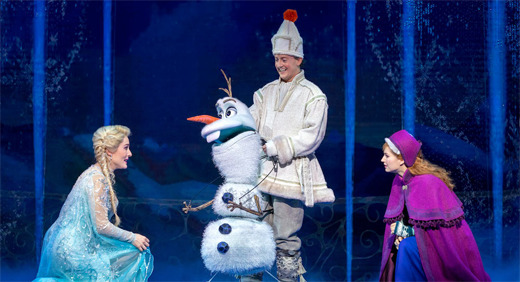
Anna’s portrayal is unique as far as Disney Princesses go. Disney has spent decades curating and refining the idea of what a princess is. They're defined by their elegance, grace, and sophistication.

Beneath the opera gloves and ball gowns, it's easy to forget most Disney Princesses are supposed to be teenage girls. While they have independent personalities onscreen, their primary traits are dignity and confidence. They all seem adult and mature. Anna is very much a warts-and-all portrayal of a teenage girl. She's awkward, she's easily aggravated, she's clumsy, she's impulsive, and she has a weird sense of humor. At one point, she interrupts her own musical number so she can scarf down some snacks.
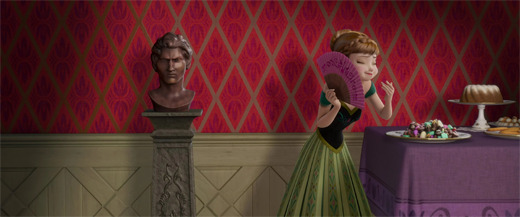
Anna's immaturity makes Elsa seem all the more regal and elegant. Even without knowing the girls’ ages, it's quite apparent who is the older sister and who is younger. It's an important distinction to establish. Despite her emotional state, Elsa does have an air of maturity Anna lacks. It reminds us that Elsa truly is the Queen of Arendelle. If she can be saved, the kingdom is in good hands, despite those hands currently cursing the empire.

But nothing makes Elsa more respectable than her show-stopping musical number “Let It Go.” The song is about liberation and freedom, and is the most popular element of an already popular movie. It's hilarious in hindsight that Disney bothered to include a pop cover over the credits. They genuinely thought the song would need assistance breaking into the cultural consciousness.
“Let It Go” mirrors Elsa growth. It starts as a somber, melancholy piece heavy on piano. Elsa is terrified, repressed, and ashamed. But as she learns to let go of her burdens and stress, the music picks up. The music turns jovial, and big orchestral swells elevate Idina Menzel's voice. By the time she learns to love herself, the music is operatic and downright rapturous.

The freedom is powerful and uplifting, but corrupting. In pursuit of her best self, Elsa learns how to be confident and embrace the magic she once cursed. But she does so at the expense of everything else. Her home, her kingdom, her responsibilities, and most importantly, her sister. Elsa is only substituting one problem with another.
Elsa’s story arc has resonated with audiences. Both her struggles and her strengths. Her personal journey has made her one of the most sympathetic figures in Disney Animation. She subjects herself to a world of isolation and self-loathing because of her magical abilities. It’s a metaphor. But what is it a metaphor for? That depends entirely on who you ask.
There are three common analyses of Elsa’s story. Some feel it’s an allegory for depression and mental illness. Some say its an allegory for repressed homosexuality. Others still claim it’s about grief processing and trauma.
We see repeatedly that Elsa spends her days alone, voluntarily locked in her room. She refuses to interact with her sister or engage in any social manner. She's unhappy, she doesn’t know what's causing her problems, and she doesn’t know how to fix them. She’s incapable of expressing the pain to the people around her. All she has are a pair of gloves that moderately suppress her problems; a solution that has waning effects the longer she uses them.
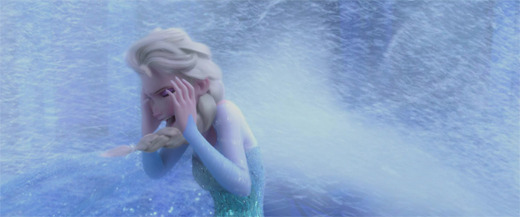
Depression and anxiety can be caused by a number of things, but once they develop, they stick around. There’s no cure, and no reversal. You only learn to live with the diseases. Antidepressants, like Elsa’s gloves, help one endure, but the only real solution is acclimation. You have to learn to cope.
Elsa finds outlets for her repressed emotions. She relies on her loved ones for support. She acknowledges her feelings, be they sadness, anger, or fear. It’s a long road, but once she accepts she is strong enough to walk it (and she doesn’t have to walk it alone), her path to healing begins.

The explanation of Elsa’s ice powers are left deliberately vague. It’s unclear whether they developed over time or whether she was born that way. She’s left to contend with scorn, ostracization, and discrimination just because of who she is. She’s horrified by the prospect of being ‘outed.’ The gay parallels are strong.
Anna has a romantic subplot, but Elsa is left unattached throughout the film. No inclinations, no wandering eyes, no possible suitors. It’s never clear what Elsa would be looking for in a partner, or if she’s even considered it. Elsa’s romantic preferences are unexplored. It may have been because it was immaterial to the story. It may also have been a deliberate commentary on her character.

There's no confirmation or denial of Elsa's sexuality. For many, that's enough. They see a character sing about breaking free. She's liberated from judgment and shame. She no longer has to keep secrets. Without any denial, her ambiguous confidence is interchangeable with canonical queer representation. There’s so much implying Elsa is a lesbian, but nothing proving she isn’t.
In this regard, “Let it Go” is more than just a ballad of freedom, it’s a liberating anthem of self-acceptance. Elsa outwardly sings that she no longer needs to live repressed or in fear of being discovered. She can live how she wants, and no one can ever make her go back.

In the third column, Elsa has been swamped with burdens her entire life. Despite her affluence, she’s princess regent for a whole nation. A great stressor for a young child, but it's hardly the only weight around her neck. She also must contend with the knowledge that she once nearly killed her sister. Her family has restructured their lives around protecting her. Elsa spends her childhood feeling like both a burden and an anomaly. She has no friends and no outlets. And worst still, she has to contend with the sudden death of her parents. More than just parents, the sole confidantes for her struggles.

This portrayal of trauma and grief is harsh. Elsa has been put through the wringer before the film's prologue ends. It's an explanation to children that bad things happen. Life is not always fair, and problems may overwhelm you. But grief will consume you if you let it.
Elsa’s only way out is processing the various tragedies that define her life. Life goes on. She and she alone determines how she moves forward. She's tried wallowing in misery. She’s tried running away from her problems. She needs to find a way to be happy again.

While all these reads have arguments in their favor, none are more correct over the others. It’s literally a movie about a woman who can make snow out of thin air. But the power of symbolic storytelling lets it represent whatever is needed. The viewer decides what they are seeing, and the film supports those interpretations. To those dealing with trauma, they found a story on how to move forward. Those dealing with repressed identities found an icon. Those coping with mental illnesses found a sympathetic parallel. The movie can be everything because its not stuck being one thing.
In terms of concrete themes, the film makes an overt statement concerning love. In the third act, Elsa's magic strikes Anna once again. This time, the blow is more than just concussive. Anna is now cursed, growing weaker and slowly dying. The only way to save Anna’s life, as cliched as it may seem, is an act of true love.
Immediately, as characters in a fairy tale are wont to do, they assume the act of true love is a romantic kiss. Anna progresses forwards in pursuit of this one idea, never considering other options.

Once again, Disney in the 21st century plays with classic tropes and assumptions. They know what audiences assume and expect, and turn those expectations on their head. Snow White’s curse was broken with a romantic kiss. Sleeping Beauty’s curse was broken with a romantic kiss. Tiana’s curse was broken with a romantic kiss. Anna is cursed and apparently also needs a romantic kiss, right?
Frozen offers an exploration of arbitrary magical boundaries. What is “True Love” exactly? The terms of the spell are vague. This ambiguous phrasing cannot be an accident. The solution must be open to interpretation. Why should we assume the concept of love is limited exclusively to romantic love?
In the English language, the word “Love” does heavy lifting, representing a number of ideas. Yet it almost always defaults to the idea of romance. In ancient Greece, “Love” was represented in four different ways.
"Eros" is the term for romantic and physical love. It’s the standard interpretation of love one defaults to when they consider love. Audiences default to it, Anna defaults to it, and every character in the movie unnecessarily defaults to it.
But the Greeks knew there was more than one way to express love. There was "Philia," passion towards an interest. Love can be directed towards a group, an activity, or an object. There was also "Agape," a selfless love. Love can manifest as compassion towards mankind. It's the love that allows for benevolence and charity.
But it’s the fourth type, "Storge," that is central to the resolution of Frozen. Storge is an instinctual affection towards a specific individual. It's the type of love parents have for their children. It’s the love owners have for their pet. It’s the love that exists between sisters.

Elsa has barely interacted with Anna for years. In the few moments they had together, Elsa has been standoffish and judgmental. Elsa has literally hurt her sister. Despite everything, Anna has never given up on Elsa. She knows Elsa is a good person. She knows Elsa needs her support. She doesn't know if Elsa will ever begin acting like herself again, but she never gives up hoping.

At the film's climax, things are falling apart. Anna's curse is near completion. She's moments away from perishing. Elsa is being pursued by the film's villain. Her adversary is ready to strike her down with a sword. All the grief and panic has sent Elsa's magic into overdrive, creating a massive blizzard.
Anna barely has the physical strength to stand up. With her last gasp of strength, she saves her sister's life. Despite losing everything, Anna puts the well-being of her sister before her own. Anna has never given up on Elsa, and never stopped believing in her. If she has to sacrifice her life to give her sister one more chance, it’s a sacrifice worth making.
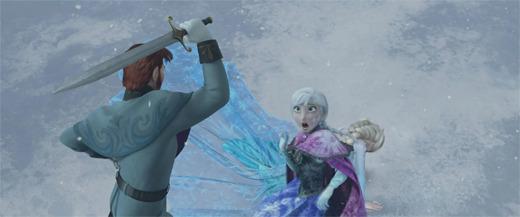
This is the act of true love necessary to reverse the spell. Not towards Anna, but from Anna. Not an act of romance, but a demonstration of sisterly devotion. Elsa, for the first time, either realizes or appreciates everything Anna has done for her. She's not alone, nor has she ever been. With a new perspective on her life and circumstances, Elsa finally finds a path forwards to betterment.
This isn’t the only way the movie plays with viewer expectations. Early in the film, we’re introduced to a character who’s unambiguously villainous. His first words of dialogue are literally declaring his evil plans out loud. There is no doubting his evil intentions.

The story focuses on the struggles of Anna and Elsa. We follow both their internal struggles, and their struggles as family. At first glance, one assumes this is a story that doesn’t need a villain. The agitator is pushed to the peripheries, barely interacting with the story. He's more a feeble nuisance than anything else. He’s almost unworthy to be a villain in this movie. But this is deliberate.
It’s a classic bit of misdirection. This comically inept figure is filling the niche villain role. The viewer accepts his place in the movie, and ignores his presence whenever he's not onscreen. All accounts of treachery and suspicion are placed on him, and him alone. There's no need to suspect there's a second independent villain operating in the secrecy.

It’s not until the film's climax do we see how villainous the film's true villain actually is. He's been a puppet master, influencing things from the shadows. Everything he's ever done is reframed with his nefarious nature in mind. All his benevolence was nothing more than manipulation and posturing.
There’s no discussion of Frozen without discussing its impact on popular culture. Immediately out of the gate, it was a box-office darling and a crowd favorite. It grossed $130 million on its opening weekend, and $1.82 billion overall. As of writing, it’s the 17th highest-grossing film of all time. It stayed among the weekly top ten domestic box office draws for four and a half months. It was still earning millions in theaters when it was released on DVD and Blu-Ray. It is also the best-selling Blu-Ray of all time.
Frozen was so financially beneficial to the Disney Corporation, the film became its own product line. Not just part of the Disney Princess franchise, Anna and Elsa have their own merchandise. Over a decade later, the movie is still selling toys, clothes, and snack foods. Frozen is a cash cow that won’t stop producing milk.
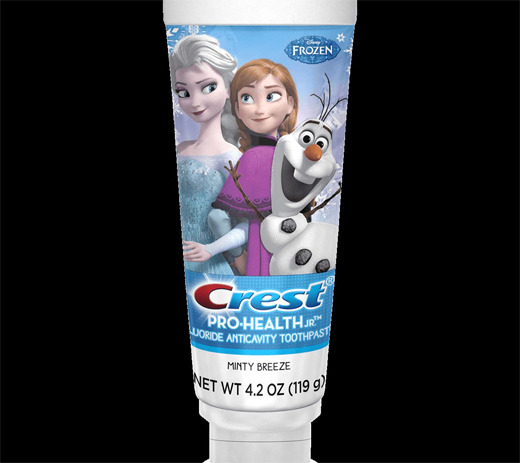
Most films have a central element or character that everything revolves around. Frozen works on a binary, keeping Anna and Elsa equally in focus. Something is always happening onscreen, and something equally important is happening offscreen. If somebody is struggling, somebody is growing. If somebody is static, then someone is dynamic. The movie starts with two sisters who have grown apart, and ends with two sisters who found their way back.
And just the same, Disney took a blanched setting and made it look vibrant and colorful. They took a common story cliché, and they made it a philosophical journey. They took an ordinary princess and they made her a tragic, inspirational figure. They took a story treatment that was impossible to adapt and turned it into one of the most popular and successful films in the studio’s history. It’s all about contrasts.
Beauty and the Beast
Fantasia
The Lion King
Frozen
Snow White and the Seven Dwarfs
Cinderella
Alice in Wonderland
Sleeping Beauty
Mulan
Tangled
The Little Mermaid
Aladdin
Lilo & Stitch
The Many Adventures of Winnie the Pooh
Pinocchio
The Jungle Book
Robin Hood
The Sword in the Stone
Bambi
The Emperor’s New Groove
The Hunchback of Notre Dame
The Princess and the Frog
The Great Mouse Detective
101 Dalmatians
Bolt
The Three Caballeros
Lady and the Tramp
The Rescuers Down Under
Atlantis: The Lost Empire
Wreck-It Ralph
The Fox and the Hound
Fantasia 2000
Peter Pan
Dumbo
Hercules
Meet the Robinsons
Brother Bear
The Black Cauldron
Melody Time
Oliver & Company
Treasure Planet
Tarzan
The Rescuers
Pocahontas
Saludos Amigos
The Adventures of Ichabod and Mr. Toad
Winnie the Pooh
The Aristocats
Dinosaur
Fun and Fancy Free
Make Mine Music
Home on the Range
Chicken Little
#Frozen#Disney#walt disney#Walt Disney Animation Studios#disney studios#Disney Canon#movie review#Film Criticism#film analysis
2 notes
·
View notes
Text
Wreck-It Ralph at 35
A review by Adam D. Jaspering
Film and video games are two convergent forms of entertainment. Typically, entertainment follows an evolutionary path. Theater, vaudeville, radio, film, and television all have branches connecting each other. Video games are another entity. The medium was not created by artists and entertainers, but by programmers and engineers. Video games require special hardware to both produce and consume. Most game studios partner with tech companies, not entertainment companies. But both are billion dollar industries vying for the attention (and money) of consumers.
Modern video games are lauded for their excellence in design, storytelling, and music. They rival film and television in quality, offering a unique element: interactivity. In early days, games were only partially concerned with gameplay and engagement. They were also about demonstrations of technology. Creators were less concerned with “Is this any good” and more concerned with “Look what we can make a computer do.”
And thus came the video arcade. Entire buildings devoted to housing collections of video games. They sprung up in small towns and big cities alike. Video games became a novelty, then a toy, and finally an entertainment mainstay. And they got there one quarter at a time.

Disney had many reasons to make a film concerning video games. There is a defined subculture; approachable and identifiable. Video games are very popular and enticing, especially with children. Games have been made in a variety of styles and subgenres, allowing for a wide scope of inspiration. In short, video games offer a rich and unique digital style. With caution, a movie based on video games wouldn’t seem like a cheap cash-in or commercial.
And incidentally, most trademarked video game characters are not owned by rival film studios. Disney could license popular franchises easily.
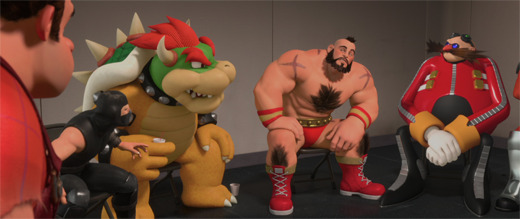
Wreck-It Ralph is the story of a video game character, tired of his repetitive existence. After thirty years of being an arcade villain, he longs for the glory of being a hero. In his pursuit, he abandons his arcade cabinet, looking for satisfaction elsewhere. His selfish actions start a chain reaction which doom the whole arcade. For the first time, Ralph needs to fix things himself.
Wreck-It Ralph's base foundation is nostalgia. The main character is from an arcade game released in 1982, often referred to as The Golden Age of Arcade Video Games. This retro aesthetic is presented up front and center. It was made, after all, by adults who grew up with these games. They grew up with it, and now they were sharing those memories and affection with modern audiences.
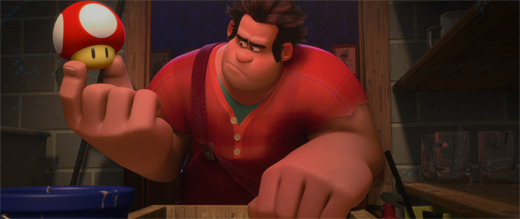
The problem with nostalgia in children's media is the generation gap. To kids, the throwback style of Wreck-It Ralph is outdated and obsolete. Nostalgia doesn't play to child audiences because they have nothing to be nostalgic for. Nostalgia is for adult audiences. Adults are the ones who appreciate cultural shibboleths and throwbacks. Likewise, it’s adult filmmakers who are responsible for their onscreen depiction. If Wreck-It Ralph was a movie for adults, there would be no problem.
Instead, it's a movie for children with subject matter somewhat foreign and alien. The film's target demographic has no frame of reference concerning Golden Age games. This doesn't mean kids cannot or would not appreciate such a style. It simply means the appreciation will not be implicit. The onus is on the filmmakers to demonstrate the era's importance and significance. Kids won't automatically appreciate a classic just because they're told it's a classic.

This interplay between eras makes the movie feel like it has a time-travel element. We see Ralph, a character from 1982, transported into worlds 30 years more advanced than his own. Likewise, audiences in the year 2012 see Ralph and his world, stuck 30 years in the past. The old-fashioned and the newfangled clash, creating chaos. Doubly effective, as it produces both dramatic conflicts, and opportunities for humor.
What's tragic is, all this appreciation doesn't account for anything significant. The admiration for gaming’s golden era is scenery. The movie bends over backwards to accommodate nostalgic games and characters, but keeps these iconic elements distant from the actual plot.
Disney filled the movie with cameos and bit parts from classic arcade characters. Classic figures like Q*Bert, Pac-Man, and Sonic the Hedgehog appear throughout. They make Ralph’s arcade world feel authentic. But these characters don't do anything of direct and unique significance.
The closest any licensed character has to actually interacting with the plot is Q*Bert tattling about Ralph’s departure. The only reason Q*bert fills this role is for a joke about his irregular speech patterns. If Q*Bert couldn’t be licensed, he could easily be swapped out for any other character, be it licensed or a generic stand-in.
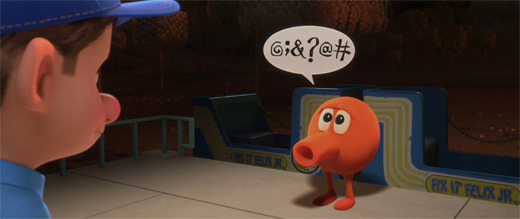
It’s a mixed blessing these trademark figures are kept at arm’s length. True, it’s disappointing Ralph doesn’t go on an adventure with the Mario Brothers. Disney did seem to imply throughout the film’s marketing campaign that would be the case. But if established characters were featured prominently, they’d overshadow Disney’s unique characters. It would be a feature-length commercial. Cameos were the best possible solution, but Disney’s decision to put them front and center in the advertisements was shamefully deceptive.

Seeing these characters onscreen isn't even the best part. Seeing Disney openly endorse these characters is a hallmark moment concerning video games and their place in popular culture. Throughout the 80s and 90s, games were treated ignobly. At best, they were considered a novelty. More likely they were a timewaster and a facetious toy.
It’s strange seeing the change in the zeitgeist. Twenty years earlier, parent groups saw Disney as something wholesome and appropriate for all ages. In contrast, video games were dangerous. They’d corrupt a child’s innocence and melt their brains. For years, activist groups denounced games like Street Fighter for their violent content. Now, Street Fighter characters literally appear in a Disney film.
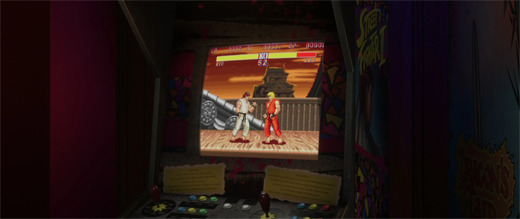
The clash between Ralph's original game and the modern offerings is huge, but the span between eras was stretched to its greatest possible length. Arcades still existed in 2012, but they weren't the cultural touchstone they once were. Advancements in technology and home consoles left video arcades a bygone relic. Many closed down. Those that remained were either in a state of disrepair, or attracting a niche crowd.
With each passing year, arcades become more and more irrelevant. Even by 2012 standards, Wreck-It Ralph seems detached with the reality of video games in modern society. But the film's plot is contingent on taking place in a video arcade. Nowhere else could games produced thirty years apart be presented side-by-side. Wreck-It Ralph came out as late as it possibly could without being a period piece.
Ralph jumps between many arcade games throughout the course of the movie. All of these games are inside one video arcade: Litwak's Family Fun Center. We don't get an accurate representation of how Mr. Litwak's business is faring. Clearly he's been able to keep the business afloat when many others have shut down. But how is his arcade actually faring?
Establishing shots reveal the building is in a low-rent area. It's under a highway overpass with no other businesses in sight. The roadside marquee is missing letters, and the parking lot is becoming overgrown. Mr. Litwak appears to be in his 50s, potbellied and grey-haired. He's been running this business for a while and can't afford to sell or retire. He’s the sole employee, working daily, opening till closing.

The film justifies its mild anachronisms by putting all the evidence onscreen, but not commenting on anything. Arcades are old-fashioned. Mr. Litwak’s arcade is old-fashioned; several cabinets have been in operation for decades. But his arcade is also modern, with trendy new games. So his arcade must be successful. But it's not super successful, hence the crummy building. But it's stayed in business long after the arcade bubble. So it must be popular. But not too popular, as Mr. Litwak has to run the operation single-handedly. Wreck-It Ralph relies on a setting that's only of ancillary importance to the plot. But when that setting requires ignorance of its real-world counterparts, creative license doesn't excuse away the dissonance.
The setting is a small element of the film. The arcade is only a framing device. The patrons and staff establish the stakes and the ticking clock deadline. Well over 95% of the film takes place in the video game world, and that is where the film revels in its design and style.
Ralph lives in a game called “Fix-It Felix, Jr". The game is a fictional creation, invented for the film. It's heavily inspired by Nintendo's 1981 game Donkey Kong and 1984′s Wrecking Crew. Despite being fictional, Disney did create a series of Fix-It Felix Jr. arcade machines to promote the film.

The game is canonically a relic from 1982. It's an 8-bit game, and it's stylized to appear 8-bit onscreen. To all players looking in (and in establishing shots), characters and settings appear pixelated and squared. Within the character's world, these sprites are transformed into full-fledged Disney CGI.

This is where the subtleties of character design are important. Our four main characters come from three different games. These games feature different looking characters. It's essential that these characters represent their respective worlds, but also complement the film as a whole. They need to look correct in their own world, but still look correct when in another world.
Wreck-It Ralph and Fix-It Felix come from an 80s game. They’re supposed to be blocky and pixelated. When they’re rendered in higher definition, they keep their squared and angular features. They look like retro caricatures, even when fully rendered in 2010s-era animation.

Vanellope Von Schweetz is a character from a modern racing game. She’s a cherubic child with soft lines; many curves and few angles. It makes her seem approachable and welcoming. It's paired with contrasting colors and patterns to reinforce her childish demeanor.
The Japanese influence of her game is represented not in her ethnicity, but her chibi-style presentation. Nearly a third of Vanellope's body is her head. A large amount of attention is devoted to her oversized face and hair. Psychologically, it's because big eyes make a character seem young and innocent. Practically, it's because these features are the only ones visible when she's in a go-kart.

Sergeant Calhoun is space marine from a first-person shooter. Being militaristic, Calhoun is decked out in futuristic armor. Her features are harsh, angular, and dark. Everything about her personage is severe and intense. In a movie full of fun-loving weirdos, she means business.
Calhoun is tall, thin, and has an immediately recognizable feminine physique. She wears a form-fitting outfit, especially noticeable in contrast to the bulky, tank-like armor of her fellow soldiers. Her appearance is either a commentary on the objectification of women in video games. A commentary or, perhaps more likely, a reinforcement.

These four characters look dissonant enough to clearly be from different worlds. They have contrasting styles that make them stand out. When they visit different video games, they are clearly foreigners who do not belong in these new worlds. But the characters are also similar enough in design that they don’t break the film’s immersion. They all look and feel as if they are from the same film, drawn by the same animation team. The clashing is intentional, but constructive.

The soundtrack also plays up the film’s 8-bit style. The musical score is synthetic and electric. Everything is centered on the synthesizer. The score tries to emulate the primitive soundboards of arcade machines. It’s of course embellished with the presence of a full orchestra, but the synthesized blips, bloops and scratches are at the core.
In addition to the score, there’s another element of nostalgia in the film’s soundtrack. Buckner and Garcia, a novelty act from the 1980s, reunite to perform “Wreck It, Wreck-It Ralph,” a comedic ode to the fictional video game. It’s a direct allusion to their 1982 hit “Pac-Man Fever,” both in theme and content. It only plays over the credits, but it’s a great Easter egg.
Tragically, all the achievements of Wreck-It Ralph are relegated to the first half of the film. Around the thirty minute mark, the film makes a radical shift in both intent and plot. Ralph and his previously established struggle through the arcade is sidelined. Ralph becomes stranded in a racing game named "Sugar Rush," where he remains for the overwhelming majority of the film’s remainder.
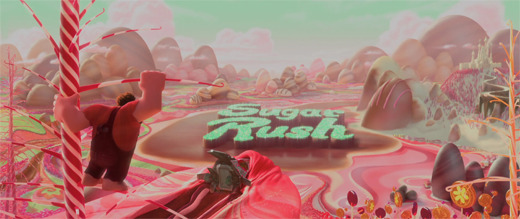
Sugar Rush breaks the movie’s commentary on the culture of video games. Sugar Rush doesn’t make any statement on gaming culture. It doesn't represent a nostalgic moment in gaming history. It doesn't contrast with any game, real or otherwise. Being an original creation with no analogue, it's a plot convenience. It stalls the movie and says nothing.
While the kart-based racing schema is an obvious allusion to Mario Kart, it has no parallel. It's as though the board game Candyland were a racing game, but also reimagined by Japanese Kawaii culture. The J-Pop Sugar Rush theme song performed by AKB48 finalizes this idea. But the movie has absolutely nothing to say about its Japanese influences, or gaming in general. It's like wearing a beret and claiming you're French.
In fairness, Sugar Rush is very clever in design. The implementation of candy and other confectionaries is maximized. Candy-related scenery, characters, and puns abound.

These puns are both a strength and a weakness. None of the wordplay is irredeemably groanworthy, but it is distracting. For large swaths of the film, it’s easy to forget everything is supposed to be taking place inside a video game. Video game characters don't know anything about candy. Why are we focusing so much on candy?
Not to mention how narrowly relevant these jokes are. Understanding the humor of Sugar Rush requires a heavy knowledge of commercially available American confectionaries of the early 21st century. If you don’t live in California, you may not understand the significance of a donut character named “Winchell.” If Laffy Taffy is ever discontinued, its place in the film will seem like an insane non-sequitur. How on earth do localization translators convey the idea of NesQuik-Sand?

Sugar Rush just doesn’t deserve an hour’s worth of attention. Wreck-It Ralph promised a universe of distinct and differing worlds. Instead of exploring this concept, we find the least-representative example and devote way too much of the film’s attention onto it. This literally saccharine wonderland is crammed into a film devoted to digital electronics. No matter how clever the candy-styling, it's completely distracting and irrelevant.
The main plot of Wreck-It Ralph concerns Ralph’s exploration for fulfillment. He’s tired of being the scorned villain. He’s tired of being mocked, jeered, and treated as unimportant while the hero of the game gets all the glory.
As Ralph shares these feelings, it’s an understandable lament. There’s a very real ‘Behind Blue Eyes’ type of sympathy. The world of video games needs bad guys, otherwise there would be no game. But his job shouldn't have to define his person.

And that makes sense to the characters in Ralph’s world, but it’s a confusing lesson to anybody watching the film. Ralph is tired, facing burnout and ennui. He wants to make a change in his life. No one else wants him to consider such a thought. Just expressing this desire is enough to earn admonishments.
To the characters in Wreck-It Ralph, change is bad. As a video game character, he’s programmed to live a certain way, behave a certain way, and never question it. Deviation from the established norm is nothing short of treachery. Your fate has been decided for you, and there’s no escape. Ralph is a villain, a villain he always will be, and shame on him for trying to aspire to be something better. Disney is openly endorsing a caste system.

Wreck-It Ralph is the first Disney movie to feature a villain in the main role. Not that Ralph is himself a villain from the narrative standpoint. Ralph is the bad guy only in his own video game world, but that’s a job. The way the film frames it, he’s an actor performing onstage. When the game ends and the player walks away, his commitment to villainy ceases. He does nothing exceedingly evil or malicious, nor does he want to. The only crimes he commits during the film are moments of neglect. Moments he later atones for.
Every character in every game has the same understanding: it's all for show. They are well aware they are figures inside a video game. They are all performers in simulated combat or adventure. They have their own lives outside their roles in their games. They know they’re putting on a show for the benefit of players.
Except when they’re not. The other characters in Ralph’s game view and treat Ralph as a villain, full stop. They fear him, they disrespect him, they wish he wasn't around. Even though Ralph performs no villainous deeds beyond the game's narrative. Everyone treats Ralph like a beast despite them working together for decades.
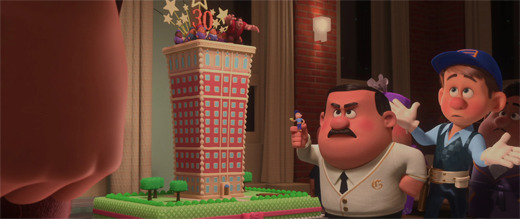
If the film was a parable on prejudice, the movie would have a point. If every bad guy in every game was treated as a second-class citizen, it would make sense. That’s not the case. Ralph gets ostracized, profiled, and shunned, and that's a unique case. Everyone else goes about their business as usual.
If Ralph himself was particularly offensive, the movie would have a point. Ralph could assume everyone hates him because he’s a villain in the game. When instead everyone hates him because he’s rude, boorish, and judgmental. If Ralph had internalized his role as a villain and acted like a monster, it would make sense. The moral could be not to let a hard world turn you hard. That’s not what the movie is about either.
It’s hard to say exactly what Wreck-It Ralph is about. Ralph craves respect from the other residents of Fix-It Felix Jr. So he wanders along, looking for signifiers of glory and achievement. He sneaks into a war-themed game, earning a medal to literally represent his capabilities. From the moment he puts on the armor to claiming the medal, nine minutes have passed.

From there, Ralph accidentally winds up in Sugar Rush. There, he befriends Vanellope; an ostracized racer, shunned for her tendency to glitch. Ralph identifies with her struggle. He helps her build a go-kart, defraud her way into a race, and get revenge on the others who‘ve treated her poorly. Ralph is no longer the main character of his movie. He goes wherever the movie sends him, not concerning himself with postponed or forgotten objectives. "I guess I'm doing this now" doesn't indicate a strong character arc.
There’s a lot of worldbuilding in this movie, and it’s doled out in limited proportions. Information and details are distributed only at the last possible moment. It makes the dialogue seem more organic, less expository. For example, throughout the film, characters are fearful that Ralph is “Going Turbo.” The phrase is used twice without any further elaboration. It's a common idiom to the arcade denizens, but we the audience can only guess what it implies through context.
It’s not revealed until much later what “Going Turbo” is and what it refers to. When it happens, we're already inundated with other revelations, doled out in proper proportions. Vanellope’s true nature in Sugar Rush is inconsistent, placing her in the center of a conspiracy. Meanwhile, a computer virus is rapidly spreading, lurking in the peripheries, ready to destroy an entire world unprepared to defend itself. Beyond that, Sergeant Calhoun’s history is revealed in fragments. Her backstory is played entirely for laughs, mocking overused clichés to an extreme. But it’s still character development; it turns an otherwise one-note character into a multifaceted figure.

Ralph and Vanellope’s friendship is a unique aspect of the film. Being from two literally different worlds, the two would seem to have nothing in common. Instead, they find common ground, being demeaned and unwanted.
They also share an incredibly childish sense of humor. They have a special fondness for name-calling, insults, and butt jokes. It makes the friendship between a sarcastic child and an immature adult seem authentic. I'm glad those two enjoy it, because the sophomoric jibes get irritating quickly.

The worldbuilding is strong, it’s just focused in all the wrong areas. The commentary on video games is half-formed. At first, it seems as though Ralph is going to visit a variety of games, never meshing with the new worlds. As though the film was setting up a “There’s no place like home” moral. His first foray into the action shooter Hero's Duty certainly implies such a plot. Ralph is excited for a new world, never anticipating a downside to the unfamiliarity. Hero’s Duty is violent and extreme, unnerving him within moments.
Partway through the onslaught, Ralph outwardly questions, “When did video games get so violent?” This is the only real statement Wreck-It Ralph has concerning video games. It’s brought up, and dropped just as quickly. Video games can be violent; A masterpiece of an observation.

It should be noted, Hero’s Duty isn’t an accurate portrayal of an M-Rated first person shooter. This is a Disney film, after all. Instead of semiautomatic rifles, the game features futuristic laser guns. They shoot inoffensive laser beams, complete with “Pew Pew” sound effects. Instead of enemy soldiers, everybody is fighting insects. The insects don't even bleed, but explode in colorful, gooey messes. It’s a very cartoonish interpretation of violence.
When Ralph enters Sugar Rush, he bemoans the cutesy environment and theming. It’s another locale he doesn’t like, and another reminder his true home is the one he abandoned. It’s also another reminder of the film’s botched premise and missed opportunity. Sugar Rush is the second and final video game Ralph explores looking for purpose.

Ideally, Ralph should be exploring multiple worlds and gaining multiple perspectives. Everywhere he visits should remind him he's an outsider looking in. That his purpose at home, while ignoble, was necessary. He should be learning this from multiple worlds with multiple themes in multiple art styles. He visits two worlds.
The credits are an insult, reminding us of the bait-and-switch tactic. We see Ralph, Vanellope, Felix and Calhoun reinterpreted in a variety of digitized style. They’re depicted in various games, in various worlds, interacting with various characters. This afterthought, stuck in after the movie ends, uses the Wreck-It Ralph concept better than Wreck-It Ralph itself.

Wreck-It Ralph is a movie that tries to be two different types of stories. A movie that wants to explore a strange world needs to emphasize the world by having static characters. Movies that feature characters growing and developing need to keep focus on the character and their journey. Wreck-It Ralph changes objectives partway through the movie, never fully completing either. The vast world of video games is left sidelined, unvisited and unexplored. Ralph earns the acceptance by his video game cohabitants without explaining why everybody’s attitudes have changed.
The movie is overly ambitious and fails to meet the lofty promises it makes. It has interesting ideas and styles, but lacks a central focus or sense of purpose. With nothing to anchor the film, the entire escapade feels pointless. It truly does feel like the retro gaming aesthetic was chosen first, and the story was an ignored afterthought. When only 30 minutes of plot could be based on the principle idea, the writers were forced to supplement the feature with a second story.
Wreck-It Ralph was designed as a nostalgic visit to a bygone era, but nostalgia is toxic. Reminiscing is fine, influences are fine, retro stylization is fine. As long as it’s done with a purpose. When an admiration of the past is at the expense of development and innovation, you demonstrate that your memories are more important than anyone’s future. An interesting inspiration isn’t worth a malformed final product. Sometimes nostalgia can blind us to wreckage.
Beauty and the Beast
Fantasia
The Lion King
Snow White and the Seven Dwarfs
Cinderella
Alice in Wonderland
Sleeping Beauty
Mulan
Tangled
The Little Mermaid
Aladdin
Lilo & Stitch
The Many Adventures of Winnie the Pooh
Pinocchio
The Jungle Book
Robin Hood
The Sword in the Stone
Bambi
The Emperor’s New Groove
The Hunchback of Notre Dame
The Princess and the Frog
The Great Mouse Detective
101 Dalmatians
Bolt
The Three Caballeros
Lady and the Tramp
The Rescuers Down Under
Atlantis: The Lost Empire
Wreck-It Ralph
The Fox and the Hound
Fantasia 2000
Peter Pan
Dumbo
Hercules
Meet the Robinsons
Brother Bear
The Black Cauldron
Melody Time
Oliver & Company
Treasure Planet
Tarzan
The Rescuers
Pocahontas
Saludos Amigos
The Adventures of Ichabod and Mr. Toad
Winnie the Pooh
The Aristocats
Dinosaur
Fun and Fancy Free
Make Mine Music
Home on the Range
Chicken Little
#Wreck-It Ralph#Disney#walt disney#Walt Disney Animation Studios#disney studios#Disney Canon#Film Criticism#film analysis#movie review#Wreck It Ralph#WIR
15 notes
·
View notes
Text
Winnie the Pooh at 35
A review by Adam D. Jaspering
It’s not an exaggeration to say The Princess and the Frog was a mistake. Not the quality of the film, but its production. A series of independent decisions were made to try and capitalize on nostalgia. Instead of the movie being a fun throwback, it seemed outdated and irrelevant. Disney’s plans relied on an audience reception that never materialized.
Disney had made unpopular and unsuccessful movies before. If The Princess and the Frog had been another one, the company would have moved along. But this was not an ordinary misfire. This movie was supposed to be the vanguard of new regime at Disney.
Disney Animation invested a significant amount of money and resources into The Princess and the Frog. They expanded their animation department, fully expecting to capitalize on the film's success. They were fully ready to produce a stream of 2D animated features for a hungry audience. But that audience didn't exist.
The bold initiative was an expensive lesson in hubris. Not only did The Princess and the Frog lose money, it demolished any hope for further 2D follow-ups. Disney had a bloated, unusable animation department. Hand drawn animation was a white elephant. Too expensive to maintain, not popular enough to use.
Disney failed to capture audience interests with a 2D animated film capitalizing on nostalgia. Worst still, they had already greenlit a second 2D animated film capitalizing on nostalgia. The company had one hope to prevent a second humiliating defeat. Disney would have to cut every single corner on their new feature, Winnie the Pooh. Even if it meant releasing an unfinished film.

Winnie the Pooh began development when The Princess and the Frog moved to post-production. At some point, the film's production overlapped with The Princess and the Frog's debut. The ensuing financial clamor caused Disney's executives to make their presence known. Whatever plans the filmmakers had, they were going to be unceremoniously scaled back.
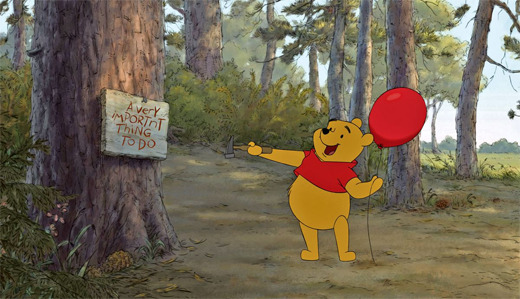
Disney was in an unwinnable situation. In 2011, a 2D film would not pay dividends. However, Winnie the Pooh was too far along to scrap production. The CGI division of Disney Animation was involved with their own projects, so it couldn’t be converted to 3D. A video release was out of the question, as too much money had been invested in the project (A theatrical release could break even, but a home video release was a guaranteed loss). Winnie the Pooh would have to be completed and released in theaters somehow. All Disney could do was oversimplify to soften the impact.
If Disney was going to hobble a film, a Winnie the Pooh film would be an acceptable casualty. There has never been a shortage of Winnie the Pooh media from Disney. One underserved movie would be a small speck in the franchise's ocean. There is more than enough to compensate.

Aside from the original three cartoons that comprise The Many Adventures of Winnie the Pooh, there was only one other theatrical short. Winnie the Pooh and a Day for Eeyore was released in 1983 alongside a re-release of The Sword in the Stone. By the 1980s, theatrical shorts were an outdated medium. Instead, the popularity and profitability of Pooh Bear would be represented in other formats.
On TV, there were animated series, such as The New Adventures of Winnie the Pooh in 1988, and My Friends Tigger & Pooh in 2007. There were also puppet adaptations, including Welcome to Pooh Corner in 1983, and The Book of Pooh in 2001.
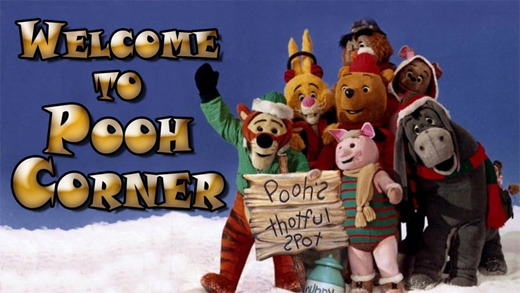
There were also animated holiday specials such as Winnie the Pooh and Christmas Too (1991), Boo to You Too! Winnie the Pooh (1996) A Winnie the Pooh Thanksgiving (1998, further removing Disney’s Pooh from his British origins) and Winnie the Pooh: A Valentine for You (1999).These shorts were also released on home video.
To complement the burgeoning video library, Disney produced several full-length, straight-to-video films. 1997 saw Pooh's Grand Adventure: The Search for Christopher Robin. Shortly after were 1999′s Winnie the Pooh: Seasons of Giving, 2002′s A Very Merry Pooh Year, 2004′s Springtime with Roo, and 2005′s Pooh's Heffalump Halloween Movie.

And strangely enough, there were even feature-length Winnie the Pooh movies released theatrically. 2000 brought us The Tigger Movie. In 2003, there was Piglet’s Big Movie. Finally, there was Pooh’s Heffalump Movie in 2005.
These three theatrically released films were produced by Disney’s ancillary animated studios. Piglet’s Big Movie and Pooh’s Heffalump Movie were made by DisneyToon Studios. The Tigger Movie was made by Disney Television Animation. A theatrically released film is a strange assignment for a studio with “Television Animation” in its name, but here we are all the same.
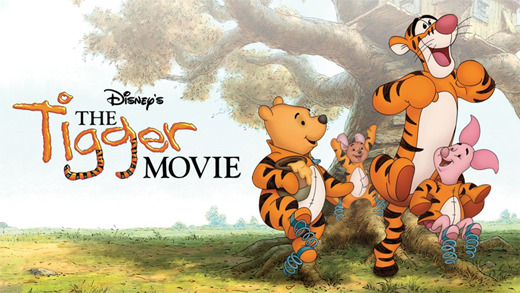
In short, fans of Winnie the Pooh have never had to want for more Winnie the Pooh media. It has been in a semi-constant state of production for decades. There has always been more Winnie the Pooh to see and experience. 2011′s Winnie the Pooh was nothing special. Disney made Winnie the Pooh films. They made theatrically released Winnie the Pooh films. But Disney Animation Studios, the elite animators of the corporation, had a certain level of clout. The 2011 film’s greatest asset is a symbolic façade of prestige and authenticity.
Ironic, as the release of 2011′s Winnie the Pooh caused the slew of Winnie the Pooh media to taper off. Only when Disney Animation capitalized on the brand did it lose its drawing power. From 2000-2009, there were ten Disney productions featuring Pooh. From 2012-2022, there has been one.
Not to imply Winnie the Pooh is such a bad picture that it turned the brand radioactive. Most likely, it was a coincidence. The film is exactly what you would expect. It’s Winnie the Pooh and all his friends, just as it should be. Just as it always has been. Pooh and his friends play games, go exploring, and they learn valuable life lessons. It’s very approachable media for young audiences, and very inoffensive for parents and guardians.
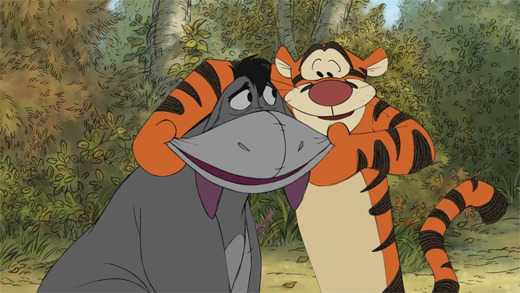
The characters are just as we remember them. Pooh is well-meaning, but a slave to his irrepressible stomach. Piglet is timid and easily frightened. Tigger is energetic and headstrong. Eeyore is gloomy, and so on.
The exception is Christopher Robin, who’s been significantly redesigned. His yellow rugby shirt and shorts are replaced with a school uniform. The costume change in itself isn't an issue. It’s the old-fashioned style which hurts the film. Previous Winnie the Pooh outings can conceivably take place anytime. Now, it is very assuredly set in a dated, bygone era.
The real unnerving change are Christopher Robin's eyes. His once beady eyes are now bold and full-featured. Eyes are the single most expressive parts of an animated character’s design. To see them change with such severity is unnerving. That’s not Christopher Robin, that is some imposter.

1977's The Many Adventures of Winnie the Pooh, as the name implied, was a package film. It featured three different, independent stories. 2011′s Winnie the Pooh does away with such a format. It tells one elongated story, albeit with three different focuses. The first, the citizens of the Hundred Acre Wood try and fail to find a replacement for Eeyore’s missing tail. The second, a note left by Christopher Robin is misinterpreted as a call for help to defeat a monster. Third, as is common in most all Winnie the Pooh media, Pooh Bear is in search of honey after depleting his supply.
The Many Adventures of Winnie the Pooh was an adaptation of thirteen chapters from the works of A. A. Milne. Initial plans for the 2011 film involved adapting five chapters. Already a significant step down in scope, things would get worse. After some reworking, only three chapters were adapted. Disney was already planning to make a feature film from roughly 45 pages of source material, and that paltry source was reduced by two-fifths.

When studio execs scaled back the film's boundaries, it left gaping holes in the script. Storyboard artists and screenwriters needed to patch over holes in the story. Which would explain why the narrative meanders.
As mentioned in my previous review, Winnie the Pooh uses the word “Adventures” in a very generous way. These are simple stories featuring simple characters, designed specifically for young audiences. They're not complex, but engaging. But despite the simplicity, there was always a sense of purpose. The characters have wants, they experience obstacles, and they achieve goals. The stories have definite beginnings, middles, and ends.
But here, there’s a significant difference. The low stakes seem even lower. Low to the point of inconsequential. Characters don’t seem as if they have any motivation to do anything. They stumble around, drifting in and out of various settings, never fully concerned with what's happening around them. There’s an extended series early on where Pooh and Tigger play with a red balloon. Then they stop playing. The balloon doesn't disappear, they don't get bored, they just stop as easily as they started. The movie halts for a minute then resumes right where it left off.

There is nothing happening onscreen that is worthy enough to warrant a feature film. Everything is underwritten and immaterial. The movie resorts to constant motion to hide its lack of substance. Pooh sets out to find honey, and gets distracted setting up a contest to find a new tail for Eeyore. Nobody ever finds a tail for Eeyore, so Pooh wanders off, looking for a missing Christopher Robin. Midway through the search, he realizes he's hungry and wants honey again. So he wanders off again. Pooh is admittedly a bear of very little brain, but he apparently has attention-deficit disorder, too.

Irrelevant of the film or any Winnie the Pooh adaptation, I need to openly ask: where does Pooh gets his honey in the first place? There are no markets in the Hundred Acre Wood. No apiaries or beekeepers. No traveling honey merchants. Christopher Robin is never seen arriving with a wagon full of honeycomb. But somehow Pooh and friends always have several ceramic crocks of honey at their disposal. Pooh always magically has honey until the plot necessitates he doesn't. Not the most dramatic inciting incident, but at least its narratively consistent.
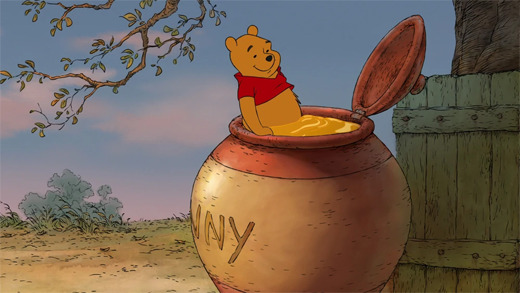
The Winnie the Pooh franchise has always emphasized characters and experiences over story. If that were the case here, everything would be fine. The franchise is about characters and experiences over story. Except that the film very much wants to tell a story, it just doesn’t want to present actual storytelling elements.

Pooh goes out looking for honey, but gets distracted talking to Eeyore about his missing tail. So Owl suggests organizes a contest to find a replacement for Eeyore’s tail, then disappears when the contest starts. It's presided over by Christopher Robin. We then follow Pooh, wandering off, finding a letter explaining Christopher Robin’s absence, despite being present a moment ago. When Pooh and friends begin searching for Christopher Robin, Tigger and Eeyore branch off to form their own independent search party, not telling anyone. Nobody concerns themselves with Tigger and Eeyore missing, despite their ongoing concerns with finding a missing person.
The movie's biggest moment of peril is Pooh and friends falling into a large pit. Pooh, as he is has demonstrated so many times so far, finds the way out by getting bored and wanting to be elsewhere. He forms a ladder and climbs out. It may be for this reason exclusively that Gopher is absent from the film; his presence would make the small problems even smaller.
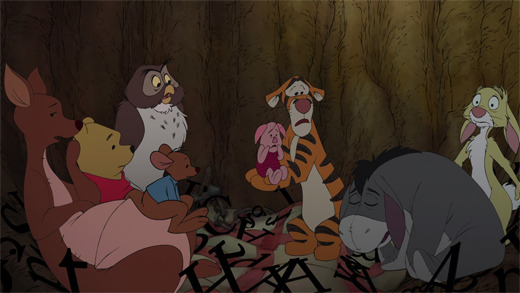
We don't fulfill plots, we forget about them in favor of new distractions. Resolutions don't come. The only obstacles were self-imposed mistakes. The only goals were self-established. The only outcomes were a return to stasis. These plot elements are like spinning plates; they keep spinning, nothing stops, but more and more plates are still added.
And when those plates do stop, they land with a thud. All the problems encountered by Pooh and his friends are resolved by learning they had no problems at all. Christopher Robin was never missing; he was at school for the day. The mysterious “Backson” monster haunting the woods doesn’t exist; Owl misread Christopher’s note, assuring he’d be “back soon.” Eeyore’s tail wasn’t missing; Owl had it the whole time. These resolutions make everything seem trivial and pointless. Nothing that happened onscreen mattered. The film has so little story, and there’s even less than previously implied.

The movie has so little to offer. It's outshined by the so-called lesser Winnie the Pooh theatrical and home video releases. The animation is better, but due to the simple designs of the characters, it’s a minor detail. There’s not even any shading. All attention is placed on the water colored backgrounds. But these trees and trails and brooks that all begin to look the same after time.
Nothing about Winnie the Pooh is particularly engaging, exciting or even unique. Christopher Robin disappears from the Hundred Acre Woods. He leaves a note, explaining he is going to school. The note is misread, leaving his friends to believe he is in danger and needs rescue. This is the exact same plot as the straight-to-video Pooh’s Grand Adventure: The Search for Christopher Robin.

Disney cut details, features, plot elements and concepts. Everything overly complicated or extraneous was exorcised. Only the barest elements of a film remain. The runtime of Winnie the Pooh is only 63 minutes long. It’s not the shortest film in the Disney canon, but it is the second.
Even calling Winnie the Pooh a 63-minute film is generous. The film has ten minutes of closing credits.
Desperate to pass the hour mark, the runtime is stretched to the breaking point with a clever inclusion. Three and a half minutes feature credits superimposed over the live-action bedroom of Christopher Robin. His plush toy counterparts of Pooh and friends are on display for us, the viewer. He’s arranged his stuffed animals along with other household objects. Each setup mimics a moment from the movie. We see how the animated imagination is associated in the real-world. Winnie the Pooh is the product of one boy’s imagination. We are privy to that imagination.
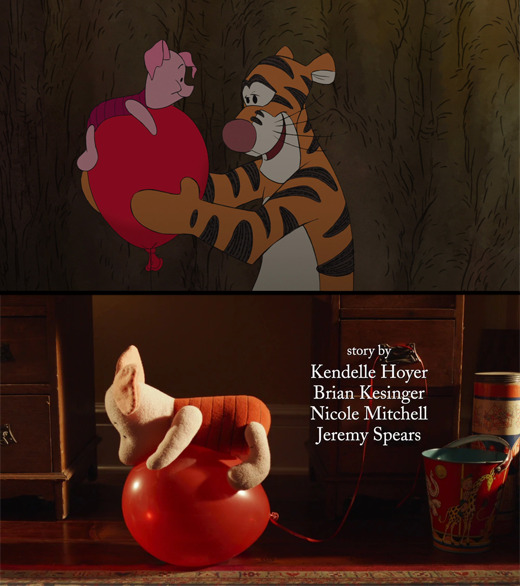
Playing over the credits is the song “So Long,” written and performed by music duo She & Him. The indie-folk duo found success with their mellifluous vocals and gentle instrumentation. The pair are an absolute perfect choice to represent the works of A. A. Milne in the 21st century.
While most of the music from the film is performed by the cast, vocalist Zooey Deschanel and guitarist M. Ward contribute where they can. This includes an updated version of the Sherman Brothers’ Winnie the Pooh theme. Updated, in that Tigger’s name is awkwardly crammed into the character roll call. Just another clumsy decision.

Winnie the Pooh is not only a mangled story, it’s unoriginal and insultingly short. There was a very real chance people would eviscerate the film upon release. To appease their investors, Disney needed a scapegoat. Some supposedly unavoidable element to blame for the minimal returns.
Disney released Winnie the Pooh on July 15, 2011. The same weekend as the most anticipated and highest grossing film of 2011, Harry Potter and the Deathly Hallows: Part Two. The small grosses could be blamed on being outmuscled at the box office, and not studio decisions.

In summation, Winnie the Pooh is a movie in name only. There’s no feature, and it’s not long enough to be a film. The plot is a pile of threads without any purpose or reason, resolving in anticlimactic ways. What it has to offer has already been offered by Disney before. There are small inclusions that magnify the squandered potential, making us lament what could have been. The entire presentation has an “abandon ship” mentality. The filmmakers wanted to finish the film as quickly and effortlessly as possible. A disingenuous, but effective strategy; the film cost $30 million to produce, earning back just shy of $50 million.
While Pooh Bear is one of the most beloved characters in the Disney pantheon, the 2011 film adaptation is a great disservice. Filmmakers and studio execs shirked their duties. An official statement has never been made, but the evidence is staggering. Disney purposefully made an unworthy film in an attempt to salvage their own reputations. And for a franchise that’s built on simplicity and innocence, it’s all the more disheartening.
Beauty and the Beast
Fantasia
The Lion King
Snow White and the Seven Dwarfs
Cinderella
Alice in Wonderland
Sleeping Beauty
Mulan
Tangled
The Little Mermaid
Aladdin
Lilo & Stitch
The Many Adventures of Winnie the Pooh
Pinocchio
The Jungle Book
Robin Hood
The Sword in the Stone
Bambi
The Emperor’s New Groove
The Hunchback of Notre Dame
The Princess and the Frog
The Great Mouse Detective
101 Dalmatians
Bolt
The Three Caballeros
Lady and the Tramp
The Rescuers Down Under
Atlantis: The Lost Empire
The Fox and the Hound
Fantasia 2000
Peter Pan
Dumbo
Hercules
Meet the Robinsons
Brother Bear
The Black Cauldron
Melody Time
Oliver & Company
Treasure Planet
Tarzan
The Rescuers
Pocahontas
Saludos Amigos
The Adventures of Ichabod and Mr. Toad
Winnie the Pooh
The Aristocats
Dinosaur
Fun and Fancy Free
Make Mine Music
Home on the Range
Chicken Little
#Winnie the Pooh#Winnie the Pooh 2011#Disney#walt disney#Walt Disney Animation Studios#disney studios#Disney Canon#Film Criticism#film analysis#movie review
4 notes
·
View notes
Text
Tangled at 35
A review by Adam D. Jaspering
Tangled was an important milestone for Disney. After years of experimentation and practice, Disney’s animators were finally comfortable and proficient in the use of CGI animation. Thankfully, they hit the milestone in time for their 50th animated film.

No more was CGI considered the inferior alternative to hand-drawn animation. It wasn’t met with “good enough,” or “nice, considering the circumstances.” Computer animation was finally meeting the quality expectations indicative of the Disney brand. But such an achievement didn’t come easy.
Animated films, like any film, are beholden to the screenplay. The movie was first conceived by Glen Keane. Keane had been animating for Disney since the 1970s, and was supervising animator through much of the Disney Renaissance. For his achievements, he was given the opportunity to direct a film. He chose to adapt a version of the fairy tale Rapunzel. That would be the final easy decision of the filmmaking process.

The earliest version of Keane's movie dates back to 1996. A far cry from film we know as Tangled, this version was named “Rapunzel Unbraided.” This treatise was a genre-bending farce. Two modern-day teenagers, a jaded couple with relationship issues, found themselves transported into a storybook. There, they were forced to assume the roles of Rapunzel and her prince. It would be a satirical work, lampooning fairy tale plots and overused tropes.

The concept was scrapped in the early 2000s. For starters, Shrek was released partway through the film’s conception. Rapunzel Unbraided now looked like a copycat. More significant were the technical problems. In their attempt to pivot to computer animation, Disney wanted Rapunzel Unbraided to be fully digital. The animation staff knew their limitations. Anything they could offer would be subpar. As such, Keane proposed a compromise: Make digital animation that emulated hand-drawn animation.
Instead of the round, textured imagery associated with CGI, animators would instead produce flat models. These models would be colored in high contrast shadows, giving it a cel-shaded aesthetic. They would then be propped up against a background that looked painted. It was 3D animation, trying to hide its third dimension.
Mock-ups and concepts were produced, but it was all for naught. The concept was ambitious, but universally recognized as unfeasible. Doubly so for a feature-length production. The proposed art style would eventually be used in later Disney animated shorts Paperman and Feast.
A new treatise, "Rapunzel," was devised in 2003. This version was closer to the original Grimm Brothers tale. Keane wanted this incarnation to be atmospheric and foreboding, akin to Disney’s Hunchback of Notre Dame.
Sadly, Keane never saw his vision fulfilled. He stepped down as director in 2008. It was private knowledge at the time, but he suffered a heart attack and didn’t have the stamina to complete the film. Instead, Disney turned the project over to Byron Howard and Nathan Greno, the director and the storyboard director of Bolt. Keane remained onboard as producer and animation supervisor, serving in a less-intensive capacity.
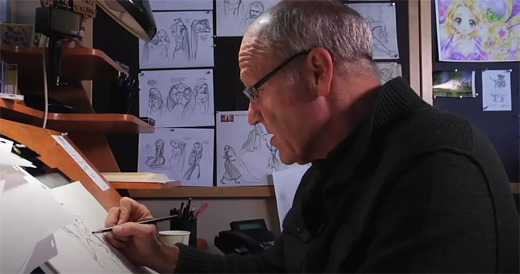
Greno and Howard authorized another overhaul. Characters, story, and settings were rewritten and redesigned for a third time. The movie was finally released in November, 2010. A mere 14 years after its initial pitch.
Several movies in Disney history have had prolonged developments. Alice in Wonderland and The Black Cauldron were conceived decades before their production started. In the meanwhile, they were shelved; nobody was working on them, and they never cost the studio a dime.
In other instances, movies were forced into rewrites or reconceptualization. In extreme examples, both Beauty and the Beast and The Emperor’s New Groove were changed into entirely different films mid-production. But even these radical decisions only lengthened the 4-year production window by several months.
Tangled had both a prolonged development and massive overhauls. In all its different iterations, Tangled was in a constant state of production and pre-production for nearly a decade and a half.
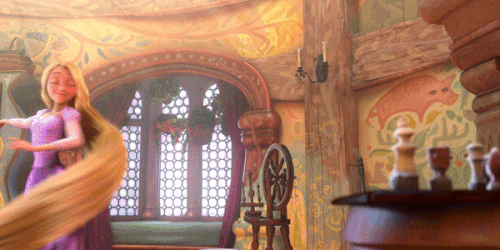
To put it simply, Tangled was an expensive movie. The production cost was $260 million. The Princess and the Frog cost only $105 million, while the upcoming Wreck-It Ralph would only cost $160 million. Tangled is the most expensive animated film ever made. At the time of writing, it is currently tied as the 12th most expensive film of all time.
To maximize returns, Disney analyzed the impact of The Princess and the Frog. It was agreed, the biggest marketing mistake was the film’s title. Selling a film as a princess tale was detrimental; boys were turned off, assuming the film wasn’t for them.
Disney wouldn't repeat this mistake. They deliberately advertised the film as an action comedy, not a fantasy romance. Posters and trailers featured both the hero and heroine as equally important. Finally, Rapunzel’s name was removed from the title. The movie was given a new title, Tangled. It doubly represented Rapunzel’s trademark long hair, but also the intertwined fate of the two leads.

Several staff members met this name with derision. The purpose of adapting the Rapunzel story was the pulling power of Rapunzel’s name. However, that pulling power only exists if audiences can immediately recognize the film as a Rapunzel movie. Rebranding may have been unavoidable, but surely there was a better solution than renaming the film to a generic one-word adjective.
In the end, the studio executives got their way. Whether the title itself contributed to the film’s success is unknowable. However, it did spawn a new trend in animation. Multiple studios, Disney included, trended towards simpler, one-word titles. They were short, they were punchy, they were direct. They represented the idea studios were trying to convey: these weren’t the classic fairy tales you grew up with. These were newer, cooler, and most importantly, trademarked interpretations.

As told by the Brothers Grimm, Rapunzel is an antiquated and absurd story. Most everybody knows the basic elements. The story is of a young woman, trapped in a tower by an overbearing guardian. Unable to leave, her hair grows uncontrolled and uncut. The only way to enter or exit the tower is using Rapunzel's hair as a ladder.
Most people forget (or never knew) Rapunzel was barely the main character of her own story. The first half of the tale takes place before her birth. It involves her parents stealing vegetables from a witch’s garden. The witch claims Rapunzel at birth as payment for the theft. It's her that keeps Rapunzel hidden away. As a final insult, the witch names Rapunzel after the stolen produce. "Rapunzel" isn't supposed to be a name at all, but the German word for Lamb’s Lettuce.
Like Beauty and the Beast, Disney knew the best course of action would be to discard the classic story. There were too many elements that would seem silly and superfluous to modern sensibilities. There was also too little focus on Rapunzel herself. The hair, the tower, and the witch were the only parts that would remain.

In place of the discarded elements is a braided plait of plots. Three separate stories intertwine. The first, an old woman discovers a magic source of eternal youth. She keeps the enchanted flower exclusively to herself for centuries, elongating her life. One day, the local regent pursues the legend to save his ailing wife. He takes the flower, heals the queen, and unknowingly passes the restorative properties to their unborn daughter. The selfish crone kidnaps the child, raising it as her own, desperate to keep access to the magic.
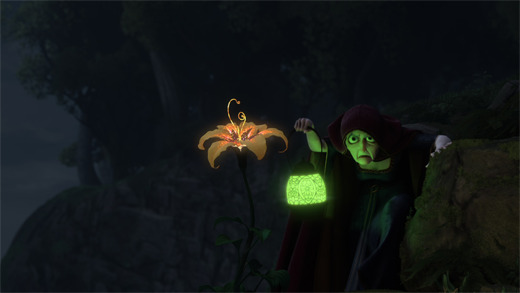
Second, a young thief steals the crown jewels of a local kingdom. Pursued by the palace guards, he betrays his accomplices. On the lam, he must keep distance from his growing list of adversaries. He makes an unlikely ally as he tries to keep both his life and his ill-gotten gains.
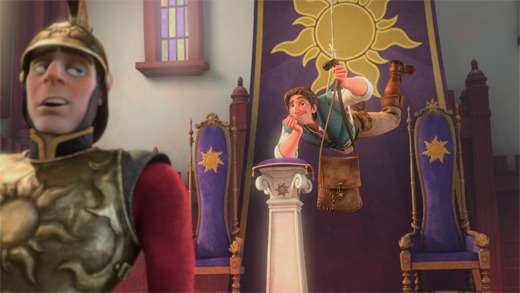
Third, A young girl on the cusp of her 18th birthday longs to see the world outside her confining home. Kept in seclusion and isolation by her adoptive mother, she concocts a plan to escape. She has one goal, meager as it may be, to attend an annual festival featuring sky lanterns. These lanterns are the only sign of the outside world she can see from her window.

These are the plots of Mother Gothel, Flynn Ryder, and Rapunzel, our villain and two heroes, respectively. Tangled is a feat in storytelling. Characters and elements are used to their fullest extent. The three plot threads overlap, intertwine, crisscross, double back and converge to create a style of storytelling unique to Disney. We see a wide range of traits in a variety of circumstances against a panorama of supporting characters. There’s never an opportunity for things to get static.
Pared down to its barest essence, the movie has one core component: Rapunzel has long hair. Not just long, unfathomably long. Seventy feet long, according to official sources. Longer than anyone could ever grow in real life. This is the central hook of the film.

Rapunzel's hair is used as a ladder, just as it was in the original fairy tale. But that's only the starting point. Disney doesn’t throw away the opportunity for creativity available to them. What all could a person do if forced to carry 70 feet of unkinkable, unknottable, unbreakable hair?
Rapunzel uses her hair as a rope. She uses it as a snare. She lassos with it. She swings with it. She rappels with it. She uses it as a whip. She uses it as a nearly-prehensile appendage. There are so many uses, major and minor, explored in great lengths. For essential plot progression, for individual quirks, and for one-off jokes. The creativity and its implementation are perfect.
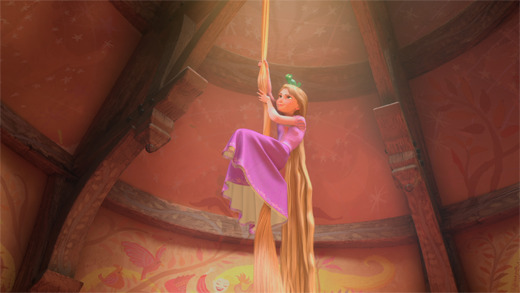
Being the central focus of the film, the animators absolutely had to get the weight and movement of Rapunzel’s hair correct. It couldn’t be a hard piece of shellac, or lifeless like a flopping piece of fabric. It had to look like hair, move like hair and feel like hair. And that meant drawing it like hair.
In total, over 140,000 individual strands of hair had to be accounted for. The animators could have hypothetically animated Rapunzel's tresses just like the rest of the film. That would be the hard way. Instead, animators employed a recently developed computer program.
A specific subset of animators were tasked exclusively with animating Rapunzel's hair. Rapunzel's hair had 173 reference points. Animators could choose which points moved where, and what they interacted with. The computer then handled gravity, friction, collisions, and inertia.

Further complicating matters were the lighting and shadowing effects. Rapunzel's hair isn't just blonde, it has a radiant gold luster. Literally; it illuminates in several scene. As such, each strand of hair couldn't be a 2-dimensional thread, but a microscopically hollow tube. Light effects needed to flow through each strand, lighting it up like fiber optics.

With the hardware limitations of the time, it took over 30 hours to render a single frame. At 24 frames per second, multiplied by a 100 minute runtime, Tangled’s enormous production window makes even more sense.
This dedication to craftsmanship is evident throughout. There’s a unique style to Tangled, making it look unlike anything else offered by Disney. The saturation and use of color emulates an oil painting. Specifically, animators drew inspiration from the Rococo art movement. The artwork of painter Jean-Honoré Fragonard was used as references by the animators. As a result, Rapunzel’s violet dress and yellow hair are dynamic contrasts to the verdant greens and ruddy browns that surround her.

The violet and gold color scheme are further explored at the kingdom of Corona. An entire city on an island surrounded by a bright blue sea, Corona is the kingdom Rapunzel was spirited away from as an infant. In honor of the lost princess, the citizens light candles in her memory.
The entire kingdom of Corona was modeled on the French castle and commune, Mont St. Michel. Despite this, there’s nothing specifically French about Corona or all of Tangled. The film has a deliberately conflated identity. It’s representative of no place and no era. It possesses an unmistakable Old World charm, but no parallel beyond that. Some elements are reminiscent of the dark ages, while others resemble the 18th century. They all intermingle, creating a fantastical land to accompany its magic. It’s not quite France, not quite Britain, not quite Germany; it’s everywhere and nowhere all at once. This also conveniently excuses everyone having American accents.
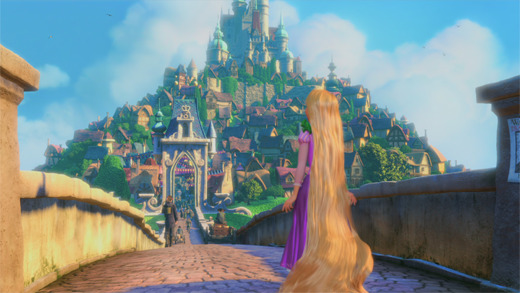
The film's villain is Mother Gothel. A woman of indeterminate age, she is physically in her 40s, but actually centuries old. She's become reliant on the rejuvenate magic present in Rapunzel's hair. It is the only thing keeping her alive, requiring its use on a weekly basis.
Gothel is a special class of villain, not seen since Lady Tremaine from Cinderella. She’s not particularly strong or powerful, but she is conniving, malicious, and evil all the same. She doesn’t need to strike down Rapunzel with her hand when she can instead break her spirit.
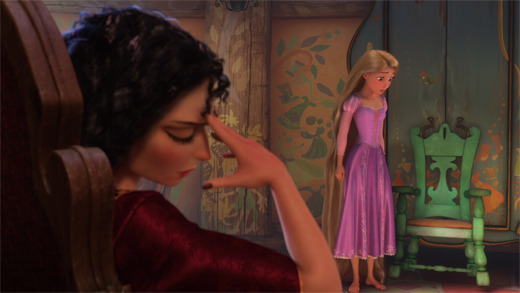
Her sole motive is also her greatest weakness as a character. Gothel is for all intents and purposes immortal. But she doesn't do anything with that immortality. We don't know what she wants, or what she does with all her free time. She clearly has a life somewhere, independent of Rapunzel. But everything she is and everything she does revolves around keeping Rapunzel hidden and subservient. Gothel's life is a tautology. She prolongs her life so that she can live a life devoted to prolonging her life.
Kidnapped from her birth parents as an infant, Rapunzel has only known Gothel as her mother. For her entire life, Rapunzel has been subject to Gothel’s mind games. Rapunzel is repeatedly told the world is treacherous and dangerous. She's told she's far too weak and powerless to brave the risks. And with no frame of reference, Rapunzel is forced to believe the lies.
Rapunzel’s tower is both her prison and her home. She’s lived alone for her entire life. She has no communication with the outside world and limited resources to fill her days. What does she do with such little space and so much time? Whatever she can.

The film’s opening song, “When Will My Life Begin,” demonstrates the frustrations of an extrovert forced to live the life of an introvert. Rapunzel has a multitude of hobbies and interests. Some she's passionate about. Some are distractions. Some are self-appointed busywork. She's blithely frustrated with her unfulfilling and unrealized life.
We see the various skills and abilities Rapunzel has acquired through rote repetition. While it's an enthusiastic way to start the film and introduce Rapunzel, there is a missed opportunity for foreshadowing. None of the skills she demonstrates are revisited throughout the film. We're told she's adept in guitar playing, ventriloquism and papier-mâché. She's shown being skilled in close-quarters combat, using a frying pan as a weapon. What could have been a great storytelling opportunity is just a series of one-off sight gags.

Rapunzel as a character is defined by her circumstances. Living sheltered and alone for nearly 18 years, she has a childlike disposition. She's naïve, trusting and optimistic because she's never known any reason not to be. Likewise, she's also well-versed in a number of areas, exuding a level of unearned confidence. She knows what she wants, and she knows how to get it. She just doesn't know anything about society, geography, or social interactions.
The only thing Rapunzel knows of the outside world is an annual festival of floating lanterns. She doesn't know what they are or where they come from, but she's so intrigued by their existence, she must know.
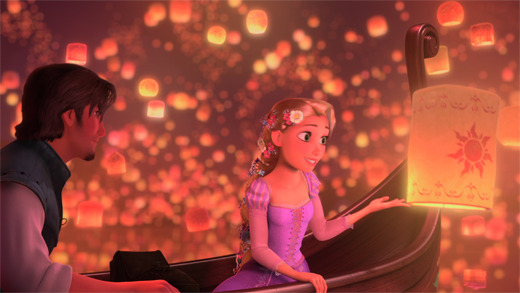
Enter the male lead of the film, Flynn Rider. Flynn is on the run from law enforcement, carrying a jewel encrusted tiara in his satchel. To avoid capture, he stumbles far into the forest. He accidentally stumbles upon Rapunzel's tower, believing it to be empty. Caught off guard, Rapunzel subdues Flynn and hides his satchel. This gives us the film's inciting incident. Rapunzel needs an escort to the lantern festival. If Flynn accompanies her, she'll return the satchel and its contents.
Flynn was designed to be a charismatic, likable scoundrel. By intention, he was equal parts Han Solo, Gene Kelly, and Errol Flynn (his namesake). He's witty, snarky, humorous, but always with a debonair charm about him. He's never humiliated or demeaned, always coming out of each situation with his head high.

What makes him interesting instead of conceited is how he plays off Rapunzel. Flynn is determined to believe he is the hero of his own story. A swashbuckling rogue, akin to Robin Hood. Instead of another daring adventure, he's now playing bodyguard to a naïve girl who's somehow calling all the shots. The wind is taken out of his sails, but they're still very impressive sails.
Flynn’s design was the work of a focus group. The directors corralled every woman from the Disney Animation Studio for a meeting. Plastered on the walls of a boardroom were photographs of popular Hollywood actors. The ladies were asked what they physically liked and disliked about each man. Sources have confirmed Johnny Depp, David Beckham, Hugh Jackman and Brad Pitt as testing particularly well.

Dubbed "The Hot Man Meeting," this feedback gave Flynn his unique look. Curtained hair. Brown eyes. A healthy physique, but not overly muscled. A strong jawline. Expressive eyebrows. Some facial hair, but not a full beard. And the setup for a running gag presented throughout the film, a prominent nose.
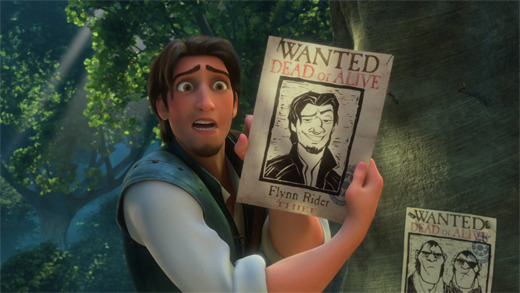
The film is overflowing with likable and charismatic characters. Even the animal characters are dynamic additions. Maximus is a no-nonsense steed in the palace guard, relentless in pursuit of Flynn. So much so, it's understood he's the authoritative head of the entire squad.
It's details like this that really sell the world of Tangled as fundamentally unique. One scene features Flynn and Maximus engaged in a sword fight. An adventure movie staple, Tangled makes their version iconic. For starters, it's held in the runoff channels of an aqueduct. These channels are so large and voluminous, Flynn and Rapunzel are essentially surfing down water slides. Second, Flynn isn't armed with a sword at all, but a skillet. Finally, all this is in happening so Flynn can combat a horse gripping a blade in his teeth.

The difference between madcap insanity like this being random nonsense and unique style is context. Every strange decision is justified. Every odd element is explained. It's ridiculous when experienced outside of the film, but inside the world of Tangled, it all makes sense.
Maximus has a unique place in the movie. He's sentient, intelligent, clearly able to understand everyone, but cannot speak. He's an animal living in a human's world. As is Rapunzel's friend and pet chameleon, Pascal. Both use these restrictions to opposite means. Maximus's silence gives him a no-nonsense air. He's in service of the law and pursues criminals with a stoic determination. He uses a piercing gaze, flared nostrils, and an unhappy sneer. Pascal uses his oversized eyes and comical smile to emote. He's playful, endearing, and fully in support of Rapunzel and her goals. Everything he does is for her.

It's common to associate these traits to animated animals. Tangled also uses this attributes in an unlikely place: Rapunzel’s parents. The king and queen of Corona are seen throughout the film. They run a gamut of emotion, ranging from desperation, hope, grief, optimism, disbelief, and finally jubilation. We spend very little time with these two. They are an accessory to Rapunzel's story. But every moment we spend with them, we learn so much about their identity. By the film's end, they are as familiar as any other major character, all without ever saying a word of dialogue.

Tangled is a film that is strong on story, strong on visuals, and strong on character. Usually a film is lucky to achieve one of the three, but Tangled gets all three near perfect.
The soundtrack is another exemplary work from Alan Menken. The indeterminate era and setting are reflected in the film’s music. The sound of medieval madrigals are partnered with acoustic guitars and soft rock. It makes the world seem comforting and vibrant. The music is as essential to every scene as the background. When Rapunzel and Flynn arrive at Corona, the music swells, encompassing the joy onscreen. The movie blossoms into a full dance sequence, not seeming superfluous or egregious.
Not counting the reprisals or Rapunzel's magic incantation, there are four songs in Tangled. It's an odd number, leaving Tangled straddling the genre line. It's rather anemic compared to other Disney musicals, which feature five or six numbers. Can Tangled rightfully be called a musical, or is it a normal movie where characters happen to sing?
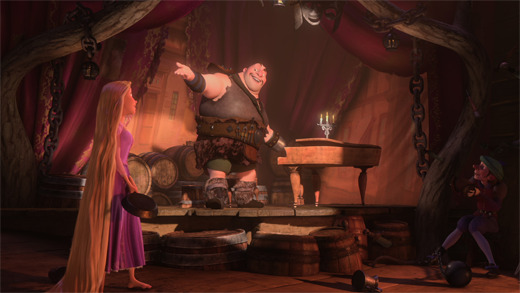
At any rate, Tangled's soundtrack accidentally reveals Disney's musical formula. Disney films feature four different types of songs. These four songs hit the four requisite beats. They identify characters, hit emotional notes, and diversify the soundtrack. These four are The love song, The ‘I Want’ song, The silly song, and The villain song.
We've already touched on The 'I Want' song, "When Will My Life Begin?" As for The love song, I have nothing to comment on. “At Last I See the Light’ is well-constructed and serves the film aptly.
The villain song, ‘Mother Knows Best’ is interesting to dissect. All of it is deliberately over-the-top and theatrical. Voice actress Donna Murphy is allowed to flex her Broadway sensibilities to the fullest degree. The various pitch changes and tremolos make it clear that she’s having fun. It's also a dark juxtaposition with her words being horrifying and insulting.
The playful nature and the upbeat melody bely Gothel's horrifying premonitions. She is scaring her daughter into obedience and servitude. The visuals drive the point home. Everything happening onscreen is darkly comical in relation to the song. It's terrifying taken out of context. Conceited taunting is exactly what one wants from a villain song.

‘I’ve Got a Dream’ is the silly song. Rapunzel wins over a tavern full of ruffians, encouraging them all to pursue their secret desires. Even if those desires are strange or uncharacteristic.
It's not that "I've Got a Dream" is a bad song, but it is easily the weakest from the film. For starters, every single ruffian's dream concerns a long-harbored secret. Secrets kept, as they're rather unmasculine or childish. The message of following one's dreams is being confused with encouragement to buck gender roles. Surely there must be one brigand who's dreaming of something that’s not ironic.
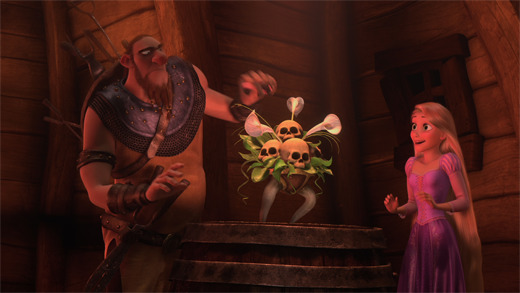
The song drifts off track, stretching its central point, trying to justify its place in the movie. A character having dreams and aspirations despite impossible obstacles is a common theme. It applies to the large majority of Disney films.
Rapunzel’s story is only tenuously tied to dreams. She wants to leave her tower. She wants to visit Corona. She wants to see the lanterns. The film tries to justify this as a dream, but it feels like a retroactive establishment. It’s hardly a dream, more of a strong curiosity. ‘I’ve Got a Dream’ feels like it was written independently of Tangled, then forced into the narrative. Though it's jaunty and entertaining, it stands out for the wrong reasons.
It’s a golden opportunity the movie outright misses. The focus point of Tangled shouldn’t be on the pursuit of dreams. It should be about age and confidence. Gothel infantilizes Rapunzel to the point of helplessness, smashing her confidence. She keeps Rapunzel in a state of perpetual childhood.

It’s why, near the end of her adventure, Rapunzel’s return to the tower seems so eerie. The colorful furniture and childish drawings that once defined her are now omens of her cursed state. She has all the intelligence and maturity of a grown woman, but she’s subjugated to live eternally as a little girl.

Rapunzel left her tower for only a few days. In doing so, she immediately developed emotional maturity, self-reliance and social skills. She even found romance. She’s an adult now, but is being forced back into the life of a child. Her tower hasn't changed at all; the imagery that once defined Rapunzel as a character now defines her tragic circumstances. It’s why the movie takes place on her 18th birthday, the gateway between adolescence and adulthood.
Gothel uses magic to prolong her youth and deny her true age. The only way to maintain such a life is to subject Rapunzel to the same fate. The final act of defeating Gothel is a symbolic one. Rapunzel’s hair is cut, destroying the magic, literally and figuratively severing what tied the two women together.

Visually, Rapunzel turns from a doe-eyed girl to a grown woman with no physical changes other than a shattered bob. A haircut which, while narratively important, forever reminds us that Tangled was released in 2010.

The major element that defines Rapunzel as a character is confidence. Either its presence, or its denial. She’s spent her entire life being told she’s weak and incapable, she has no choice but to accept such claims as fact. When she has her very first taste of capability, she realizes she’s capable of so much more. When Disney Animation released their first truly-successful CGI film, it was the dawn of a brand new era in animation. It was a long time coming, but with Tangled, at last they saw the light.
Beauty and the Beast
Fantasia
The Lion King
Snow White and the Seven Dwarfs
Cinderella
Alice in Wonderland
Sleeping Beauty
Mulan
Tangled
The Little Mermaid
Aladdin
Lilo & Stitch
The Many Adventures of Winnie the Pooh
Pinocchio
The Jungle Book
Robin Hood
The Sword in the Stone
Bambi
The Emperor’s New Groove
The Hunchback of Notre Dame
The Princess and the Frog
The Great Mouse Detective
101 Dalmatians
Bolt
The Three Caballeros
Lady and the Tramp
The Rescuers Down Under
Atlantis: The Lost Empire
The Fox and the Hound
Fantasia 2000
Peter Pan
Dumbo
Hercules
Meet the Robinsons
Brother Bear
The Black Cauldron
Melody Time
Oliver & Company
Treasure Planet
Tarzan
The Rescuers
Pocahontas
Saludos Amigos
The Adventures of Ichabod and Mr. Toad
The Aristocats
Dinosaur
Fun and Fancy Free
Make Mine Music
Home on the Range
Chicken Little
#Tangled#Disney#walt disney#Walt Disney Animation Studios#disney studios#Disney Canon#Film Criticism#film analysis#movie review
193 notes
·
View notes
Text
The Princess and the Frog at 35
A review by Adam D. Jaspering
Disney was one of the final remaining American film companies to deliver classic 2D animation. In 1989, cel animation was discarded in favor of digital ink and paints. In 2002, hand-drawn animation was phased out in the California studio. Originally, 2D animation would be made exclusively at Disney’s satellite studios. That was the plan until 2004, when a string of commercial flops compelled Disney to close these satellite studios. Television animation and home video presentations would continue, but the era of theatrical 2D animation was over.
And somehow, in 2009, Disney released The Princess and the Frog. Another 2D animated film. How did this happen?
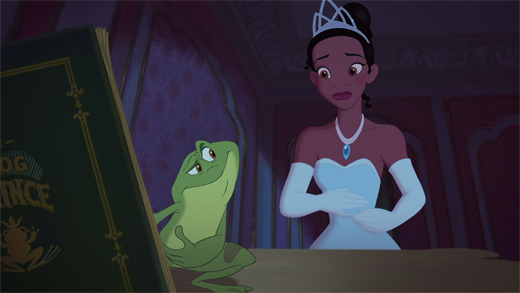
The answer is John Lasseter. Lasseter was an animator for Disney in the early 1980s. He was fired after pushing too hard for the implementation of computer animation. He would go on to be one of Pixar’s creative visionaries. He helped transform Pixar from a special effects department at Lucasfilm, to a hardware innovator, to one of America’s greatest film studios.
Long story short, in the mid-to-late 80s, Pixar developed and sold imaging computers. Lasseter made cartoons to demonstrate the abilities of these machines. These cartoons became so popular, and the computer sold so poorly, the company pivoted entirely to animation. In 1995, they released their first feature film, Toy Story. Out of the gate, Pixar began to eclipse Disney in popularity and profits.
Disney made several lowball attempts to acquire Pixar in the 2000s. The constant belittlement soured the two company’s relations. Pixar nearly severed ties between the studios. It was only after the onboarding of CEO Bob Iger in 2006 that a deal was finally struck, bringing Pixar and its assets under the Disney umbrella.
By this point, Lasseter was the Chief Creative Officer for Pixar. For his efforts and successes over the past 20 years, Iger promoted Lasseter to the Chief Creative Officer of Disney Animation as well.
In 1983, Disney fired John Lasseter for unprofitable and unworkable ideas. In 2006, Disney paid $7.4 billion to acquire Pixar, hoping to copy Lasseter’s strategy and success. Hindsight is a funny thing.
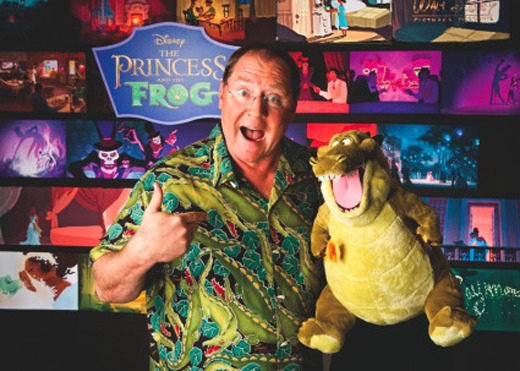
Lasseter sought to revive as much trademarked Disney magic as possible. He restarted Disney’s hand-drawn animation program. He picked a classic fairy tale to serve this purpose. He hired Ron Clements and John Musker, directors of modern classics like The Little Mermaid and Aladdin. And like many classic Disney works, this film would also be a musical.
The Princess and the Frog is an inverted version of The Brothers Grimm story, The Frog Prince. In the original story, a prince was transformed into a frog, and only an act of love could turn him back. Later versions prompted the transformation via a kiss.
The movie takes an interesting approach to storytelling. The film begins with characters actively reading The Frog Prince. It’s a real story in their world. They know it. They’re familiar with it. It’s a famous fairy tale, just as we the audience know it.

As such, the characters are not reenacting the story itself, but a series of events resembling the story. It’s a narrative shortcut. The characters understand the concepts of transformation. They understand the concept of talking animals. They understand a kiss will break the magical curse. It’s still fantasy to them, but they understand it.
This understanding also prompts the film’s inciting incident. Characters misinterpret their circumstances, confusing their real-world predicament with the fictional story. They’re not living the story, just a coincidentally similar set of circumstances. As they try to follow the story to the letter, things don’t work. Trying to break the curse only makes things worse. They’re wrong genre savvy.

There are lots of smaller characters in the movie, but we’ll focus on the big three. Tiana is our main character. She’s a working-class waitress who grew up in relative poverty. She works tirelessly and thanklessly, well below her skills. She’s saving up to start her own restaurant. There are many visual and thematic parallels to her and Cinderella, making Tiana a welcome and deserved inductee to the Disney Princess canon.
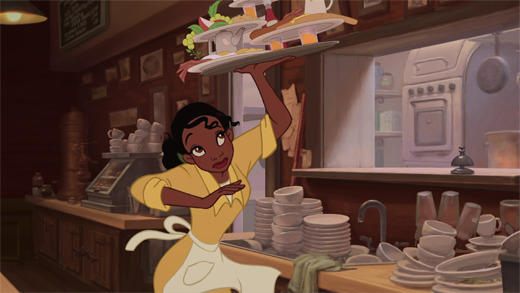
The other lead is Prince Naveen, heir to the throne of the fictional kingdom, Maldonia. Naveen is a high-spirited layabout. His lackadaisical attitude has separated him from his royal parents. He visits New Orleans as one of many stops in an attempt to find a wealthy wife to double as a benefactor.

The villain of the picture is Dr. Facilier, a voodoo practitioner and opportunist. He is granted limited magical power by a dark cabal of shadow demons, which he uses for material gain. He uses Naveen as a pawn in his latest scheme. This involves turning Naveen into a frog, beginning the film’s conflict.

The hand-drawn animated appeal is apparent from the movie’s opening scenes. The rigid stiffness of Disney’s CGI efforts is gone. No more awkward and clunky movements. There’s quality in every facet of every scene. There’s dynamism in the fluid motion of a character vaulting across the room. There’s elegance in subtle moments, such as simple hand motions or a shifting of weight. It’s style and craftsmanship absent from Disney animation for half a decade.
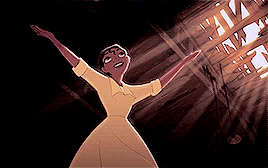
The tragedy is, although Disney returned to form in terms of animation, their modern type of storytelling was still present. Honesty, integrity and genuineness were still scorn-worthy approaches. The Princess and the Frog knows The Frog Prince is a silly fable based on a ridiculous premise. Characters mock and lampoon the story’s concept.
Disney thinks The Frog Prince is ridiculous. But they still want to adapt it. But they also want to change it. But they also want to use the unchanged parts on all their marketing. But they want everybody to know these parts are ridiculous. But they want to use the ridiculous aspects as part of the heartfelt Disney magic ideal. The film doesn’t know how to approach its own concept, creating a mishmash of faithfulness and satire. They want to have their beignets and eat them too.
The Princess and the Frog is also judgmental of previous Disney works. Pinocchio’s noble aspiration of wishing upon a star is now declared childish and ineffectual. It’s an odd stance to take, undoing one of the core pieces of iconography of the Disney Corporation. Moments earlier, they played the instrumental “When You Wish Upon a Star” over the Disney logo. Now they’re insisting it’s an outdated philosophy.

The film states plainly that wishing is ineffective. Instead, the true merit of following one’s dreams is a strong will to act. This lesson, imparted to young Tiana by her father, is later redacted (or at the very least, amended). Which raises the question, if the film is going to pivot on its bold claim, why bother making the claim in the first place? Why drag Pinocchio into the spotlight if the revisionist accusation doesn’t benefit or support the final thesis?
Despite the film’s eagerness to distance itself from The Frog Prince and the Disney canon, not every update is irrelevant. Some changes work incredibly well, giving the the film a distinct style and setting. Choosing to place the film in Jazz Age New Orleans is a stroke of creative genius. It’s iconic, evocative, underrepresented, and a logical place to have frogs and magic existing side-by-side.

That said, the movie does indulge in its New Orleans setting. The movie hits every single trademark and stereotype of The Big Easy, and doesn’t feel shy about it. Scenes feature Bourbon Street and streetcars. Characters listen to Dixieland jazz throughout. The film is set during Mardi Gras. Much of the movie takes place in a bayou. The villain practices voodoo. There is a paddleboat. The heroine is an aspiring chef who takes pride in beignets, gumbo, and étouffée. An alligator named Louis talks, acts, and plays trumpet like Louis Armstrong. Another character is a Cajun stereotype. The climax takes place in a graveyard. There is literally a character named “Big Daddy.” It’s all a bit much.

Tiana is a cook by trade. She has a refined palate, culinary skills, and the drive to run a busy kitchen. Unfortunately, due to societal circumstances, she’s denied any opportunity to use those skills. Instead, she works menial waitressing jobs, saving up to open her own restaurant, one dollar at a time. It’s the only escape from the cycle of poverty.

The film begins with Tiana days away from achieving her goal. Ignoring the fact that she’s clearly not getting a happy ending in the film’s first twenty minutes, let’s consider the circumstances. Tiana is a Black woman living in the American south, post Civil War, pre Civil Rights. She’s trying to own property, start a business, and move up the societal ladder.
The decision to make Tiana Black wasn’t an arbitrary decision. The writers knew telling a story about a Black woman, especially in this location and era, came with baggage. Tiana’s race is not the main focus of the film, and her racial struggles are relegated to a single scene, but it’s present. The filmmakers electively chose to address this topic, and that’s for the better.
The movie not only trusts its audience with the heavy theme, but has respect for the characters and what they represent. Making Tiana Black was more than a marketing decision to sell toys (although, let’s be honest, Disney was well aware it would be a fringe benefit).
Handled too aloofly, it looks like you don’t care. Handled too harshly, you ruin the tone of the film. Disney handles the dicey topic delicately. Especially considering its placement in a film featuring talking animals. There are no acts of violence or verbal epithets. Tiana isn’t assaulted, threatened, or even yelled at. She’s simply undervalued and dismissed.

Tiana is denied the deed to the property she’s selected for her restaurant. She was promised the building, she can rightfully pay for it, but the bankers change the rules on her at the last minute. Her identity isn’t the direct reason, but it is cited as a contributing factor. Moments after destroying her life’s work, the bankers compliment the pastries she’s baked.
It’s a perfect demonstration of systemic bigotry and the passive ignorance of its participants. It’s purposeful, tragic, illustrative, and all without being exploitive or upsetting the film’s G-rating.
It also displays Disney’s growth and evolving values. Disney once had a cartoon bird put on a minstrel show. The animators named him “Jim Crow” as a pun, never thinking of any ramifications. Nearly 70 years later, Disney presents a Black character trying to overcome Jim Crow laws. It’s been a long journey for the company.
While Disney does depict the negative reality of racist society, it’s not a perfect portrayal. The rest of the movie fudges certain details of segregation. By which I mean, there’s no depiction of segregation. Black characters and white characters are seen riding the same streetcars, eating in the same restaurants, and living in the same neighborhood. The Princess and the Frog demonstrates racial tension when it benefits a character’s struggles, but demonstrates racial harmony when it benefits the romanticized setting.
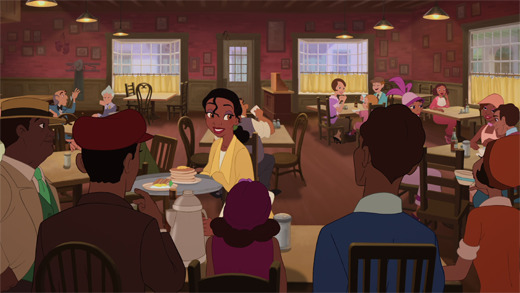
Anachronistic progressivism undercuts the purpose of race as a theme. Trying to depict New Orleans as an integrated paradise makes for nice visuals and musical numbers. But a film using race as a theme needs to make a statement beyond “Racism is Bad.” Otherwise it implies racism isn’t an ongoing problem of society, but something random jerks did in the past.
Still, things could have been much worse. Original treatments of the film presented Tiana not as a waitress, but as a housemaid for a white family. A position of indentured servitude that, while not technically slavery by 1920s legal standards, was equally inescapable and demeaning through lack of agency. Early character sheets gave Tiana the name “Maddy,” a diminutive form of the name Madeline. It was likely an innocuous choice, but “Maddy” is dangerously close to “Mammy,” the name of a derogatory caricature for Black women. Even the film’s working title “The Frog Princess,” didn’t seem to indicate Tiana would be turned into a frog, but the concept of her being a princess is froglike.
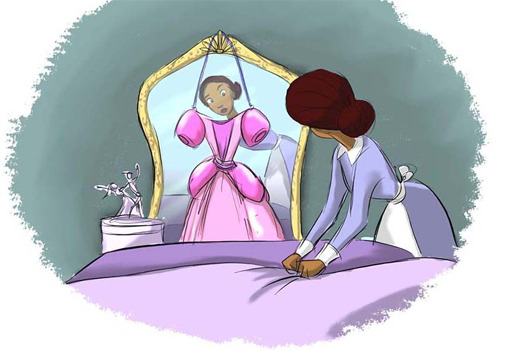
These problems were fixed in development, but other problems weren’t. Chiefly, Tiana spends the overwhelming part of the movie not as a Black woman, but as a green frog. Tiana is turned into a frog at the 30-minute mark. With the exception of a brief dream sequence, she doesn’t become human again until three minutes from the film’s conclusion. Disney was proud of Tiana being their first Black princess. It was a major selling point of the film. And yet, Tiana’s face and identity are hidden for nearly two-thirds of the movie.

Disney was in a treacherous situation. They had to faithfully depict a Black heroine for the first time, without treating her identity as a novelty or token representation. Maybe they picked the wrong story for their first Black lead. Maybe they were too focused on the Jazz Age setting above all else. Maybe they didn’t want to approach difficult subject matter, but felt obligated to acknowledge it, leaving it underdeveloped. Whether or not they succeeded is up for interpretation. Whatever the case, The Princess and the Frog landed somewhere between saying something profound and seriously screwing up.
Tiana is Disney’s first Black hero, but Prince Naveen’s heritage is ambiguous. He’s the heir to the throne of a foreign nation, but it’s never indicated where that nation is. It’s ostensibly Mediterranean Europe, but equally possible North Africa, Latin America, or Caribbean. He’s foreign, he’s non-White, but he’s not granted any national identity beyond that. For all the ambitious progressivism, Disney was hesitant to definitively depict an interracial relationship.

Naveen has been cut off from his family’s fortune for being a leech, though it’s never explained what that entails. One can’t imagine how the crown prince of a nation could transgress so severely through inaction. How could the son of royalty be so spoiled compared to any other royal figure? Somebody on the writing staff has probably written an explanation of Naveen’s circumstances and transgressions. But the movie brushes it off as an unnecessary detail.
Prince Naveen is one of the most dynamic and engaging princes in the Disney canon. It’s an odd mantle, considering how little we actually know about him and his background. He’s jovial, upbeat, flirtatious, musically inclined, has a good sense of humor, and is very personable with everyone he meets.
For such a bold character, it’s insulting how little the movie uses him. Disney gives us the absolute minimum understanding of Naveen, his life, and his curse. He’s technically a main character, but his purpose in the film is supporting Tiana. A switch flips in his head telling him not to be self-absorbed, and that’s his entire character arc.

Prince Naveen is accompanied by a put-upon lackey who resents his subservient position. Lawrence the Servant is a chronic upset to the film’s pacing. He has no distinct personality and no unique character traits. He has no character arc, and despite his duplicity, is treated like a hapless rube who should never be treated seriously. He’s a stock character who gets way too much screen time. Who is this guy, and why should we care? Two questions the film doesn’t want to waste time answering.

The movie feels like the first draft of a story. All the elements of a great fable are present, but certain parts are underdeveloped while others are unconnected. Side characters have too much attention. Main characters have no depth. Broad themes are more aspirational than representational.
This first-draft theory also explains the movie's pacing. Once Tiana and Naveen turn into frogs, the romance-tinted fable turns into a road movie. They can’t turn back until the movie's over. They can't do anything heroic because they're frogs. So the movie pauses their previously established stories, placing them in an unfamiliar land with unfamiliar challenges. Far away from the celebrated New Orleans, deep into the alien Louisiana swamps.

To reiterate: A strong wind takes our heroes far from home. They go on a long journey, hoping to find a famed magic practitioner at the end of the road to help them. Along the way, they pick up kind-hearted and sympathetic colleagues who agree to help. They too hope to have their desires fulfilled as well. The movie is definitely cribbing a little too close to The Wizard of Oz for comfort.
It's Disney's worst habit: prolong the movie by making characters travel. In the meanwhile, we have moments of introspection wrapped between meaningless fluff. Naveen and Tiana run afoul of frog hunters. Naveen and Tiana attend a Cajun firefly hoedown. Naveen and Tiana try to acclimate to their uncomfortable frog tongues and bodies. Naveen and Tiana enjoy a romantic ride on a paddleboat. Naveen and Tiana make a pot of gumbo together. It's one of two dinner scenes, and they're only gone for a day.

The greatest demonstration of the undeveloped writing is the villain, Dr. Facilier. Also known as The Shadow Man (since Disney knows full well their target audience would have trouble reading and spelling such a name), he has no real attachment to the film’s heroes. He doesn't know them, he has no ill will towards them, and he's only indirectly involved in their suffering.
Dr. Facilier is a small time hustler, bilking people out of dollars through cheap cons and parlor games. But he has aspirations. He wants more money. He wants more power. And he knows how to get it. He just needs the right opportunity. Naveen, the visiting overseas dignitary, is that opportunity.
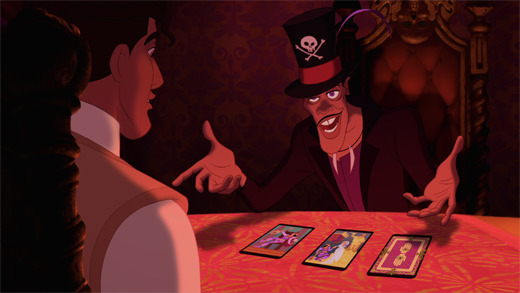
The big scheme is to manipulate Naveen’s carefree lifestyle. Dr. Facilier promises him a lifetime free of responsibility. The hook being, Dr. Facilier implies he’s providing riches, but instead turns Naveen into a frog. He frequently makes promises of "green,” a pun I can’t decide is clever or groanworthy.
The other half of the plan involves transforming Lawrence into a carbon copy of Naveen. In disguise, he'd marry the daughter of the town’s richest man. After which, they kill her father and inherit the money. And somewhere along the way, they capture the souls of the citizens of New Orleans, appeasing the dark spirits that give Dr. Facilier his magic powers.
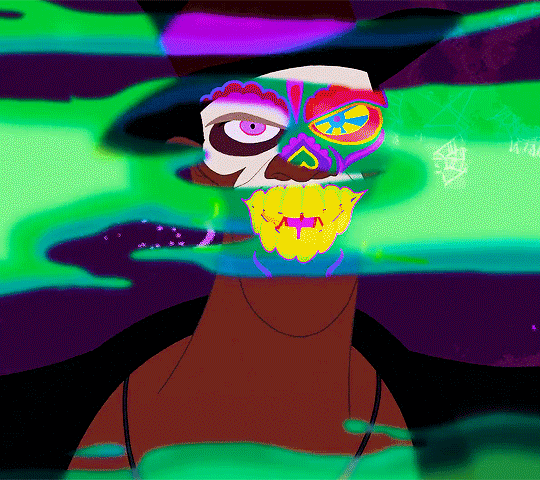
Dr. Facilier's plan is off the rails. The film does a poor job explaining how every element relates to each other. Why does Lawrence have to get married before Big Daddy can be assassinated? Why doesn’t Dr. Facilier kill Big Daddy without this rigmarole? Why does he have to kill Big Daddy to doom other people? How does money play into anything? Why doesn’t Dr. Facilier simply impersonate Naveen himself? Why is turning Naveen specifically into a frog a requisite step in the plan? Why not just render him unconscious, or lock him in a room?
It all seems like a very convoluted thread to justify a bunch of independent story decisions. Disney was working their way backwards. They needed a villain to pose a massive threat. That threat needed to involve transforming the heroes into a frog. They had two disconnected story elements, so they connected the dots as best they could.
Dr. Facilier is different from other evil witches and wizards in the Disney pantheon in that he’s not the curator of his own powers. They’re provided to him by his so-called “Friends on the Other Side.” He provides them with damned souls, they provide him with magical tools to conduct magic. This would be an interesting hook if we ever saw him actually capturing souls instead of playing practical jokes.
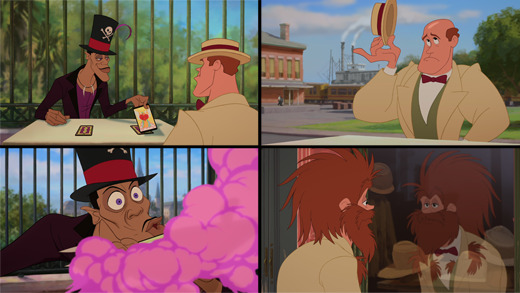
As deliciously evil as Dr. Facilier is, he weighs down the film. He’s a great villain from a design standpoint. He’s bold, fast-talking, energetic, smarmy, sarcastic, threatening, and powerful. But as great as he is to watch and to see (especially his psychedelic visuals and musical number), he damages the film in the long run.
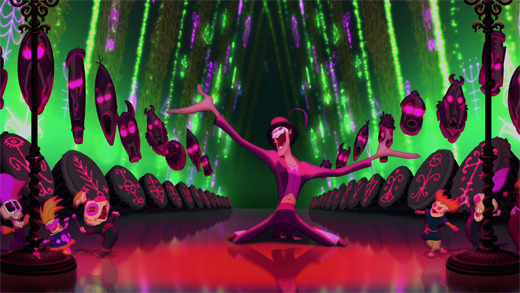
Dr. Facilier could be cut from the film completely. This story doesn’t need a villain at all. If Naveen were turned into a frog by some unseen entity, forcing him and Tiana to return home without any overarching antagonist, the film would have more cohesion and better suit the characters. A ticking clock threatening the loss of their humanity are the only necessary stakes. Dr. Facilier and Tiana don't even meet until the end of the film; how can they be adversaries?
The moral of the film is to “Dig a Little Deeper.” The path to happiness is not relentless pursuit of one’s desires, but to fulfill one’s needs. Naveen and Tiana are desperate to return to being human. So much so, they don’t realize they need each other to achieve their goals. Literally and figuratively. Yes, a much-suspected kiss is what breaks the curse. But also, the two provide what’s been missing from their respective lives. Naveen realizes he needs to be more responsible and Tiana needs to allow herself to be happy.
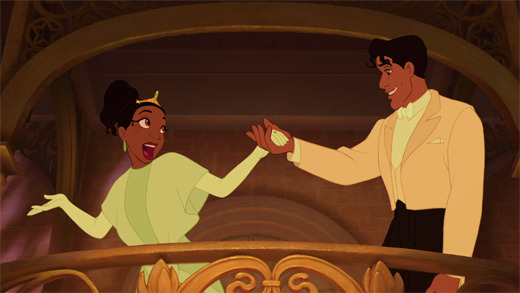
The major theme of The Princess and the Frog is what a person needs and what a person wants are often two different things. Disney and John Lasseter wanted to revisit the nostalgia of Disney’s golden years. What they needed was to demonstrate Disney’s commitment to new ideas and quality entertainment.
Disney acquired one of the most successful and acclaimed film studios in the world. They gave one of Pixar’s creative visionaries full control of Disney’s resources, hoping he would bring Pixar magic to Disney Animation. Instead, he made a movie completely unlike Pixar.
In 2007, Disney made a film touting the virtue “Keep Moving Forward.” In 2009, they tried to move backwards and were shocked it didn’t work. The Princess and the Frog failed to retake its $105 million budget domestically, making the film a financial loss. The newly reinstated 2D Disney animation studio would close again in 2013.

The lesson was clear: audiences were done with 2D animation. To kids born in the 21st century, it looked outdated and antiquated. What’s more, the zeitgeist in the animated market shifted. Fantasy and romance were less attractive to kids, who preferred comedic and adventure-tinged films. Titling the film “The Princess and the Frog” didn’t help either, ostracizing the male demographic. It made the film seem exclusively for girls.
The Princess and the Frog tries to split the difference between classic and modern Disney fare. In doing so, it falters. It offers a movie that looks fantastic and lively, but the individual parts don't compliment each other. It has many great ideas, but doesn't incorporate them well.
A movie is like a pot of gumbo: everything going into the pot has to contribute to the final dish. The Princess and the Frog is more like a shopping cart: all the right ingredients, but not nearly enough work done to them.
Beauty and the Beast
Fantasia
The Lion King
Snow White and the Seven Dwarfs
Cinderella
Alice in Wonderland
Sleeping Beauty
Mulan
The Little Mermaid
Aladdin
Lilo & Stitch
The Many Adventures of Winnie the Pooh
Pinocchio
The Jungle Book
Robin Hood
The Sword in the Stone
Bambi
The Emperor’s New Groove
The Hunchback of Notre Dame
The Princess and the Frog
The Great Mouse Detective
101 Dalmatians
Bolt
The Three Caballeros
Lady and the Tramp
The Rescuers Down Under
Atlantis: The Lost Empire
The Fox and the Hound
Fantasia 2000
Peter Pan
Dumbo
Hercules
Meet the Robinsons
Brother Bear
The Black Cauldron
Melody Time
Oliver & Company
Treasure Planet
Tarzan
The Rescuers
Pocahontas
Saludos Amigos
The Adventures of Ichabod and Mr. Toad
The Aristocats
Dinosaur
Fun and Fancy Free
Make Mine Music
Home on the Range
Chicken Little
#The Princess and the Frog#Disney#walt disney#Walt Disney Animation Studios#disney studios#Disney Canon#movie review#Film Criticism#film analysis
3 notes
·
View notes
Text
Bolt at 35
A review by Adam D. Jaspering
Fiction is any narrative that is imagined, invented, or made up. To the characters in the narrative, their world is real. To those experiencing the media, it is understood as a fabrication.
Sometimes, things aren’t as cut and dry. Postmodernism in media is the idea that media represents and reflects the real world. That real world itself contains media. And as such, characters in media have seen media themselves. Media is so omnipresent, it is inescapable. This creates a recursion. Daily life is saturated by media, both in the real world and in fictional worlds.

This gives us the idea of metanarratives. Some stories and storytelling techniques are so universal, they are instantly recognized. People are inherently critical and judgmental of such overuse. Fictional characters are also judgmental and critical of stories they themselves are participating in. Metanarratives play with such dissatisfaction.
Metanarrative film draws attention to its own artificiality. This can include characters speaking directly to the audience. The film can reference past works from the filmmakers or studio. The story can comically point out its own inconsistencies or plot holes. The camera can reveal the fictional world is nothing more than actors on a film set. The movie is able to recognize itself as fake, a product of the real world, but remain an independent narrative.
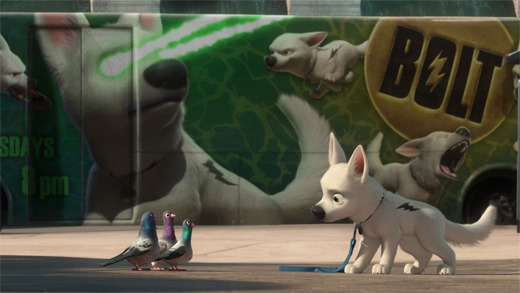
Disney has gone meta before, usually for the sake of humor. In The Sword in the Stone, Merlin knew about the Knights of the Round Table before King Arthur inherited the throne. Genie read from a copy of Aladdin’s screenplay. Timon warned Pumbaa to compose himself before using the word “Fart” in front of The Lion King’s impressionable audience.
Bolt approaches metanarratives in a different way. The film is a work of fiction, it has no direct parallels to any Disney property, and it makes no attempt to recognize itself as an animated film. It is, however, a film about the production of a television show. It demonstrates concepts such as scripting, acting, audience reception, editing, and cultural impact. It threads the line between characters being deluded and accepting their status as fictional characters. While it may not have been intended to be a metanarrative, thematically, it became one anyways.
Bolt is the canine star of his own TV show, alongside his preteen owner, Penny. Bolt is an unknowing participant in the program. He genuinely believes he is a superhero, capable of great feats of strength. He is kept in a state of constant delusion and security, unaware he is nothing more than an actor. Separated from Penny while shooting a two-part cliffhanger, Bolt embarks on a literal and figurative journey. For the first time, he sees the truth about his life and his world. Bolt must realize what is real, and what has been a fabrication.

The story may sound familiar. An individual has the false impression that they are a legendary figure. They believe themselves capable of great feats. They are blissfully unaware their great deeds are phony, and their life is a construct. When forced to interact with the real world, they see just how ineffective and ordinary they are. It’s an identity crisis paired with the tenets of obligation and friendship. Bolt’s character arc is exactly the same as Buzz Lightyear’s from Toy Story.
It may seem that Disney’s head-to-head competition with Pixar had finally come to a head. It may seem that Disney was outright plagiarizing Pixar. This coincidence isn’t quite as malicious as it seems. In 2006, Disney CEO Bob Iger had finalized the acquisition of Pixar. In doing so, Disney was now the employer of Toy Story's creator and director, John Lasseter.

In the first few years of his tenure, Iger did his best to fix Disney Animation's problems. Unfortunately, the task was too big. The mistreatment of filmmakers and a long run of financial blunders left the studio a mess. It required more attention than Iger could devote while running the rest of Disney.
As such, Iger created a new position: Chief Creative Officer of Feature Animation. He put John Lasseter into the role, effectively making him the simultaneous head of both Pixar and Disney Animation. The first project Lasseter had influence over was Bolt. It was his involvement that turned Bolt into its present iteration. Any accusations of Bolt copying Toy Story are irrelevant. It’s nothing more than John Lasseter copying himself.

The fresh injection of energy behind the scenes is apparent. Lasseter's philosophy was storytelling working in tandem with technology. Bolt is ambitious in concept and presentation.
Disney's animators were slow to adopt CGI. They were years behind other animation studios, inexperienced, untrained, and slow. It was a struggle to complete any scene, never mind a visually complex or engaging scene. Animators couldn’t surmount the learning curve, forcing writers and storyboarders to scale back their scope to compensate. The end result was mediocre stories with bland designs. Lasseter forced the animators to adapt.
Bolt's ambition pushed the animators out of their comfort zone. The film contains a number of big, dramatic, dynamic action scenes. It contains busy city streets with extras. It contains a cross-country road trip, mandating a variety of settings and landscapes. It features animal protagonists that needed to look and move like animals. Grass had to look like grass, not like carpet.
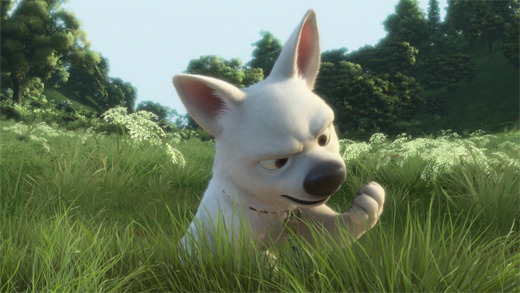
Lasseter threw down the gauntlet. He gave the animation staff an ultimatum. They needed to meet his expectations. Disney had been wanting to make Pixar-quality films for years. In order to do that, they needed to meet a Pixar executive's standards.
Watching the movie’s introductory action scenes, it seems the animators met the challenge. There’s a definite sense of purpose with everything. Characters are less doll-like. Faces are emotive. Vehicles move with weight and strength. Buildings are defined. Explosions and smoke effects are definitely engaging. It's not quite The Incredibles, but it's in the same league.
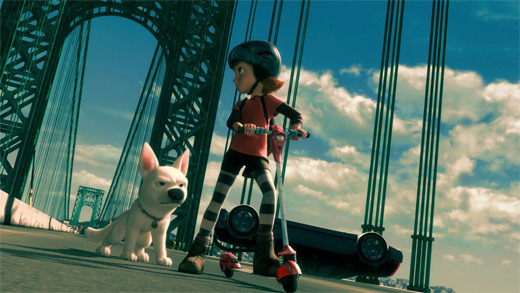
Thankfully so. These introductory scenes are a spoof of action movie clichés, and can’t afford to be half-heartedly illustrated. Not just the explosions and chase scenes, but the style. The color palette is saturated to teal and orange. The camera angles are canted. The lighting features high levels of bloom. It’s a nice parody of the genre while also being entertaining in its own right. None of this would register as satire if the film were hobbled by its own poor animation.
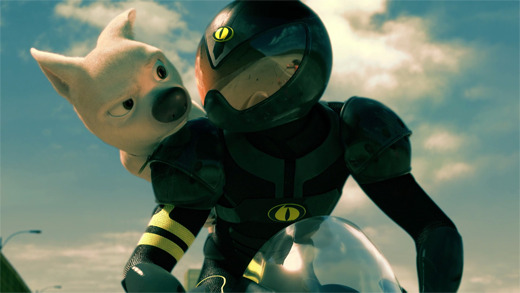
Unfortunately, this achievement isn't carried throughout the film. The animators had the ability to animate vibrantly and detail-oriented. But it was a labor-intensive, time-consuming process. They couldn't maintain such quality throughout the film.
Other scenes are underdeveloped, much more in line with Disney's previous CGI efforts. The inside of Penny’s trailer looks like a smooth gel capsule. Humans walk as though their spines were a steel rod. Often, characters are animated from a high angle so there's less background to be drawn.

The conceit of the film relies on Bolt being kept in a delusional state. He can never know he is an actor in a TV series. He must believe he is actually a superhero and capable of amazing physical feats. It's unknown whether he can act, or even if he would. Bolt believing this his TV show is reality is preferable to any sort of acting.
This process of enforced method acting may result in an authentic performance. But it's a benefit only in this one specific area. Anyone with a minor understanding of film and video production understands why this concept would never work. The slight benefit is hardly worth the massive complications.

Not only would every episode of the series have to be shot in one long, continuous take, it would have to be shot on the first try. One flubbed line, one out-of-place actor, one prop mishap, and the entire scam is ruined. In addition, Bolt stars in a very effects-laden series. Everything is done through practical effects. Multiple explosions, stunts, and fight choreography happen right in front of Bolt. Most filmmakers are only concerned with how a shot looks for the camera. Bolt's director has to make everything look real for the camera *and* the actors.
The movie doesn’t try to explain, and doesn’t feel obligated to. How does Bolt blow up an actual helicopter on a highway bridge while just being an illusion on a soundstage? The film waves it off as movie magic, and lets the audience's imagination fill in the blanks.
It’s an introduction to the film’s premise, and an overall small element of the film. It’s illogical and impractical, but it makes sense in the world of the film. It’s a senseless piece of eye candy; entertaining but vacant. It’s fine in small doses.
Bolt is voiced by actor John Travolta. His owner, Penny, is voiced by singer/actress/Disney Channel vassal Miley Cyrus. This is the first voice-acting job for both, and it shows. The cadence and emotion in their voices is wrong for animation. There’s a lot of inflection and pacing that would normally be carried by accompanying physical acting and emoting. And since Bolt is animated, those partnering tools don't exist. The animators try to fill in the gaps as best they can, but it’s still a bandage over a big wound. The two actors are unsuited for their roles.

Being a road movie, Disney uses the opportunity to depict America's various regions. Los Angeles plays the largest role, with New York City coming in at a close second. We also get views of small-town Ohio, Las Vegas, the Mojave, the Midwest prairie, and the Rocky Mountains. Once again, the animators demonstrated their abilities through variety. It meant drawing vastly different landscapes, but the lack of monotony made the effort worthwhile.

One element of the changing locales that deserves special mention is the pigeons. Bolt encounters pigeons throughout his journey, each with different regional accents. It’s a nice gag, but it’s not fully explored. Bolt encounters pigeons only three times throughout his journey: in New York, Los Angeles, and a nondescript rural area. The final version is especially insulting, implying anywhere besides New York or Los Angeles is interchangeable.
It's a good joke, but better in concept than execution. Had Bolt encountered pigeons four or five times, once at each of his stops, it may have worked better. Bolt clearly wants to depict the lengths and breadths of mainland America, but here is where they decided to shirk.

Traveling across the country is a tall order for a dog with literal delusions of grandeur. Two other pets join Bolt on his adventure. Mittens is a stray cat from Manhattan who becomes literally tied to Bolt, and forced to accompany him. Rhino is a hamster whom Bolt encounters at a highway rest stop. Rhino is a TV junkie who’s familiar with Bolt’s series, and almost as delusional as him. He encourages Bolt in his insanity. Both are excellent additions to the film.

Mittens and Bolt have a great dynamic. The two are polar opposites and play off each other well. Bolt is crazy, while Mittens has a firm grasp on reality. Bolt is bullheaded while Mittens is cautious. Bolt knows nothing about the world, while Mittens has seen it all, to her own chagrin. Bolt has unwavering faith in Penny's devotion and love. Mittens has been scorned, and is far more cynical.

Rhino is the wildcard. He compliments both Mittens and Bolt, encouraging their best and worst traits. He’s brave and duty-bound like Bolt, but also encourages him in his delusions. He's well aware Bolt is a character from a television show, but supports his beliefs he has superpowers. Not for any particular reason, he merely thinks superpowers is cool.
Like Mittens, Rhino is hindered by his small size, often incapable of doing much. But he still thrusts himself and his associates into situations headfirst. He's not capable of much, but he's capable of more than he seems.

That never stops Rhino from trying, though. With his little plastic hamster ball, he lunges in headfirst into every situation. He's either very brave or quite insane. Either way, he's the most enjoyable character in the movie. Dynamic enough to be interesting, used sparingly enough he doesn't become tiresome.
Under normal circumstances, a sheltered dog, a demurring cat, and a hamster of any circumstance would be an ineffective trio. There’s very little the three could ever hope to accomplish. Thankfully, this is a cartoon, and logic takes a backseat. Every single escapade this trio gets into is aptly suited for their specific skills and abilities.

The movie is full of contrivances. Sequences start reasonable, turn implausible, and remain situationally specific and coincidental until fulfillment. Scenes play out like a performance from an improv troupe. Anything can happen. Elements stack atop each other. Events and results and incidents compile. It’s amazing to watch the backflips on display. Half the time you’re compelled to roll your eyes. The other half, you’re amazed how professional screenwriters write themselves in and out of corners.
The rhythm of the film is interesting to watch unfold. Elements that change the course of the film often spring up without indications of their importance. Small little decisions escalate into dramatic circumstances. A passing dogwalker places a leash on Bolt, assuming him to be one of her charges. Bolt runs away, taking the leash with him. It's easy to ignore, treated as a minor thing he would soon discard. That leash is not only the only thing keeping Mittens by his side, it's incorporated into several action scenes.

The movie has to result to such tactics, or else there would be no conflicts at all. The movie has no villains. Nobody is deliberately causing Bolt any harm or grief. No one is working against him. There are people who do obnoxious things. There are people who are indifferent to the heroes' wishes. But no one can rightfully be called a bad guy.
It makes for an interesting commentary on society. From a child’s perspective, we sympathize with the girl and her dog. The adults in her life are are jerks. From an adult's perspective, these so-called jerks are average people doing their jobs. They’re not intending to be malicious or inhospitable, but to a child, that's how they appear. Their jobs mandate their identities.
At some point during their maturation into adulthood, their values were corrupted. Somewhere along the way, being a jerk to a child and her pet became a reasonable course of action. They're not villains. These are adults, doing their job, cold and detached. In a child’s eyes, that’s villainous enough.

Bolt is a film big on spectacle, light on themes. But it's impossible to make any piece of art or media without messages. Whether or not a theme was intended, themes find their way to the forefront.
The intended theme to Bolt is the power of love despite all obstacles. This is a very flimsy and facile moral. Beneath the surface, a second, more volatile moral waits. A discussable one, concerning how useful truth is to one’s true self.
The adults in the world of Bolt are concerned with lies and duplicity. They manipulate a dog just to create a TV show. They force a traumatized girl who lost her pet to move on without closure. They’ve convinced themselves that this type of manipulation is not only acceptable, but justified. They’ve lied to themselves until the lie became the acceptable standard.
Bolt himself demonstrates the same concept. His self-perception is orchestrated on a lie. He believes himself to have superpowers. So much so, he can't comprehend a version of himself without. When the film's climax comes around, and he must save Penny from an actual tragedy, knowing full well he’s an average dog, he never shirks. Whether or not he has powers is irrelevant. Penny needs help, he's available to help, he will help, powers or not.

Is Bolt actively campaigning that reality is a prison? That it corrupts until it supplants our values? That fantasy is the only escape from the infernal machine? Does it encourage a level of disengagement and denial to maintain purity? That truth is an intangible concept, and thus malleable to one's perspective? It certainly feels like it.
Bravery, focus, and a willingness to sacrifice compensate for physical might. Bolt saves Penny from a burning building because he is precisely the hero he believes himself to be. Reality was an inconvenience to him. His delusions made an impossible task possible. Just as a declawed Mittens convinced the birds of New York City she was a ruthless threat. Just as a miniscule Rhino convinced his friends he was a powerful fighter.

Bolt was never acting. The character from the TV show was no different from him naturally. He has a perspective accessible only from living in a fictional world. There is a bridge between fiction and reality: You can be whoever you want to be. If you want to be great, you can be great. If you want to be jaded, you'll be jaded. If you're not careful, you will turn into someone you don't want to be.
Bolt is not just media deconstructing media. It’s media within media deconstructing media. It’s a cartoon enticing its audience to question what’s real and what’s make-believe. Bolt is like a mirror reflecting on another mirror, creating an endless sequence of reflections. It’s a deep rumination, very likely unintended, especially for a film who’s primary selling point was “Talking Doggie.”
Bolt is a story halfway committed to a Hollywood satire, halfway to an Incredible Journey homage. The animation fluctuates in quality, with grand vistas kept barely within arm’s reach. Characters are fun and developed, even if the acting needs improvement. The script flows with good humor and enticing scenes, though it can’t quite decide what it’s mocking and what it’s embracing.

The story features an ambitious concept that’s maybe too grand for its own good. It creates an unforeseen rumination on the philosophy of the self. Disney already made a film featuring a character falling down a rabbit hole. Now it was sending its audiences down a figurative version.
Beauty and the Beast
Fantasia
The Lion King
Snow White and the Seven Dwarfs
Cinderella
Alice in Wonderland
Sleeping Beauty
Mulan
The Little Mermaid
Aladdin
Lilo & Stitch
The Many Adventures of Winnie the Pooh
Pinocchio
The Jungle Book
Robin Hood
The Sword in the Stone
Bambi
The Emperor’s New Groove
The Hunchback of Notre Dame
The Great Mouse Detective
101 Dalmatians
Bolt
The Three Caballeros
Lady and the Tramp
The Rescuers Down Under
Atlantis: The Lost Empire
The Fox and the Hound
Fantasia 2000
Peter Pan
Dumbo
Hercules
Meet the Robinsons
Brother Bear
The Black Cauldron
Melody Time
Oliver & Company
Treasure Planet
Tarzan
The Rescuers
Pocahontas
Saludos Amigos
The Adventures of Ichabod and Mr. Toad
The Aristocats
Dinosaur
Fun and Fancy Free
Make Mine Music
Home on the Range
Chicken Little
#Bolt#Disney#walt disney#Walt Disney Animation Studios#disney studios#Disney Canon#Film Criticism#film analysis#movie review
14 notes
·
View notes
Text
Meet the Robinsons at 35
A review by Adam D. Jaspering
Fantasy and science fiction are two sides of the same coin. Both genres explore alternate versions of reality. Both create their own unique worlds with their own unique rules. Both use allegory to reflect conditions of the present day. Both translate abstract ideas, feelings, and philosophical concepts into dramatized texts. Fantasy fiction is a refection of society and its past. Where we’ve been, how we got there, and what decisions influence today. Science fiction is a reflection of society and its future. Where we’re going, what awaits us, and what problems we can expect.
Fantasy has been around millenniums longer than science fiction. As such, more fantasy fiction has embedded itself in the public consciousness. Beloved stories have stood the test of time. Most of these stories are also public domain; a nice benefit for Disney and other film studios.
Science fiction, not so much. Most beloved science fiction stories experience a recency bias. It’s unclear which stories will withstand a shifting cultural landscape. Once beloved characters like Buck Rogers and Captain Midnight were mainstays of the genre. Today, they’re largely forgotten. Legacy franchises are rare, and closely guarded by copyright.
Instead of specific stories, science fiction media often reinterprets individual elements and ideas. Concepts serve as a jumping-off point for unique characters and settings. Disney Animation used this strategy for their own science fiction movies. Atlantis: The Lost Empire was their steampunk movie. Lilo and Stitch was their alien encounter movie. Treasure Planet was their interstellar adventure movie. And now, Meet the Robinsons was their time travel movie.
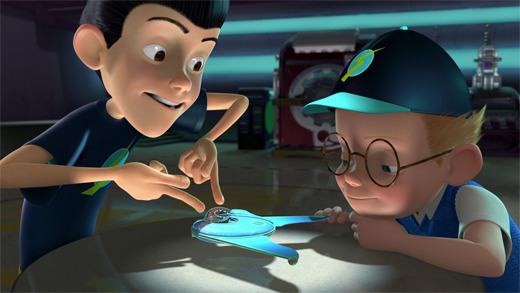
Meet the Robinsons is the story of Lewis, an orphaned boy with a prodigious mind. Nearing his 13th birthday, Lewis has given up hope of ever finding a family. In his moment of deepest despair, he meets a strange boy named Wilbur Robinson, a time traveler from 30 years into the future. Demonstrating his marvelous time machine, Wilbur takes Lewis into the future. There, Lewis meets Wilbur’s eccentric yet fascinating family. Lewis believes he’s finally found where he belongs. But a much more important fate awaits Lewis, assuming he can ever return to his own time.
A Disney film featuring orphans isn’t exactly new or groundbreaking. Many films feature characters who’ve lost one or both their parents. They’re watched over by caretakers, either benevolent or wicked. Meet the Robinsons is unique in that the hero’s status as an orphan is a major plot point, not just backstory.
As an infant, Lewis was left abandoned on the steps of an inner-city orphanage. He never knew his mother, and there are no clues to her identity. Being a scientific genius, Lewis devises the most obvious and least convoluted method to find his mother. He invents a machine that can scan one’s memories, recreating them as video.
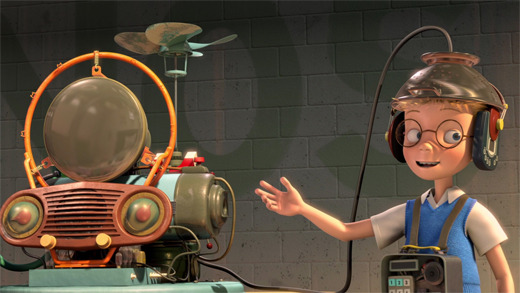
Never mind a 13 year-old child is inventing world-changing technology in his bedroom out of spare parts. Never mind that memories are flawed and biased interpretations of events. Never mind long-term memory processing isn’t present at infancy. Lewis is showing an obsessive nature and an inability to move past trauma.
This isn’t a fault of the movie; it’s actually one of the film’s primary themes. Lewis will eventually learn the error of his ways. He’ll learn not to obsess over the past. The lesson is delivered to the audience and its importance is reflected through the film.
The problem is, like all culminations of a character arc, it happens at the end of the film. Before then, Lewis is either ignorant or in denial of how poorly he’s processed his trauma. He claims he’s accepted his bad fate, but he’s also breaking all laws of science just for closure. He desperately wants to know who his mom is because he’s accepted it’s the only way he’ll ever have a family.
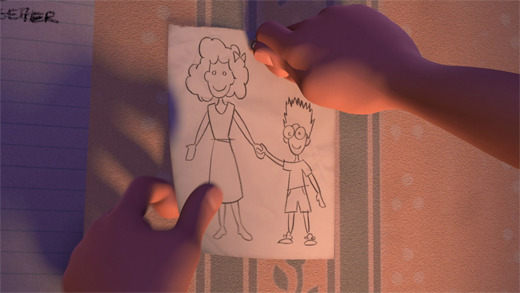
It’s bold to demonstrate internalized shame and self-reproach through a means besides depression. Lewis’s manic dedication to engineering and technology represent his unhealthy coping mechanisms. It’s productive, but it’s also slowly destroying him. Unfortunately, I believe Disney did this on accident. Why else would Lewis grow despondent and give up after his machine breaks?
The animation of Meet the Robinsons is improved over the plasticine Chicken Little. It’s better, but not great. Disney animators still lagged behind their contemporaries of the era. Characters move with too much weightlessness. Faces have a sense of paralysis and emptiness, making people seem robotic. All except the robot character, who moves like he’s made of rubber.
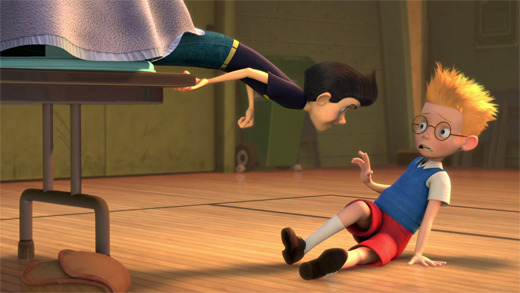
Textures are too simple, making buildings and features look like printed bedsheets draped over blocks. There’s a leaf texture used extensively that looks incredibly low-quality and simple. Almost two-dimensional. Structures in the present look like cardboard mockups. Structures in the future somehow look fuzzy, as though exterior walls are carpeted.

The flaws in animation aren’t hidden or thrown into the background. Everything is on display. Whatever achievements Disney made or accomplished are overshadowed by their struggles and shortcuts. Anytime a liquid appears onscreen, it’s the same reused asset. A lumpy animated blob, distinguishing itself only by color. Paint and peanut butter should never be able to be mistaken for each other, but here we are.
There’s a certain energy and vigor within the movie. It’s a cartoon, but everything seems more animated than usual. The first such instance occurs when Lewis presents his peanut butter and jelly gun. The machine malfunctions, spraying the room and its inhabitants. It also frequently sprays in the direction of the supposed camera.
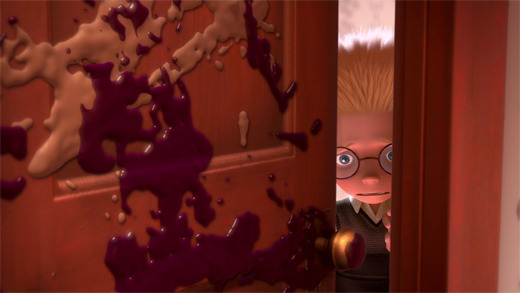
It’s easy to see what’s happening. The movie is highlighting its animated abilities and energetic motion. Things are constantly moving. Settings feature great depth of field. Action is delivered in quick bursts, usually in the direction of the audience. This film was designed to be presented in 3D.

Disney was desperate to sell tickets and have their film seen, and exploiting a trend was the best way to do so. They couldn’t perfect their flawed animation style. They couldn’t onboard innovative filmmakers. They couldn’t write a screenplay that would distinguish them. They couldn’t invest in the heart and pathos that defined the Disney brand for so long. Instead, they latched onto a gimmick that wasn’t even available in all theaters (or Disney+). A gimmick that would also emphasize their pre-existing animation problems. Meet the Robinsons was not among the five highest grossing animated films of 2007.
Watching Lewis dedicate himself to his inventions articulates his scientific mind. It also drives home how much emphasis Disney is placing on the opening scenes. We watch a kid develop, brainstorm, and build a memory scanner. This isn’t a prologue. This isn’t an introduction. This isn’t setup. This isn’t a movie about a memory device. This is a time travel movie that’s not utilizing its premise.
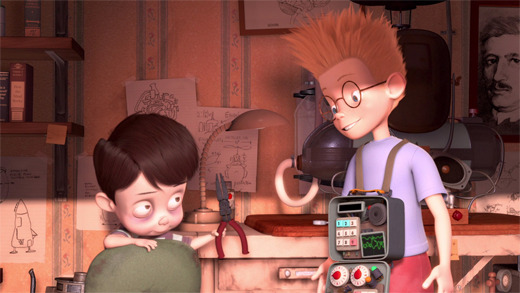
As Lewis perfects his memory scanner, we see the various people in his life. His baseball obsessed roommate. His well-meaning guardian at the orphanage. His nerve-addled science teacher. His dim bulb of a gym coach. Prospective adoptive parents who decline adopting Lewis. And various classmates who make Lewis feel like an outsider.
This movie is full of characters, most of which have no bearing on the plot itself. We spend way too much time in the present day, introduced to way too many people of little to no importance. The film is called “Meet the Robinsons,” yet we don’t actually meet the Robinsons in the first half hour.

Centering the movie around time travel creates a disconnect. Our heroes are stuck 30 years in the future, while the villains are stuck in present day. We have to crosscut between these two separate settings. This hurts the inertia of the film.
The movie has been building to the grand spectacle of the futuristic world of tomorrow. Once we get there, we’re denied any sort of payoff. We cut back to the humdrum everyday life of the modern era. Why waste time with flying cars, rocket ships, and hyperloop transports? We get to see the glorious spectacle of a patent company’s board room!

Even when we’re in the future, we’re denied full access. Lewis is forced by Wilbur to stay in the Robinson family garage. Everything interesting and captivating exists right beyond the poorly lit concrete wall. Except for a wacky robot, we don’t see any of it. Is this bad writing or is this an excuse to hide bad animation?

Not that the future world of Meet the Robinsons is terribly exciting to see. We get one flyover of the city, mostly demonstrating municipal transportation. Citizens of the future are all standing still or sitting down, because they’re easier to animate that way. Why animate multiple figures individually when you can have them float by motionless in giant bubbles?
The Robinson mansion a large house, but not an interesting house. Trying to predict 30 years of architectural trends results in a poorly designed home. Apparently, the future is full of terra cotta and curvy bevels.
The interior rooms are empty and cavernous, or dark voids. The lawn is covered with topiary hedges and multicolored patches of flowers. Beyond the gated walls, there’s rolling fields of green grass in all directions because it was easier to draw than a city or a neighborhood.

Indoors, we see a better representation of the retro-futuristic aesthetic the film has chosen. Everything looks like the 1950s idea of what the future should look like. Metal objects are covered in rivets. Gizmos are covered in dials and tubes. Little antennas are present everywhere. Many objects are adorned with ornamental, metallic smiling faces. There’s always at least one object in the room sporting a glowing ring of light. It’s a very stylized interpretation of the future. It’s purposely designed to be fantastical, always unreachable, and never outdated.

When the movie focuses on the future, we spend nearly our entire time at this one compound. Which would be fine if it felt like a voluntary choice, not a default setting. If the Robinson home was welcoming, interesting and unique, it would be a great location. Instead, we feel like the characters are helplessly stuck here. As though they’re trapped on a desert island.
We can feel the struggle of the animators. They tried very hard to design a futuristic funhouse, but couldn’t quite finalize a spectacular vision. The standards are lowered, but it still took copious time and effort. It took so much energy, there wasn’t enough time to design and animate a secondary location.
The Robinsons themselves are a wild gang of eccentrics. Despite their varying ages, they all have a childlike enthusiasm and energy. However, apart from their one defining hobby/quirk, they have no distinguishing personalities. All of them act the same, behave the same, react to events the same, have the same values, like the same food, and live in the same house. They’re very blank slates. The wooden puppet is the only one who acts unique.

This is the challenge with using a giant family as secondary characters. The family operates as a unit and not a series of individual people. Most of the Robinsons have only a handful of lines throughout the film, mostly reacting to things. We don’t have any time to explore personalities or characters. The movie is called “Meet the Robinsons,” but this isn’t the Robinsons’ movie.
There’s simply too many characters and too little plot to go around. There is no indicator how anyone behaves beyond their affinity towards Lewis. Instead of a dozen unique characters, we have the lady who likes trains, the guy who’s a human cannonball, and the man who should be a background human in Wall-E. The Robinsons are empty vessels.

It doesn’t help that the Robinsons are introduced via a montage. We’re still trying to get our bearings about the future and the setting. We don’t know what details are important and what’s just a joke. Names are forgotten. Kinship is underexplained. Everyone’s age is undetermined. Nothing can be learned from context. The movie expects us to understand Grandpa Bud has two brothers. The brothers look nothing like Bud, and in fact appear twenty years younger than him. All this on top of the three never interacting in any fraternal way.
It’s a great irony that the movie is called “Meet the Robinsons” when the Robinsons feel like total strangers. The movie does such a lousy job introducing everyone, the narrative literally stops so Wilbur and Lewis can reintroduce everyone. They go over the Robinson family tree with helpful accompanying diagrams.
This was the basic approach Disney took to Meet the Robinsons: Quantity over quality. Whether it be characters or jokes, more is more. Throw as much as you can onscreen to overshadow the flaws. It’s the filmmaking equivalent of a smoke bomb.

Consider the posters from the film’s theatrical release. We have no indication of story, plot, or coherence. We only have a few character models photoshopped together. Not even the entire Robinson family, just several of the most visually-striking characters. It doesn’t matter that the assembly makes no sense and barely represents the film. Some of these characters never interact. Some characters are from the present day and others from the future. The Wednesday Addams knockoff gets a prominent placement despite being little more than a glorified background character.
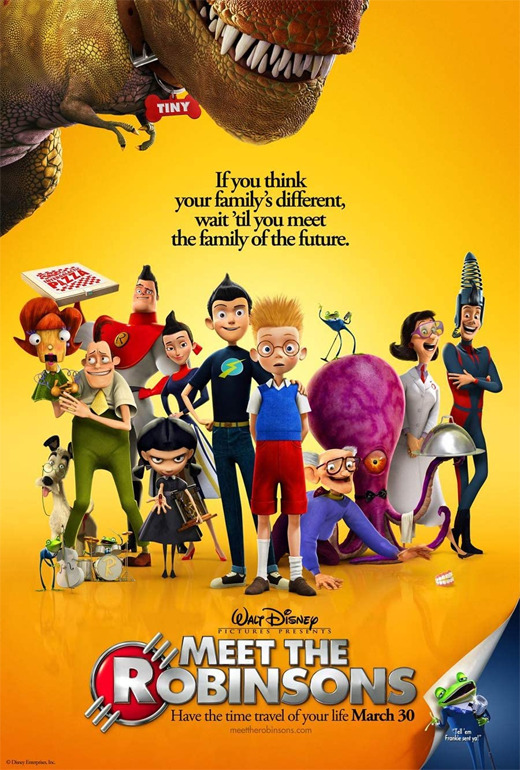
There is one great character in the film, and thankfully he gets a large amount of screentime. The film’s villain, known only as “Bowler Hat Guy,” is a delight. Bowler Hat Guy is a lanky doofus who steals one of the Robinson’s time machines for his own nefarious interests. He’s a very theatrical and comical villain. He’s quite obviously inept, using opportunity and convenience in place of cunning.

There’s a great contrast between Bowler Hat Guy’s ineffectiveness and the incredibly high stakes. It makes him surprisingly one of the greatest villains in the Disney pantheon. He’s like a child playing with a fork near an electrical outlet. Innocuous ingredients, but very dangerous when combined.

Disney designed Bowler Hat Guy specifically to be performed by comedian Jim Carrey. The exaggerated body movements, overemphasized dialogue, and rapidly changing facial emotions all mimic Carrey’s acting style. The high energy theatrics of Meet the Robinsons would suit Carrey perfectly.
Unfortunately, Carrey declined the role. The exact reason is unknown. He was either preoccupied with other projects, or just didn’t like the script. Either way, being unable to attract an A-List actor with a tailor-made role speaks volumes of Disney’s fallen clout in 2007.
Is it a great loss that Carrey couldn’t perform Bowler Hat Guy? Perhaps. Is the film worse because of his absence? No. Bowler Hat Guy may not have a superstar voicing him, but the strong comedic behavior remains. It’s a reminder that big name actors have marquee value, but are not indicators of a film’s quality.
With that said, the remainder of the Meet the Robinson’s acting is a mixed bag. Wilbur and Lewis are both fine. Their respective actors seem natural and comfortable. Several members of the Robinson family are also performed well, such as Wilbur’s mother, voiced by comedian Nicole Sullivan.
Others, not so much. Carl the robot is voiced by comedian Harland Williams. In certain scenes he’s absolutely hilarious and a natural fit for the film. Other times, his acting is too over-the-top. Other times still, it’s stilted and completely forced. We never know what to expect.
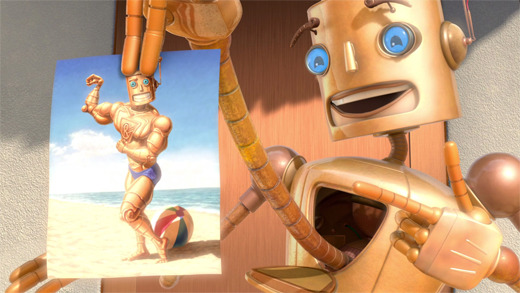
Several members of the Robinson family are voiced not by professional actors at all, but members of the production staff. It’s not uncommon in Disney films for a director or producer to take a smaller or supporting role. Usually it’s nothing more than an Easter egg. But Meet the Robinsons takes the practice to an unnecessary degree.
Of the seven credited writers, five have acting credits in the film. None of them are atrocious in their performance, but their roles do seem less authentic than professional actors. There is a lot of stress and emphasis in their line delivery. They don’t sound like characters in a movie. They sound like someone in a recording booth trying to mask their voice.
Why did the casting agent allow so many members of the production staff to serve as voice actors? A studio as large as Disney should have no trouble attracting talent. Jim Carrey was unavailable, but they could hire other celebrities if they wanted. If not that, they could put out a casting call and discover talented amateurs. They didn’t do either. They actively chose not to use professional actors, and we may never know why. As a result, we’re left with director Stephen J Anderson voicing a woman in a screechy falsetto for no reason.

Humor in this movie relies heavily on the weird. That weirdness comes in three flavors: Weirdness from the Robinsons, weirdness from the future, and weirdness for the sake of weirdness.
The Robinsons are legitimately insane people. Their quirks are unexplained, unprovoked, and irrational. Why they do what they do is their own business. The audience needs to either accept this, or leave. Tallulah dresses like a skyscraper because she can. Uncle Fritz is married to a puppet because it’s funny. Franny taught frogs to sing and play instruments because she likes frogs. There’s no explanation that could contextualize the absurdity. The chaos and nonsense is deliberate. Accept the stupidity at face value and laugh.

The future setting provides new technology and unforeseen wonders. Most of them are hotly impractical and unnecessary. There would be no logical reason for their existence, except that this is a comedy. So what if Carl doesn’t set the table himself, but spawns miniature versions of himself to carry the plates and flatware. So what if Lazlo has a jet pack powered by propellers. So what if one navigates the house through a series of pneumatic tubes, including one that inexplicably connects to the toilet. These futuristic conveniences are actually wildly inconvenient, and that contrast provides humor.

The insanity makes or breaks the picture. This type of humor is a twenty to one shot. If it works, it works very well. If it doesn’t work, it’s baffling and confusing. Why do a pair of identical twins live in the potted plants by the front door? Why does Wilbur hide Lewis’s identity with a readily accessible fruit hat? How can a giant octopus live on land and serve as a butler? If it baffles, it won’t matter. While the audience is confused, grasping for reason, another joke is already underway. As the film insists: Keep moving forward
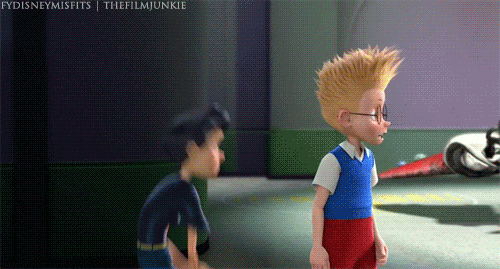
“Keep Moving Forward” is the official moral of the film, and the movie goes to extreme lengths to ensure its audiences will not miss it. The platitude is hammered in with all the subtlety of a hydraulic post pounder. Even in scenes where it doesn’t make any sense, it’s shoved down the audience’s throat. It’s a decent theme, heralding perseverance and growth. But using the exact same phrase, repeated ad nauseum, makes it seem like hollow rhetoric. The film almost seems like a PSA at times.

Despite his stupidity and general incompetence, Bowler Hat Guy is a credible threat. The overwhelming reason why is his bowler hat. Named Doris, the hat is a robotic machination programmed with a rogue AI. Doris has plans for the fate of mankind. It’s Disney’s version of a robot apocalypse.

The film’s climax involves an alternate timeline where Doris conquers Earth. Lewis, left to his own insecurities, is incapable of overpowering or fighting his robotic adversary. Luckily, he realizes he doesn’t have to. Lewis discovers the timeline is elastic. Events in the present are determined by decisions in the past. Since Lewis is from the past, he can directly influence the events of the future. He vows that Doris will never be invented. This oath causes Doris and her dystopian hellscape to instantly disappear.
It’s a simple, effective and appropriate way to defeat the villain. It’s also boring. Lewis solves his problems so quickly and effortlessly, he doesn’t even have to stand up. It feels like an unfulfilling deus ex machina. He literally wills his problem away.
The movie has a bad habit of anticlimactically handling major plot points. For a movie that offers an abundance of everything, there are significantly underwritten story moments. The big problem at the center of the plot is Bowler Hat Guy stealing the Robinsons’ time machine. How does he steal it? He sneaks in through the garage door because Wilbur forgot to lock up.

Does this have any reflection on Wilbur as a character? No. Does it have a correlation to the problems Lewis faces? No. Does it reflect a theme or an issue present anywhere else on the film? No. The movie needed the time machine to be stolen, and it needed a reason for Wilbur to try and recover it himself.
Wilbur is feeling guilty, and that’s understood. He wants to get the time machine back singlehandedly so no one will learn of his mistake. But is he feeling guilty for any unique reason specific to Wilbur Robinson? Is his shame a violation of the Keep Moving Forward credo? Did he invent a failed door-locking mechanism that would shame him to his inventor father? Did he keep the garage unlocked because he took his unconditionally loving family for granted? Or did he just make a mistake, like any other kid. It’s supposed to be a lynchpin moment for the film, but it’s anchored it to a completely innocuous thing.
Amidst all the futuristic technology and wacky Robinson shenanigans, there is a story of family and belonging. The entire film is tethered around Lewis’s desire to find his birth mother. At the film’s end, he uses the time machine to travel back to his infancy. There, he finds his mother at the exact moment she left Lewis on the orphanage’s doorstep.
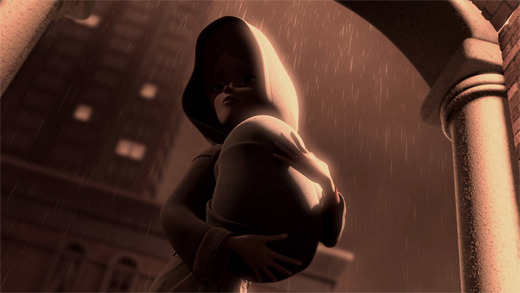
Up until now, the film has been absolutely chaotic. But this scene deserves credit for the dignified and mature pathos on display. It’s tonally different, but doesn’t feel out of place or disingenuous. It’s the natural culmination of the story.
While the animation still suffers, the scenes are at least composited well. Characters are staged effectively and shot at appropriate angles to establish necessary moods. There’s very little dialogue, letting actions carry the scene. Lewis has so many conflicting emotions, and the film communicates them all. We the audience understand exactly why he wants this so bad. We also understand why he declines it.

The identity of Lewis’s mother is irrelevant. Whatever her decision was to abandon her child is immaterial. Lewis doesn’t need to know, and he doesn’t have to ask. This poor woman had an incredibly hard choice, and made the impossibly tough decision to relinquish her infant son. The circumstances don’t matter.
It was never for a lack of love or a moment of irresponsibility. She made a difficult choice, it was her decision, and her decision alone. Lewis doesn’t have to know why. He only has to accept the decision, stop laboring over the past, and keep moving forward.

Meet the Robinsons is a mismatched pile of parts that never forms a fully-functioning machine. The bloated cast is used ineffectively, muddling the film instead of contributing anything of value. The story is fragmented into too many pieces. The futuristic setting is underexplored and underdeveloped due to poor animation. The humor confuses randomness and quirkiness for style. But amidst all the chaos, there are genuine moments of heart. Whenever the film stops acting like a chihuahua on a sugar rush, its potential shines through.
Before the credits roll, it’s revealed “Keep Moving Forward” was inspired by Walt Disney himself. It seems dishonest; the Disney Corporation mines nostalgia endlessly. But the cornerstones of the company have always been progress and advancement. Meet the Robinsons had its flaws, but it offered promises of betterment. After all, science fiction is all about looking towards the future.
Beauty and the Beast
Fantasia
The Lion King
Snow White and the Seven Dwarfs
Cinderella
Alice in Wonderland
Sleeping Beauty
Mulan
The Little Mermaid
Aladdin
Lilo & Stitch
The Many Adventures of Winnie the Pooh
Pinocchio
The Jungle Book
Robin Hood
The Sword in the Stone
Bambi
The Emperor’s New Groove
The Hunchback of Notre Dame
The Great Mouse Detective
101 Dalmatians
The Three Caballeros
Lady and the Tramp
The Rescuers Down Under
Atlantis: The Lost Empire
The Fox and the Hound
Fantasia 2000
Peter Pan
Dumbo
Hercules
Meet the Robinsons
Brother Bear
The Black Cauldron
Melody Time
Oliver & Company
Treasure Planet
Tarzan
The Rescuers
Pocahontas
Saludos Amigos
The Adventures of Ichabod and Mr. Toad
The Aristocats
Dinosaur
Fun and Fancy Free
Make Mine Music
Home on the Range
Chicken Little
#Meet the Robinsons#Disney#walt disney#Walt Disney Animation Studios#disney studios#Disney Canon#movie review#Film Criticism#film analysis
5 notes
·
View notes
Text
Chicken Little at 35
A review by Adam D. Jaspering
There were many factors to blame for the third Disney Dark Age. Internal strife among the executives. The overshadowing by Pixar Animation. Disney’s slow, reluctant conversion to CGI animation. A string of commercially underperforming films. Lowered ambitions to cut production costs. A growing reputation as irrelevant and out-of-touch. Downsizing. Brain drain of talented filmmakers to rival companies. A pervasive rumor that Comcast was seeking to acquire the distressed Disney Corporation.
The largest source of strife, Disney couldn't prepare for and couldn't expect. They could only endure the fallout. It was a direct attack from their newfound rivals, DreamWorks Animation. Disney had to survive the wrath of Shrek.

Shrek was the fifth movie from DreamWorks Animation. It was a box-office phenomenon, becoming the second-highest grossing film of 2001. It remains DreamWorks’s most popular film to date, challenged only by its own sequel. It was the first entirely-CGI film from DreamWorks, and has spawned an empire. Shrek proudly boasts three sequels, a spin-off franchise, numerous specials, a Broadway musical, and loads of toys, games, and marketing tie-ins. It won the first ever Academy Award for Best Animated Feature. Shrek turned DreamWorks Animation into one of the film industry's largest companies.
The executive behind Shrek’s meteoric success was Jeffrey Katzenberg. Katzenberg was the former head of Disney Animation, who left the company on very poor terms in 1994. Deposed, he co-founded DreamWorks Pictures alongside entertainment luminaries Steven Spielberg and David Geffen. Katzenberg served as CEO of DreamWorks's animation division for 20 years.
Without going into the details of Shrek's plot, the movie is not an ordinary satire of public domain works. Shrek was Katzenberg's long-awaited revenge. Shrek is the culmination of a career filled with scorn and bitterness. It wasn't a mockery of fairy tales and myths. It was a personal insult directed at Disney.
Shrek is a 90-minte roast of the Disney Corporation, its filmmaking style, and its cultural legacy. It’s a satire of formulaic movies. It's a ridicule of pointless, overwrought musical numbers. It’s a mockery of Disney’s pristine, wholesome aesthetic. It’s a parody of cliched happy endings. Even the film's villain is a caricature of Michael Eisner, ruling from a kingdom very reminiscent of Disneyland.

Having a rival studio produce a successful film is not a huge problem. It’s the nature of the corporate media world. Having a movie satirize your company is a minor problem. However, being in the public eye makes you a fair target. You roll with the punches, laugh at yourself, and move on. The problem with Shrek was not just the vindictiveness. The problem was how thoroughly Shrek beat Disney at their own game.
Disney had pioneered animation and filmmaking for years. But in the aftermath of the Disney Renaissance, everything was falling apart. Disney wasn't innovating anymore. They were enjoying the afterglow and coasting on inertia. Their filmmaking style was in a rut. Whatever successes Disney achieved in the early 2000s weren't being devised by the company, but were byproducts of luck.
DreamWorks was innovating and were rewarded with success. They didn't make a popular movie, they made a cultural milestone. In terms of writing, characters, humor, and style, DreamWorks was offering something new. Something not offered by Disney. Something audiences wanted to see.
Even from a technical standpoint, Shrek was surpassing Disney. Shrek featured CGI that boasted hair effects, realistic textures, lighting effects, and rich backgrounds. Disney was dragging their feet on CGI, still favoring hand-drawn animation. Disney's old-fashioned approach may have been a worthy, nostalgic alternative had their movies displayed strength elsewhere. But the poor reception of their 2000s offerings demonstrated they had no ideas and nothing on the horizon. Disney was producing lesser films that looked worse.
Like all great satires, Shrek made the truth obvious. The magic spell Disney had cast for decades across generations was now gone. The satire of Shrek had demonstrated how silly and rote Disney’s formula was. Disney was reframed in the public eye as hokey, outdated, saccharine, childish, unchallenging, and repetitive.

But the most important distinction between the two was tone. Disney's preferred method was wholesome, timeless, and genuine. Shrek was crass, sarcastic, and laden with pop-culture references. Disney was failing, and Shrek was succeeding. Disney had to change to survive. Whether they liked it or not, Disney had to learn from DreamWorks’s example.
In 2005, Disney made a movie to compete with Shrek. Disney made a movie far outside their own comfort zone. They made a movie in an unaccustomed style with unfamiliar sensibilities. They made what is widely considered the worst film in the Disney animated canon. They made Chicken Little.

The original Chicken Little story is a variation of an English folk tale called Henny Penny. The story dates back centuries, with other notable variants appearing in the folklore of Germany, Denmark, and Scotland. The name “Chicken Little” is widely preferred in America, though the stories are largely the same. For consistency’s sake, we’ll refer to the tale by its American title.
In the fable, Chicken Little is sitting under a tree. A piece of foliage falls (a leaf, nut, or acorn, depending on the storyteller), which he believes is actually the sky falling. In his confused panic, he convinces others the sky is falling despite having no proof of such claims. In the ensuing fervor, a wily fox promises to safeguard the panicked animals, only to lure them into his lair and eat them.
The story is a classic fable. It's a warning against propagating unverified facts, the futility of mass panic, and the dangers of gullibility and fearmongering. It’s wormed its way into the public conscious, referenced in debate, politics, sociology, journalism, and economics. All of it hinges on one element of the story: Chicken Little was absolutely wrong.
Disney inverts the story. What if Chicken Little was right? Maybe the sky itself wasn't falling, but something from the sky was indeed crashing down. What if Chicken Little was correct, but couldn’t prove it?
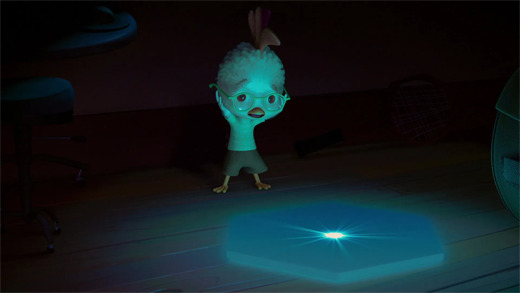
The myth is presented in the film’s opening prologue. Or rather, a compressed version of the myth. The story is reconstructed and simplified for the purposes of the movie. Chicken Little works his entire town into a frenzy simultaneously. He takes to the town’s bell tower and announces his apocalyptic warning for all to hear.
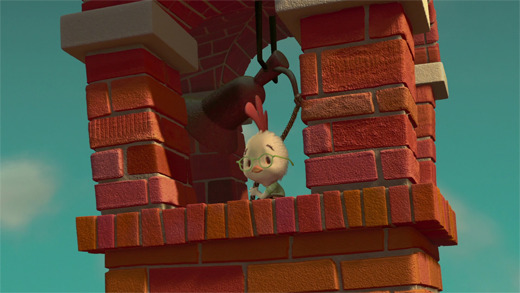
In doing so, the town’s citizenry erupt into chaos. A fire truck is cut off, crashing into a building. Citizens run, avoiding the automobile collisions. Buildings collapse, knocking over the town's water tower. Chicken Little’s actions don’t result in anyone’s death, but its still a massive catastrophe instigated by his unverified panic. If Disney had to compress the entire fable into two and a half minutes, it’s abbreviated well (minus the part where everyone’s eaten by a fox).
The panic is eventually calmed by Chicken Little’s father, Buck Cluck. Buck tries to excuse away his son's behavior, finding reasonable explanations for his temporary insanity. He plays a standard father’s role in this opening scene.
Ultimately, he defaults to belittling his son. It quells the mob, but Chicken Little is rendered a scorned pariah for life. Worse still, it redefines the father/son relationship as built on distrust.

This character dynamic remains throughout the film, not fully addressed until the climax. Before then, the film drowns under countless issues. Visual problems are the most apparent, beginning with the horrific CGI castle in the Disney logo.

With the exception of Chicken Little himself, everyone and everything onscreen looks unrendered. Textures are too smooth, like the town is full of plastic statues.

The simplicity would be bad enough, but it's not deliberate. Many of the animal creatures are oddly designed and proportioned. Not cartoony or exaggerated, but strained. Sometimes clothes don’t fit right, being skintight or undefined tubes. Sometimes hair doesn’t sit properly on someone’s head. Sometimes limbs flail around like spaghetti, not for comedy, but just because there’s no weight or semblance of belonging in a physical world. Sometimes characters talk and emote as though they lacked a skull. Nothing about the character design is clever, engaging, or well-constructed.
The character designs indicate the inexperience and inability of the animators. They tried their hardest with what time and resources they had, but it's not enough. Everything is too simplified. Standards are too low. The entire film suffers, centering around the limited capabilities. The question was never, "what would look good onscreen?" The question was exclusively, "what are we even capable of putting onscreen?"
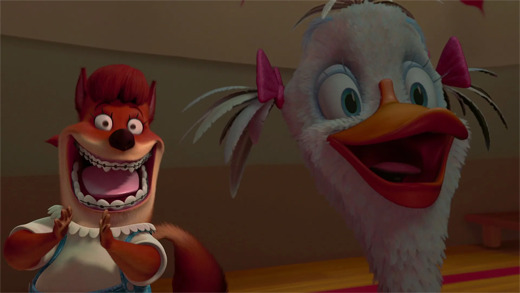
The fable-like story tries to create a fable-like world. Everything has a slanted, crooked appearance. Right angles and parallel lines are rare sights. It’s a reflection of the fractured interpretation of the Chicken Little fable.
Beyond that, the movie takes place in a fantasy land of animals. Not just animals living in a human world, but an amalgam of human society and animal habitats.
Chicken Little lives in a suburban home shaped like a chicken coop. Instead of windows, there’s chicken wire. He has egg-shaped furniture, and an egg-shaped car, and eggs on the wallpaper. Several of his neighbors live in birdhouses or doghouses.
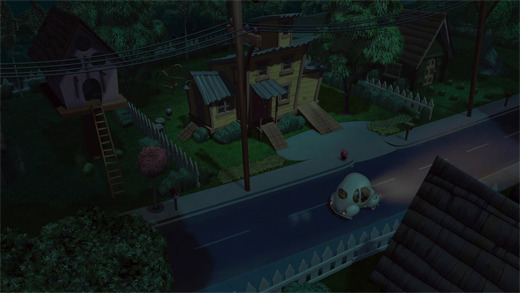
The animal theming is a decent idea. It's a bit exaggerated, but it's unique. The problem is, the design is half-hearted and inconsistent. When it's easily applied, it's applied. We see it demonstrated when it's simple and prominent. But once it gets complicated or inconvenient, it’s scrapped altogether.
Chicken Little's neighborhood features ordinary houses in the background. Downtown, the buildings are ordinary brick buildings. The school is an ordinary grade school with an ordinary classroom and gymnasium. The baseball field is an ordinary baseball field with ordinary bleachers and dugouts. The farm is an ordinary farm. These setting would belong in any animated movie. This inconsistency renders the fantasy setting worthless. There is no point in designing a unique fantasy world if you don't feature things unique or fantastic.

The plot is a carousel of threads and ideas that are brought up, disbanded, and unincorporated. The original Chicken Little fable is subverted, relegated to the film's prologue. Then it’s a child’s tale of alienation. Chicken Little is trying to escape his life as an unpopular reject. Then it’s a sports film. Chicken Little joins the baseball team and tries to win the big game. Finally at the halfway point of the film, it picks a plot thread and remains committed. It becomes a science fiction film about aliens. It's a ridiculous choice for an adaptation of Chicken Little, even a parody version. But we the audience are so pleased the movie has finally found a direction and purpose, we don’t care.
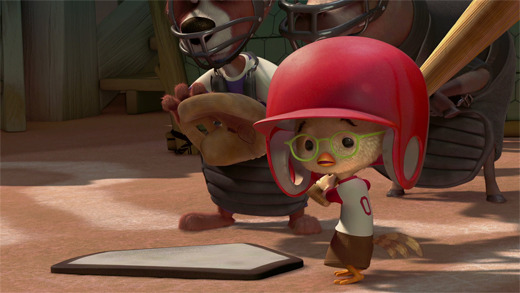

There is no coherence in this story. There’s no logical progression of plot points. Foreshadowing is a foreign concept, making the big twists seem random and insane. As though the script was a free-writing exercise.
When Chicken Little gets hit in the head in the prologue, we never see what actually hits him. We hear his account, but we don't get confirmation. There's not even an implication. The only clue is Chicken Little rambling literal gibberish.
The voice clip of his gibberish is repeated three times. His babbling is presented so precisely, one assumes it's a clue. As though he were involuntarily speaking backwards, or he's reciting some alien phrase. Neither is the case. Chicken Little has full control of his mental faculties and emotions. He has spoken clearly and precisely until now. He speaks gibberish because if he were capable of explaining himself, there would be no movie.
Foreshadowing would have been so simple and helped the plot so much. One cutaway is all we need. One shot of the UFO to indicate the story’s direction. One shimmer of the hidden-in-plain-sight cloaking device to confirm Chicken Little's perspective. Something to indicate where the plot is heading. Something to build towards. Something to center the film around. We don't have any of that. What we do have is the urge to phone the director’s family and discuss the signs of early onset dementia.
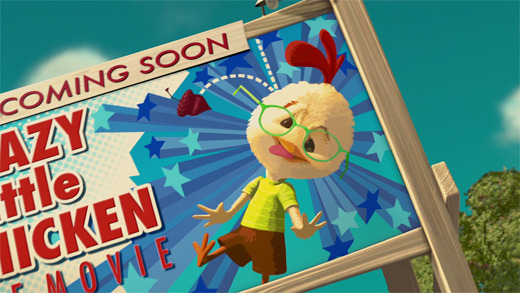
There’s a major tone problem in the film. For starters, the characters are all quite mean-spirited. Chicken Little is supposed to be the town’s black sheep, but he’s treated especially cruel for a child. Grown adults, even strangers, outright scorn and demean him. It’s a gauntlet of mockery and humiliation. For a company as wholesome as Disney, this cavalier display of bullying is an odd sight.
Chicken Little tries to do many different things, and whatever it does, it does wrong. When Chicken Little and his friends are investigating the alien spaceship for the first time, there's a radical shift in genre. We've gone from being a nutty comedy film to a sci-fi horror. 15 minutes ago, the hero’s biggest concern was winning a baseball game. Now, he’s looking at disembodied organs and eyeballs in glass jars.

Why does the spaceship have jars filled with brains, hearts, and eyes? There's no explanation. Yet another plot element that comes from nowhere and goes nowhere. It's not there to affect the story or explain the aliens. It's there solely to traumatize young viewers.
The youngest alien sneaks off the ship, following Chicken Little around. This forces the aliens to begin a search for the missing child. Their methods are mistaken as a hostile invasion. The visuals on display are eerily reminiscent of the 1958 film adaptation of The War of the Worlds. So much so, the film doesn’t even hide the allusion. They literally name drop the film, thus turning the allusion into outright plagiarism. Shrek used satire. Chicken Little used appropriations.

This allegiance to pop-culture references is one more attempt by Disney to mimic the DreamWorks formula. For example, characters in a movie theater are watching Raiders of the Lost Ark. A collapsed water tower rolls through the screen, replicating the famous boulder scene. Even if it wasn’t a forced concept, even if it wasn’t an overdone reference, even if it wasn’t years out of date, it would still be a weird joke. The entire world of Chicken Little is populated with cartoon animal characters. Yet Harrison Ford still somehow exists as his live-action, human self. The world's logic and rules are suspended for a single joke. And not even a very good one.
Chicken Little’s implementation of pop culture is tragic. It treats references as a substitute for humor. Not even applicable references, but random acknowledgment of pop culture's continued existence. This type of reference-as-a-joke humor was a serious problem in postmodern media in 2005, and it persists to present day. Chicken Little has the misfortune of not only using the bad idea, but being inept at it.
A character pretends they’re King Kong. He builds a miniature tower and swats at airplanes. He's prompted by nothing. Nobody mentions King Kong. There are no parallels to King Kong in this scene. King Kong has no relevance to anything before, during, or after this moment. It’s all blind and pointless. He impersonates King Kong because King Kong is a thing people will recognize.
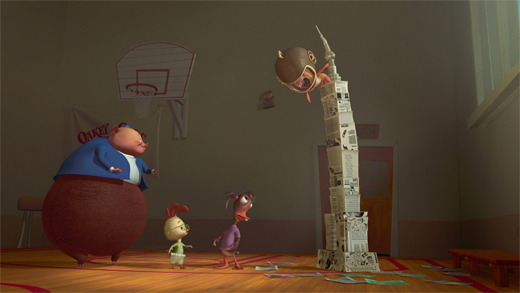
When Shrek referenced other pieces of media, it was with the purpose of parody and allusion. They wanted to inflate the nonsensical elements presented in fairy-tale and romance media. They pointed out clichés, mocked the absurd logic, and reframed the inherent silliness.
While Shrek skewered fantasy in general, it was often Disney's interpretation of fantasy. Disney was mocked. Unfortunately, Disney weren’t good at mockery themselves. When Disney attempted to copy Shrek’s sensibilities, they couldn’t provide the biting satire. Instead, they referenced things. No satires, no parodies, just a recognition that other media exists. That’s not comedy, that’s just reminding the audience they could be watching a better movie.
The soundtrack has the same problem. Chicken Little is the first non-anthology Disney film to feature a soundtrack of pre-existing music. It’s not exactly a curated playlist. It’s a series of painfully on-the-nose needle drops.
When flying saucers invade the city, R.E.M.’s ‘It’s the End of the World as We Know It’ plays. When Chicken Little wins the big ballgame, he sings Queen’s ‘We Are the Champions.’ When we’re privy to a karaoke party with Chicken Little’s friends, we hear the Spice Girls’ ‘Wannabe,’ particularly the chorus about the important value of friends.

Chicken Little is trying to copy a formula it doesn’t understand and has no hopes of understanding. It understands there’s some significance to correlating character behavior with external media. It knows there's an irony concerning the overly large male character liking Barbara Streisand and Gloria Gaynor. It's why he’s also obedient to his mother and tied to her apron strings. It's why he panics and screams in moments of peril, flailing his arms helplessly. Disney doesn’t bother to understand why any of this is funny, or what it implies. Instead, we’re left with a character who’s coded as effeminate but who's not performed as such. Nothing works, nothing meshes, and nothing makes sense.

Even the pacing of the movie can’t be bothered to try. The film’s prologue features a very fast, very cartoony sense of urgency. Things happen, things escalate, things get silly. One would assume this display of cartoon physics and mania is an indicator of the film we’re about to see. As though we're about to experience a very energetic, very frantic film. Nothing else in the film matches this wildness. Not even the exact same citizens panicking in the exact same town square as alien spaceships swarm. Chicken Little peaks before its title screen.
The movie literally stops in the middle of perilous sequences so characters can pontificate and converse. The action continues offscreen, which our characters are indifferent to. These aren’t breaks in the action. They’re not moments of respite. The characters have to fulfill certain beats to progress the story. These character moments can’t be integrated into the action for whatever reason. As such, the characters simply decide the perilous chaos can be ignored for three minutes.
Even worse is when the movie attempts slapstick humor. The bad writing creates implausible situations. The bad animation creates unrealistic visuals. The bad characterization deprives us of any purpose. All this combined fails to deliver on anything humorous. There's just a lot of screaming, throwing things, and falling over.

Hypothetically, one might argue if different people at a different time handled the movie, it could be saved. Every flaw can be explained by bad writing, bad animation, bad direction, bad design and so forth. That’s not the case. Chicken Little never had a chance of being decent. Even if the film wasn’t a rushed retort to DreamWorks, there is one bad decision at the crux of the film’s story that dooms the concept.
Chicken Little had a moment of embarrassment that has haunted him for a full year. Unable to move on, he lives in shame. At the center of the shame is his father, refusing to believe him or support him. It’s not that Buck doesn’t want to trust his son. He definitely wants to be a good father. But Chicken Little is so helpless, Buck is terrified his son will keep making mistakes.

Through the course of the film, Buck sees Chicken Little overcome adversity and fix his own problems. He learns to encourage and believe in his son. Buck learns that paternal love, like all relationships, requires several key components. Among them, trust, communication, and support. Chicken Little is literally a little chicken, but he's stronger and smarter than he seems. He can’t grow if he lives a life coddled.
It’s a well-structured lesson, and that is the big problem. It’s not Chicken Little’s character arc. Chicken Little's character arc occurs offscreen, between the prologue and opening credits. He learns independence. He learns how to compensate for his weaknesses. He finds an opportunity for redemption, devises a plan to achieve it, and succeeds. But all of this happens in the first act of the film.
The big moral at the center of the film is a moral for parents. It's Buck who learns and changes and grows. Buck learns to listen, trust, and support his son. This is a moral not for kids, but for parents. Disney completely missed their mark. They made a movie with content for children, but themes for parents. Chicken Little is a movie for nobody.

Chicken Little isn’t the story of Chicken Little. He has no character arc. He doesn’t grow as an individual. He never learns an important lesson. His only crime was being unable to accurately describe alien technology upon first glance, then being unable to locate it once it turned invisible. Chicken Little makes a mistake and suffers at the hand of an entire population of jerks. He earns redemption by doing something completely unrelated. That is not the basis for a movie.
We have the answer to our original question: It doesn’t matter what would happen if Chicken Little was right. Nothing of interest could be depicted onscreen. In its place, we get a dodgeball game, a baseball game, and dissected hearts in jars.
Chicken Little was Disney’s answer to Shrek. They copied everything. They copied their sardonic reinterpretation of fairy tales. They copied the crude humor. They copied the pop soundtrack. They copied the postmodern references. They even copied the ending. Once the credits start rolling, all the characters stand around, singing and dancing to one final musical number. As though this were a stage production and this is a curtain call. Chicken Little copied everything from Shrek except its popularity and success.

Chicken Little has a reputation for being the biggest mistake in Disney Animation. Nobody speaks highly of the film; not the directors, not the writers, not the animators, and not the cast. It represents Disney at their lowest. Disney were in a position they had never been before: subservient followers. They weren't trying to entertain, or push the boundaries of animation and storytelling. They were trying to stay relevant in a rapidly changing market.
In the end, Disney bounced back. Future films compensated for Chicken Little's failures. The movie was disregarded and largely forgotten with no major harm done aside from bruised egos. The filmmakers learned from their mistakes (most of them, anyway), and moved on.
DreamWorks, despite their success with Shrek, found a worse fate. The company was split up. Its various assets were sold to larger studios. The animation division was acquired by NBCUniversal in 2016. DreamWorks Animation would still make movies, but another company and another board of executives would dictate everything.
Despite his success at founding an independent studio, despite his critical and commercial acclaim, despite reinvigorating animation for the 21st century, Jeffrey Katzenberg was now working for Universal Studios exactly as he had been working for Disney. Katzenberg left DreamWorks Animation shortly after the buyout.
Disney lost a major battle with Chicken Little. Shrek started a fight Disney wasn’t prepared for. But Disney endured and lived to fight another day. It may be tedious, frustrating and unrewarding watching Chicken Little's story of redemption. But it’s a great story of redemption by the the studio.
Beauty and the Beast
Fantasia
The Lion King
Snow White and the Seven Dwarfs
Cinderella
Alice in Wonderland
Sleeping Beauty
Mulan
The Little Mermaid
Aladdin
Lilo & Stitch
The Many Adventures of Winnie the Pooh
Pinocchio
The Jungle Book
Robin Hood
The Sword in the Stone
Bambi
The Emperor’s New Groove
The Hunchback of Notre Dame
The Great Mouse Detective
101 Dalmatians
The Three Caballeros
Lady and the Tramp
The Rescuers Down Under
Atlantis: The Lost Empire
The Fox and the Hound
Fantasia 2000
Peter Pan
Dumbo
Hercules
Brother Bear
The Black Cauldron
Melody Time
Oliver & Company
Treasure Planet
Tarzan
The Rescuers
Pocahontas
Saludos Amigos
The Adventures of Ichabod and Mr. Toad
The Aristocats
Dinosaur
Fun and Fancy Free
Make Mine Music
Home on the Range
Chicken Little
#Chicken Little#Disney#walt disney#Walt Disney Animation Studios#disney studios#Disney Canon#Film Criticism#film analysis#movie review
1 note
·
View note
Text
Home on the Range at 35
A review by Adam D. Jaspering
Not counting the Pecos Bill segment from Melody Time, Home on the Range is the only western from Disney Animation. Westerns have long been a staple of Hollywood, peaking in 1950 when 122 were released in a single year. Their place in cinema history is astounding. However, their popularity tapered off considerably. By the 2000s, only a handful of westerns were produced annually, a good portion of them satires of the genre.
Disney had been producing animated films since the 1930s. They lived through the genre’s apex and nadir. Disney made a number of live-action westerns. Even the Disney parks have an entire land devoted to the American frontier. But the animation department missed their window of relevancy. Home on the Range was their chance to finally participate.
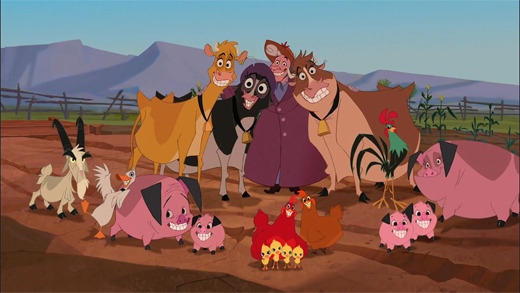
Home on the Range is the story of three dairy cows trying to save their farm from an unscrupulous land baron. The villainous shyster has systematically defrauded and acquired every homestead in the region. Only one farm remains; a simple ranch named Patch of Heaven. The animal residents must learn to set aside their differences to save the day.
Before we delve too deep into the film’s flaws, let’s analyze the good points. The soundtrack features some very nice tracks that match the rustic setting well. Tracks by K.D. Land, Bonnie Raitt, and Tim McGraw are well done. As is the score. It’s a distinctly Disney soundtrack, but with a western twinge. It can be appreciated even by those who aren’t fans of country music.
The character animation is also nice. There are scenes of both slow methodical movement, and quick action. Characters have very fluid motion that never looks jarring. An accomplishment, considering how unnatural the motions sometimes are.

This pairs well with the editing. The movie is filled with fast-paced, hectic scenes of chaos. Characters and environmental artifacts are bounced around maniacally. In lesser hands, it would be easy to lose track of what’s happening where. But there’s a sense of rhythm and geography in each sequence. We know where everyone is and what’s happening no matter how crazy things get.
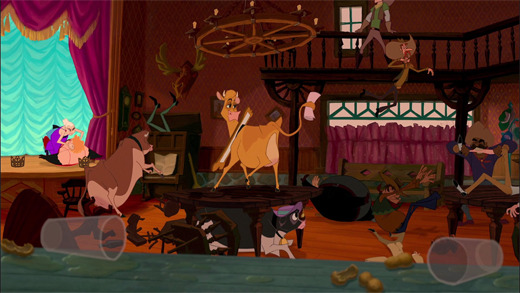
Tragically, that’s all to be said in the film’s favor. The rest of the movie is one bad decision after another. Whether through apathy or incompetence, Home on the Range is an all-time low for Disney Animation.
Let’s begin with the characters. No one in the movie has what could be considered a deep or complicated personality. No one has a significant character arc to get us emotionally invested. No one has an interesting hook or gimmick to make themselves memorable. Everybody has one trait or attribute that defines them, and they carry it throughout. The goat is territorial. The horse is a fanboy. The dog is old. The jackrabbit is crochety.
Not even the three main characters are excused from such reductive definition. Maggie, Grace, and Mrs. Calloway are our heroes. Maggie is the sarcastic one. Mrs. Calloway is the fussy one. Grace is the bubbly one. Three archetypes in search of a motivation.
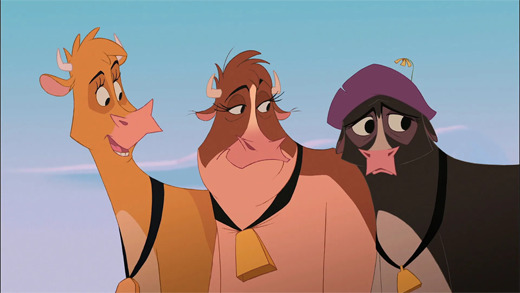
Maggie has a minor backstory as a show cow, winning a number of blue ribbons before being sold by her owner. This backstory is irrelevant to Maggie’s character and the film. It’s mentioned at her introduction, repeated later in the first act, and never comes back into play. Her attitude and personality are not reflective of this backstory. Her behavior and experiences are no different than any other animal. She has no intention or desire to resume the life she lost. She’s supposed to be an outsider, but because she has no legitimate character traits, she assimilates instantly.
There’s a running gag where Maggie wants to wear Mrs. Calloway’s hat. It’s an ingenuine request, repeated only because it noticeably irritates Mrs. Calloway. The gag is significant though, as it’s the only instance of Maggie actually wanting anything.
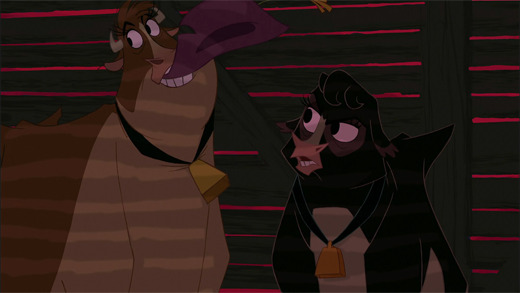
Roseanne Barr is instantly recognizable as Maggie. Her grating, gravely voice is iconic. It served her well as both a stand-up comic and sitcom star. However, in those instances, it was paired with a cantankerous, sarcastic attitude. It gave her comedy a bitter, angry edge. Here, she’s playing a good-natured protagonist. Roseanne’s voice and acerbic tone are in contrast with Maggie’s character.
Compare her role with the voicework of Gilbert Gottfried in Aladdin. Both actors have similar piercing voices, but used to opposite effectiveness. Gottfried played an angry, misanthropic villain who spent much of the movie complaining. His voice reflected his unlikable, negative traits. He was supposed to be seen by the audience as a mild threat, but also an annoyance to the hero’s plans.
Maggie is not framed this way at all. While Maggie has rivalry with Mrs. Calloway, she’s never antagonistic. Even at their most argumentative, the audience is supposed to see both as heroes. Maggie’s voice is a tonal opposite to what her character is trying to accomplish. Her attitude is sarcastic and rude, but her character is selfless, resilient, and outgoing. The pairing of voice and action isn’t an ironic contrast, it’s just a miscast actress.
Jennifer Tilly’s casting gets a mild pass. Her breathy, high-pitched voice works in service of Grace’s ditzy character. But Grace is such a small element of the film. She’s barely a main character, only used as a tiebreaker in arguments between Maggie and Mrs. Calloway. When she’s the subject of a scene, she’s saying something ridiculous and unimportant. When she’s not the subject of a scene, she’s shoved into the background and forced to be quiet. Her voice suits her character, but her character has nothing of significance to ever say.

She’s somewhat of a comic relief character, except not given the opportunity to be comical. What she does is misread social cues, rambling on, saying things either irritating or unhelpful. It’s not a trait that contributes anything useful. It’s not a weakness that affects progress. It’s just something she does, and its quickly tuned out. Grace received a stock archetype, drawn randomly from a hat, then implemented ineffectually.
Grace could have any number of character traits. Traits that could define her relationship with Maggie and Mrs. Calloway. Traits that would define her role in the story. Instead, her sole contribution is being literally tone deaf to the point it affects her range of hearing. There’s no way to justify the movie requiring three cows as main characters instead of two cows and a pair of earplugs.
Judi Dench is also miscast. Dench has received multiple awards and accolades for both stage and screen. Working for Disney isn’t an absurd career move given her diversified skill and filmography. But this particular project is a weird choice for her inclusion. The movie is set in the American frontier, circa 1889. Why cast a British actress?
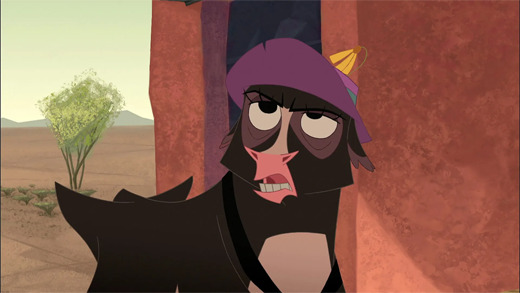
Clearly the writers were trying to differentiate Mrs. Calloway from Maggie. Maggie is coarse, unrefined and boorish. Mrs. Calloway is stuffy, pretentious and judgmental. Making one character American and one British is a traditional way to symbolize such differences. It’s a common narrative shortcut. It makes sense from a thematic standpoint, but not from a narrative standpoint.
The problem is, Maggie and Mrs. Calloway are not as dissimilar as the movie insists. Both live on the same farm. They have the same goals. They face the same stakes. They have the same friends. They have the same enemy. The only difference between the two is Maggie favors actively saving the day while Mrs. Calloway favors passive support.
The division is an artifice forced into place by the screenwriters. The low-stakes film needs conflict. If none can happen within the framework of the story, it must be instigated artificially. The writers are making these two characters fight, even though they have nothing to fight about. This is evidenced by Grace, who has the exact same background as Mrs. Calloway but never quarrels with Maggie.
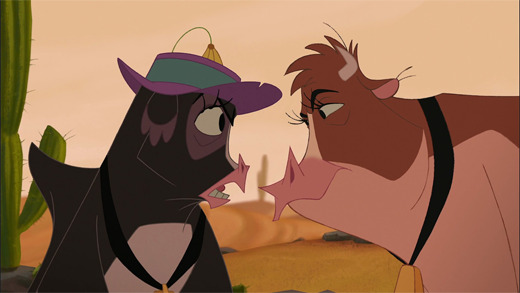
The flimsy plot structure is a bad omen for the writing prowess on display. The story underestimates the audience significantly. For example, the exact amount of money necessary to save Patch of Heaven is $750. It’s not an absurd number, but very specific. It ingrains itself in one’s memory. Later in the film, we see a wanted poster prominently offering a reward of $750. The movie is clearly moving in a specific direction. Anyone paying attention knows exactly what that direction is. But the audience is forced to wait patiently as the characters of the film catch up.

The villain of the picture is Alameda Slim. Slim is a cattle rustler who steals livestock under the cover of nightfall. Without cattle, the nearby farms go bankrupt, forcing the property to be auctioned by the bank. Slim then buys the land at rock-bottom prices, adding to his vast holdings.
Why is Slim doing this? He claims it’s revenge. He was a ranch hand in his youth, fired for unclear reasons. He wants to buy all the region’s farmland in spite. Even the farms of people who have never hired him. Even the farms of people who have no idea who he is. Every farm, no exception, because that’s his plan, and that’s what he thinks revenge is.

What difference does owning every farm make? None. What does he plan to do with all that land? Nothing. What will he do after his plan succeeds? Not a thing. He wants revenge on an indeterminate vague number of people for ambiguous reasons. It’s hard to understand a villain when he’s not given any background, justification, or motive. He’s a bad guy doing bad guy things because the movie needs a bad guy.
Robber barons are a specific type of villain. Slim could just as easily have begun on a path of revenge, only to pursue a new, opportunistic path of greed. It would take roughly thirty seconds of dialogue. But that’s not what happens. He insists it’s revenge. That’s his reason, even if it makes no sense. It’s the kind of logic, or lack thereof, driving this film.
The illogical standards this world operates on are many. The Patch of Heaven dirt farm is tended solely by Pearl. Pearl is an older woman, with no discernable associates or family to assist her in her agricultural duties. All the crops and all the livestock are her responsibility alone. The farm appears to be no larger than one or two acres, but it’s still a tall order for a woman of advancing years.

One wonders whether she understands the basic tenets of operating a farm. Pearl has a wide variety of animals, but in very small numbers. No horses or other beasts of burden reside on residence. Despite the relatively small land appropriated for crops, she grows a diverse array, not specializing in any area. None of these crops are fenced off or separated from the animals. All animals share the same pen, including both Holsteins and baby chicks. After tending all day to her dozen unique crops and livestock, her meager output would be half-destroyed by grazing goats and trampling cows.
Worse still, she refuses to sell her livestock for any purpose. Not even while under financial duress. She’s not breeding livestock, not selling livestock, and certainly not slaughtering livestock. What does Pearl have livestock for? It implies Patch of Heaven isn’t a farm at all, but a private petting zoo.
Pearl’s farm is the only farm in the area not rendered bankrupt by Alameda Slim. We’re supposed to sympathize with Pearl and her misfortune, but we’re not given a very good reason why. Of course it would be sad if the farm was bought out, but what makes her plight any different from the dozen of other farmers who lost their land? Why is her tragedy the center of focus, and no one else’s?

Every other farm is forced into foreclosure after Slim steals their cattle. Pearl was just bad with money. If there were no villain at all, she’d be facing the exact same fate. We’re never given a reason to care about Patch of Heaven besides forced perspective. Pearl’s farm is the centerpiece of the film because the movie insists it’s the centerpiece of the film.
The rules of this universe are arbitrary and frequently violated. There is a level of autonomy on display by the anthropomorphic animals. They can talk and think and behave like humans. But they don’t have animal societies, they’re members of a unanimously human society. They’re owned and treated like animals by humans.
Except when they’re not. A buffalo stands guard at Slim’s lair, preventing trespassers from entering. Horses can decide when they want to be loyal to their riders, and when they possess free will. The three heroes up and leave Patch of Heaven on a whim, walking off property of their own volition.

We’ll ignore how three cows wandering off unnoticed continues to speak poorly of Pearl’s skills as a farmer. Instead we’ll focus on why Maggie leads the charge.
By the time the cows leave the farm in search of money, Maggie has been a resident of Patch of Heaven for a grand total of six minutes. This is not an exaggeration; the events play out in real time. She has settled into her newfound home in a single scene. So well, upon learning of Pearl’s hardship, Maggie initiates a crusade to save her newfound home.
She’s not doing it as a symbolic gesture to her previous owner, unwilling to let her new home receive an identical fate. She’s not doing it because it’s a noble cause, and she’s selfless. She’s not doing it to endear herself to her new friends and colleagues. She’s doing it because she can.
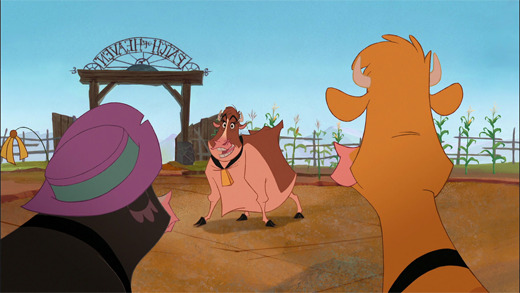
As for Mrs. Calloway, she refuses to assist, only agreeing reluctantly after badgering. Her motivation is that, as a cow, there is nothing she could or should be doing to help. A valid feeling, but a defeatist attitude. Maggie is the only one to offer any semblance of a plan, but Mrs. Calloway acts as though she has the moral high ground. In reality, Mrs. Calloway resents others aren’t as cynical as her.
This is in massive conflict to how Mrs. Calloway should be acting. This is her home. It’s implied she’s lived here her entire life. She has more to lose than Maggie. She has more emotional investments, more memories, and more of an attachment to Pearl. Mrs. Calloway should be the one campaigning for the farm’s wellbeing, or at least considering all options. Instead, she’s prominently against the idea, despite all good reasons. It’s another illogical attitude forced on the characters by the writers.
There’s lots of evidence that Home on the Range is a flawed film. But what makes the movie so infamously terrible? All the bad decisions in writing, animating, and casting pale compared to one element of Slim’s villainous plot. In order to buy each ranch at reduced prices, he needs to bankrupt them swiftly. To do that, he needs to rustle their entire stock of cattle overnight. How does he move hundreds of cows under the cloak of darkness? Slim hypnotizes them with hypnotic yodeling.

The “Yodel-Adle-Eedle-Idle-Oo“ musical number is a contender for the worst scene in all of Disney Animation. It’s a ridiculous concept. It features a ridiculous song with ridiculous music with ridiculous lyrics. It has ridiculous animation. Not fanciful ridiculous. The desperate kind of ridiculous. The kind of ridiculousness people resort to when they’ve backed themselves into a corner.
There are elements reminiscent of Dumbo’s ‘Pink Elephants on Parade.’ There, everything was a psychotropic series of colorful visuals against a black backdrop. Here, the base elements are replicated but applied all wrong.
The downfall of digital animation is that shortcuts are easily exploited. Instead of surreal imagery, everything is uniform. Assets are clearly dyed and digitally duplicated. It doesn’t look compelling. It doesn’t look like a herd of cows are hypnotized. It looks like somebody copy and pasted a single cow a hundred times, then took a three day weekend.

Why does any of this make sense? Why is any of this necessary? Why does it look and sound so ugly? Why would any of this be considered fun, or interesting, or compelling cinema? This isn’t just a bad scene, it’s a baffling bad scene. So many people contributed so many bad decisions. And so many more approved such decisions. A bad scene is hard to watch because it’s disengaging. A phenomenally bad scene is hard to watch because you pity the filmmakers.
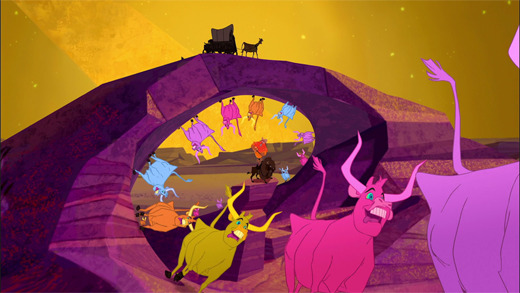
When the movie isn’t being insulting in narrative, it’s being boring in visuals. As the name of the movie implies, Home on the Range is set on the American frontier. A beloved locale, renowned for its landscapes and natural beauty. It’s one of the implicit appeals of the western film genre. However, the animators didn’t consider it important at all. Backgrounds are frequently just an empty sky, a single rock, or nondescript hills. There’s vacant emptiness in all directions.

There are also unintended limitations presented by making the main characters cows. There’s a reason funny animal pictures don’t typically feature livestock. The heroes’ faces are emotive, but their body proportions and physical size limit their ability to be expressive. They gesture with their necks, they grab things with their mouths, their hooves are nothing more than ordinary hooves, and their prehensile tails are often off-camera. Their design is too realistic to serve an animated medium. The movie is filled with visually indistinguishable scenes, shot from the shoulder up.
Then there’s the humor. In the first two minutes of the film, Maggie introduces herself to the audience via offscreen narration. Facing away from the camera, her udders are on full display. She accosts the viewers for staring. She also insists “Yeah, they’re real.” Implying this character in 1889 is not only familiar with breast augmentation, but such a procedure would be available for cows.
Humor is intended to make a story appealing and relatable. It accents character traits and how characters relate to their world. But when humor is this bad, it reflects the characters’ lack of substance. It makes the story seem immaterial and impersonal. We’re constantly reminded we’re watching a movie.
The characters have nothing to offer, the story has nothing to offer, the visuals have nothing to offer. In their place are one-liners and wacky mugging to the camera. It’s a strategy used by desperate filmmakers. If you can’t entertain the audience, distract them.
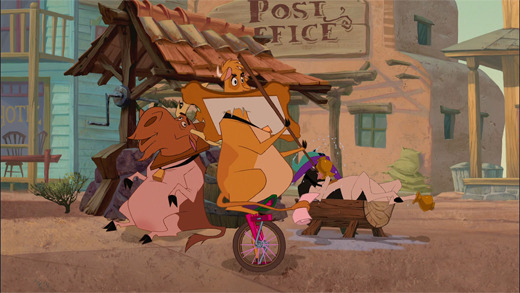
Hence the rushed and anticlimactic finale. Slim’s evil lair is blown up because it’s filled with dynamite, despite his evil plan not using dynamite in any way. The heroes rescue the rustled cattle by somehow teaching themselves how to operate a coal-powered locomotive. They all somehow survive the train being derailed, landing precisely at their specific homestead. Slim is dispatched so quickly and so easily, it feels like an accident.
And then the movie ends with a song and dance number because the movie’s slightly too short otherwise. Never mind that canonically dozens of innocent farmers lost their homes and livelihood, and never received any sort of justice or resolution. Our heroes are happy, and that’s all that mattered.

Home on the Range is widely considered one of the worst films of the Disney animated canon. It’s tacky humor, nonsensical plot, inauthentic characters and disengaging art all contribute massively to its infamy. But as unloved and unlovable as the movie is, that’s only a partial element of why its reputation is so poor.
Disney had released bad films in the past, walking away relatively unscathed. Home on the Range was such a disaster, it forced Disney to completely overhaul their entire company.
In the year 2004, Disney Animation was struggling. Their hits were mild hits. Their failures were massive failures. Once the titans of the animation industry, they were now merely players. They were consistently outmatched by both Pixar Animation and Dreamworks Animation. They were fighting for scraps alongside Blue Sky Studios and Nickelodeon Movies. Even sister company DisneyToon Studios, created to make cheaper, less auspicious Disney features, was rivaling Disney Animation in terms of box office grosses.
What factors contributed to this downfall? For starters, Disney had massive struggles at the executive level. The infighting and attrition inspired little motivation or effort among the filmmakers. Instead, tensions ran hot, and executive meddling mandated lower ambitions and straightforward approaches. Home on the Range was initially conceived as Sweating Bullets, a dark supernatural fantasy. Instead, it became wisecracking cows walking through a desolate vacuum, and a bad guy with a magic yodel.

Second, Disney was technologically languishing behind other animation companies. The first CGI film from Pixar was released in 1995, and was an immediate success. The first Dreamworks CGI film was released in 2000, and was an immediate success. In 2004, Disney was still making their films with hand-drawn animation, and they were failing. To audiences, Disney’s films looked outdated and irrelevant.
Initially, hand-drawn animation was to be incrementally scaled back. Animators would be given opportunities to learn computer animation and adapt. But by 2004, things were dismal. Home on the Range was such a disaster, the gradual outmoding became a massive layoff. Executives shuttered the traditional animation programs, while the studio’s assets were restructured.
Instead of being trained in computer animation, Disney simply fired dozens of animators outright. The Florida animation studio was shuttered. The remaining animators were consolidated to the California studio. Hand-drawn projects in development were left unfinished and abandoned. Computer animation would be the standard going forwards.

Home on the Range wouldn’t be the last hand-drawn animated film by Disney. Further films would apply the style, but as an experiment or novelty. For all intents and purposes, it was the end of the era. Hand drawn animation was dead. And what an inglorious death it was.
It seems almost too perfect. It’s not hard to believe perhaps Home on the Range was no accident. Perhaps somebody deliberately made Home on the Range as bad as possible. In failure, Disney could address and fix other, larger problems. Their outdated and dysfunctional studio system could be streamlined. Their technological leap forward could be accelerated. An unpopular executive could receive an unignorable black mark on their legacy, damaging their standing in the company. It’s an unfounded theory, both unprovable and contemptuous. But it’s still a possibility.
In 2004, Home on the Range crashed and burned. Studio executive Michael Eisner’s career was ruined. The film industry saw the end of an 80-year tradition. And Disney Animation was finally ready to enter the 21st century. Home on the Range might not be worth watching, but no one can deny it’s impact.
Beauty and the Beast
Fantasia
The Lion King
Snow White and the Seven Dwarfs
Cinderella
Alice in Wonderland
Sleeping Beauty
Mulan
The Little Mermaid
Aladdin
Lilo & Stitch
The Many Adventures of Winnie the Pooh
Pinocchio
The Jungle Book
Robin Hood
The Sword in the Stone
Bambi
The Emperor’s New Groove
The Hunchback of Notre Dame
The Great Mouse Detective
101 Dalmatians
The Three Caballeros
Lady and the Tramp
The Rescuers Down Under
Atlantis: The Lost Empire
The Fox and the Hound
Fantasia 2000
Peter Pan
Dumbo
Hercules
Brother Bear
The Black Cauldron
Melody Time
Oliver & Company
Treasure Planet
Tarzan
The Rescuers
Pocahontas
Saludos Amigos
The Adventures of Ichabod and Mr. Toad
The Aristocats
Dinosaur
Fun and Fancy Free
Make Mine Music
Home on the Range
#Home on the Range#Disney#walt disney#Walt Disney Animation Studios#disney studios#Disney Canon#Film Criticism#film analysis#movie review
10 notes
·
View notes
Text
Navigation Hub
Snow White and The Seven Dwarfs • Pinocchio• Fantasia• Dumbo • Bambi • Saludos Amigos • The Three Caballeros • Make Mine Music • Fun and Fancy Free • Melody Time • The Adventures of Ichabod and Mr. Toad • Cinderella • Alice in Wonderland • Peter Pan • Lady and the Tramp • Sleeping Beauty • One Hundred and One Dalmatians • The Sword in the Stone • The Jungle Book • The Aristocats • Robin Hood • The Many Adventures of Winnie the Pooh • The Rescuers • The Fox and the Hound • The Black Cauldron • The Great Mouse Detective • Oliver and Company • The Little Mermaid • The Rescuers Down Under • Beauty and the Beast • Aladdin • The Lion King • Pocahontas • The Hunchback of Notre Dame • Hercules • Mulan • Tarzan • Fantasia 2000 • Dinosaur • The Emperor’s New Groove • Atlantis: The Lost Empire • Lilo and Stitch • Treasure Planet • Brother Bear • Home on the Range • Chicken Little • Meet the Robinsons • Bolt • The Princess and the Frog • Tangled • Winnie the Pooh • Wreck-It Ralph • Frozen • Big Hero 6 • Zootopia • Moana • Ralph Breaks the Internet • Frozen 2 • Raya and the Last Dragon • Encanto
11 notes
·
View notes